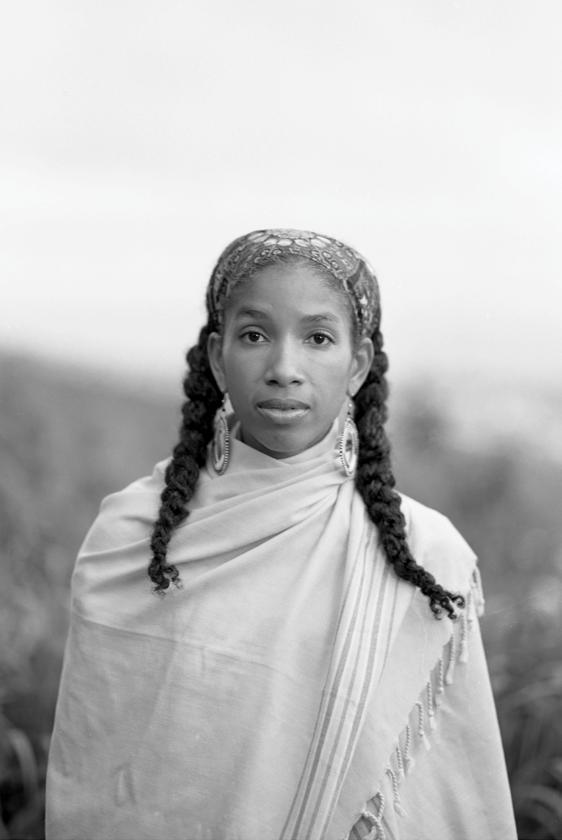
Well: Back to the Earth Maui naturists bare it all, and the dead inform the living how to lead a more eco-conscious existence.
Power in Unity Kūpuna take on development, houseless find belonging, and migrant patriots fight for freedom.
The CURRENT of HAWAI‘I Theme:
Volume 8 Issue 2 Features:
Living
Special Section: Kaka‘ako Redux Living, working,
walking in this growing Honolulu neighborhood. 0 02 > 09281 $14.95 US $14.95 CAN 25489 8
Tribes
and
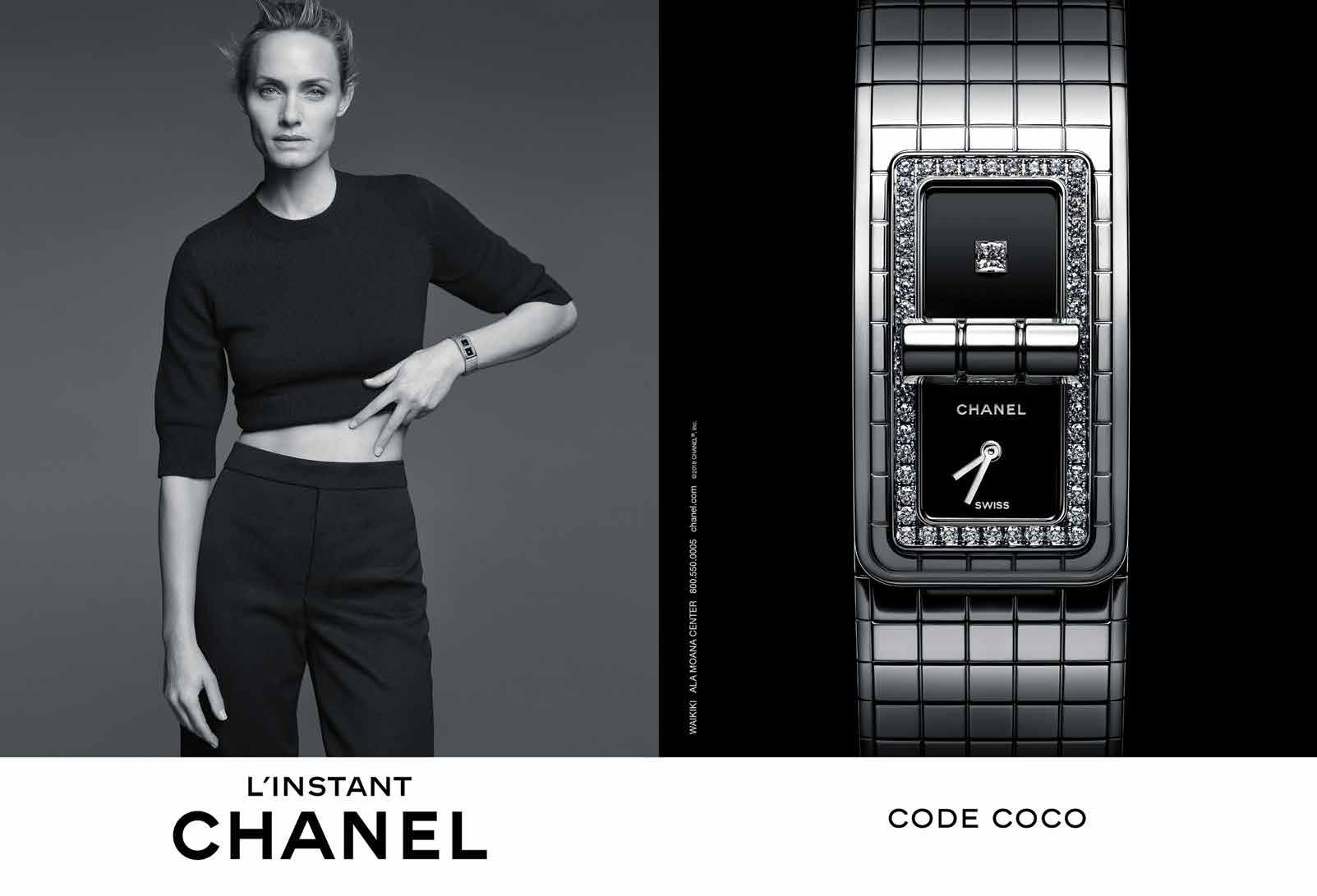

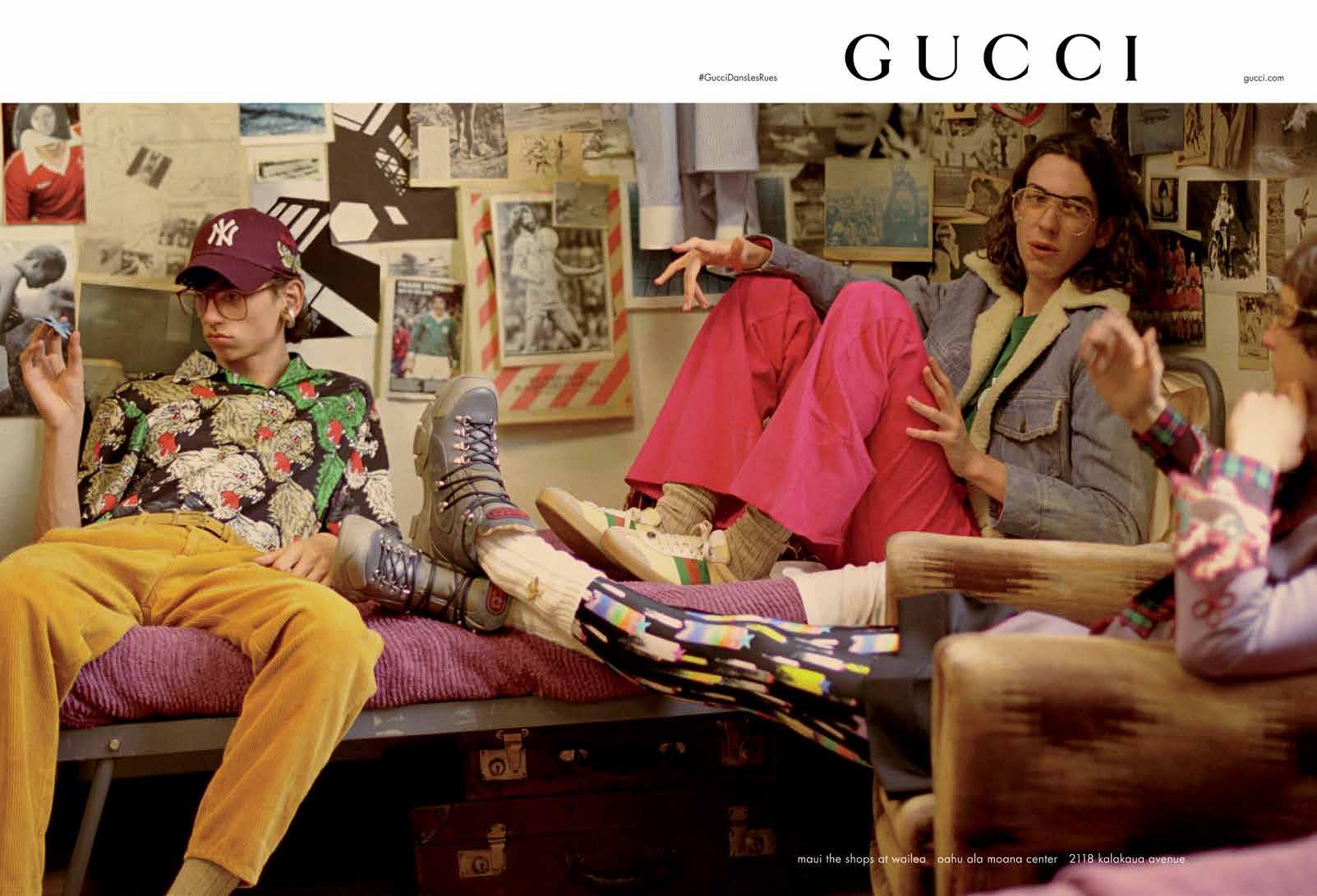

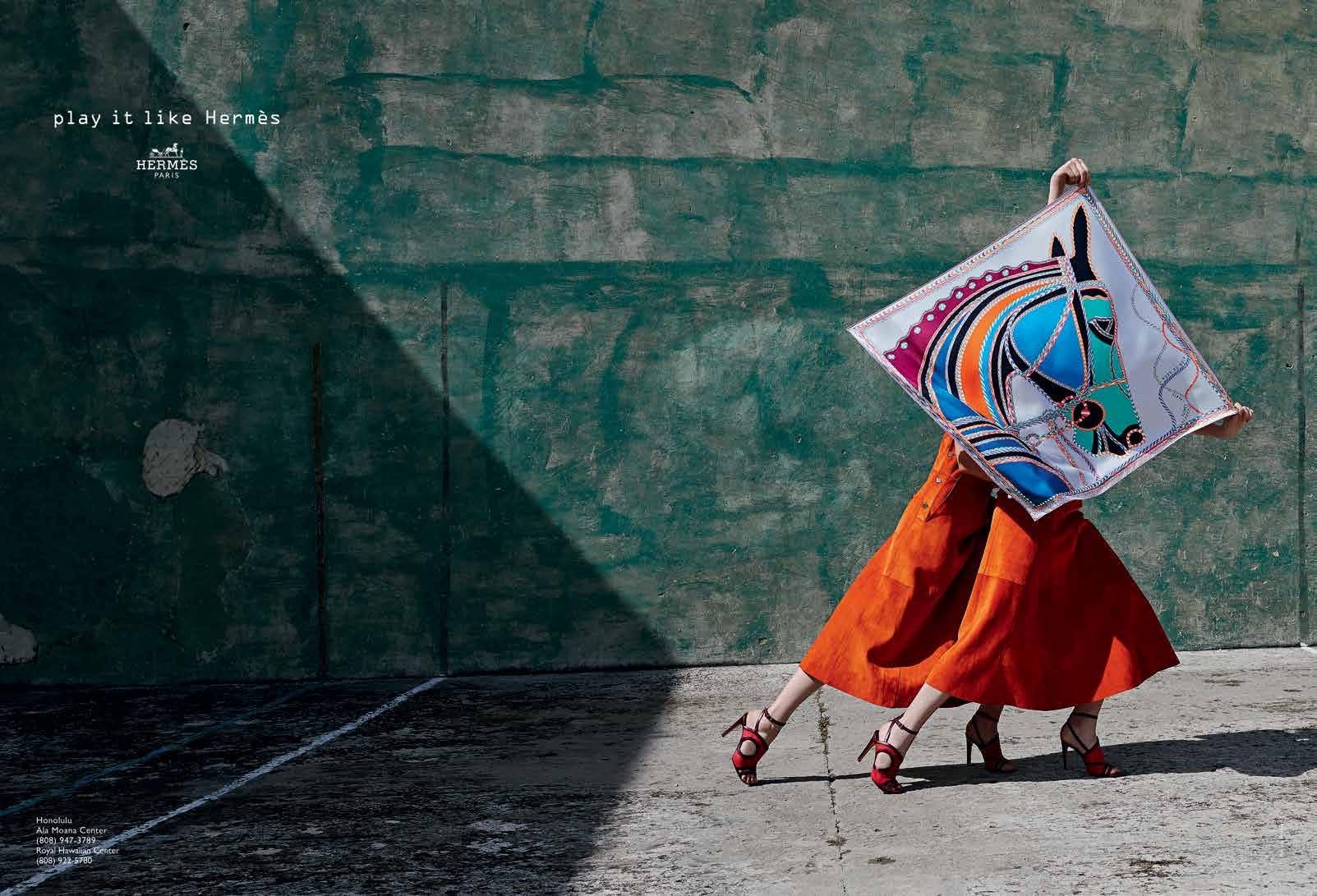

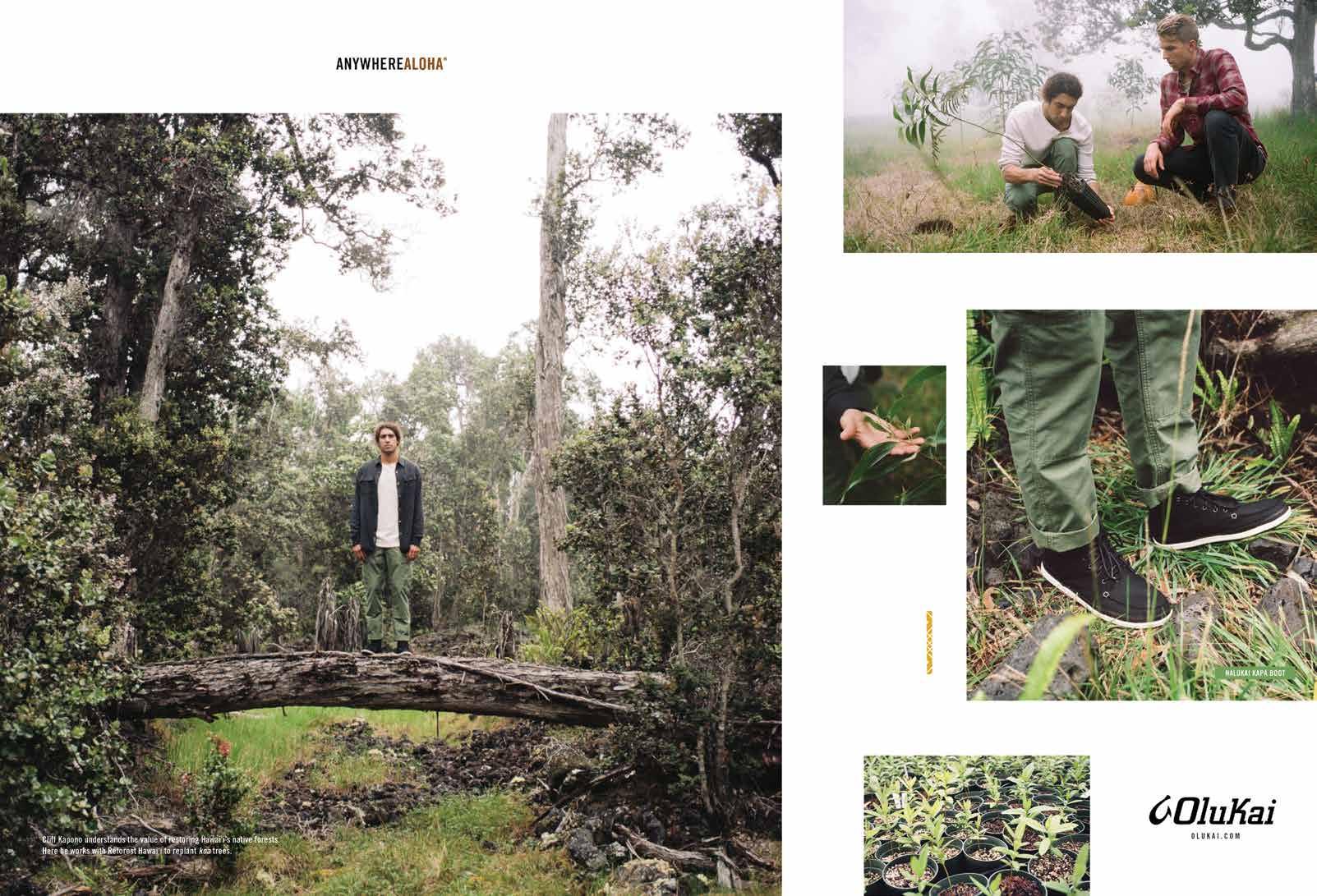

TRIBES
Editor’s Letter
Contributors
FLUX PHILES
24 | Culture: The Pōpolo Project
36 | Science: The Hawaiian Crow
42 | Culture: Kānaka Rangers
48 | Arts: Kilohana Art League
A HUI HOU
192 | Waikīkī Beachboys

FEATURES
54 | A Place of Refuge
Rae Sojot ventures to Puʻuhonua o Waiʻanae, Hawai‘i’s largest homeless encampment, to see how it has become a mecca for those who seek safe shelter, including the toddler shown above.
66 | Seniors Strike Back
Martha Cheng discovers how a community and its kūpuna are fighting to prevent a Kailua institution from being razed.
76 | Patriots Adrift
Despite not being U.S. citizens, Micronesians have risked their lives fighting for the United States. Timothy A. Schuler writes about how the unique immigration status of this group leaves them in limbo once they retire from service.
86 | The Witness
Matthew Dekneef examines the lasting impact of the work of Ed Greevy, who photographed land struggles and political strife in the Hawaiian Islands for more than three decades.
102 | Jew-ish
Beau Flemister journeys from land to sea to discover what it means to be Jewish in Hawaiʻi.
112 | Stranger Than Paradise
A photo essay by the anonymous Honolulu-based photographer known as @misterver captures the energy, color, and spontaneity of Waikīkī through the lens of his iPhone.
| FEATURES |
TABLE OF CONTENTS
22
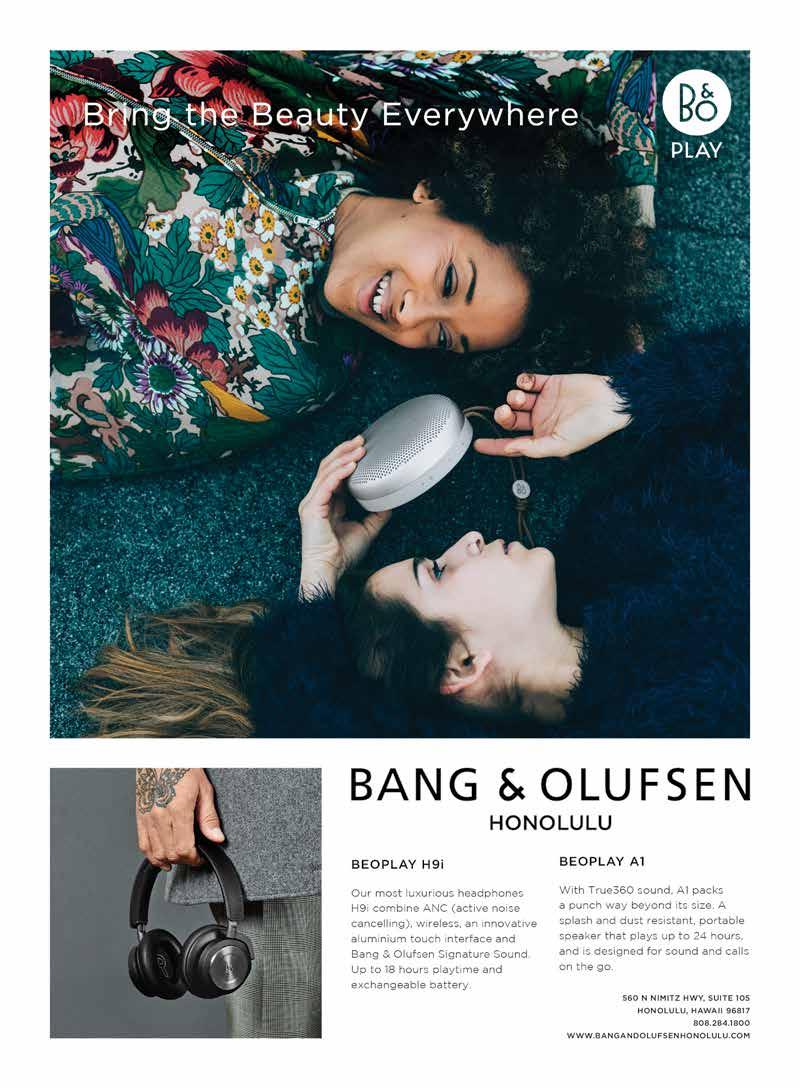
TABLE OF CONTENTS | SECTIONS |

SPECIAL SECTION:
KAKA‘AKO
Living , working, and walking in the growing neighborhood of Kaka‘ako reveals the energy of its local community.
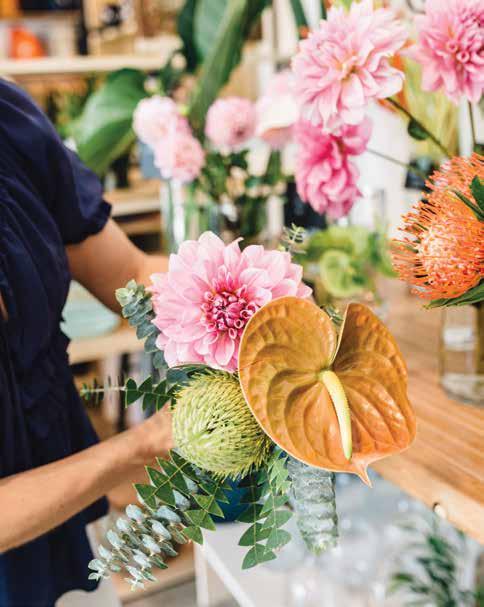
126
Shown left, Milo, a lifestyle boutique that shares a space with the popular café Arvo and floral shop Paiko, shown above.

150 | Design Pāhiki Eco-Caskets
154 | Wellness
Maui’s Naturists
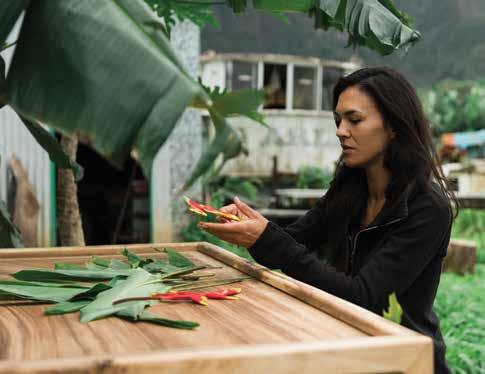
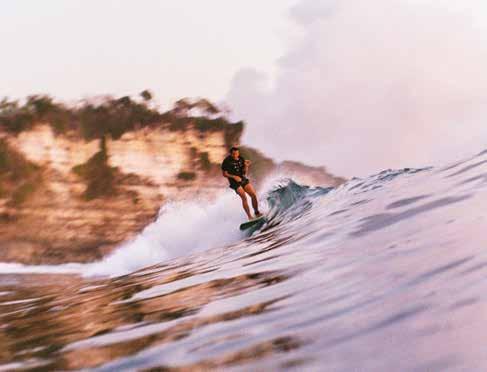
TABLE OF CONTENTS | SECTIONS | 162 EXPLORE
Architecture
Travel
Indonesia 148 LIVING WELL
164 |
Hawai‘i Brutalism 180 |
Bali,
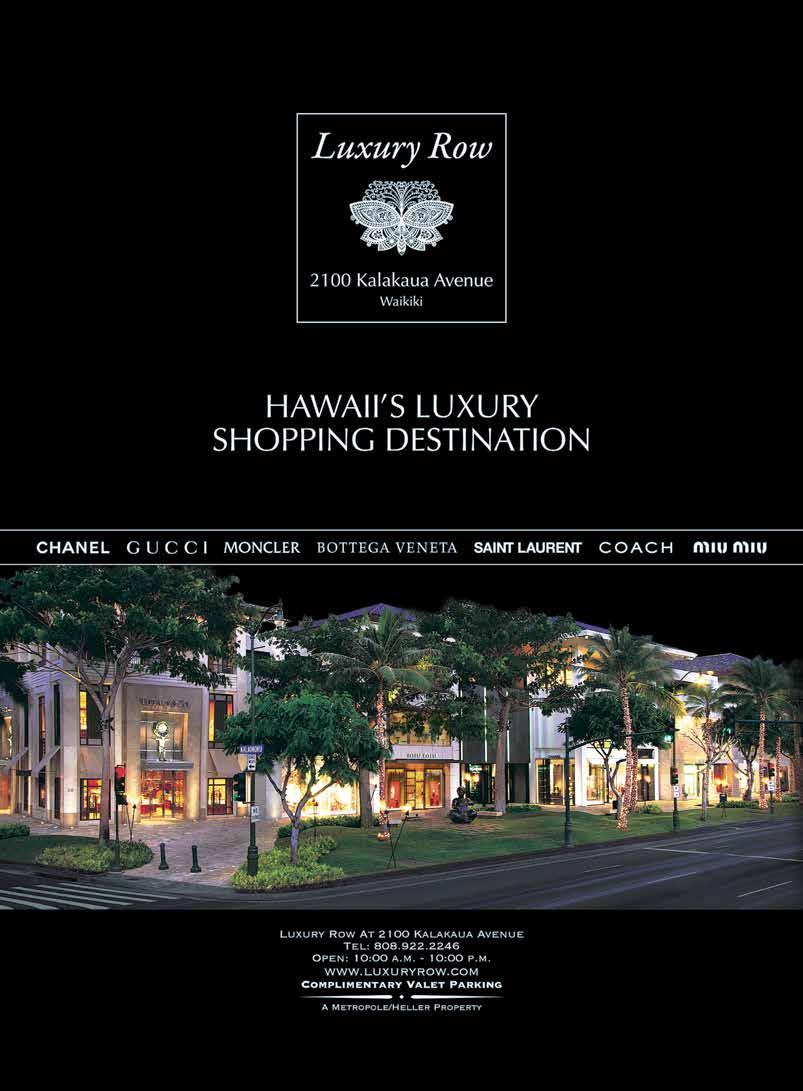
TABLE OF CONTENTS
Stay current on arts and culture with us at:
fluxhawaii.com
/fluxhawaii
@fluxhawaii
@fluxhawaii
@fluxhawaiitravel
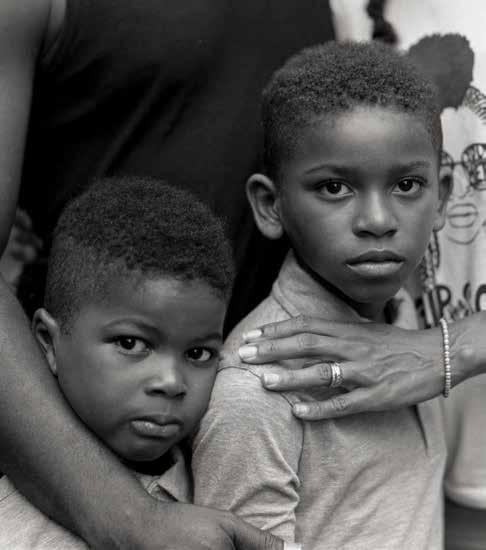
FLUX TV
The Legacy of Language
We chat with members of the Pōpolo Project about what it means to be black in Hawai‘i. “It’s really about creating a space for us to ask questions about what it means to be here, what it means to be in our bodies here, what it means to be representatives of our different lineages here,” says founder Akiemi Glenn.
Behind the Lens: Ed Greevy
For three decades, Ed Greevy documented peoples’ struggles over land in the Hawaiian Islands from the frontlines. We visit the photographer to discover how the the social movements of the 1970s to 1990s organized, resisted, and can be remade today.
|
FLUX TV |
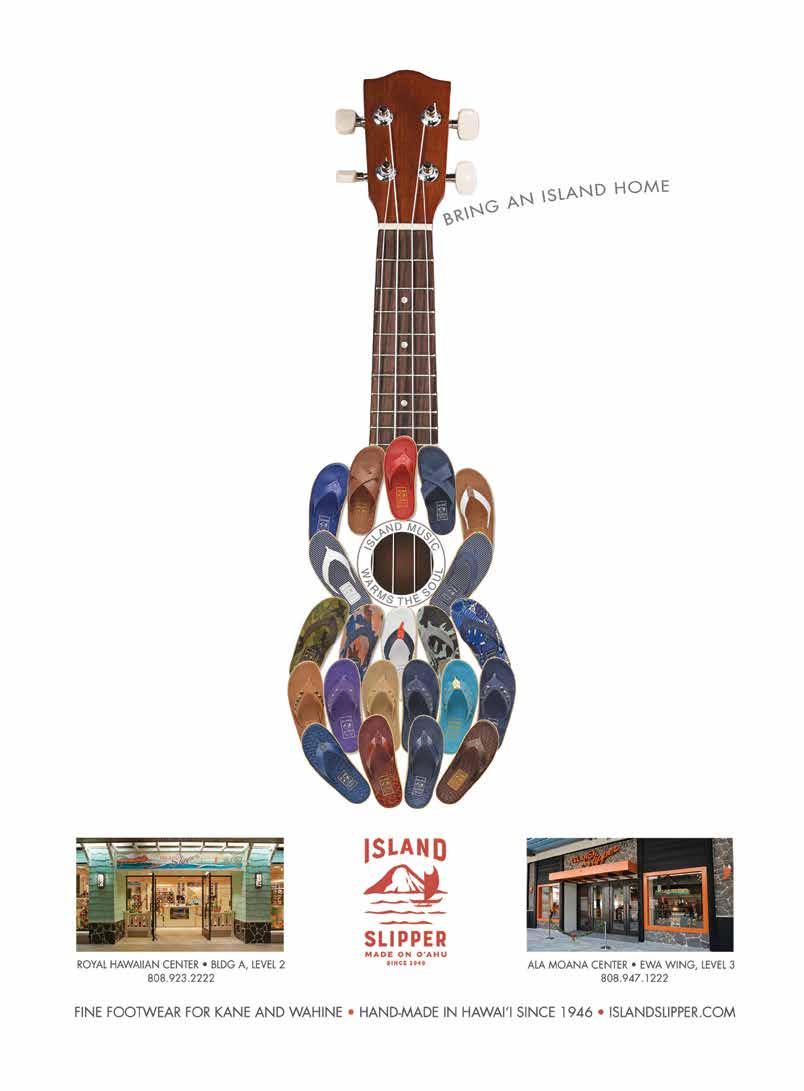
EDITOR’S LETTER | TRIBES |
In July 2017, Andres Magaña Ortiz was deported to Mexico after living nearly 30 years in Hawai‘i.
Ortiz was one of Kona’s most respected coffee farmers, working his way from a coffee picker as a teenager to owning his own farm and helping others run their farms as an adult. He even aided the U.S. Department of Agriculture in combating the spread of the coffee berry borer, which threatened to wipe out Hawai‘i Island crops in 2010. But Ortiz was also in the country illegally, having been smuggled across the border in 1989 at age 15 to join his mother, who was living in California. When President Trump took office in November 2016, he vowed to make immigration a landmark part of his agenda, and Ortiz became one of the first in Hawai‘i to feel the effects of Trump’s immigration crackdown. When he left for Morelia, Mexico, a place he has not known for most of his life, he left behind his wife and three children, who are all American citizens.
It was during this time that the idea for the Tribes-themed issue was born, when the country was roiled—and still is—in a debate over immigration. Though Hawai‘i can often feel removed from the effects of what’s happening around the country, Ortiz’s case brought the reality of these new immigration policies into stark focus.
It’s hard not to compare the country’s new immigration tactics with the orders that swept up people groups and shoved them into internment camps on the basis of race during World War II. During that time, citizens who were at least 1/16 Japanese were given just six days notice before they were taken with only what they could carry to isolated relocation centers around the country—upwards of 120,000 people in total, including 17,000 children under 10 and thousands of elderly.
Seven decades later, in June, the Supreme Court upheld Trump’s Muslim travel ban on the grounds of
national security, while simultaneously overturning Korematsu v. United States, the 1944 ruling that upheld the forcible detainment of JapaneseAmerican citizens. In response, UCLA law professor Hiroshi Motomura, who has written extensively on immigration and citizenship, stated in The New York Times, “Overruling Korematsu the way the court did in this case … is deeply troubling, given the parts of the reasoning behind Korematsu that live on in today’s decision: a willingness to paint with a broad brush by nationality, race or religion by claiming national security grounds.”
When we ignore the nuances of any given situation, we run the risk of decaying into what Utah senator Orrin Hatch described as “a divided country of ideological ghettos.” But we may already be there. According to the Pew Research Center, Republicans and Democrats are more ideologically divided than they have been in the last two decades, and both parties increasingly view the other as a threat to the nation’s wellbeing.
During World War II, my grandfather served along with other men from the Hawai‘i National Guard in the 100th Infantry Battalion (nicknamed the “Purple Heart Battalion” for the high number of men injured in combat), which later joined forces with the 442nd Regimental Combat Team. Composed primarily of Japanese-American soldiers, this regiment would become the most decorated unit in American military history, while the country sanctioned what many today view as one of the most heinous violations of civil rights in 20th century America. In one of the most famous acts of valor, soldiers from the 100th/442nd charged through enemy fire in the Vosges Mountains in France to rescue men from the 141st Texas Infantry Regiment, who had
been surrounded by German forces. Over six days of fierce combat, my grandfather, a medic, braved enemy fire to drag wounded soldiers out of the forest. Eventually, the 100th/442nd combat team would save 211 of the 275 Texans, but not before losing hundreds of men in the rescue.
My grandfather died of cancer before I got the chance to meet him, but I know that he risked his life in service of others because he refused to let the government’s assumptions about his loyalty, his identity, define who he was or what he believed in. Like the men in my grandfather’s unit, who banded together in solidarity amid discrimination that tore lives apart, the people featured in this issue show us that tribes can bind us to one another, helping us to inch forward in unity amid a divided society.
We see this on vibrant display in the formation of the Pōpolo Project, whose members, part of a group that makes up less than 4 percent of Hawai‘i’s population, reappropriated a term of derogation into one of power; in the community of Pu‘uhonua o Wai‘anae, whose formerly homeless inhabitants strode down a path to a place of purpose and belonging; in the legacy of Ed Greevy, whose images documented the people and purpose of social movements from a few decades past that still have the power to unite us again today. And while it would be all too easy to hunker down and indulge the tribes of people that look, sound, and think like we do, it is only when we venture out from beyond the barriers that separate us that battle lines can truly be broken.
With aloha,
Lisa Yamada-Son EDITOR lisa@nellamediagroup.com
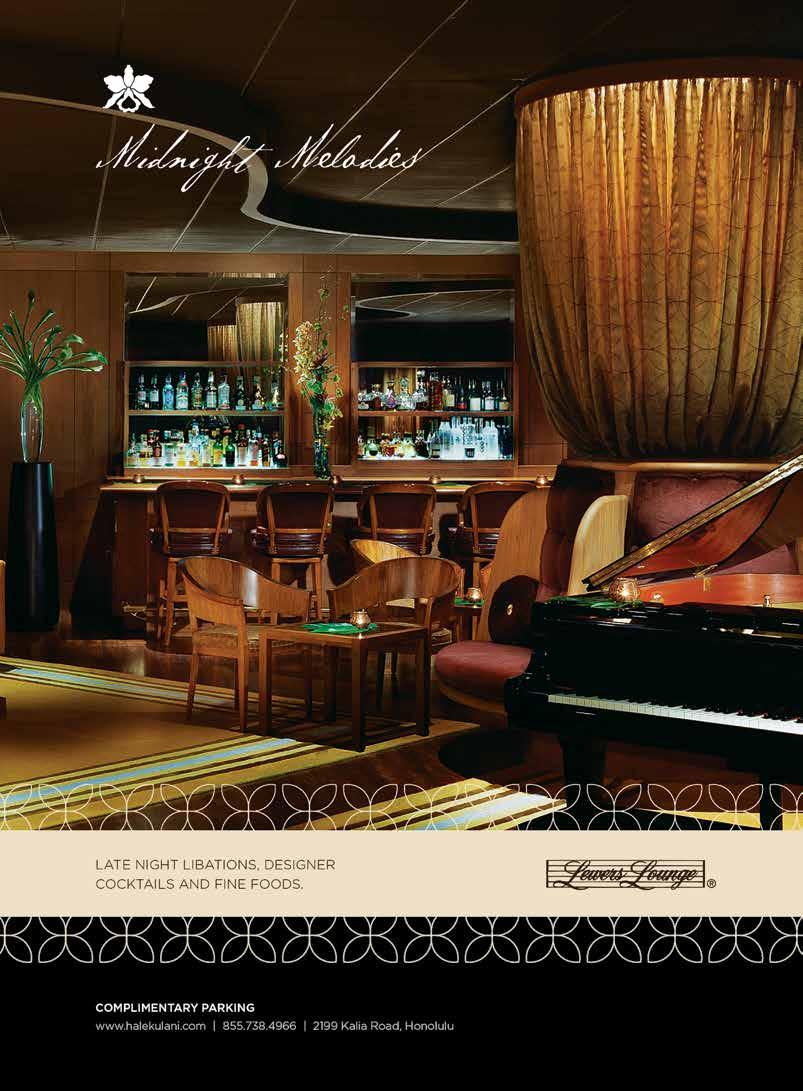
MASTHEAD | TRIBES |
What is a tribe that shaped you in your youth?
“Growing up as an immigrant, there was a pressure to hide my Filipino culture. But my family resisted the urge to be Americanized. Understanding my heritage reminds me to never forget where I’ve come from. I’ve realized the identity that others wanted me to be ashamed of is integral to who I am.”
PUBLISHER
Jason Cutinella
EDITOR
Lisa Yamada-Son
CREATIVE DIRECTOR
Ara Feducia
MANAGING EDITOR
Matthew Dekneef
ASSOCIATE EDITOR
Anna Harmon
SENIOR EDITOR
Rae Sojot
DESIGNERS
Mitchell Fong
Michelle Ganeku
JUNIOR DESIGNER
Skye Yonamine
PHOTOGRAPHY DIRECTOR
John Hook
PHOTO EDITOR
Samantha Hook
EDITORIAL ASSISTANT
Eunica Escalante
CREATIVE ASSISTANT
Naz Kawakami
“My Japanese family tribe has shaped my cultural identity from an early age by sharing traditions, language, and core values with me. For instance, my mother made up the kanji to the name she gave me, Naoko, which literally means ‘child of seven promises/values.’”
IMAGES
Marie Eriel Hobro
Cidney Kelly
Kyle Kosaki
Lila Lee
@misterver
Kainoa Reponte
IJfke Ridgley
Chris Rohrer
Wolf & Woman
CONTRIBUTORS
Martha Cheng
Beau Flemister
Travis Hancock
Cash Lambert
Kelsie Pualoa
Timothy A. Schuler
ADVERTISING
Mike Wiley
GROUP PUBLISHER mike@nellamediagroup.com
Francine Beppu
NETWORK STRATEGY DIRECTOR francine@NMGnetwork.com
Chelsea Tsuchida
MARKETING & ADVERTISING EXECUTIVE
Kylee Takata
ADVERTISING ASSISTANT
Hunter Rapoza
MARKETING & SALES COORDINATOR
©2009-2018 by Nella Media Group, LLC. Contents of FLUX Hawaii are protected by copyright and may not be reproduced without the expressed written consent of the publisher.
OPERATIONS
Joe V. Bock
CHIEF REVENUE OFFICER joe@nellamediagroup.com
Gary Payne VP ACCOUNTS RECEIVABLE gpayne@nellamediagroup.com
Courtney Miyashiro OPERATIONS ADMINISTRATOR courtney@nellamediagroup.com
MEDIA
Gerard Elmore LEAD PRODUCER gerard@NMGnetwork.com
Kyle Kosaki VIDEO EDITOR
Shaneika Aguilar JUNIOR VIDEO EDITOR
Aja Toscano
NETWORK MARKETING COORDINATOR
INTERN Kylie Yamauchi
General Inquiries: contact@fluxhawaii.com
“I loved movies, video games, TV, and I wasn’t part of the cool kids (read: limited friends). Then I got into hip-hop, and I freestyled using pop-culture references and became a breaker, using aspects of what I learned from doing wrestling and judo in high school. Here, I finally found myself.”
PUBLISHED BY:
Nella Media Group 36 N. Hotel St., Ste. A Honolulu, HI 96817
FLUX Hawaii assumes no liability for products or services advertised herein.
FLUX Hawaii is a triannual lifestyle publication. ISSN 2578-2053
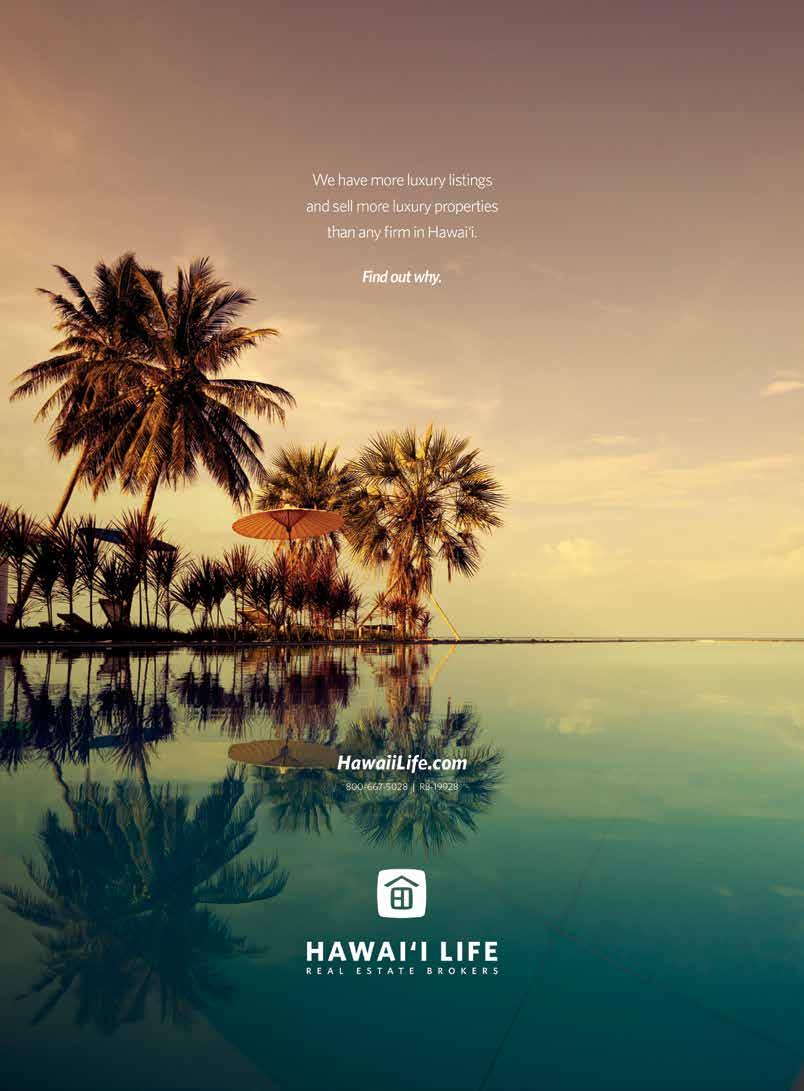
CONTRIBUTORS

On the Cover
A portrait of artist Nicole Maileen Woo photographed at Pu‘u‘ōhiʻa (also known as Mount Tantalus) by Chris Rohrer. Woo is a member of The Pōpolo Project, which was started by Akiemi Glenn as a way to discuss the black experience in Hawai‘i. Pōpolo—the Hawaiian name of an indigenous herb with edible black berries—is sometimes used in the islands plainly as a marker of black race, but it can also hold racist connotations. By reappropriating its usage, the word becomes a tool of empowerment. “Art holds the transformative ability to tell the stories of the marginalized with resounding voice and vigor,” Woo says. “Yet for any story to be heard, a platform is crucial. The Pōpolo Project is such a platform.” Read about the group on page 24.

Marie Eriel Hobro
Marie Eriel Hobro is a documentary photographer and filmmaker from leeward
O‘ahu who is part of Wolf & Woman, a documentary media collective for women, people of color, and LGBTQ creatives in Hawai‘i. Nearly every weekend, she and other members of the collective teach photography to youth from Leilehua High School and Pu‘uhonua o Wai‘anae.
“People can learn a lot from Pu‘uhonua o Wai‘anae,” says Hobro, whose photos of the encampment are featured in “A Place of Refuge” on page 54. “Some people who go to Pu‘uhonua o Wai‘anae flee from situations where they feel like they don’t belong, but the familial bonds of the village help them gain that feeling back.
Even if they don’t have a lot of material things, the people there always make sure to give back and help others. They practice a lot of what’s missing in our current society, and I think that everyone can learn something from them.”

@misterver
Since joining Instagram in 2012 as @misterver, the anonymous Honolulubased photographer has been capturing the constant energy, color, and spontaneity of O‘ahu’s streets—all through the lens of his iPhone. In the photo essay “Stranger Than Paradise” on page 112, the candid consumerism that runs throughout the city is observed. “The tourism industry forces us to look at Waikīkī in a certain way, and I’m always trying to find new ways to frame the usual,” the photographer says via email. “Waikīkī is a lifelong dream to some and an everyday existence to others. It’s interesting how travel can separate people from their group or tribe yet helps them to define it when stepping out in a new environment.”

Timothy A. Schuler
Originally from Kansas, Timothy A. Schuler usually writes about design, ecology, and the natural environment. For the feature “Patriots Adrift” on page 76, Schuler found that a tribe can be elastic and inclusive. “Since the 2016 presidential election, it seems as if we’ve watched America become a nation of warring tribes,” he says. “Writing about Micronesian islanders serving in the U.S. military, I realized that these men and women might have been the ultimate outsiders, foreigners fighting for a nation not their own, and yet I heard story after story of walls coming down, not being built up. To me, it proved that tribal lines can be redrawn. We just have to find those things that unite us.”
| TRIBES |

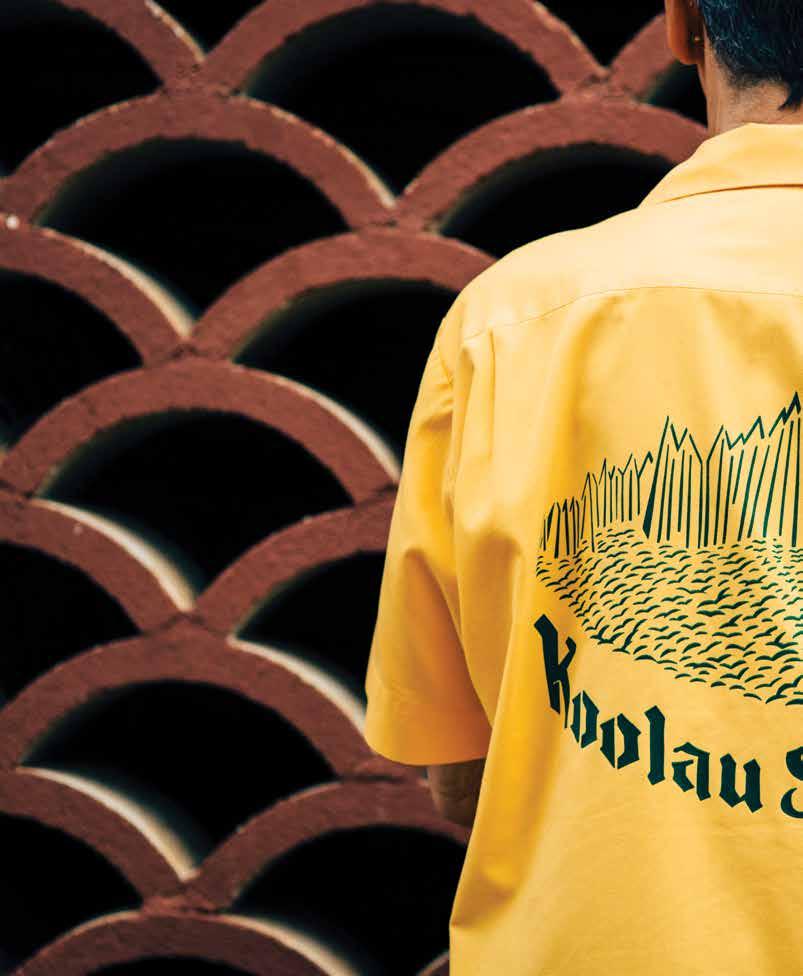 When developers threatened to raze their beloved bowling alley, Kailua seniors fought back. Image by IJfke Ridgley.
When developers threatened to raze their beloved bowling alley, Kailua seniors fought back. Image by IJfke Ridgley.
TRIBES
“Don’t feel like you have to intervene. Just shut up and listen.”—Ed Greevy

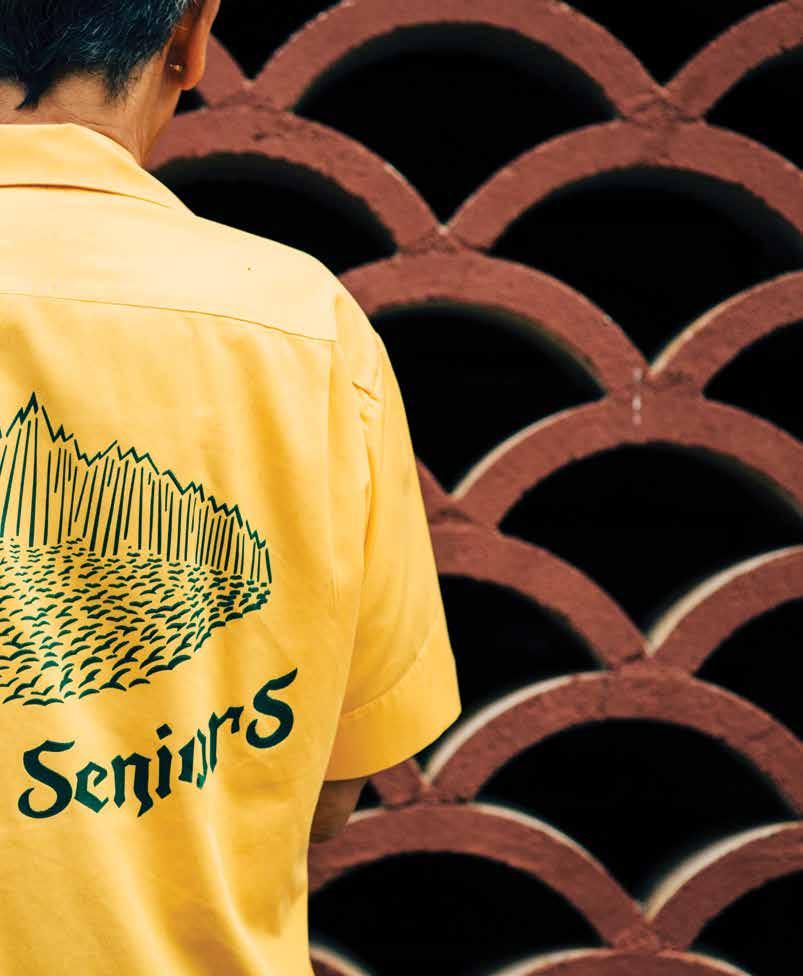
The Lineage of Language
The Pōpolo Project asks that we start with one word and tell a new story.
TEXT BY KELSIE PUALOA
IMAGES BY CHRIS ROHRER
pō.polo (n.)
1. The black nightshade (Solanum nigrum, often incorrectly called S. nodiflorum), a smooth cosmopolitan herb, 0.3 to 0.9 meters high. It is with ovate leaves, small white flowers, and small black edible berries. In Hawai‘i, young shoots and leaves are eaten as greens, and the plant is valued for medicine, formerly for ceremonies. Also polopolo. The fruit is hua pōpolo. Because of its color, pōpolo has long been an uncomplimentary term: see lepo pōpolo.
— Hawaiian Dictionary by Mary Kawena Pukui and Samuel H. Elbert
Jarmila Jarmon says her skin carries a lot of history. She grew up in Salt Lake and Pacific Palisades on O‘ahu, and recalls moments of feeling like “the only one.” When slavery was discussed in class, she says, “People would look at you and ask, ‘What do you think about that?’” Jarmon wanted to talk to other local kids about these things, but there weren’t many kids like her. She also felt her experiences seemed too manini, or small, to discuss with her parents, who lived in North Carolina during the Jim Crow era. Years later, she feels like she has found a group with whom she can share her experiences as a black person: the Pōpolo Project.
Akiemi Glenn, the 37-year-old executive director of the Pōpolo Project, says she started the project in 2015 as a way to learn about the black experience in Hawaiʻi after moving to Honolulu from New York. The black community represented less than 4 percent of Hawaiʻi’s population, according to the 2016 U.S. Census, and Glenn wanted to support her community by creating a space where people could talk about their stories and culture.
“We don’t necessarily have an agenda or really want to be able to have a definitive representation of the black experience in Hawaiʻi,” Glenn says of the Pōpolo Project, which has since grown into a collective of community members with a board of directors. “It’s really about creating a space for us to ask questions about what it means to be here, what it means to be in our bodies here, what it means to be representatives of our different lineages here.”
Started by Akiemi Glenn, shown fourth from the right, the Pōpolo Project examines what it means to be black in Hawai‘i.
FLUX PHILES | CULTURE | 24 | FLUXHAWAII.COM
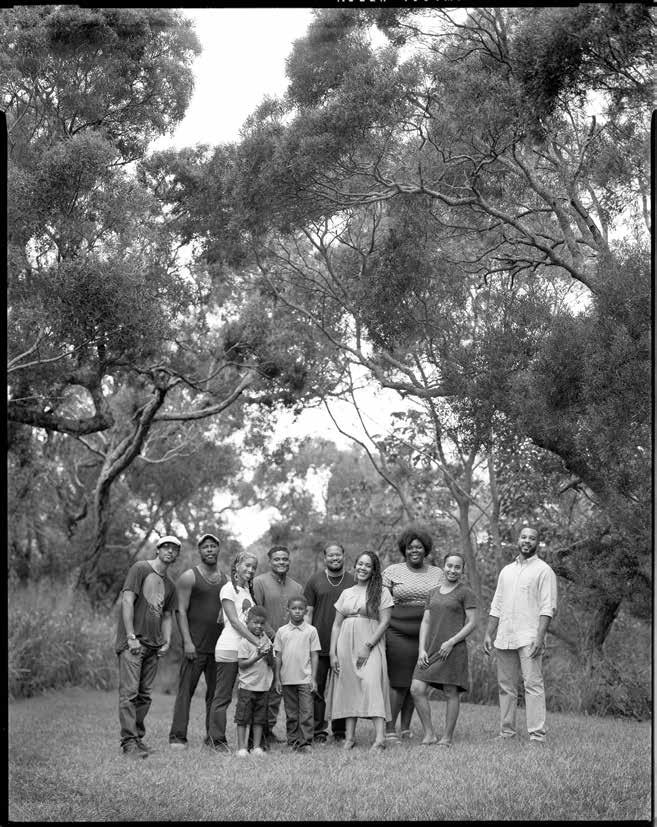
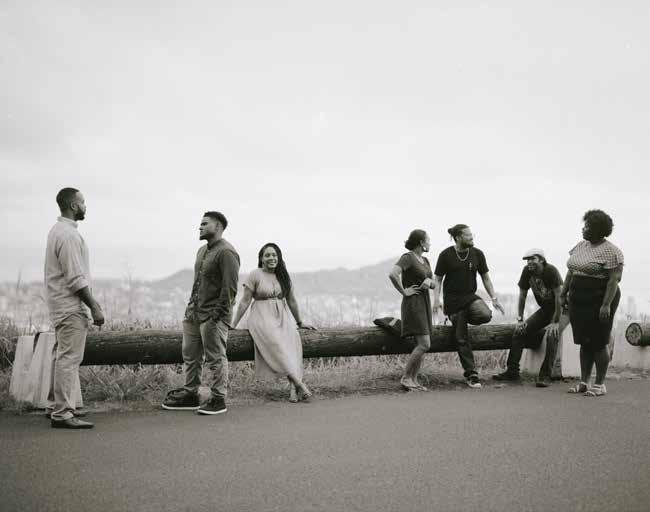
When Pōpolo Project members talk about their experiences, there is a palpable sense of relief, a meditative exhale in the midst of tension. The opportunity to do so is one some have not had before. Throughout the year, and especially in February (Black History Month) and August (Black August), the Pōpolo Project holds events like film screenings with panel discussions or art exhibits featuring works by members. Glenn continues to seek out stories of black people in the islands and gather research about black history in Hawaiʻi. (The resulting Pōpolo Syllabus is available on the group’s website.)
At early Pōpolo Project events, people shared their painful histories with the word “pōpolo.” Also the Hawaiian name of an indigenous herb with rounded leaves, white flowers, and edible black berries, time and context have given the word an uneasy racialized weight. Although “pōpolo” is sometimes used plainly as a
marker of black race, people told Glenn that there are racist connotations to the word. They cautioned her about including “pōpolo” in the project’s title.
As a linguist and a black woman, Glenn understands this difficult relationship with language very well. Elders in her family still don’t like using “black” to reference their community because of how negatively it was used in the past. Yet “black” has undergone a cultural restoration, and is used to symbolize strength, unity, and celebration. The Pōpolo Project aims to add more layers to the word “pōpolo” by sharing the stories of black people in Hawaiʻi. If a harmless word for a medicinal herb can be weaponized as a slur, there is an equal chance that, with the right treatment, it can be used to empower.
“It’s really about creating a space for us to ask questions about what it means to be here, what it means to be in our bodies here, what it means to be representatives of our different lineages here,” says Pōpolo Project founder Akiemi Glenn.
Pōpolo Project members discuss the black experience in Hawai‘i online at fluxhawaii.com.
26 | FLUXHAWAII.COM

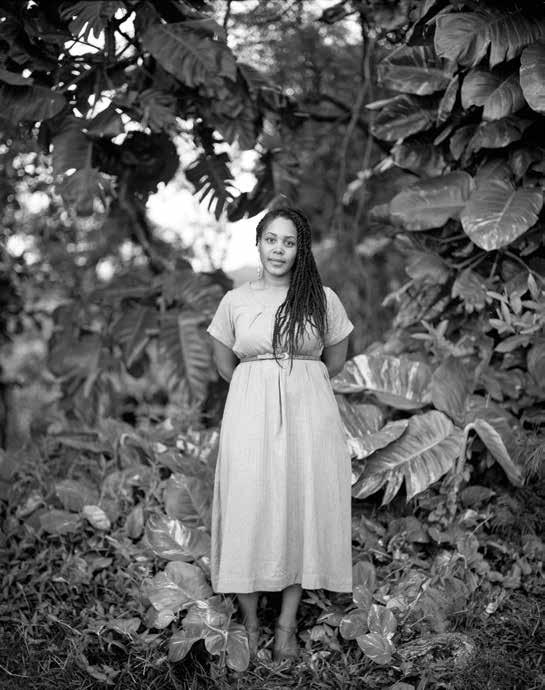
Akiemi Glenn
Age: 37
Residence: Pālolo
Occupation: Linguist and executive director of the Pōpolo Project
“There’s not one way to be black from Hawaiʻi. It’s not just about being Barack Obama or Janet Mock. It’s about the different experiences. It links to a larger question of what it means to be black anywhere.”
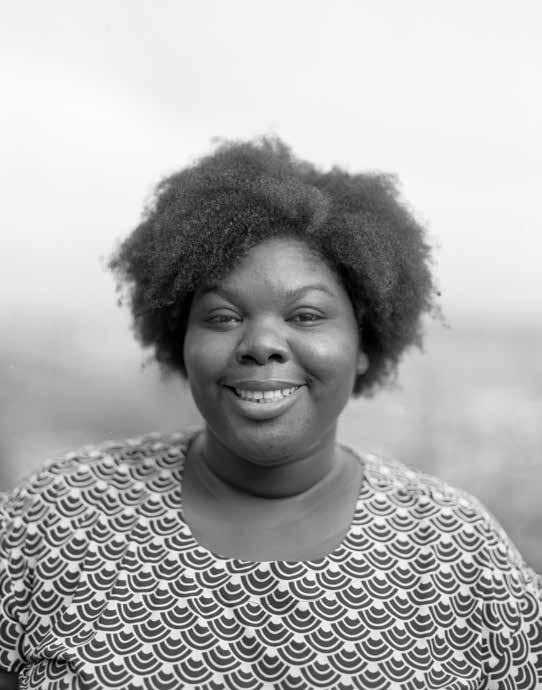
Jamila Jarmon
Age: 35
Residence: Honolulu
Occupation: Special Projects at Elemental Excelerator
“I grew up here in Hawaiʻi, and I kind of grew up thinking I was the only one. Hearing about the Pōpolo Project and being able to create community is something I missed as a child. If we can do that now, at least I can have it as an adult, and we can create a community for children growing up in Hawaiʻi who are black.”
FLUXHAWAII.COM | 29
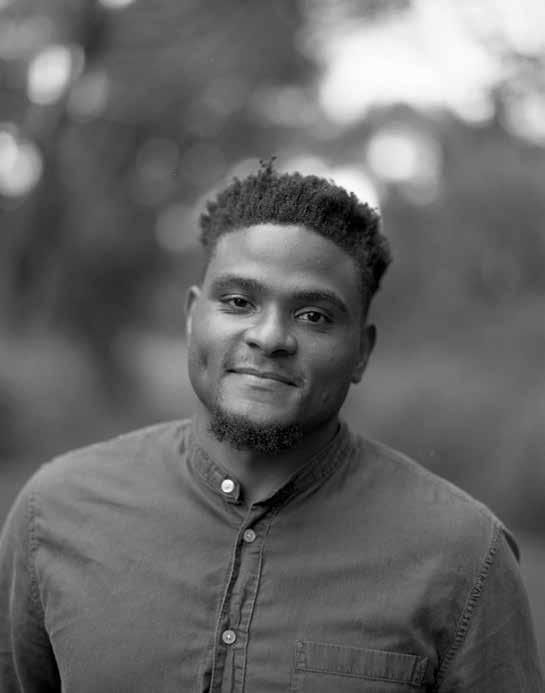
Edward Hemphill
Age: 28
Residence: Kahaluʻu
Occupation: Grant writer
“Storytelling is so important. The stories you are told about this place often ignore the stories that highlight injustice here. That’s what is really important to me about the Pōpolo Project—making the connections between stories of those impacted by colonization.”
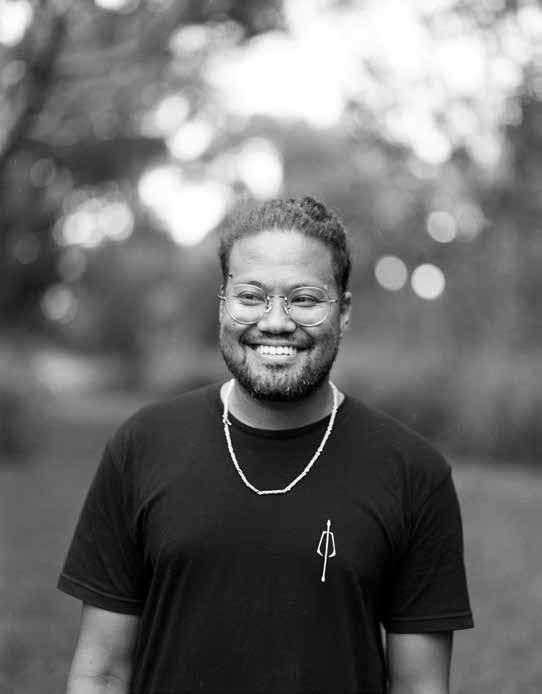
Rechung Fujihira
Age: 35
Residence: Honolulu
Occupation: Owner of The Box Jelly
“Being black here is like being a superminority. When we were younger, there weren’t many black people. So I think our experience is definitely different, and we have been able to share and talk about that. Finding a community has been great.”
FLUXHAWAII.COM | 31
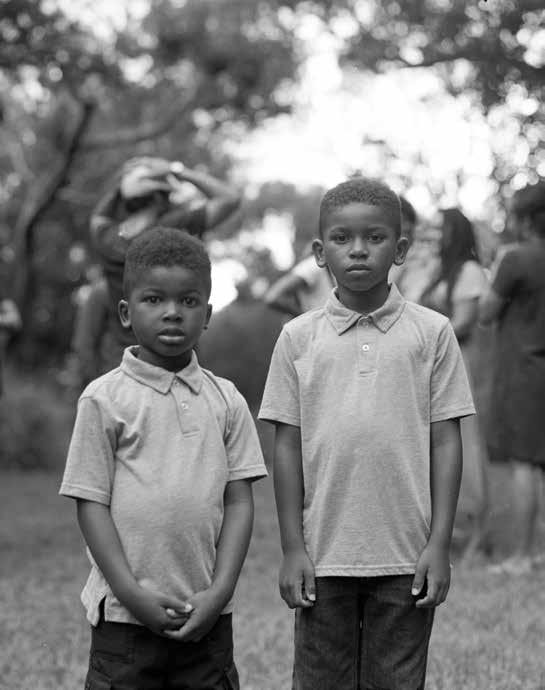
Ade Milligan (age 6)
Amari Milligan (age 8)
Nicole Maileen Woo (age 43)
Mark Feijão Milligan II (age 41)
Residence: Waiʻanae
Occupations: Artists and students
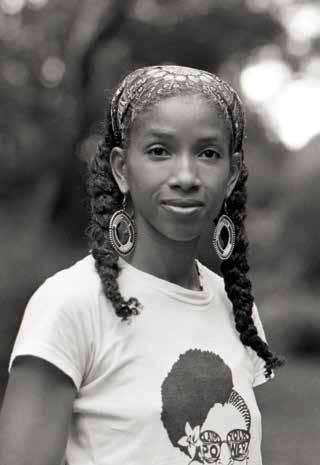 Nicole Maileen Woo
Nicole Maileen Woo
“Art has always also been at the crux of social and political change throughout the ages. And as a potent change agent, art holds the transformative ability to tell the stories of the marginalized with resounding voice and vigor. Stories build bridges. Yet for any story to be heard, a platform is crucial. The Pōpolo Project is such a platform.”
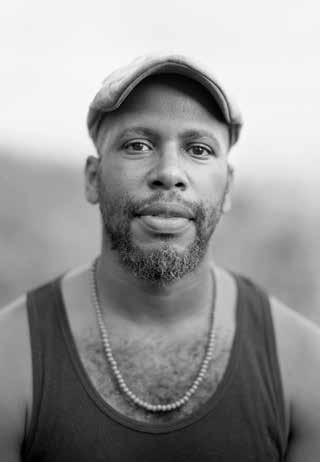
Mark Feijão Milligan II
“As a U.S. Virgin Islander, I see clear connections between the Native Hawaiian experience and the experience of people of the African diaspora. What we experience in the Atlantic, you experience here in Hawai‘i. Both peoples have spiritually rich cultures with strong ties to ancestral energy and ʻāina. Both peoples have withstood colonial oppression and are reclaiming our true legacies with unwavering pride as we move toward the future.”

Hasan “Sonny” Scott
Age: 40
Residence: Honolulu
Occupation: English teacher at Kamehameha Schools at Kapālama
“As an African-American living in Hawaiʻi, I always appreciated when I saw my people out here, and I knew I wanted to connect with them and be able to expand that familiarity that we share. There’s nothing like being yourself around your people.”
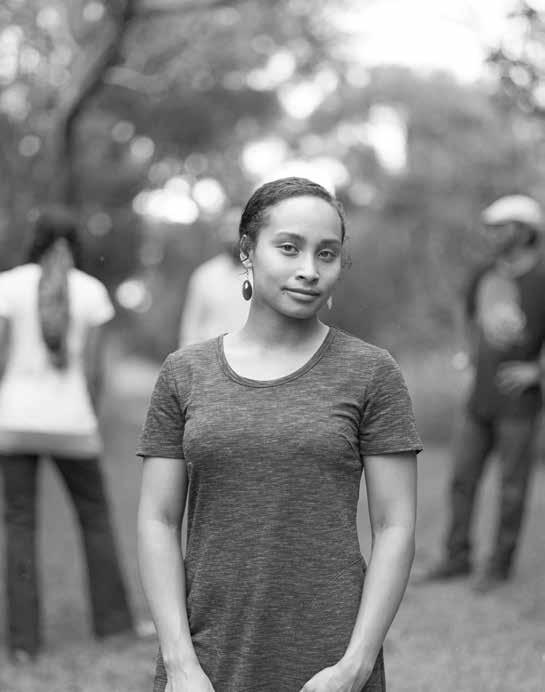
Serena Michel
Age: 22
Residence: Kaimukī
Occupation: Student at University of Hawaiʻi at Mānoa
“ Before I moved here, I felt that I was always Dominican, but no one had ever given me permission to go back in time and connect to that—not even myself. So when I came to Hawaiʻi and saw how much ancestry and genealogy is so important here, I finally felt I could give myself permission to travel through the histories of colonization and trauma and revive that history through my writing.”
Call of the Wild
A few hours spent with a critically tiny but resilient group of ‘alalā, the Hawaiian Islands’ endemic crow, gives a glimpse into recovery efforts intended to bring the species back from the brink of extinction.
TEXT BY MATTHEW DEKNEEF
IMAGES BY JOHN HOOK
We hear the birds before we see them. From somewhere amid the shaded terrain of ʻōhiʻa lehua and shady koa at the Keauhou Bird Conservation Center Discovery Forest, an unexpected caw cuts through the still, morning air. The screech, shrill and piercing, belongs to an ʻalalā, a crow endemic to Hawai‘i that most people have rarely heard, let alone seen. Its animal call, then, is cause for childlike excitement as we approach the Keauhou Bird Conservation Center, set in the interior of the forest’s 150 acres. It is at these Hawaiʻi Island headquarters located outside Volcano that the revival efforts of critically endangered native birds including the ʻalalā are spearheaded.
Designated “Extinct in the Wild” on the International Union for Conservation of Nature Red List of Threatened Species, the ʻalalā is the most threatened species of the entire crow family. Today, only 142 ʻalalā remain, the majority of which are cared for at the Keauhou center and a bird facility on Maui. Most notable, however, are the 11 ‘alalā living wild in the Puʻu Makaʻala Natural Area Reserve on the windward side of Hawaiʻi Island, where they were released by conservationists last year.
Bryce Masuda, the conservation program manager of the Hawai‘i Endangered Bird Conservation Program, leads me inside the Keauhou center’s main building to see two ʻalalā. “These are the most social of our birds,” Masuda says. Leo Mana and Po Noe, a 17-year-old male and a 10-year-old female, respectively, have become the most accustomed to guests. Their open-air aviary features sturdy ʻōhiʻa and koa branches on which the birds perch, a tray of fruits that include ʻōhelo berries to sustain their frugivorous diet, and a tire-sized container of water. We peer into the aviary from a viewing room designed to accommodate visits from schools, volunteers, the local community, and media.
Leo Mana and Po Noe are hard to miss. Their wingspans measure about 40 inches, and their bodies are roughly as wide as footballs. There’s a depth to their plumage, a silverblue luster that glows beautifully against the sun’s natural light. Around their necks are a ring of feathers that fans out like a fluffy beard. ʻAlalā are monogamous, and Leo Mana and Po Noe appear to be a match made in bird heaven, passing berries back and forth with their beaks to feed each other. The ʻalalā are more majestic, yet cuter, than I expect crows to be.
They are also noticeably inquisitive and alert. About half an hour into observing them, Po Noe, certainly the more expressive of the two that morning, picks up a tiny stick with her bill and pokes it into a hole in a log on the ground. She is probing for insects, Masuda
At the Keauhou Bird Conservation Center, researchers work to save the ‘alalā, or Hawaiian crow, designated “Extinct in the Wild” on the International Union for Conservation of Nature Red List of Threatened Species.
FLUX PHILES | SCIENCE | 36 | FLUXHAWAII.COM
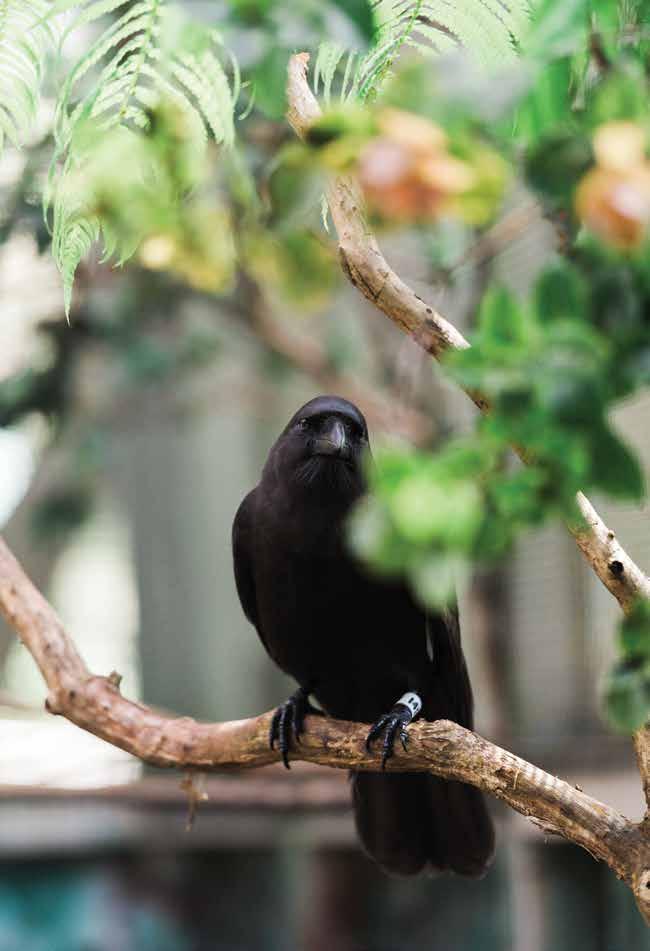
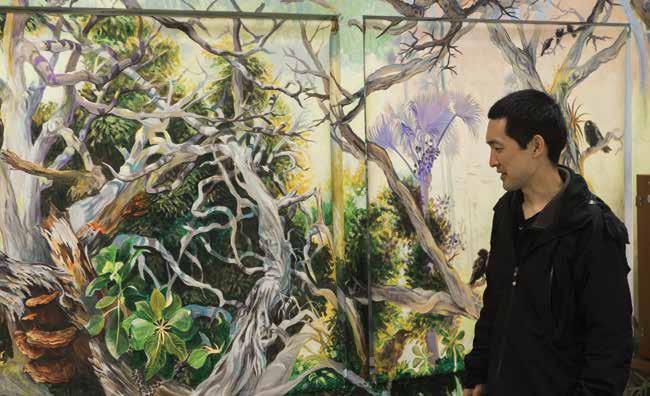
explains, a foraging talent he refers to as “tool use.” It is the most distinctive display of the ‘alalā’s intelligence—the South Pacific’s New Caledonian crow is the only other documented crow species to showcase tool-wielding abilities—and quite remarkable in the animal kingdom, considering that fewer than 1 percent of the world’s animal genera use tools.
There are still fundamental questions about Hawaiʻi’s native crow that scientists have yet to answer. “What does it mean for an ʻalalā to be angry at another ʻalalā?” Masuda asks hypothetically as we watch Leo Mana and Po Noe fly and hop about the aviary. Through observation, he hopes humans will one day know the answers to such questions. “The better we understand their natural behavior,” he says, “the better we can reintroduce them into their habitat.”
Like many native bird species in the islands, the ʻalalā has a familiar and tragic narrative. No one can assert what its normal population size was precontact, according to Masuda, but fossils indicate they were found throughout the Hawaiian Islands. The birds flourished enough to be heard far and wide by the native settlers— ‘alalā in Hawaiian means “to bawl, bleat, scream”—who figured them into Hawaiian
legends and gathered their feathers for kāhili, standards that symbolized nobility. Even Captain Cook, when he arrived at a village in Kawaʻaloa, was forewarned not to disturb a pair that were kept as ceremonial pets and considered ʻaumakua. Then avian malaria arrived with mosquitos, and settlers introduced predators like rats, mongoose, and feral cats, which eat birds and their eggs. By the early 1990s, fewer than 15 ‘alalā were known to exist.
The Keauhou Bird Conservation Center, operated by the Hawai‘i Endangered Bird Conservation Program, opened in 1996—the same year the last ‘alalā egg was laid in the wild—with 18 aviaries dedicated to recovering the species. But due to disappearing forest, crow numbers continued to diminish. The last time a truly wild pair of ‘alalā were seen in their natural habitat was in 2002.
It takes a flock of institutions to save this single species. In this case, the Hawaii Endangered Bird Conservation Program, which includes the rehabilitation activities at Keauhou and on Maui, has partnerships with parent organization San Diego Zoo Global, the State of Hawai‘i Division of Forestry and Wildlife, the U.S. Fish and Wildlife Service, and Kamehameha
“The better we understand their natural behavior, the better we can reintroduce [‘alalā] into their habitat,” says Bryce Masuda, the conservation program manager of the Hawai‘i Endangered Bird Conservation Program.
38 | FLUXHAWAII.COM
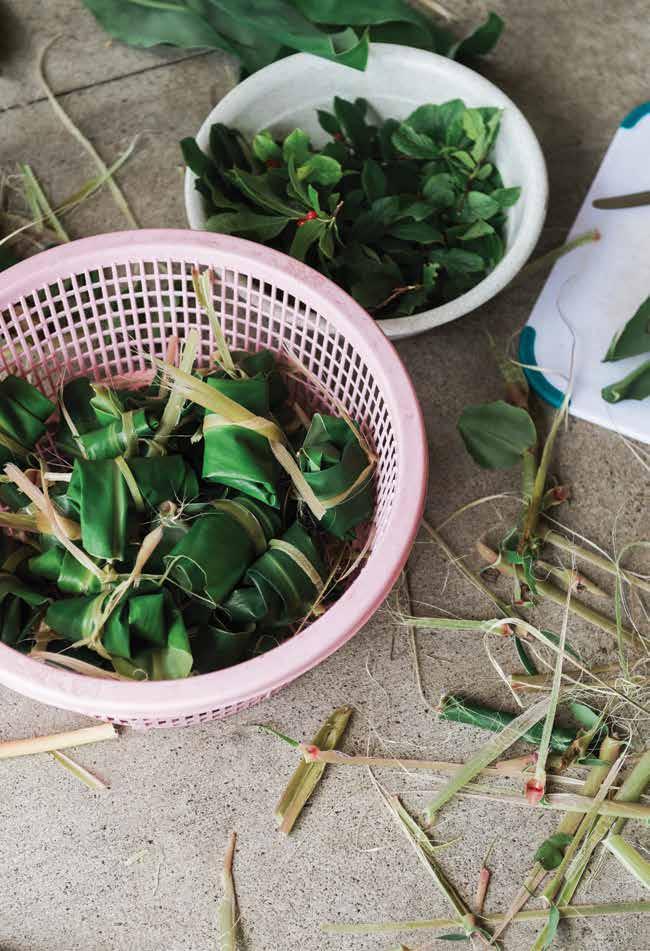
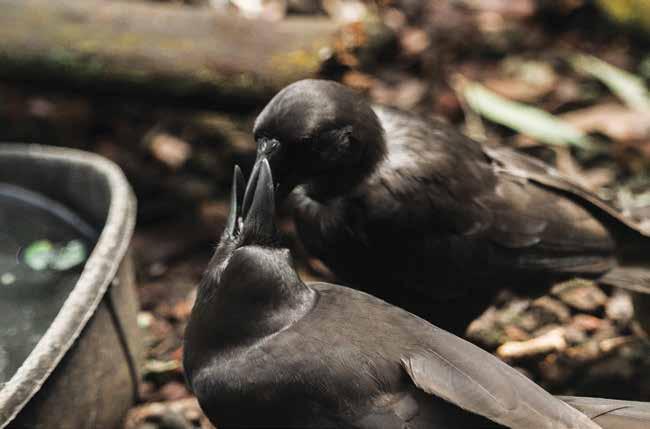
Schools for funding, permitting, and land management. The facilities serve as hubs where research and recovery teams monitor the captive birds, breed them, and incubate and hand-rear chicks. When the center pairs up the ʻalalā in aviaries, they start by matching the furthest related individuals to prevent inbreeding. In 2016, after increasing the species to more than 125 birds, Masuda oversaw a widely publicized release of five ʻalalā into the wild. The excitement was tempered when three turned up dead within two weeks of their release. (The remaining two were recaptured by specialists.) Masuda remembers the day he had to recover one. The bird was motionless in the grass, its breast torn and caked with blood. A necropsy revealed it was killed by an ʻio, the Hawaiian hawk, a natural predator of the ‘alalā. “It was just a shock,” Masuda recalls. “Just to come across it dead, it was devastating.” But it was also as nature would have intended.
Efforts to reintroduce the species are ongoing—the 11 ‘alalā released in Pu‘u Maka‘ala are succeeding in the wild, and 10 more are being prepared for a future release—and lessons continue to be
learned. The ‘alalā program now intends to introduce younger birds into the reserve, since they are expected to better adjust to their surroundings and fend off danger if they observe how other forest birds interact with predators. Eventually, researchers hope the first generation of ʻalalā will again be born in the wild. A thriving ʻalalā population would not only help recover the native forest through foraging and spreading seeds, but would also allow scientists to learn about their natural behavior and responses to the habitat. For instance, compared to all other crows and ravens, ʻalalā have the most vocalizations, according to Masuda. Researchers have identified at least 24 unique calls used in the aviaries. But they have also found that the ʻalalā’s vocal repertoire became less pronounced in captivity. This vibrant language originated in a dense, sprawling forest, and would be enriched if the birds could once again explore the region. As I leave the center, an ʻalalā calls out from within the aviary. It is impossible to discern if it is a cry of joy or despair. But it is reassuring to hear the ‘alalā, loud and clear.
‘Alalā are monogamous and highly intelligent, one of the fewer than 1 percent of the world’s animal genera that use tools to perform such tasks as foraging for food.
40 | FLUXHAWAII.COM
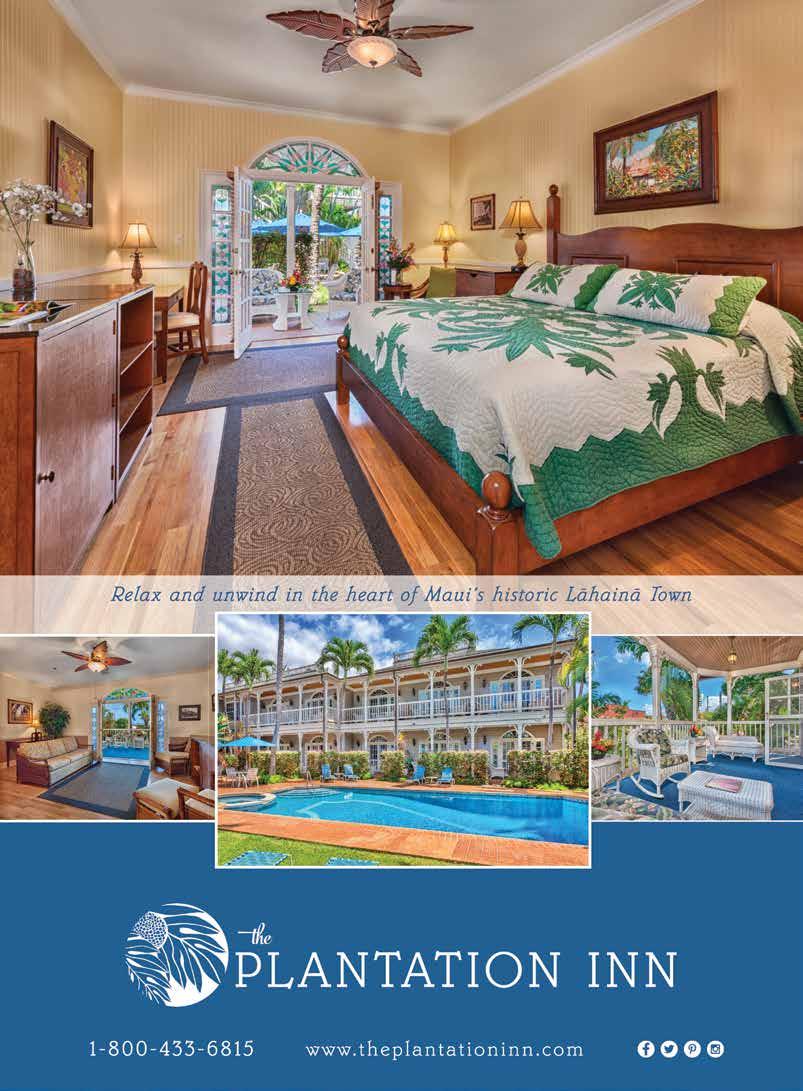
First Watch
At the base of Maunakea, the Kānaka Rangers keep a vigilant eye on the mountain to raise awareness of the lands surrounding it.
TEXT BY RAE SOJOT
IMAGES BY JOHN HOOK & MIKE WILEY
Standing nearly 14,000 feet above sea level, Maunakea is a majestic vision rising before those traveling to its summit. Along the mountain’s primary access road, a vast expanse of field is matched by a vast expanse of sky. Near the juncture where the access road meets Daniel K. Inouye Highway stands a small, wooden booth that had appeared in the silent chill of dawn in the spring of 2018. “This wen drop outta the sky,” Hanale Halualani says of it. This booth is where Halualani and his fellow Kānaka Rangers, the self-appointed stewards of Maunakea’s Hawaiian homelands, assemble for voluntary eight-hour shifts to monitor the mountain’s activity. Easily spotted by their wide smiles and neon safety vests, they stand alongside the road welcoming summit visitors and offering sweaters, water, and refreshment to anyone who stops.
They aren’t there to protest anything, the Kānaka Rangers make clear. As kānaka maoli and custodians of the ʻāina, they are there to observe. Every hour of every day, a rotating shift of three rangers (with three on standby and three on-call) man the observation station, monitoring reports of trespassing, illegal tour operations, and unauthorized camping. In 2014, a fire that burned down two historic cabins of Humuʻula Sheep Station off the summit access road was caused by an unauthorized camper, Halualani says. On March 26, their very first night watch, the rangers caught someone stealing fence lines and notified authorities.
The Kānaka Rangers also log vehicles by color, type (Hawai‘i Department of Land and Natural Resources or University of Hawai‘i, for example), license plate, and passenger headcount. Monitoring activity is the first step in addressing land and resource management issues surrounding water, forestry, and wildlife on Maunakea state trust lands, the Kānaka Rangers say. It precludes the crunching of numbers that inform dialogue about infrastructure issues like roads and housing.
“[The Department of Hawaiian Home Lands] say they need $7 million to do what we are doing, to build something like this and pay staff to take numbers,” Halualani claims, raising his eyebrows. “And here we are doing it for free.”
Their checkpoint, or “observation station,” as they call it, was erected on a date of significance to the Kānaka Rangers: Prince Jonah Kūhiō Kalanianaʻole’s birthday. “We
The Kānaka Rangers, a volunteer-led group at Maunakea, collect activity data and engage with summit visitors to help better address its land and resource management issues.
42 | FLUXHAWAII.COM FLUX PHILES | CULTURE |

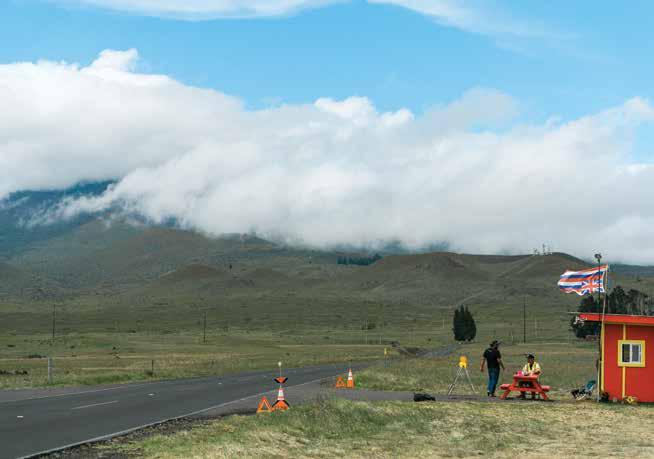
want to bring awareness to his legacy,” says Halualani of the Hawaiian prince who served as Hawaiʻi’s first territorial delegate to U.S. Congress. In 1921, Kalanianaʻole spearheaded the passage of the Hawaiian Homes Commission Act, which dedicated 200,000 acres of homestead land across Hawai‘i to Native Hawaiians of 50 percent or more Hawaiian blood quantum. Those eligible are to be awarded a 99-year land lease at $1 per year. Kalanianaʻole’s intent, according to beneficiaries like the Kānaka Rangers, was to “‘āina hoʻopulapula,” or to rehabilitate the land and its people, thereby preserving the values, traditions, and culture of Native Hawaiians. A fullblooded Hawaiian, Kalanianaʻole was brokenhearted over what he saw to be the dying of his race since the overthrow of the Hawaiian monarchy in 1893. The act was his effort to save it.
But in the near century that has passed since the Hawaiian Homes Commission Act was enacted, the Department of Hawaiian Home Lands, the agency responsible for the provision of the act, has been stymied
by lack of funds and poor administration, according to Halualani. There are 10,000 homestead leaseholders statewide and more than 26,000 applicants who are waitlisted. “But in the last 97 years, over 9,000 have died waiting on that list,” Halualani says. (The Department of Hawaiian Home Lands did not return requests for comment.)
If the wait for a homeland lease isn’t painful enough, the irony of nonbeneficiaries being granted leases is an additional sting. The law allows for vacant land not yet awarded be leased to nonbeneficiaries to generate income to help carry out the objectives of the Hawaiian Homes Commission Act. However, nearly half of the allocated land is granted to non-beneficiaries rather than to the Native Hawaiians it was intended for, and often at an exorbitantly low cost. This includes large swaths of the 67,000 acres of state trust lands that unfold along Maunakea’s slopes. The University of Hawaiʻi pays $1 a year to lease 11,000 acres near the summit. Nearby in Pōhakuloa, the U.S. Army uses
The Kānaka Rangers checkpoint, or “observation station,” on Maunakea Access Road was erected on the birthday of Prince Jonah Kūhiō Kalaniana‘ole, the territorial delegate who championed the Hawaiian Homes Commission Act.
44 | FLUXHAWAII.COM
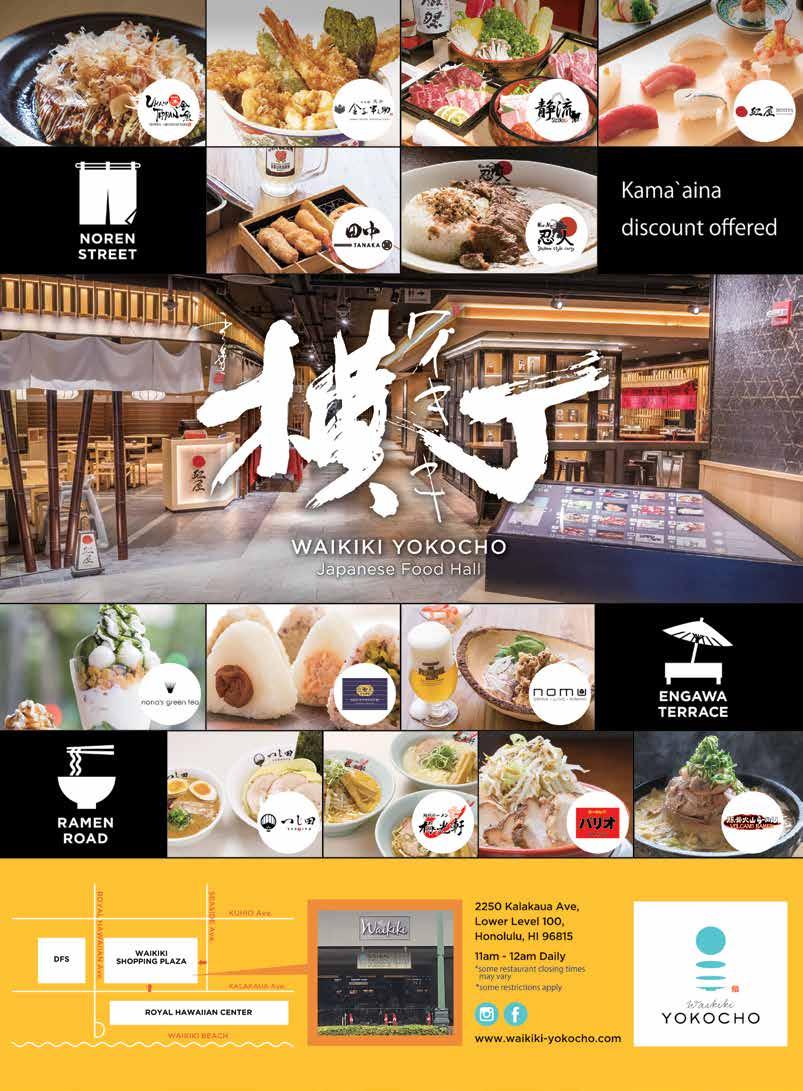
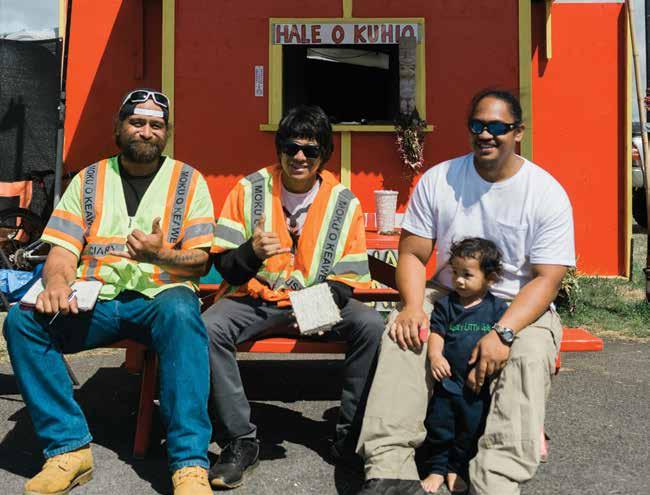
nearly 23,000 acres for activities that include live-fire training at the rate of $1 for a 65-year lease period.
Retail enterprises, like Prince Kuhio Plaza shopping center, Walmart, Target, and Home Depot, all located in Hilo, were constructed on once-vacant Hawaiian Home Lands pasture lots. According to the Department of Hawaiian Home Lands website, commercial leases are awarded at market value. Still, a more pressing concern looms. “Where is the rehabilitation of the people when you destroy the land for commercial use?” Halualani asks. Rather than protest or excoriate the Department of Hawaiian Home Lands, the Kānaka Rangers prefer to be proactive. They want the Hawaiian Homes Commission Act better fulfilled by having more Hawaiians awarded their rightful lands, including those found at Maunakea. “This is the legacy we want to see succeed,” says Halualani of the Kānaka Rangers’ continuous presence and
monitoring efforts on the mountain. “To make it simple, better land management leads to accelerated land awards.”
The cool, spring morning of March 26th, when the Kānaka Rangers and their observation station made their first official public appearance, Halualani remembers two squalls accompanied by rain—“blessings,” he calls them—followed by a vivid ānuenue, or rainbow, stretching over the vast expanse of sky. He saw the rainbow as an auspicious sign, a hōʻailona, or blessing, and as acknowledgment from the ancestors. “The ‘āina needs kānaka, and the kānaka needs the ‘āina,” Halualani says. “That is why we Kānaka Rangers are here. This land is our kuleana.”
The Kānaka Rangers want to see the Hawaiian Homes Commission Act better fulfilled. Pictured, Mikey Kyser, Hanale Halualani, and Mai‘kai Kanui, who rotate shifts at the booth with other volunteers.
46 | FLUXHAWAII.COM
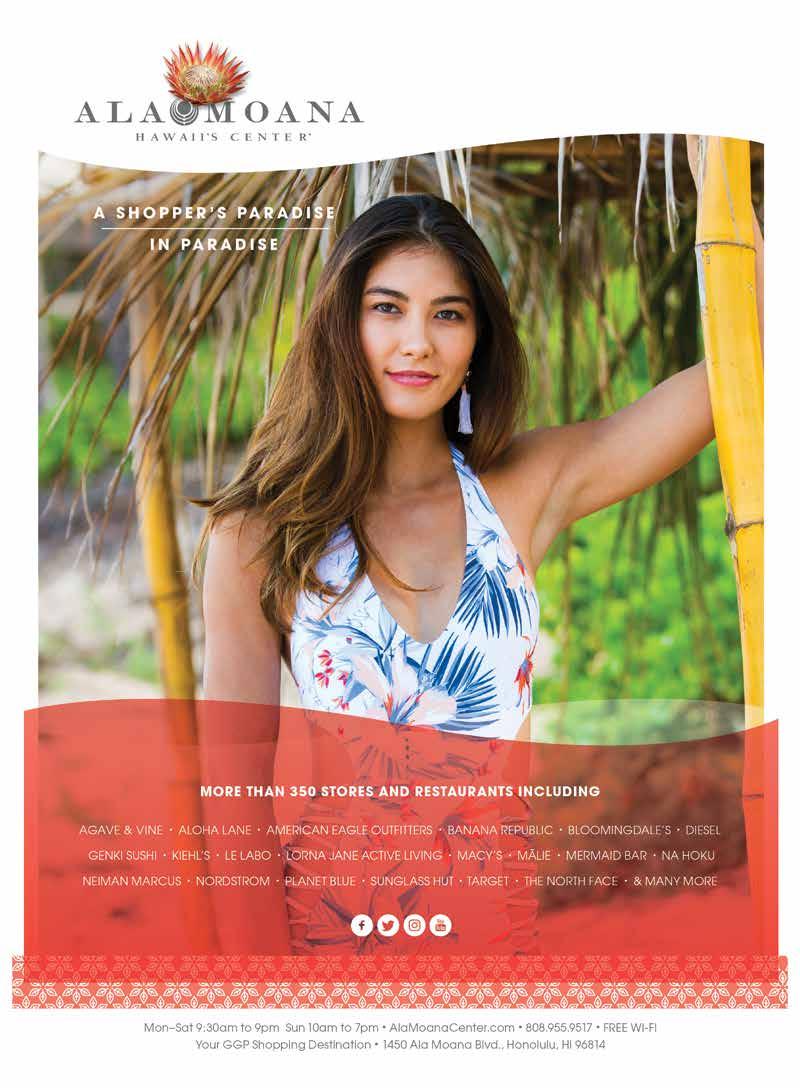
The Aesthetics of Annexation
Unearthing the Kilohana Art League, the most influential art society in Hawai‘i’s history that you have never heard of.
TEXT BY TRAVIS HANCOCK
More than 100 years before the 2018 Kīlauea eruption in lower Puna began drawing spectators with high-definition cameras, the same volcano attracted a second-generation missionary descendant from Hilo named David Howard Hitchcock to record its flows in sketches and watercolors. In 1885, the traveling French painter Jules Tavernier saw Hitchcock’s work and encouraged him to go abroad to master his skills. Hitchcock left for three years to study in New York and then Paris, where he managed to get an impressionistic painting of a French country road into the famed Académie des BeauxArts’ annual salon exhibition.
His European training complete, Hitchcock sailed triumphantly into Honolulu Harbor in November 1893—less than one year after the Hawaiian monarchy was toppled. Within a month, the haole-owned Hawaiian Gazette reported, “Our artist, D. Howard Hitchcock, has just returned from a two week’s sketching tour at the volcano and through the Puna district.” These sketches served as Hitchcock’s first studies for a Modernist line of works that culminated with a piece depicting a rare daylight view of the volcano. This painting, as described by art historian David Forbes, “showed the usual fiery lava lake but also had effects of strong, raking sunlight and clouds of blue vapor and gas rising from the pit.”
Today, Hitchcock and Tavernier are remembered as pillars of the Volcano School, the islands’ first major group of internationally recognized artists. For many years, the group’s molten landscapes set aglow a dedicated room at the Honolulu Museum of Art. But in 2017, the museum’s new Arts of Hawaiʻi curator Healoha Johnston broke up the paintings in her effort “to introduce new narratives about Hawai‘i’s social history through the lens of art,” as she wrote in her curator’s notes. Johnston’s intervention upended the idea that white Euro-American artists aptly represented the “Arts of Hawaiʻi,” a deeprooted notion first propounded by Hitchcock’s lesser-known artistic association, the Kilohana Art League.
Hitchcock launched this art society in May 1894 with a small exhibition on Hotel Street, with the purported aim of establishing a modern art culture in the islands. The group’s four founders—Hitchcock, woodcarver Augusta Graham, English sculptor Allen Hutchinson, and painter Annie H. Parke—chose the name “Kilohana,” meaning the topmost layer of a Hawaiian quilt or a high vantage point, to denote their excellence. By 1896, its membership had reached at least 125 members.
This advertising display from the 1890s at the King Bros. Art Store showcases motifs developed by Kilohana Art League artists. Shown center, an empty canoe on a tropical shore, likely painted by Jules Tavernier or D. Howard Hitchcock. Image courtesy of Hawaiian Historical Society.
FLUX PHILES | ART | 48 | FLUXHAWAII.COM

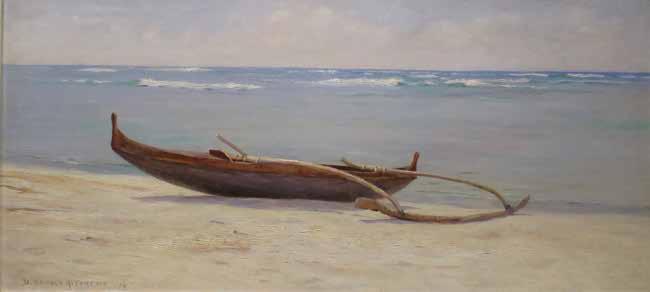
The league participated in American expos, held literary contests, and hosted international artists, logging many of these achievements in a scrapbook now shelved at the Hawaiian Historical Society, where Kauaʻi-born art historian Stacy Kamehiro found it. “There are all these clippings of the exhibitions and what they were doing, and it sounded like more of a social club,” Kamehiro says. “Then when you looked and saw who was involved, it became clear that this social club was very much linked to the political clubs of the time.” According to her, if you look at the affiliations of those who joined the League, they were all linked to the cause of the annexing of Hawai‘i to the United States.
Kamehiro, who teaches at University of California, Santa Cruz, is currently exploring what she calls the “aesthetics of annexation.” Through what was essentially propaganda, Kamehiro argues, the league was “able to create a cluster of images of belonging to a place, of thinking they belong to a place, and claiming it.” She cites portraits of haole elites, paintings of their homesteads and
lush plantations, and images of a decaying traditional life—all of which were geared toward proving the viability of American culture in the islands. “When they do show something like a hale, a Hawaiian home, it’s usually dilapidated,” Kamehiro explains. “It’s very much about, ‘This is passing, this is gone. It’s going away, and we’re replacing it with all of our prosperity.’”
Hitchcock also leaves Kamehiro suspicious. “Hitchcock does 20 to 30 paintings of empty canoes—canoes on beaches with no people, no Hawaiians attached to them,” she says. “There is a literal and also sort of symbolic removal of kānaka maoli from the landscape, whereas Robert Barnfield and Joseph Strong, who were friends of [King] Kalākaua, were showing brown bodies, kānaka maoli bodies, who were engaged with canoeing, fishing, doing stuff. Strong also showed pictures of the Japanese immigrants, which were completely absent from the Kilohana Art League. They didn’t want to show the Asians at all.” This art of removal extended to the league’s 1899 literary collection, Six Prize Stories, which
50 | FLUXHAWAII.COM
The Beach at Waikiki , D. Howard Hitchcock (1861 – 1943), 1896 oil on canvas, Bishop Museum.
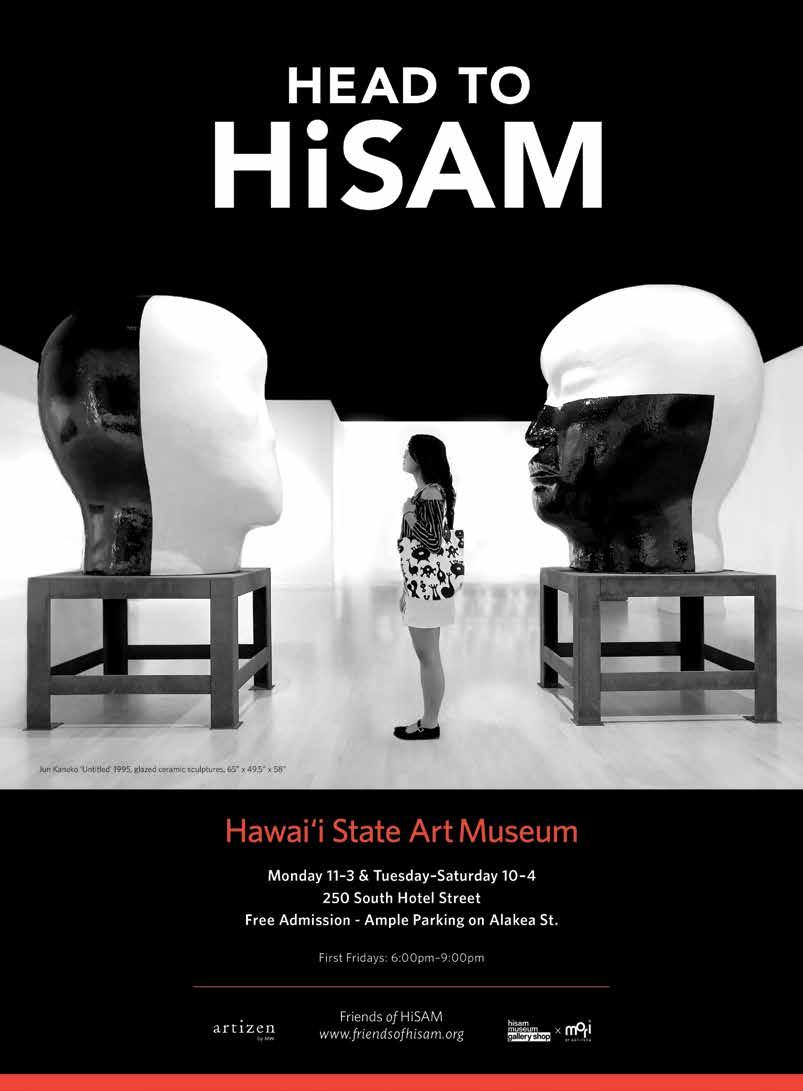

featured five stories by named white authors and a sixth assigned only to “A Native.”
By the early 1900s, the vast league was subdivided into circles, including painting, music, drama, reading, and later, the outdoors—the last of which is now known as The Outdoor Circle, an environmental nonprofit. The circles held gatherings around the city until the wealthy businessman and politician Charles Montague Cooke granted them the use of a large building on Beretania Street. When the sprawling league fractured apart in 1913, many of its pieces ended up in Cooke’s collection. In 1927, his wife, Anna Rice Cooke, transformed her Beretania home into the Honolulu Academy of Arts, which became the Honolulu Museum of Art in 2012.
In May, as Kīlauea continued to erupt through fissures in lower Puna, making national headlines, Kamehiro, who has family on Kaua‘i and O‘ahu, was among the many people to receive messages from distant friends asking if they remained
safe from the flow of the eruption. Somehow, in 2018, the media failed the islands’ geography and led mainlanders to believe lava may be inching toward any and every home in the state. This is nothing new. Through 240 years of alleged representation in ink, paint, film, and pixels, Westerners have allowed Hawai‘i Island’s smoking peaks to blind them from the whole picture. It is the same cultural smokescreen that first billowed in with the Volcano School and floated up to new, commanding vantages, the supposed “kilohana,” in the hands of artists whose early visions of fire and brimstone became the forge and cornerstone of an ingenious, igneous ignorance.
Halemaumau Eruption at Night , D. Howard Hitchcock (1861 – 1943), 1917 oil on canvas, courtesy of Honolulu Museum of Art, gift of Aaron G. Marcus, 1978 (4612.1).
52 | FLUXHAWAII.COM
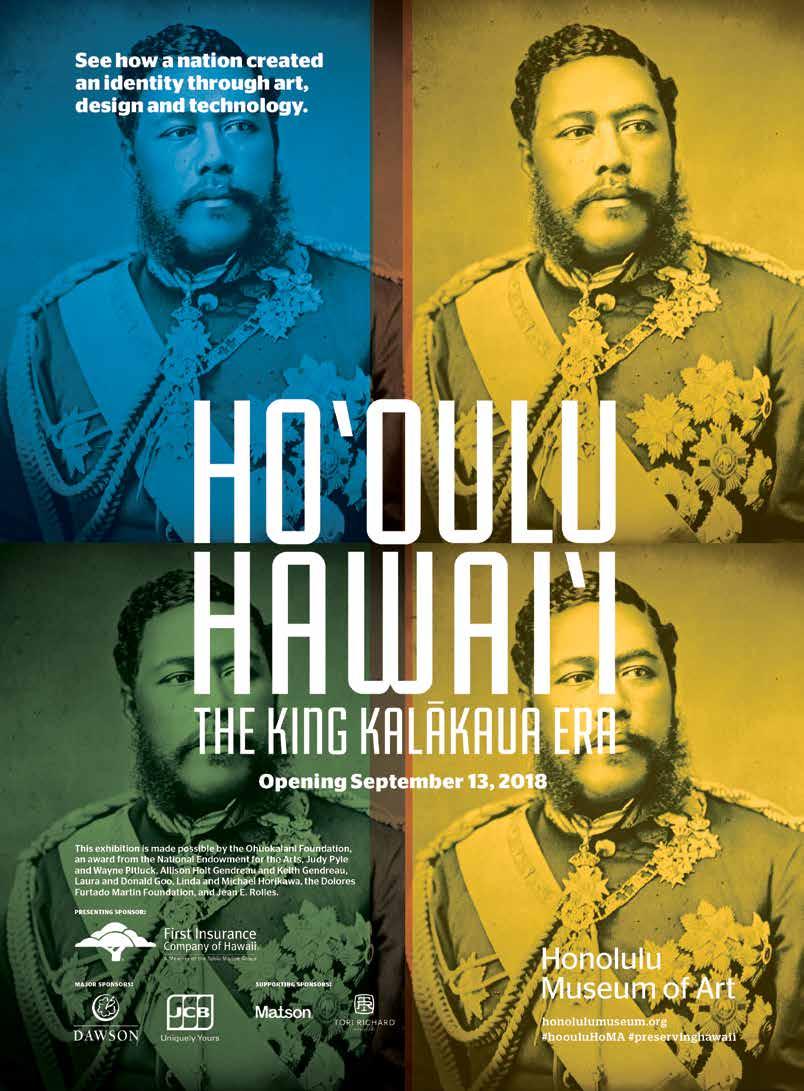
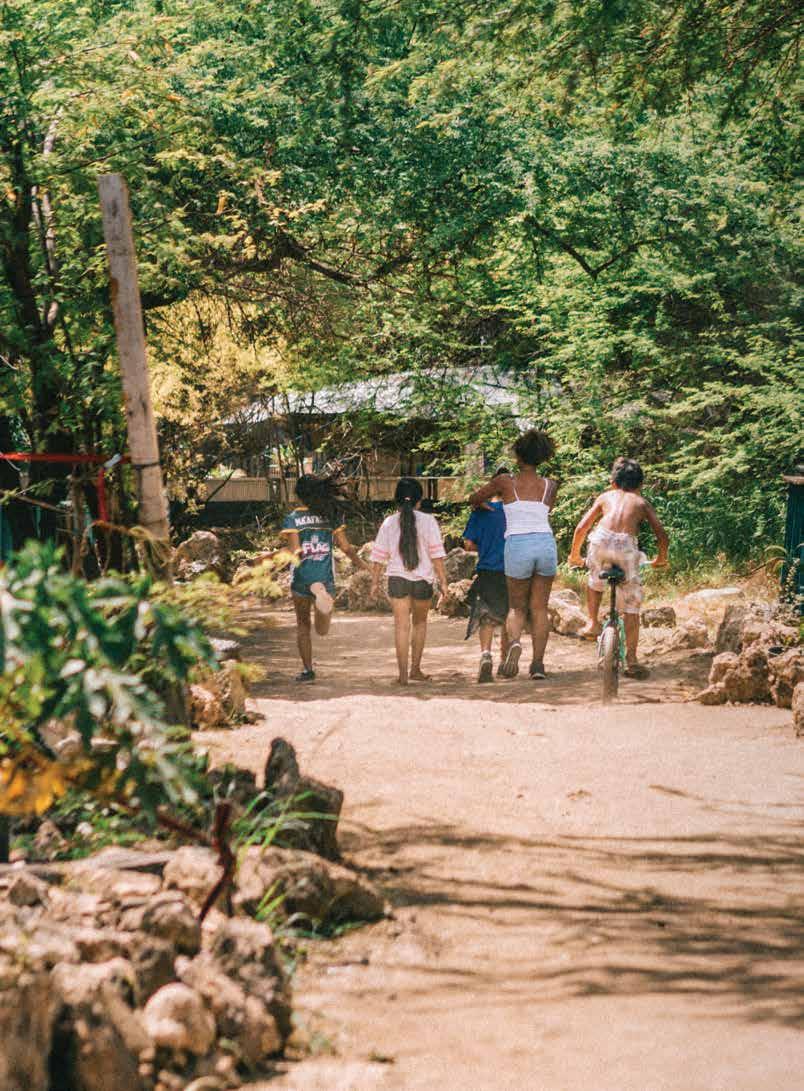

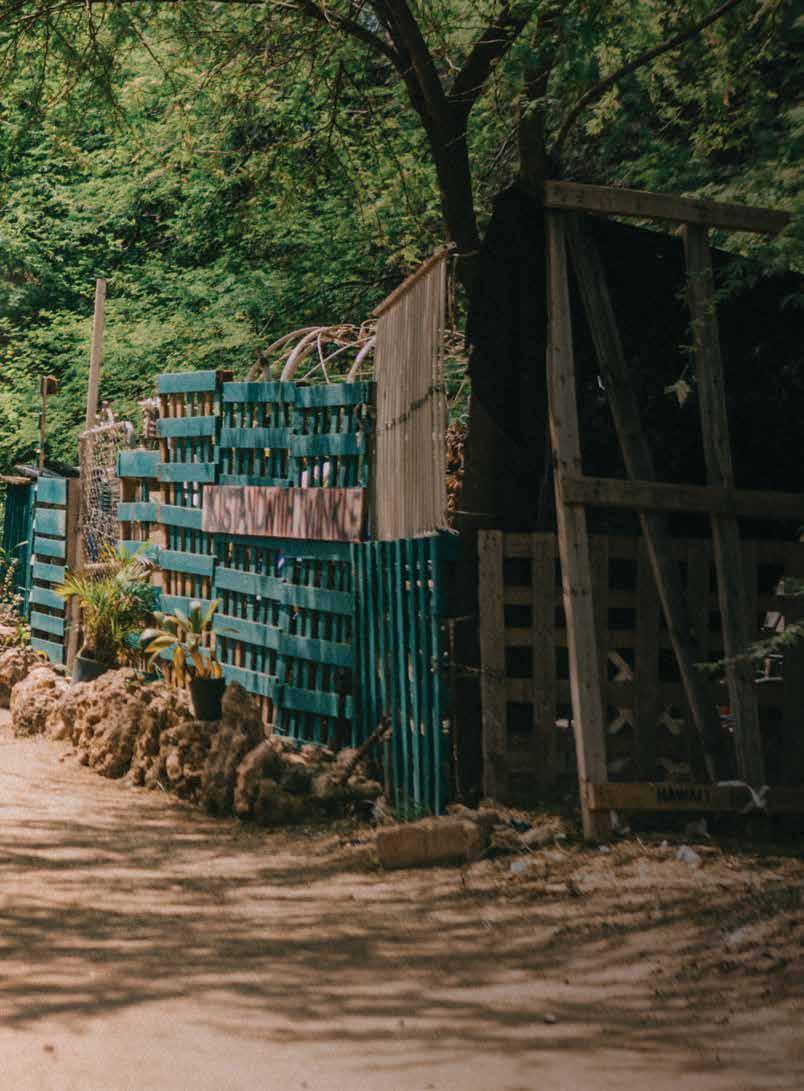 FLUX FEATURE
FLUX FEATURE
A Place of Ref uge
As the cost of living in Hawai‘i becomes an insurmountable hurdle for some, thousands are left to pick up the pieces and patch together a new normal. Welcome to another day at Hawai‘i’s largest homeless village.
TEXT BY RAE SOJOT
IMAGES BY MARIE ERIEL HOBRO, CIDNEY KELLY, AND LILA LEE OF WOLF & WOMAN
Sprawled across nearly 20 acres of dusty underbrush near Waiʻanae Boat Harbor, a patchwork of tents and shanties peeks out from groves of kiawe and haole koa. A battered couch sits at a main entrance, offering brief respite for those coming or going along the warren of well-trod dirt paths. A sun-weathered man hauling a precariously loaded dolly of food picked up from a Hawaiʻi Foodbank distribution site is greeted by a small pack of children. When he fishes out a tray of cupcakes for them, they shriek in delight. Their mothers cluck their tongues in good-natured exasperation. It’s nearly dinnertime, but they don’t protest. Such is the amicable spirit found at Puʻuhonua o Waiʻanae, Hawaiʻi’s largest homeless encampment. Here, the residents don’t see themselves as homeless, just house-less.
As Hawaiʻiʼs increasing cost of living continues to plague local families, island residents eke out livelihoods while facing expenses that are nearly two-thirds higher than the rest of the United States. According to a 2018 Out of Reach report from the National Low Income Housing Coalition, Hawai‘i has the highest cost of rent in the nation, and wage earners here need an hourly wage of $36.13—a far cry from Hawaiʻi’s minimum wage of $10.10—in order to afford the average two-bedroom rental. Not surprisingly, a recent survey found that nearly half of Hawaiʻi residents live paycheck to paycheck. For many, an unexpected job loss or medical expense could land them in the red, or in the worst case, out on the streets. For many, that worst case has already happened: For the last five years, Hawaiʻi has had the nation’s highest rate of homelessness per capita. Current estimates place the islands’ homeless population at more than 7,000.
Puʻuhonua o Waiʻanae, or the Refuge of Waiʻanae, has become a mecca for those who seek safe shelter. But the living conditions are far from ideal for the 170 people or so who live there. Residents confront a laundry list of challenges: constant exposure to the elements, no running water or electricity, rats and scorpions, too. “Survival of the fittest? No, survival of the smartest,” says a 64-year-old woman who goes by Auntie Joey. She has called Puʻuhonua o Waiʻanae home since 2011. “Living like this is gonna harden you,” she says. “You gotta develop a sense of strength.”
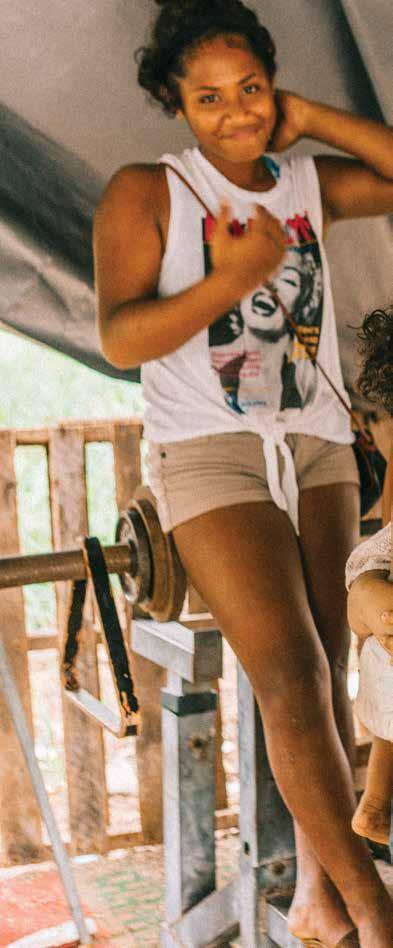
56 | FLUXHAWAII.COM

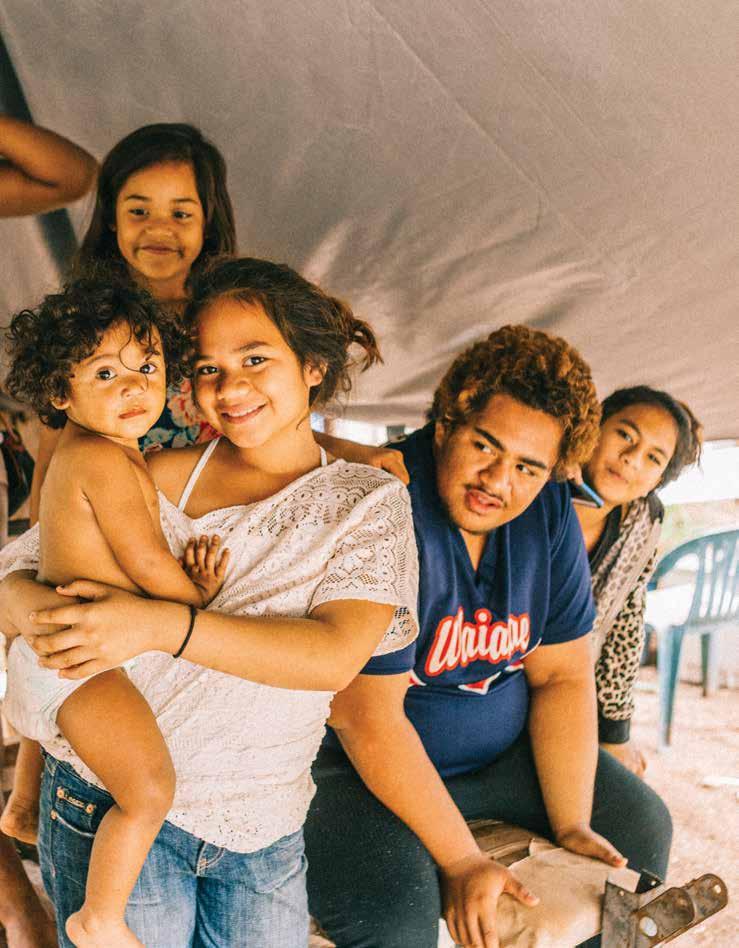
Though there are a dozen or so formally registered shelters and transitional homes in Waiʻanae, those who find themselves at Puʻuhonua o Wai‘anae are drawn to its community ethos. Managed by people who live there and not well-meaning outsiders, the village is absent of any patronizing charity. There, the focus is on compassion and connection, empathy over sympathy. “We have rules no different from a shelter,” says Twinkle Borge, who, for the last 10 years, has helmed Puʻuhonua o Waiʻanae. “But for me, you need to have and build relationships with the people. In our village, everyone knows everyone.”
Borge was grappling with the loss of her job as a trainer for Big Brothers Big Sisters delivery drivers, as well as a broken heart from a tumultuous relationship, when she headed west in 2005. “I was getting away from it all,” Borge says. “I just never went back.” Back then, the area inland of the harbor was reputed as a haven for derelicts, drug users, and outcasts, not those just simply down on their luck. But Borge, who grew up in Pālolo, brought her own bit of street cred: As a teenager, she had a flair for the illicit, running an all-girl gang that stole cars and broke into houses. As an adult, she was a recovering addict. “I needed to build bridges first with the community here,” Borges recalls. So she took initiative to connect. “I would watch people clean their areas and walk over and help.” Her forthright, pragmatic bearing, softened by a calm and compassionate demeanor, soon earned the trust of those around her. She emerged as the guiding voice and matriarchal fulcrum of the camp. People sought her for advice, help, or sometimes just a hug. However, as more families began arriving with young children in tow, Borge found herself thinking of the hānai son she had raised in his infancy. A safer space was needed, Borge decided. More order, too. “It’s not their fault why [the children] are here,” Borge says. “It’s my job to protect, educate, and love them.”
Galvanizing other likeminded residents, Borge implemented and enforced strict camp rules. No sex offenders. No drugs. No stealing. No loud noises after 8 p.m. For many, the benefits of being a part of the village were worth these restrictions. As Puʻuhonua o Waiʻanae’s population expanded, a hierarchy evolved, helping establish a chain of command to which residents could bring their concerns or requests for help. Any disagreements were mediated by either Borges or her “block captains,” a crew largely composed of women that she had tasked with managing the different sections of the village. Infractions resulted in warnings, first verbal, then written. Serious offenses, like repeated drug use or stealing from residents, nearby businesses, or Waiʻanae High School, which sits adjacent to the camp, led to the gravest punishment of all: eviction. “If you steal, you out,” Borge says. “We are trying to build relationships, not break them.” Asking a resident to break down their camp and leave is a task Borge never finds easy. “It hurts more so if they have kids,” she says. Often, Borge will offer to take in the children.
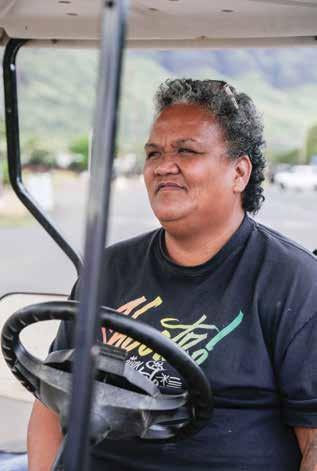
“You need to have and build relationships with the people. In our village, everyone knows everyone,” says Twinkle Borge, who has helmed Pu‘uhonua o Wai‘anae, Hawai‘i’s largest homeless encampment, for the past 10 years.
As undesirable behaviors were pushed to the outer fringes of the camp (Borge estimates drug use has declined from 90 percent to about 20 percent), a marvelous effect began to happen in its interior: What was initially a casual affiliation of camp dwellers was coalescing into a cohesive community. Residents, encouraged by the sense of structure and the feeling of being part of a larger collective, began transforming their plots into more permanent, elaborate homes, erecting low coral walls and fences, even planting gardens. People helped each other. The ablebodied assisted kūpuna in filling water jugs, and neighbors equipped with shovels, digging sticks, and rakes worked together to clear out a resident’s tent site that had burned down. New arrivals vetted by Borge and her captains were given a village walk-through and briefing before being assigned a site. If someone came empty-handed, essentials like bedding, a week’s-worth of food, perhaps even a tent—cobbled from the village’s donations or even the personal caches of residents—were provided. That tenor of generosity and inclusivity continues today at Puʻuohonua
58 | FLUXHAWAII.COM
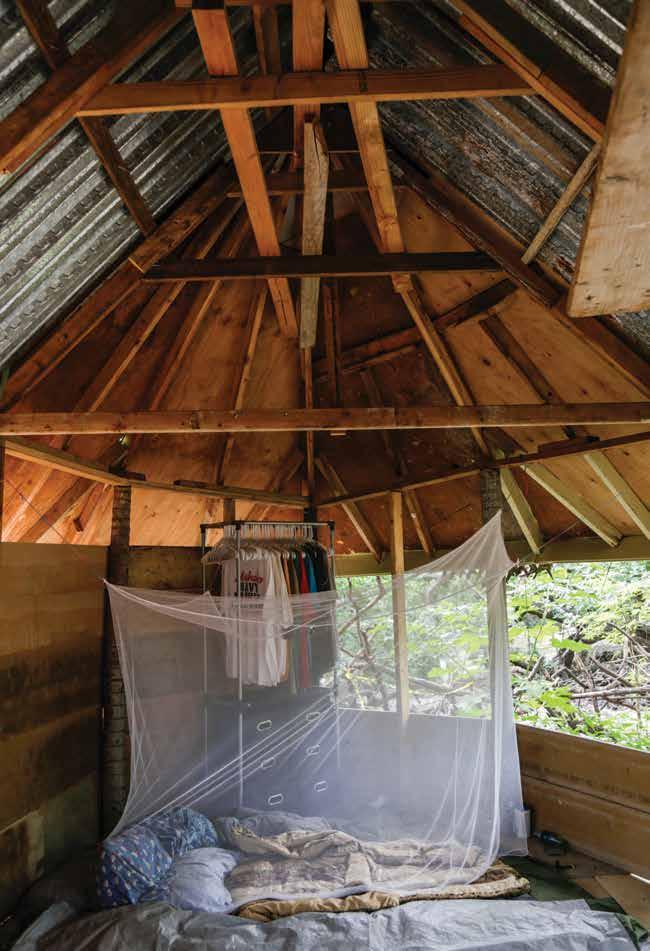
o Waiʻanae, which, despite its hardscrabble exterior, feels like a tight-knit neighborhood.
Aristotle’s concept of the whole being more than the sum of its parts is on vibrant display during dayto-day life at Puʻuhonua o Waiʻanae. The camp’s center operates like a town square of sorts where residents pull up metal folding chairs to talk story while children play tag and ride bikes along the dusty trails. Just like in any other neighborhood, the kids are reminded not to trample residents’ yards lest they be scolded by their occupants. Kids being kids, the warning is lost to the breeze.
Among the camp’s 16 children are Borge’s seven hānai sons and daughters, who range in age from 2 to 15 years old. They live in Borge’s sizable multitent structure off the camp’s main thoroughfare. The floor plan is cozy: an assortment of small, communal “rooms” partitioned by suspended sheets and tarps radiate outward from a makeshift kitchen. It’s a late spring afternoon when one of Borge’s adult hānai daughters, Queenie, who lives at the camp and helps take care of the children, surveys its current state of affairs, like a parent checking to see if a child’s room is clean. In the children’s sleeping quarters, she lets out an exasperated sigh as she picks her way through a carpeted area strewn with clothes, school
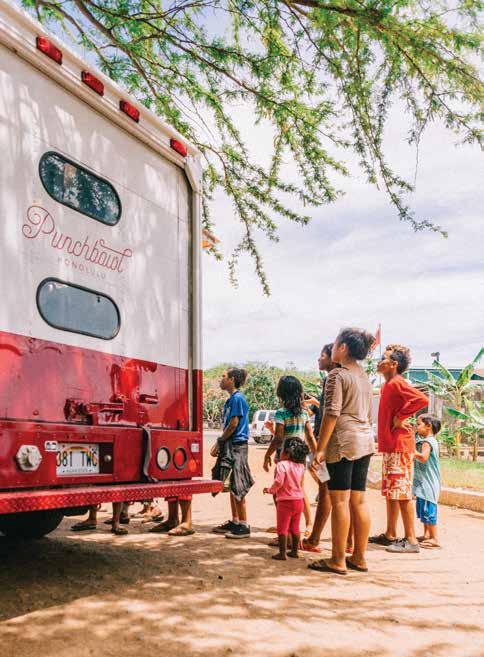
supplies, and toys. In stark contrast is another child’s space a few feet over, where a mattress is stacked with carefully folded bedding and a plastic storage bin that serves as a nightstand houses neatly arranged knickknacks. “Some people are messier than others,” Queenie says with a grin.
For Borge, the welfare of Puʻuhonua o Waiʻanae’s children is paramount. Their safety, health, and
happiness serve as a barometer of the village’s success. This emphasis was demonstrated six months ago, when a new family arrived to Pu‘uhonua with 8-year-old Kyhroe, who was deaf. Unfamiliar with his new surroundings and unable to communicate with anyone other than his family, Kyhroe’s assimilation was difficult. Feelings of helplessness would frequently boil
Sixteen children live in the camp—seven of which are Borge’s hānai sons and daughters—and the welfare of these kids is paramount, hence a set of strict rules enforced by Borge and a crew of “block captains” tasked with managing different sections of the village.
60 | FLUXHAWAII.COM

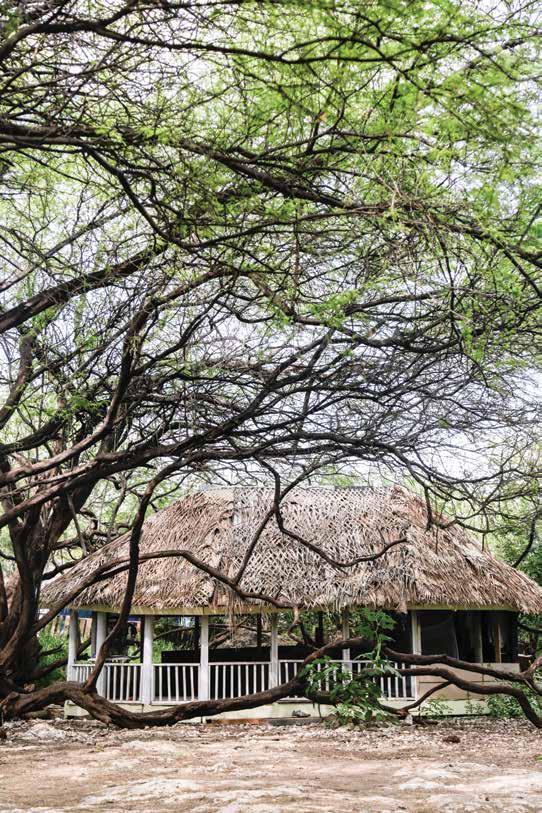
Once a casual affiliation of camp dwellers, Pu‘uhonua o Wai‘anae is coalescing into a cohesive community, with residents taking pride in their plots and building them into more established homes, even erecting low coral walls and fences and planting gardens. Shown here is resident Josiah Koria’s home at Pu‘uhonua o Wai‘anae.
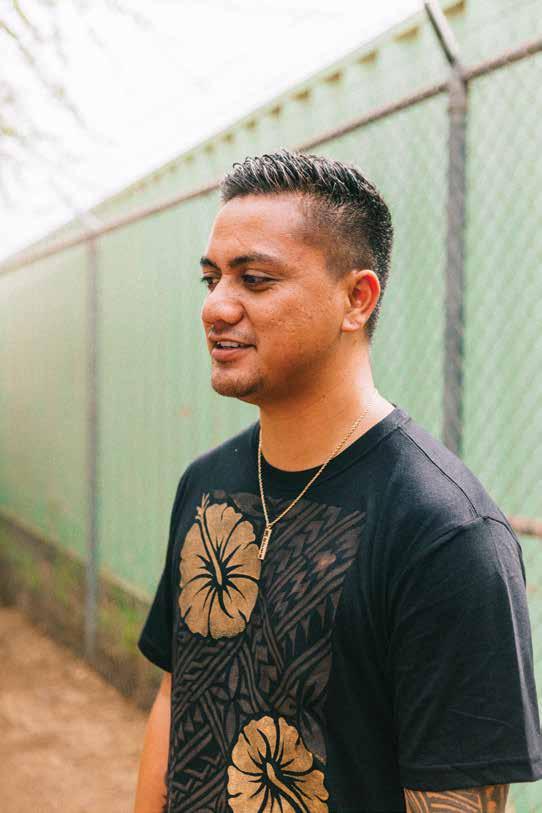
Josiah Koria, who is active duty in the U.S. Navy, moved to Pu‘uhonua o Wai‘anae after founding Tyrell’s Angels in memory of his 1-year-old nephew Tyrell Ioane Niko, who died after being struck by a reversing vehicle. Tyrell’s Angels helps homeless children and their families live healthy, independent lives.
over to frustration, then rage, causing him to lash out and scream at others. Rather than ostracize Khyroe, the village sought a solution: If the boy couldn’t speak to the village, then the village would learn to speak to the boy. Xeroxed copies of the American Sign Language alphabet soon appeared on community bulletin boards. Borge arranged for teachers from the Hawaiʻi School for the Deaf and Blind to come teach the residents how to sign. The children especially picked up the hand gestures eagerly. The village had built a bridge.
As the sun dips below the ocean’s horizon, young children in groups of twos and threes cheerily make their way to the Wai‘anae Small Boat Harbor parking lot. It’s time to bathe. A few teenagers trail after them, towels draped across their shoulders and plastic buckets under their arms. Queenie explains that on school nights, children are to be washed and fed by nightfall. The older ones are responsible for helping with the younger ones. (Borge, aware of complaints about Puʻuhonua o Waiʻanae’s contribution to the harbor’s exorbitant water bill, instructs residents to only shower and fill their water jugs after 4:30 p.m. She also says she has offered to work with state officials to pay for the water usage.) Two young fishermen from Honolulu who had spent the day plying the west side’s premier fishing ground are rinsing off their boat while knocking back some beers. They avert their eyes as the children expertly attach a rubber hose to one of the harbor’s four water taps. The kids initially balk at getting wet—the stream of water is ice cold. But moments later, they’re splashing each other and dumping buckets of soapy water on each other’s shoulders. From their boat, the fishermen watch the drama unfold, their faces a thinly veiled mixture of curiosity, embarrassment, and pity. Quietly, one wonders to his friend if the group’s toddlers had ever experienced a hot shower. “So sad,” the friend replies, shaking his head. If the teenagers overhear this, they are nonplussed. The younger ones, now shooting the hose at each other, are oblivious. Their jubilant laughter rises up to the sky.
Wanting to check on the children, Borge zips to the parking lot in a beat-up golf cart. This cart, much like Borges’ cellphone, is an indispensable tool for managing the daily operations of the village and connecting with its residents. When she is not using it to transport heavy supplies to campsites (or humoring the children with an occasional spin), Borge makes her rounds along the village’s myriad trails. She visits with residents to see if they might need anything, looks out for safety hazards like a precarious tree branch or a hole, and surveys areas that could be cleared for any new residents. There’s always something to do. She admits that she feels burned out sometimes, her anxiety levels reaching points where she can’t sleep or eat, especially when she wonders of the village’s future. Ultimately she pushes through these dark periods by finding strength and solace in the community she helped to create. “This is my home,” Borge says. Greeting Queenie in the lot, Borge smiles broadly at the children, who are now cocooned in towels. As mother and daughter catch up on camp news, Leilei, a precocious 2-year-old, climbs atop Borge’s lap for a quick snuggle. Queenie inquires about Borges’ plans for the evening—will she be joining for dinner? Borge says she needs to check on a complaint first. Apparently, a resident has been allowing her trash to pile up in front of her tent. Not only is it an eyesore, but it is also attracting rodents. Trash disposal is a chronic issue and headache for Borge, especially when Puʻuhonua o Waiʻanae critics cite sanitation issues as a clarion call to disband the village. For now, residents do what they can, regularly hauling their trash to the harbor’s dumpsters until a better system can be implemented. She needs to find out what’s going on with the resident. She turns the ignition, and the cart’s engine throttles gently. Placing Leilei back with the other children, she waves and heads off. Back in the village, all is quieting down. Generators hum against the susurrations of the evening’s light tradewinds. Sounds of dinner preparations drift from the tents. A lamp crafted from a large plastic jug and a solar panel pad hangs from a kiawe branch. It casts a soft light on Puʻuhonua o Waiʻanae’s main path, guiding the children home.
“If you steal, you out. We are trying to build relationships, not break them.”
Twinkle
Borge
Despite its hardscrabble exterior, Pu‘uhonua o Wai‘anae feels like a tightknit neighborhood.
64 | FLUXHAWAII.COM
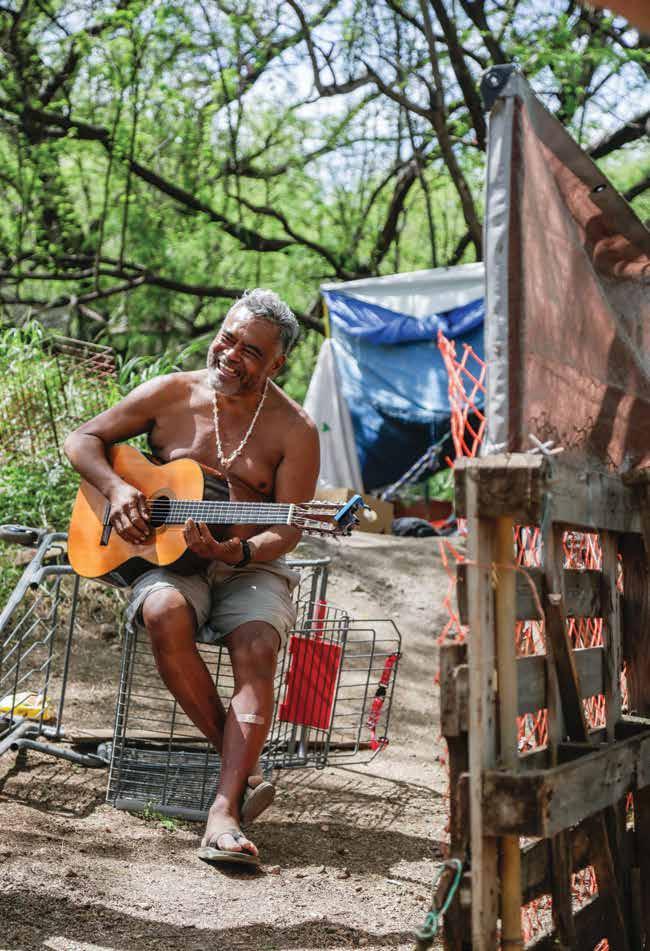
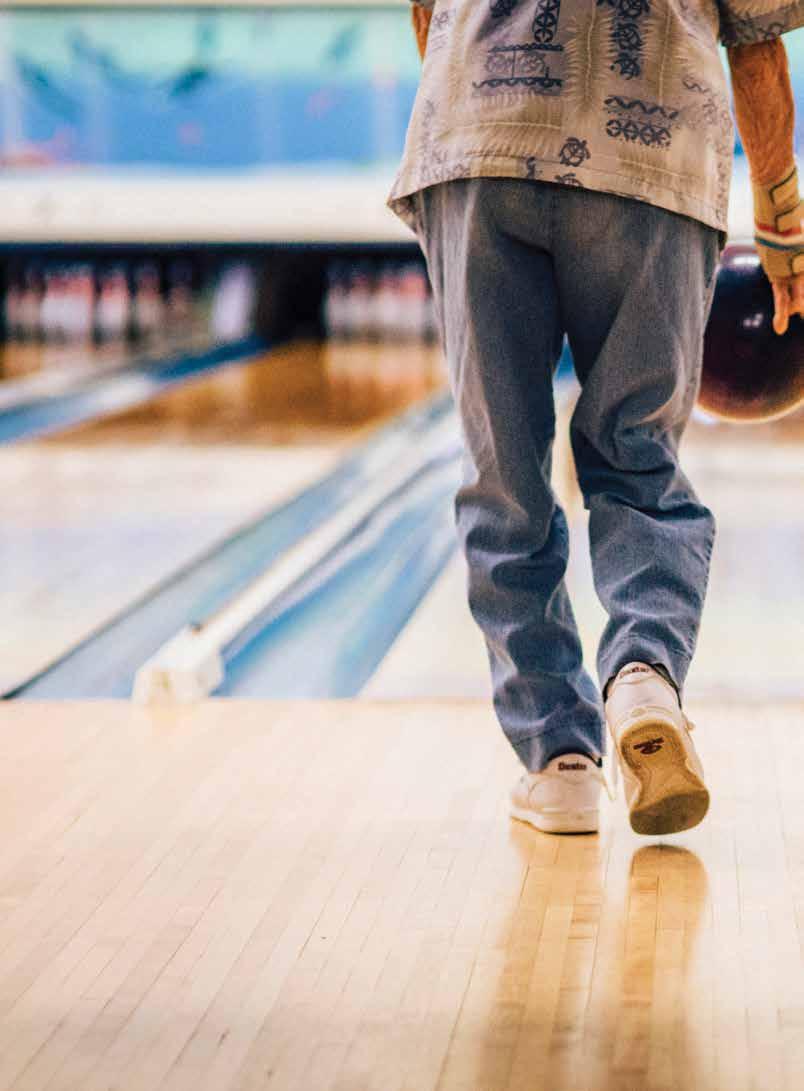
66 | FLUXHAWAII.COM

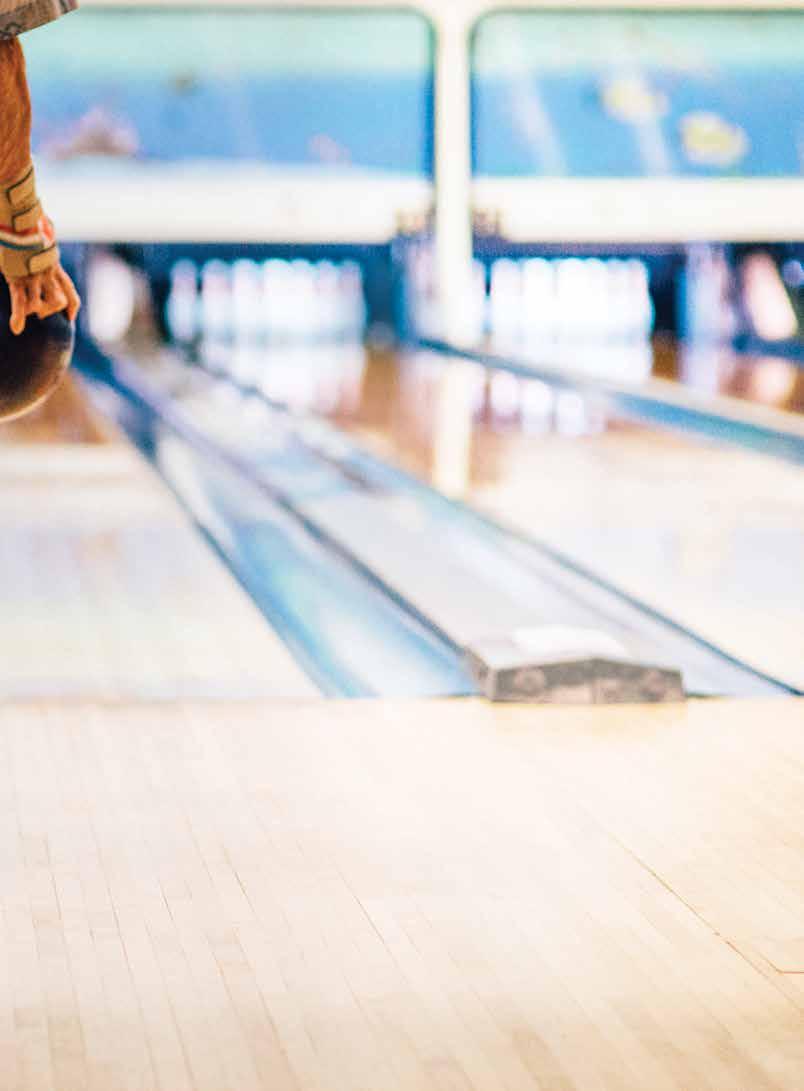
FLUX FEATURE
T he Senior s Str ike Back
It’s a game of old Kailua versus new Kailua, and the community’s kūpuna who bowl at Pali Lanes aren’t backing down without a fight.
TEXT BY MARTHA CHENG
IMAGES BY IJFKE RIDGLEY
It was never just about saving a bowling alley.
On a recent Monday night, Arthur Machado, Jr. stood in front of the Koolau Seniors bowling league before their weekly match at Pali Lanes. He spoke passionately about saving the Kailua bowling alley he owned. He vaguely mentioned lawsuits, he talked about fighting Alexander and Baldwin. More than 5,000 people had signed the Save Pali Lanes online petition. In late 2017, Alexander and Baldwin, which owns the land under the bowling alley (as well as 38 acres in downtown Kailua, which it had purchased from Kaneohe Ranch and the Harold K.L. Castle Foundation in 2013) had announced that when the lease for the bowling alley expired in January 2019, it would raze the building to create a new community space, possibly an open area where farmers markets or food trucks could gather. But Machado said it already was a gathering place, one for seniors on the Windward side of O‘ahu. It was an easy cause to get behind, and the Kailua community was inspired by the example set by the petition to save the monkeypod trees in Mānoa Marketplace,
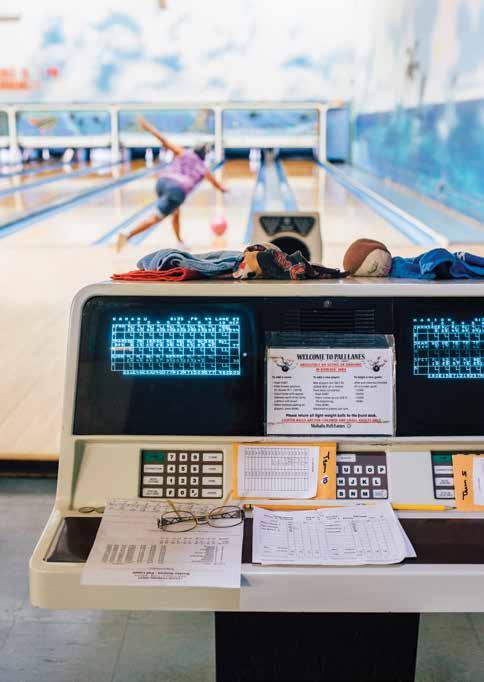
another property owned by Alexander and Baldwin. The developer had planned on removing the trees, but when it was presented with 20,000 signatures and a proposal for how to manage the trees’ roots, which were cracking the pavement, it decided against cutting them down.
By the time Machado spoke to the seniors that night, Alexander and Baldwin had already announced that it was putting its plans for Pali Lanes on hold. But people are still fired up. The bowling alley has come to represent something more than 24 lanes and a bunch
“My doctor says don’t walk the sidewalks, because they’re all uneven, you’ll break your neck. Just keep rolling that ball,” says 97-year-old Mary Sabate, at left, who still bowls with a 10-pound ball. She carpools with her friend, Marion Teixeira, to Pali Lanes every week.
68 | FLUXHAWAII.COM
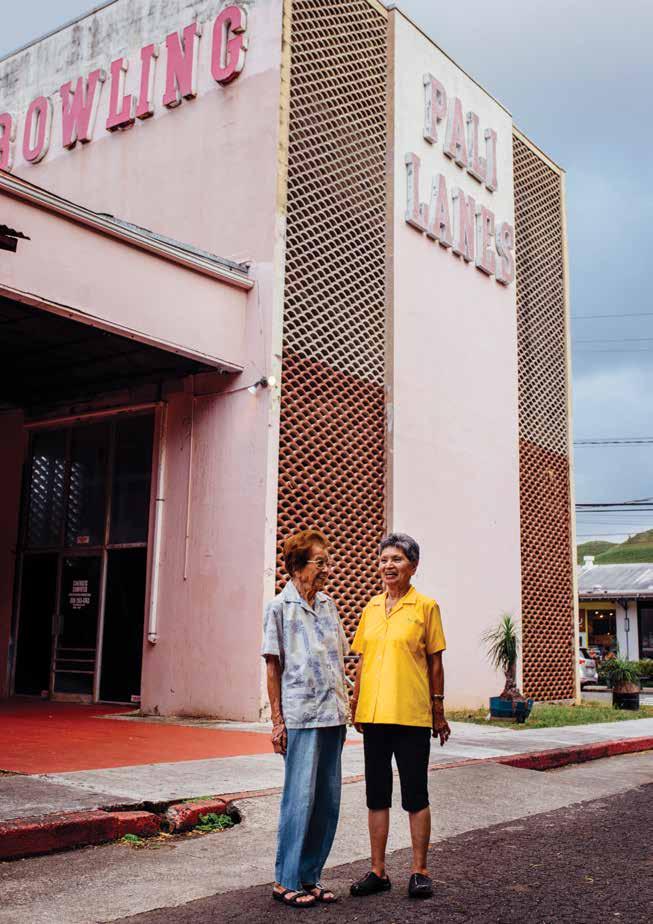
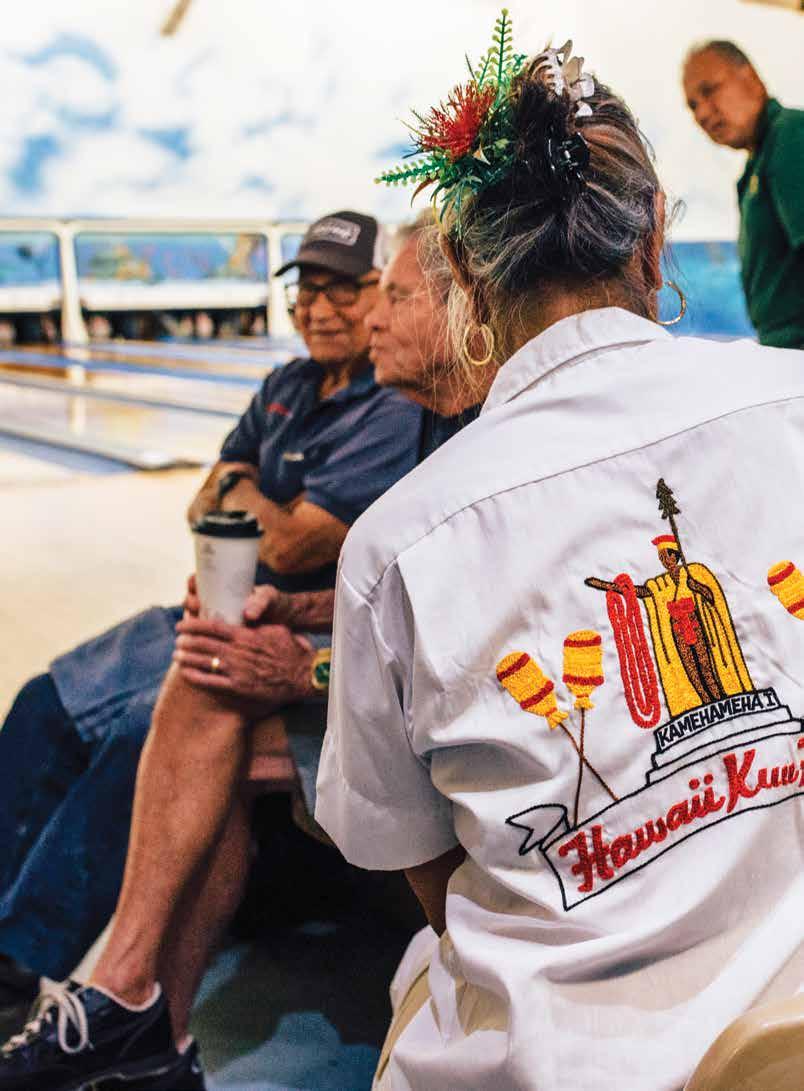

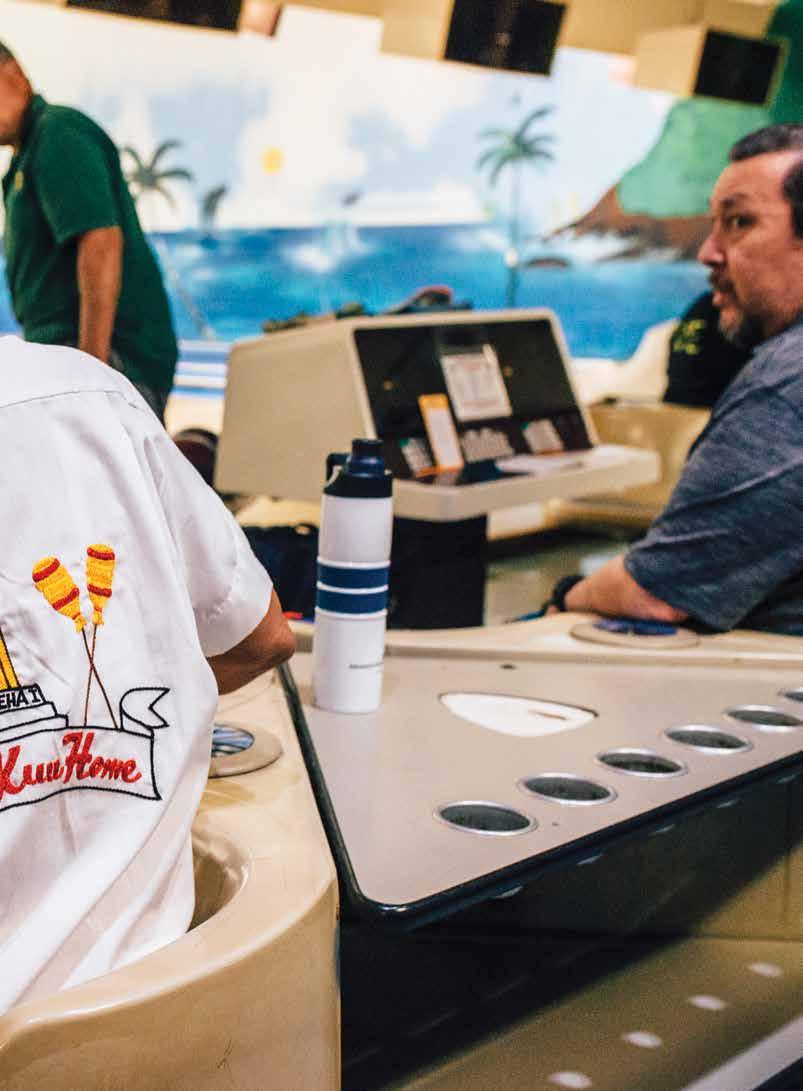
of pins. It is a symbol of old Kailua, and it is something very tangible for the older residents of the community.
The senior bowlers who frequent Pali Lanes include Mary Sabate, who is 97 years old and still bowling with a 10-pound ball. When people tell her, “You too old for that,” she retorts, “What are you guys doing? Getting fat.”
Says Sabate, “My doctor says don’t walk the sidewalks, because they’re all uneven, you’ll break your neck or fracture your knee. Just keep rolling that ball. When the ladies want to quit, I say, no it’s your physical therapy, you need the exercise.”
She had just returned from Reno, Nevada, where she competed in a women’s national bowling championship. It’s her 37th year participating in it. Asked how her team did, she says, “Well, you don’t expect the oldies to win [against] the younger ones.”
Sabate has lived in Kailua for 62 years, and started bowling before Pali Lanes was even built in 1961. Where there are now condominiums, she remembers a dairy farm and Kailua’s first bowling alley, which opened in 1947, around the same time as a telephone company branch office and Hawaiʻi’s very first supermarket.
If Pali Lanes closes, Sabate thinks she will retire from bowling. At a recent Kailua neighborhood board meeting, she said, “My biggest question for the people who want to tear it down: Do you folks have a plan for the seniors?”
But the solutions for the seniors are not as straightforward as managing the roots of the Mānoa Marketplace trees. “Bowling is a dying sport,” says Ruth Chatterton, secretary for the Koolau Seniors. At the Monday night bowl, the league, in which members compete against each other in teams of three, is two members short. One person had to drop out for medical reasons,
another had passed away. She remembers when there were 36 bowling alleys on Oʻahu, including one that was literally underground, below Fort Street Mall in downtown Honolulu. Now there are only four: Aiea Bowl, Leeward Bowl, Barbers Point Bowling, and Pali Lanes. “The waitlist used to be so long for lanes, now I’m begging [people to join],” she says. After Machado’s speech, he returns to his office, tucked in the back corner of the alley, past the concession stand. Here, Machado is quieter, more contemplative. There’s no mention of taking anyone to court, just a float for the Kailua 4th of July parade. He tenderly recounts his relationship with the sport. “Bowling has always been my love,” he says. Machado has been bowling for 54 years. He ran K-Bay Lanes on the Marine Corps Base Hawaii in Kāne‘ohe for a quarter of a century, from the day it opened in 1976. In 2010, he and two partners reopened Pali Lanes, which had closed at the end of 2009. But it has never made much money. Machado says it costs him $18,000 a month to run Pali Lanes, and he has been lucky if he gets one or two bowling party reservations a month. So when Alexander and Baldwin announced they would end his lease, Machado considered letting the bowling alley go. But then a group of 20-somethings who grew up in Kailua told him to fight for it, and they created the Save Pali Lanes petition. Reservations for the bowling alley flooded in, and it was booked every weekend from 10 a.m. to 9 p.m. for the summer. The public outcry over the demise of Pali Lanes has been enough for Alexander and Baldwin to pause its plans and reconsider.
The reaction might have surprised the developer, which probably saw an aging bowling alley frequented by a dwindling
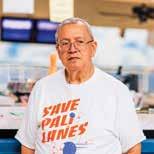
“The lanes have always been a special place for families and communities to gather, and we’re not going to let them be sold out just to turn Kailua into a moneymaking tourist attraction.”
—From the Save Pali Lanes petition
When Alexander and Baldwin announced plans in 2017 to raze Pali Lanes, owner Arthur Machado, Jr., above, began working with Evan Weber to create the Save Pali Lanes petition.
72 | FLUXHAWAII.COM
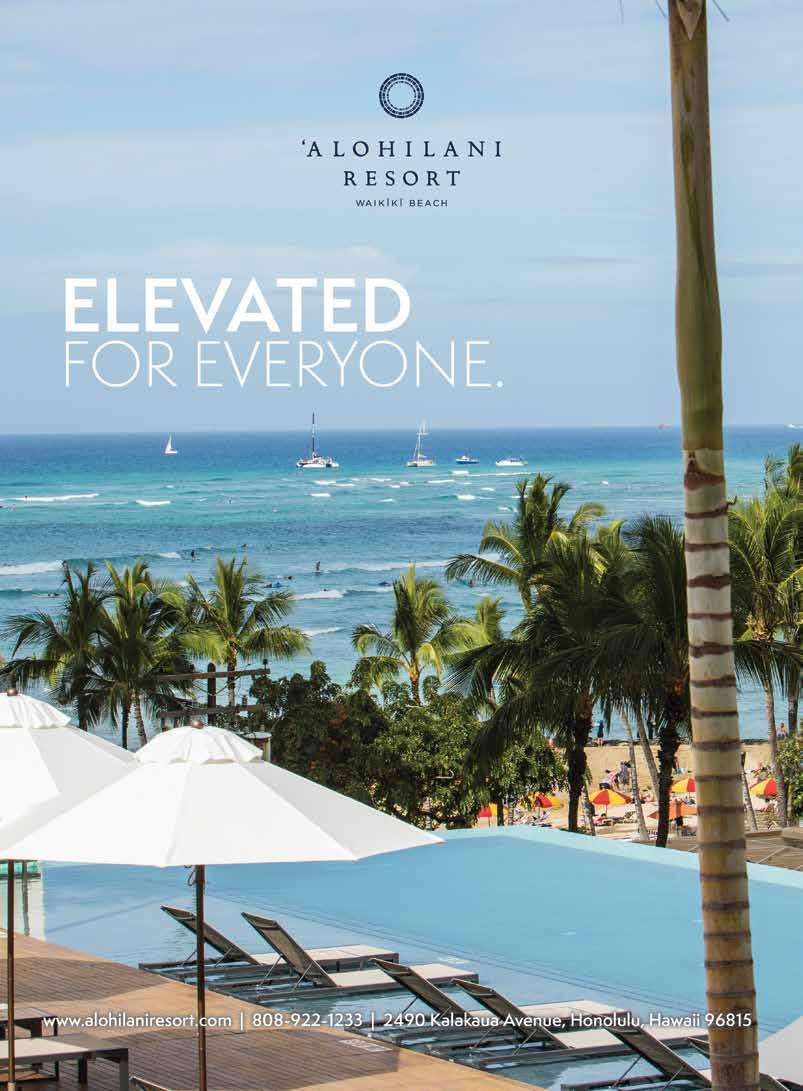
number of seniors, a few bowling leagues, and the occasional bored teen on a weekend night. But one’s crumbling eyesore is another’s symbol of nostalgia. Pali Lanes is one of the last vestiges of a Kailua that generations frequented and loved, before the tourists came in such droves that there are now laws to reign in commercial beach activity and street parking, before the low-slung, post-war era buildings that once characterized Kailua were demolished for commercial centers anchored by Target and Whole Foods. Nevermind that many of us didn’t go bowl, that many of us just saw Pali Lanes on our way to Target. Nevermind that we had forgotten about Pali Lanes until we heard it was closing.
Right now, Alexander and Baldwin isn’t making any promises about the fate of the bowling alley. It is conducting a round of surveys to “understand what the community’s interest and concerns are,” says its spokesman Darren Pai. “We don’t want to draw any conclusions at this point. We’ve really heard a whole range of opinions. Not just about this particular situation, but about Kailua.”
This is what the Save Pali Lanes petition was truly about all along. Evan Weber, who is from Kailua and created the petition, says, “Over the past couple of decades, there’s been a steady change in our town, loss of businesses for more places that serve the interests of developers by catering primarily to tourists and people who have not lived in Kailua their entire lives.” For the youth, who have a future longer than the past, there is more at stake. “Pali Lanes is a special place for families and community,” the 26-year-old adds, “and to me, this is the last straw over what ’s been happening here.”
In contrast, Chatterton is resigned. “Guess we gotta go with progress,” she says. The Kailua she lived in when she was young is already long gone. She left Kapahulu for Kailua, left the city for the country, and stayed long enough for the city to catch up with her, to see the horse racetrack give way to Aikahi Shopping Center. She prefers the old Kailua, but admits to liking Target. And she knows interest in bowling is already waning. There’s talk of relocating the leagues to K-Bay Lanes if Kailua loses Pali Lanes. But even if that happens, Chatterton might retire anyway.
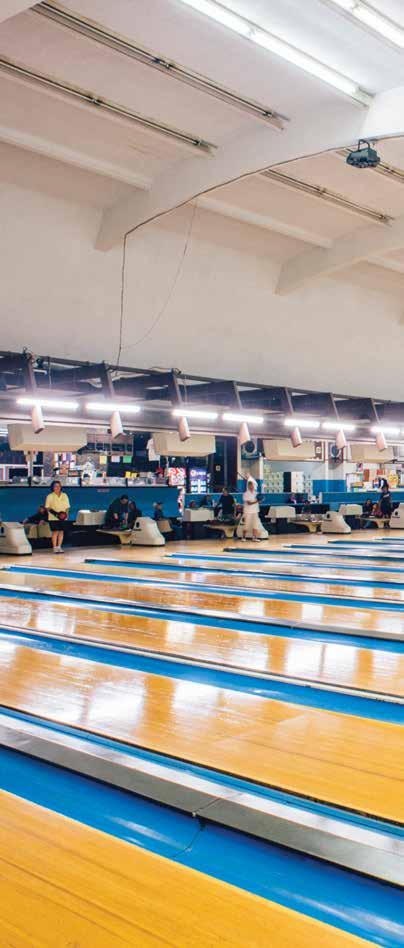
74 | FLUXHAWAII.COM

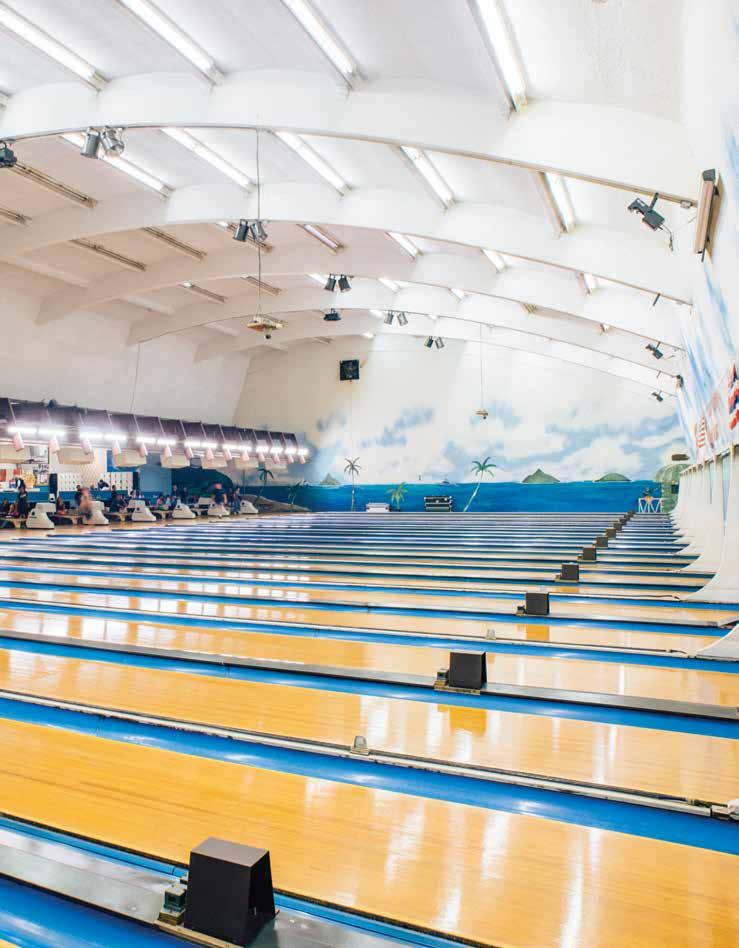
FLUXHAWAII.COM | 75
Patriots Adrift
For decades, Micronesians have risked and even sacrificed their lives fighting for the United States, despite not being U.S. citizens. As they begin to retire, these islanders are finding that their unique immigration status leaves them in limbo.
TEXT BY TIMOTHY A. SCHULER
IMAGES BY JOHN HOOK, KYLE KOSAKI, AND COURTESY OF TOM RAFFIPIY
Tom Raffipiy looked out the window of the plane, nervous. He was 30,000 feet in the air, flying over the rugged, desolate landscape of the Western United States. The Satawal native had never seen a landmass so large, and it was unsettling to him the way the ground stretched to the horizon in every direction. “I’d always traveled across ocean,” says Raffipiy, who was 20 years old at the time. “I was nervous because I know that if we fall down, I don’t have a chance. If we fall down in the ocean, it can take the impact.” Every so often, he would check the view. Still no water. The continent seemed endless.
Raffipiy, now 52, was a newly enlisted soldier in the U.S. Army on his way to Fort
Leonard Wood in rural Missouri. Up to that point, Raffipiy had spent most of his life on a tiny, boomerang-shaped island called Satawal that is part of the Federated States of Micronesia, or FSM. Like many Pacific Islanders, Raffipiy grew up close to the land and closer to the water, fishing and sailing traditional outrigger canoes, which by age 9, he also knew how to build. As a boy, he spent portions of nearly every day with Mau Piailug, the famed navigator who is credited with helping revive Polynesian voyaging worldwide.
In 1985, Raffipiy left Satawal to attend the University of Hawai‘i at Hilo. Flying into Honolulu at night, Raffipiy wondered if he had made the right choice. The city was enormous, glowing like a million
FLUX FEATURE 76 | FLUXHAWAII.COM
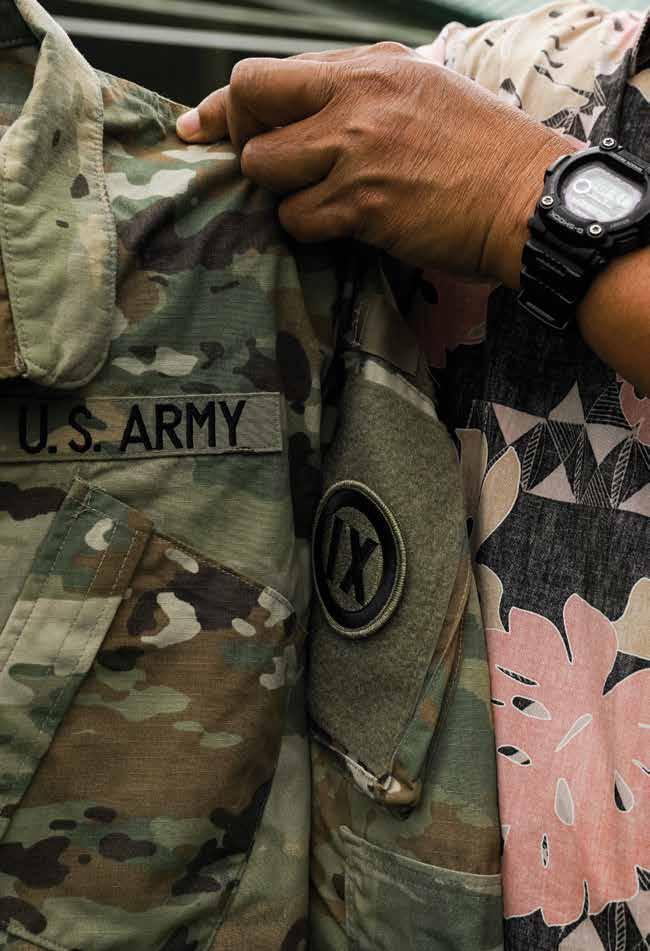
embers. When he arrived in Hilo, however, he found the pace of life familiar. What he was unprepared for was how expensive things were. Even with financial aid and a parttime job, Raffipiy couldn’t afford tuition, rent, and groceries. After one semester, Raffipiy realized he needed to change course. Although Raffipiy wasn’t a U.S. citizen, because of an agreement called the Compact of Free Association, or COFA, he was allowed to serve in the U.S. Armed Forces. He called the local recruiting office.
Today, the geographic area of Oceania in the Pacific is broken up into four major regions: Polynesia (which includes Hawai‘i), Australasia, Melanesia, and Micronesia. Micronesia stretches from Kiribati, 1,840 miles south of Hawai‘i, all the way to west Palau, just a few hundred miles from the Philippines, and includes the FSM as well as the Marshall Islands, Nauru and the U.S. territories of Guam, and the Northern Mariana Islands. Altogether, Micronesia covers an area roughly the size of Australia. Although the world has chosen to group them, not all islanders from Micronesia consider themselves “Micronesian.” Many of the islands are culturally distinct, with their own languages and customs. However, citizens of the FSM, Palau, and the Marshall Islands are linked in one important way: COFA.
To understand the far-reaching effects that COFA continues to have, you have to first understand the history of Micronesia. Because of their location, the Micronesian islands have been places of strategic interest for foreign powers over the decades, including the United States, which oversaw much of the region as a United Nations Trust Territory from 1945 through the mid-1980s, when the FSM and the Marshall Islands voted to become sovereign nations. (Palau became independent shortly thereafter.) Treaties were negotiated with each of the fledgling republics, and in return for permission to
maintain military operations there, the United States promised economic assistance and free entry into the country. With the signing of the compacts, COFA citizens were permitted to live and work in the United States without a visa.
Today, nearly 50,000 people from the FSM alone have emigrated to the United States, representing a third of the Micronesian country’s total population. Hawai‘i in particular has become a landing pad for COFA migrants, due to its proximity and cultural similarities to Micronesia. According to Census data, between 20,000 and 30,000 Micronesians live in Hawai‘i.
There is one other area of American society in which islanders from Micronesia are highly visible: the U.S. military. According to the U.S. State Department, citizens of the FSM enlist at double the per capita rate of U.S. citizens, and the figure is likely similar for citizens of Palau and the Marshall Islands. A 2005 article published in USA Today described the Micronesian islands as a “recruiter’s paradise.” One recruiter glibly told The New York Times, “You can’t beat recruiting here in the Marianas, in Micronesia. In the States, they are really hurting. But over here, I can afford go play golf every other day.”
Some islanders believe the region is being unfairly preyed upon and have urged their community’s young people to consider alternatives to military service, even organizing “anti-recruiting” sessions at local high schools. Political and religious leaders have weighed in over the years, arguing that as independent nations they shouldn’t be fighting America’s wars. Others have said war itself goes against Micronesian values.
Such sentiments haven’t stopped individuals like Raffipiy from enlisting. Shortly after he called the recruiting office in Hilo, Raffipiy found himself in Missouri, 8,000 miles from home, adjusting to his first Midwestern winter. At Fort Leonard
Wood, Raffipiy began basic training. To his surprise, it was relatively easy. The push-ups, the sit-ups, the early morning runs—none of it was more demanding than life back on Satawal. “A lot of mainland kids were crying, but for me, I’d already lived through that. Running was something we always did on the beach. It’s a lot harder to run in the sand than on the road,” he says. When training exercises required that soldiers stay up nearly all night, Raffipiy was used to that too, having done so while voyaging to other islands. He discovered that despite having grown up on an island less than one-tenth the size of the base, he knew a lot about the world. Eventually, he began to think of basic training as a game—a game at which he realized he could excel.
A lot of people assume that islanders like Raffipiy enlist in the military purely for financial reasons. It certainly is a factor. For Raffipiy, Hawai‘i was prohibitively expensive. But things were even more bleak back home. Places like the FSM have found themselves navigating the tenuous transition from subsistence fishing and small-scale farming to a more Westernized way of life. Jobs are scarce. Those that do exist don’t pay well. A teacher on Kosrae, for instance, might make as little as $7,000 per year. By comparison, the Army offers a starting salary of nearly $20,000 plus allowances for cost of living, signing bonuses, and benefits.
But Raffipiy also exhibits a palpable sense of patriotism when he speaks. It is clear that he believes in values
Like many migrants from the Federated States of Micronesia, Tom Raffipiy enlisted in the military under the Compact of Free Association. Because of their unique immigration status, many Micronesian soldiers are left in limbo once their service ends, unable to access the same benefits as U.S. citizens.
78 | FLUXHAWAII.COM

like democracy and freedom, and that he is willing to risk his life for them. He is not alone. Owen Milne grew up on Kwajalein in the Marshall Islands. He joined the Army after quitting several entry-level jobs in Tampa, Florida, where he was living with his sister. For Milne, the Army represented a path to financial independence, but also, he hoped, a job more exciting than bagging groceries. After basic training, Milne was assigned to the 173rd Airborne Brigade, learned how to jump out of helicopters, and got a job in logistics, ensuring that his unit’s supplies made it to the right place at the right time. He did two tours in Iraq and one in Afghanistan, and is now stationed in Hawai‘i. Along the way, he met his wife, Regina, who is also Marshallese and spent six years working in Army intelligence.
Milne says he doesn’t feel any sort of cognitive dissonance fighting for the United States even though he is not an American citizen. “We’re not fighting just for the United States,” he says. “The Marshall Islands don’t have an army. We’re the army. So I don’t care what anybody says, we’re fighting for the Marshall Islands, we’re fighting for the United States, and we’re fighting for every ally of the United States.”
In one sense, the patriotism is befuddling since for years the Marshall Islands served as America’s nuclear testing ground. From 1946 to 1958, the United States detonated more than 60 atomic bombs off Bikini Atoll, destroying the island’s ecosystems and exposing thousands of islanders to radioactive fallout, a horrifying event that resulted in the deaths of some islanders, a plague of stillborn babies, and adverse health effects that continue today. In another sense, however, military service is simpatico with Micronesian culture, says Josie Howard, director of the Hawai‘i-based nonprofit organization We Are Oceania and a native of Onoun in Chuuk, part of the FSM. Many islanders volunteer “because it’s a service to humanity,” she says.
And yet Micronesians who serve are hamstrung in an important way: Because they are not U.S. citizens, they cannot become commissioned officers, which limits what they can make in terms of salary and
the level of recognition they can receive. In the Army, the highest rank an enlisted soldier can achieve is sergeant major, or E-9. If they have served for more than 20 years, they can expect a salary of a little more than $70,000 a year. A commissioned officer such as a colonel, however, can easily make six figures. No matter how hard they work, Micronesians in uniform will forever be excluded from the more prestigious rungs of the military ladder.
In March 2004, Raffipiy got on a plane bound for Baghdad. The United States had invaded Iraq one year before, and Raffipiy’s unit was there to help rebuild cities that had been torn apart in the conflict. Raffipiy was in charge. He’d made first sergeant, E-8, the second-highest rank an enlisted soldier can attain, and had command over an engineering unit of about 40 soldiers. They were stationed in Tahrir, near the epicenter of the Iraqi insurgency.
Raffipiy spent 18 months in Baghdad. If Missouri had felt like a foreign country, Iraq was another planet. The temperature reached 120 degrees Fahrenheit, and the wind only made it seem hotter. Then there was the war. A combat zone can be a terrifying and traumatic place for any soldier, but for Micronesians in the military, deployment can be especially isolating. They find themselves far outnumbered by Americans from places like Mississippi and Ohio, creating an environment in which the islanders can feel culturally adrift—islands themselves in a sea of people who look, talk, and think differently than they do.
It’s not surprising then that some soldiers make efforts to remind themselves what life is like on the islands, to make places like Iraq and Afghanistan feel a tiny bit like home. Among the belongings Raffipiy carried with him to Iraq was his tiu , a traditional garment similar to the Hawaiian malo. Occasionally, when he wasn’t on duty, Raffipiy would walk around base wearing nothing more than his tiu and slippers. “I never attempted to minimize my culture,” Raffipiy says. “I always tried to share my culture with other people.”
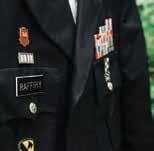
Due to its proximity and cultural similarities to Micronesia, Hawai‘i has become a landing pad for migrants from the Federated States of Micronesia. According to the U.S. State Department, citizens of the FSM enlist at double the per capita rate of U.S. citizens.
80 | FLUXHAWAII.COM
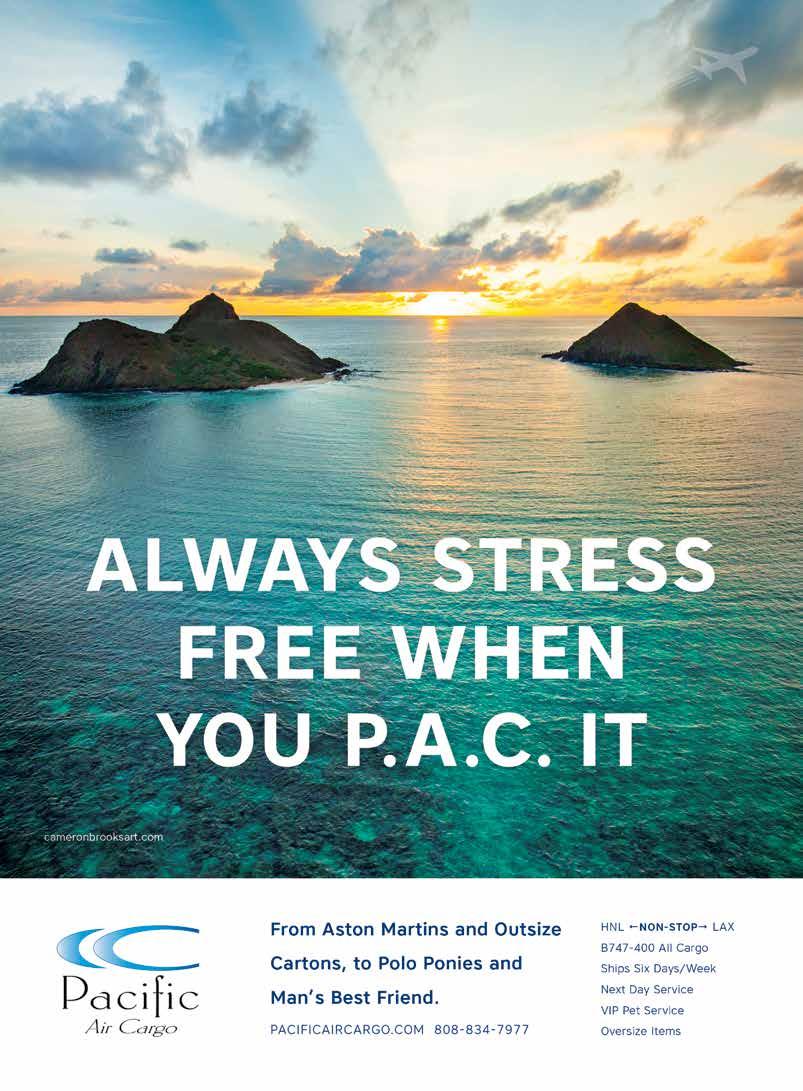
Singing traditional songs and dancing traditional dances served as reminders of home as well as beacons for other islanders. Pius Taiwerpiy, a native of Kosrae, was one of four Micronesians in Raffipiy’s unit. One day in Kuwait, while en route to Iraq, Taiwerpiy was in a meal line talking with some of his fellow islanders in his native language (a dialect similar to Woleaian, he says) when a friend from back home appeared out of nowhere. They greeted each other enthusiastically. The friend says he’d heard them from the back of the line. “‘I was wondering who was talking in our language out here in the desert,’” he told Taiwerpiy.
This scene occurs with some frequency. Soldiers describe running into friends, cousins, uncles, or neighbors that they hadn’t seen in years. They also speak of a larger family. The islands of the Pacific Ocean are rife with age-old rivalries, such as between the Marshallese and the Chamorro people of Guam, or between Samoans and Micronesians. But in the military, these feuds dissolved. “Being in an environment like that, you’re away from family. The closest family you got is other islanders,” Milne says.
As one might expect, this multicultural tribe often forms over food, at potlucks overflowing with traditional island dishes. During the two years he was stationed in Italy, Milne spent his free time with a panPacific group that included Hawaiians, Samoans, Chuukese, and Chamorros. They would work out at the gym together or organize volleyball games. Barbecues were a regular occurrence. “We tried to make it as close to home as possible,” Milne says.
In Iraq and Afghanistan, however, a lot of Micronesian foods were unavailable. Occasionally, when Raffipiy would send soldiers back to Hawai‘i for rest and recuperation, his wife would give them poi to ferry back
to the battlefield, but for the most part, soldiers were limited to what was being served in the mess hall. The islanders craved fresh fish, rice, taro. For some, this only deepened their sense of isolation.
One day, Raffipiy discovered that the family of one of his soldiers had been sending her rice in the mail, postmarking 20-pound bags from Hilo to Iraq. “It cost 98 dollars for postage,” Raffipiy says. “And she wasn’t the only one. Five out of 40 soldiers were asking for rice. And families were actually spending a hundred bucks to send rice to Iraq. I thought that was criminal.”
Raffipiy went to the commander in charge of the post exchange, a store on base that carried everything from food to clothes to cologne. Raffipiy told the commander he needed rice in bulk, as well as mackerel, Spam, corned beef, and sardines. “He said, ‘OK, just give me the list.’ I wrote everything down, and he said, ‘I don’t know where I can get all this from, but I’ll send it to headquarters.’”
Two weeks went by. Then Raffipiy got a call from the exchange. “First Sergeant, you need to come down here,” the commander said. When Raffipiy arrived, he found a mountain of food, everything he had asked for, including two pallets of Calrose rice, each weighing nearly a ton. Raffipiy and several others loaded the food onto trucks, and drove it up to where Raffipiy’s unit was stationed. He got on the radio and said if anyone wanted rice or fish, he had them right in front. The cost of a 20-pound bag of rice was 97 cents. Word spread to other units, but by the time those soldiers arrived, the food was gone. Raffipiy went back to the exchange and asked for the order to be doubled.
In war-torn Tahrir, these foods were a lifeline, each bite resurrecting memories of family and friends and the islands the soldiers had left behind. “It’s a big thing,” Raffipiy says of such reminders. “The least
I could do is bring a sense of home to Iraq, some normality.” In 2005, Raffipiy got the order to return to Hilo. Relieving his unit was a National Guard unit from Hawai‘i. When the unit arrived in Iraq, Raffipiy introduced the commanding officer to the commander of the post exchange. He said, “You guys want rice, Spam, all that? This is the guy.”
As it does for many women and men, Raffipiy’s time in Iraq has followed him home. A knee injury in Iraq prevents him from running and doing certain physical activities; he was also diagnosed with post-traumatic stress disorder. And yet, as limiting as the physical and mental trauma has been, Raffipiy feels most constrained by something else: U.S. military policy. Raffipiy, today a sergeant major, hopes to retire within the year. When he does, he would like to return to Satawal. But as other Micronesian veterans have discovered, doing so can be complicated, even impossible.
Because the U.S. Department of Veterans Affairs doesn’t have any facilities in Micronesia, veterans are forced to either travel to Hawai‘i for medical treatment—a trip that can cost as much as $1,600—or forego their healthcare benefits. “If you’re a teacher down on the islands making $7,000 a year, you can’t afford a $1,600 ticket,” says Paul Hadik, who taught high school in the FSM from 1993 to 2017 and served for years as the director of the Kosrae Department of Education. Hadik now leads the Hawai‘i-based nonprofit organization Pacific Resources for Education and Learning. Hadik adds that VA home loans are also often inaccessible to Micronesian veterans, since guaranteed lenders don’t always exist on the islands.
As a result, many former soldiers are choosing not to return home.
82 | FLUXHAWAII.COM
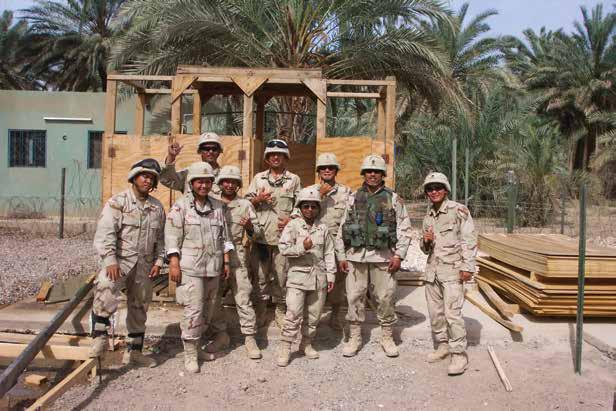
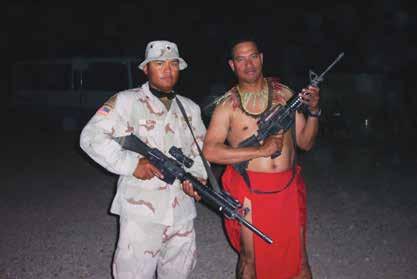 Images from Raffipiy’s time enlisted in the military.
Images from Raffipiy’s time enlisted in the military.
Instead, they’re moving to Guam, the mainland United States, or Hawai‘i. A lack of access to healthcare isn’t the only reason, of course, but for veterans like Raffipiy, it’s a big one. “Why do they have to change their whole life, uproot their whole family, and relocate, just so they can get ongoing treatment?” Raffipiy asks rhetorically.
The situation is one more way in which Micronesian soldiers are disadvantaged, an afterthought in a system not designed for them. Their unique legal status enshrined in COFA not only prevents them from becoming officers but also ensures that their service never really ends. Once a Micronesian soldier retires, his or her life is still largely dictated by the policies and priorities of the military industrial complex. Worse, the situation threatens to bleed Micronesia of some of its most highly educated and skilled citizens. “We want the veterans coming home,” says Hadik, who has made day-to-day issues that Micronesians face a larger part of his nonprofit organization’s mission. He has used his position to highlight the disparity in veteran access to healthcare. Last year, Hadik flew Hawai‘i representative Ken Ito, then the chairman of the Hawai‘i State Legislature’s House Committee on Veterans, Military, and International Affairs, and Culture and the Arts, to Kosrae and Pohnpei to hear some of the veterans’ stories. Shortly after, the Hawai‘i legislature passed a resolution urging the federal government to develop programs and policies to ensure that veterans like Raffipiy have access to the care they need.
In 2017, filmmaker Nathan Fitch, who served as a Peace Corps volunteer in the FSM from 2004 to 2007, released the documentary film Island Soldier , which tells the story of Army Sergeant Sapuro “Sapp” Nena, who was killed in Afghanistan in 2012, and explores the plight of COFA veterans. Together, the resolution and the film are helping bring focused attention to the issue, but it remains to be seen how the governments of the United States, the FSM, the Marshall Islands, and Palau will resolve it. Possible solutions could include an increased use of telemedicine to reduce the frequency of trips to Hawai‘i, or the construction of a new VA healthcare facility somewhere in Micronesia. Hadik also hopes to lobby United Airlines, which has a monopoly on flights in the region, to offer reduced fares for veterans.
There is no universal law that gives parents the right to raise their children in the place where they were raised, but after the sacrifices Micronesians have made for the U.S. military, Raffipiy says, the least the United States can do is help its veterans return home. It’s not only a matter of treating Micronesians fairly, but also of perpetuating the culture. After all, it was Raffipiy’s childhood—the routines and rituals of island life, the respect for family and community and culture—that helped make him a good soldier, a good leader. The life he lived on Satawal prepared him for everything the world eventually threw at him.
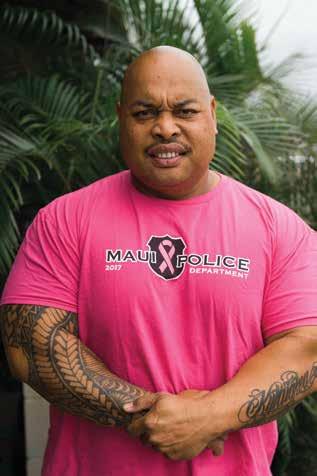
Pius Taiwerpiy, a native of Kosrae, served in Raffipiy’s unit. In the military, a multicultural tribe of Pacific islanders forms over a shared sense of home.
Raffipiy’s children, who have grown up in Hilo, are members of an ever-growing diaspora. They may never call their father’s island home. But he feels strongly that Satawal is their island too. Shortly after returning from Iraq, Raffipiy took his family to Satawal for the first time. His sons were 8, 11, and 13. His daughter had just been born. They spent three months on the island, visiting family and taking part in the rituals of daily life. When it was time to leave, Raffipiy’s kids didn’t want to go. “They were crying,” he says.
That was nearly 13 years ago. Raffipiy’s sons are now grown up. The oldest followed his father into the military, and works as a missile technician on Navy submarines. Whether or not they ever return to Satawal, Raffipiy hopes that his children will remember their time there, fishing and husking coconuts, absorbing the island’s rhythms, and that just as he did in Iraq, they will carry it with them wherever they go.
84 | FLUXHAWAII.COM
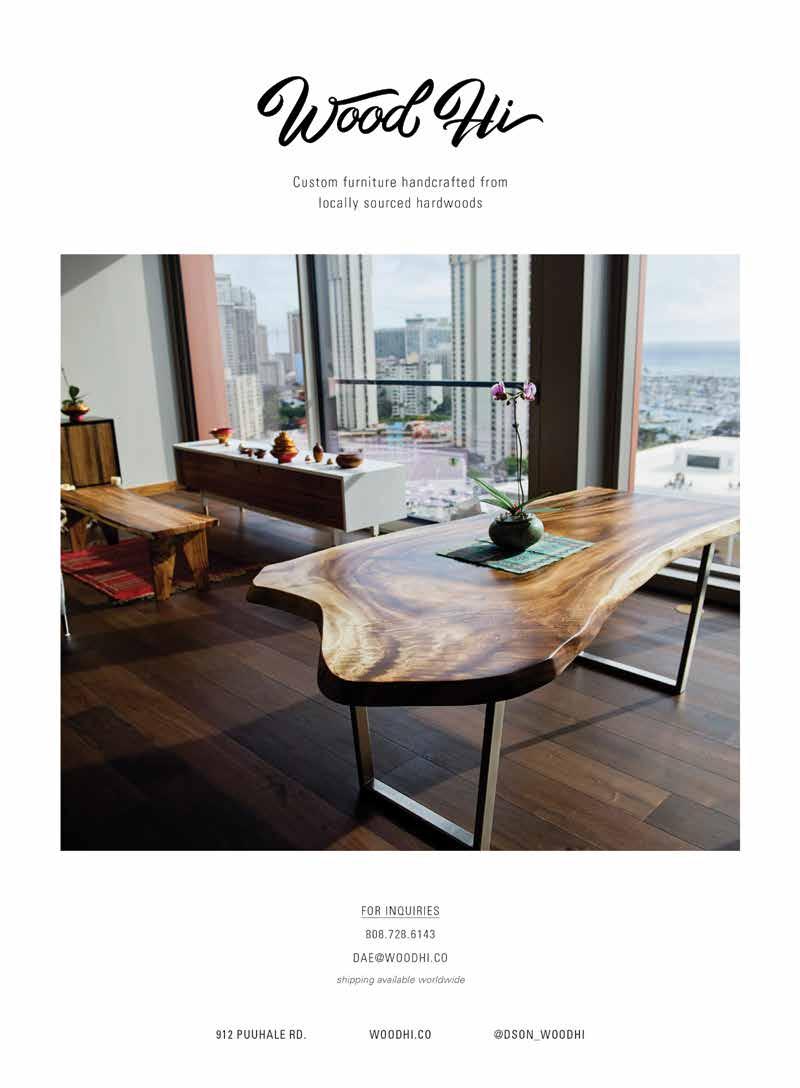 FLUX FEATURE
FLUX FEATURE
The Witness
For more than three decades, photographer Ed Greevy documented land struggles and political strife in the Hawaiian Islands. Here, a look back on how those movements formed and resisted, as he observed from behind the camera.
TEXT BY MATTHEW DEKNEEF
IMAGES
BY
JOHN HOOK
PRINTS
BY
ED GREEVY
A supporter with People Against Chinatown Evictions marches in opposition of housing evictions, 1977.
86 | FLUXHAWAII.COM
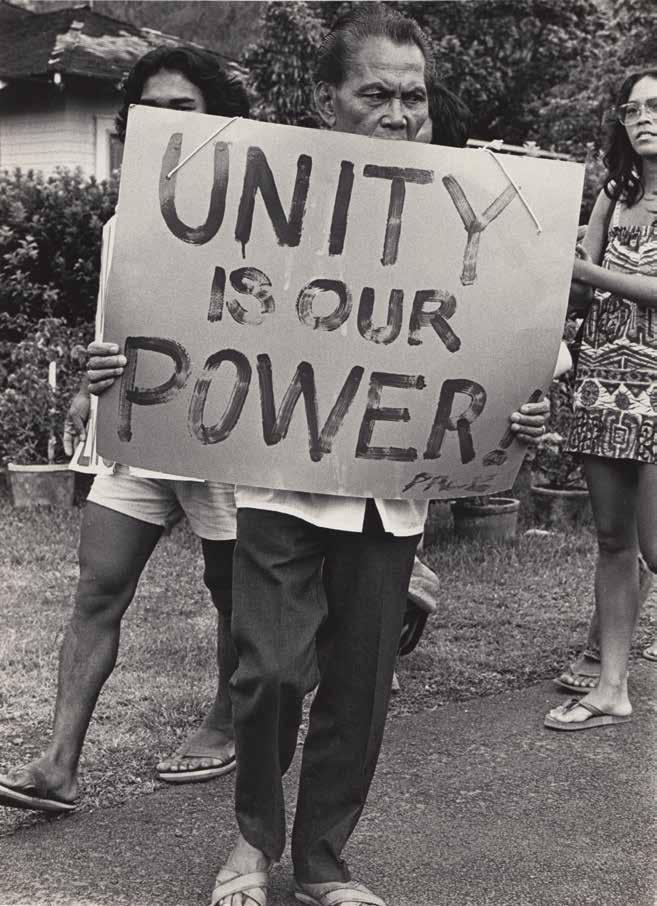
Ed Greevy’s first camera lens—a 500-millimeter Telefoto—was an extravagant purchase for 1962. An aspiring surf photographer, Greevy reasoned he needed the heavy-duty piece of equipment to zoom in on Oʻahu’s powerful breaking waves from the shore. He aimed to produce images that made it seem as if the viewer was right there in the barrel.
It is this creative impulse to reach the center of a subject that would drive and inform Greevy’s photographic career in the decades that followed. The images for which he became most known have little to do with surfers or surfing, yet they zeroed in on a sea of change, swelling around Hawaiʻi’s rising social consciousness. His coverage of protests, speeches, and civil disobedience in the ’70s, ’80s, and ’90s over the development of Hawai‘i’s beaches, the displacement of local communities, and desecration of Hawaiian culture would achieve the visual depth he searched for in those waves. A tight frame could be dedicated to a person rallying at a podium or a wide shot of a crowd so overwhelming it was rendered a single solid shape. The effect of these visual rhythms transports the viewer into the same psychological sphere: You feel in the middle of something big. Instead of shooting power from a distance, he shot it up close among the people and the crowds—and he would never need that Telefoto lens to do it.
On a summer morning at Ed Greevy’s apartment in Makiki, sunlight streams through a window and glints off his spectacles. He has a thought. “The definition of a good photo is something that impacts you emotionally,” the 79-year-old says, “and imparts a lot of information.” His living room is packed with black-and-white prints he has taken over the years—some are scattered across a coffee table, while others hang on the walls, covering nearly every inch. Like a roll of negatives in a canister, the room feels like a tightly filled space in which time stands still. “In a complicated photograph, the subject needs to be very clear,” Greevy says.
Set flush in a corner of the room is an industrial metal cabinet. It stands more than six feet high and has two gray doors. He swings them open to reveal neatly stacked black trays. The cabinet is largely organized by location, and on the side of each tray, bold, Sharpie-scrawled words announce their contents: “Kalama Valley,” “Chinatown,” “Mokauea Island,” “H-3,” “Makua,” and so forth—his filing system marching through Hawaiʻi’s notorious history of razing the natural landscape and evicting people from their residences. Inside there are, he estimates, 60,000 prints and negatives.
Many people already know a Greevy photo without even knowing they do. Think of activist Haunani-Kay Trask, her fist thrusting forth from a gazebo at ʻIolani Palace, following a march in 1993 on the 100th anniversary
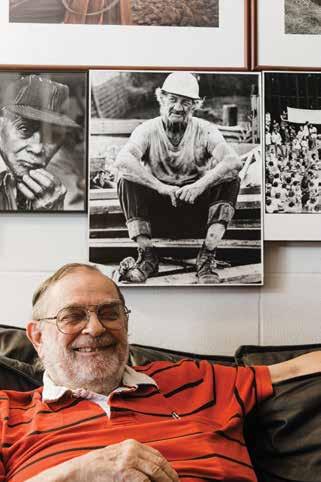
became involved with various land struggles in Hawai‘i. He says, “The photos were my way to contribute.”
of the overthrow of the Kingdom of Hawai‘i. Or recall Terrilee Keko‘olani, a young adult defending Sandy Beach in 1972 against city plans to build a 5,000-unit housing development across the shoreline, the wind blowing dark locks of hair across her face as she speaks into a microphone. In another well-known visual, a Hawaiian man in a gourd helmet, his arms crossed defiantly, protests the military bombing of Kahoʻolawe at the Hawai‘i State Capitol in 1977, a motion blur keeping only his eyes and head in tight focus. Everything else in the frame is shaken and disoriented, as if the world is exploding around him. Today viewers are able to consider Greevy’s tremendous output collectively, most readily in Kūʻē: Thirty Years of Land Struggles in Hawaiʻi , a hardcover photo essay book published in 2004. While many photographs rely on captions to provide context, Greevy’s are illuminated through his concentration on signage: “People Not Profits,” “No Bulldoze,” “Housing is a Right,” and “Decolonize.”
88 | FLUXHAWAII.COM
Ed Greevy in his Makiki apartment, where his portraiture of community activists hangs behind him. Inspired by the social movements of the 1970s, Greevy
 Ed Greevy outside a film studio in Mānoa, 1968.
Ed Greevy outside a film studio in Mānoa, 1968.
They both show and tell us their battles and the climate of the times. This printed retrospective, however, casts his photographs in a different light than that of the more practical and urgent purpose for which they were intended.
Greevy’s earliest images were developed exclusively for leaflets and notices to be handed out by community organizers. The images were a conscious currency used to rouse public support for the groups and nonprofits—Save Our Surf, Protect Kahoʻolawe ʻOhana, Kōkua Hawaiʻi, Ka Lāhui Hawaiʻi—that began to energize the local landscape. More often than not, this collateral would circulate without his photo credit. “And that was fine,” Greevy insists. “It was never about me.” A selfproclaimed leftist, Greevy’s intention was to help sharpen the struggles and political efforts of these groups. “I’m not a photojournalist, I’m not neutral, and I don’t pretend to be,” he says. “I always support the underdog, and the photos are my way to do that.”
Born in 1939 in Los Angeles, Greevy first visited Honolulu in 1960 as “an adventurer,” he describes himself then, with a group of friends. The plan was to attend the University of Hawaiʻi at Mānoa for a semester, but he fell hard for surfing and dropped out after two weeks. “If I could spend eight hours a day in the water, then that was a good day,” he remembers. He spent the following spring and summer chasing waves, and then returned to California to finish a degree in political science at Long Beach State University. In the years that followed, he picked up his first camera, a 35-millimeter Nikon F, and began a career in insurance that took him to New York City. Greevy eventually made a move back to Oʻahu in 1967, immersing himself in
commercial photography including travel advertisements and promotional material for musicians. He also set up his own film lab on Cummins Street. “Besides the newspapers,” Greevy says, “I probably had one of the biggest darkrooms on the island.”
The first protest Greevy photographed was on March 31, 1971. It was a mass demonstration at the Hawaiʻi State Capitol where two community groups, Save Our Surf and Kōkua Hawaiʻi, joined forces to raise concerns over a number of burning issues, including the planned widening of Kūhiō Beach and the evictions of residents living in Kalama Valley. “It was electric,” Greevy says, of the estimated 2,500 people who turned out. The Capitol, which had only been built a few years prior, had not experienced a focused rally of that size before. “The legislators closed and locked their doors,” he says. Greevy was swept up in the impassioned tempo of the crowd comprised mainly of young adults in their late teens and early twenties. But it was John Kelly, the 52-year-old founder of Save Our Surf, moving back and forth from speaking at the podium to the fringes of the crowd, who captured Greevy’s fascination because he noticed Kelly using his own camera to document the event. Inspired to help, Greevy offered up his own Nikon, so Kelly could stay immersed in the action. “The photos were my way to contribute,” Greevy says. He left with eight rolls of film and a lifelong friendship.
Kelly understood how to use photography to seize public attention. At his home at Black Point, Kelly had a printing press that he used to materialize Save Our Surf’s political ephemera. “John always said the only free press is your own,” Greevy says. Because Kelly’s tactics relied
on dynamic photos, he began to call Greevy when he needed someone to chronicle the group’s activities. With Greevy’s images, Kelly could streamline and customize Save Our Surf’s communications to get the word out. Greevy became more invested and involved. “John never went anywhere by himself,” Greevy says. “He never went to argue with a state official on his own. He always brought people with him. Because he always wanted to demonstrate power. That’s what the politicians listened to.”
The intense proximity between the camera and the subject has always been a source of drama and satisfaction in a Greevy photograph. In a memorable image of resisters forming a human barricade to block police officers from entering a Chinatown building to evict residents, Greevy is close enough to the action to lock arms with them. During an anti-racism rally led by Hawaiian Studies students at the University of Hawaiʻi at Mānoa, his camera is so deep in the fold that the final images are swallowed by signage. Because of Greevy’s comfort in navigating these contentious spaces, it’s impossible to ignore the resisters’ message.
When first visiting a community, Greevy “never went in cold,” he explains. “I always went with someone respected or known [by the community]. Often that was John.” Alliances between groups were major sources of amplifying their messages and actions. Following statehood, Hawaiʻi underwent a considerable period of urbanization as its economy began to shift from agriculture to tourism. Eventually, Kelly began to bring Greevy to document the struggles of affiliates of Save Our Surf such as Kōkua Hawaiʻi, which was fighting against evictions at Kalama
90 | FLUXHAWAII.COM
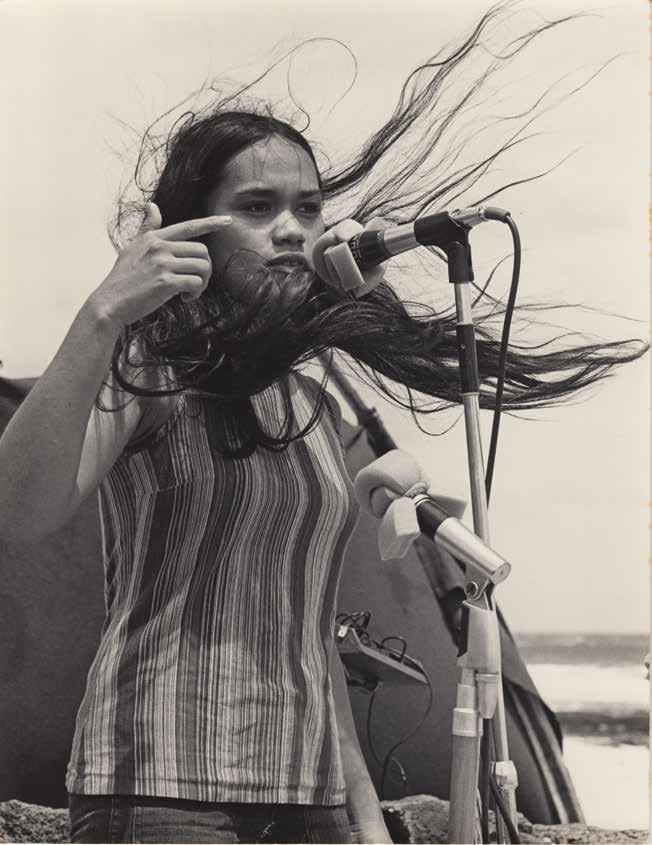 Activist Terrilee Keko‘olani at Wāwāmalu (Sandy Beach), 1972.
Greevy says this portrait has become his most recognized photo.
Activist Terrilee Keko‘olani at Wāwāmalu (Sandy Beach), 1972.
Greevy says this portrait has become his most recognized photo.
Valley, Chinatown, and Waiāhole-Waikāne. Landowners were terminating short-term leases of residents who had lived in neighborhoods for generations in order to pave the way for hotels and more commercial businesses. “From there, relationships develop, people remember you,” Greevy says, “and welcome you the next time you come in alone.”
There’s a sense of familiarity with the communities and organizers in Greevy’s photography that is most arrestingly on view in his portraiture. The intimacy asks a compelling question: How did this Caucasian man from Los Angeles gain the trust of so many groups wary of outsiders? Greevy recalls management training he attended in the mid1960s in New York City. It was a session on how to work a room, assert one’s influence quickly. “They were all the rage then,” he says, smirking. He realized that most of it didn’t translate in Hawaiʻi. As Kelly began to introduce him to more communities, Greevy grew sympathetic to their struggles. While attending their town halls and group meetings, he made a conscious effort not to be seen as the “pushy haole,” he says. “Don’t feel like you have to intervene. Just shut up and listen.” Greevy’s ear was most sensitive to when people were talking among themselves. In the conversations he overheard, he was able to better understand how people felt about an issue and connect with them.
This patient approach to his subjects is what makes the portraits so emotionally generous. While they are primarily absent of the cues that conventionally represent power, such as crowds and onlookers, Greevy’s images of individuals command respect nonetheless. His close-ups aligned impassioned citizens with well-known leaders. “I would shoot at a low angle to make the everyday person look more powerful,” Greevy says. “If I was going to support someone, I was going to make them look good. Heroic, even.”
Greevy’s biggest influence was the American photojournalist W. Eugene Smith, who was known for black-and-white compositions and an evocative emphasis on contrast. But there are shades in Greevy’s work reminiscent of other photographers, namely Gordon Parks and James Barker, both of whom documented race relations in the United States during the Civil Rights era. As in Parks’ photos, there are the rallies and the signs, but there are also homes and children. The visual grammar of Greevy’s images has similar parallels—they speak in shouts, but also in whispers. “A lot of the people I was shooting were from marginalized communities and hadn’t had photos taken of them before. They hadn’t ever seen themselves,” Greevy says. “I wanted to help them see themselves.”
There’s a tray in Greevy’s cabinet labeled “Kauaʻi” that’s a poignant example of this. In 1974, he visited the Nāwiliwili-Niumalu area to meet with organizer Stanford Achi, who was uniting the community in resistance to urbanization along the southeast coast of the island. Hotels were scouting the beaches and backyards for
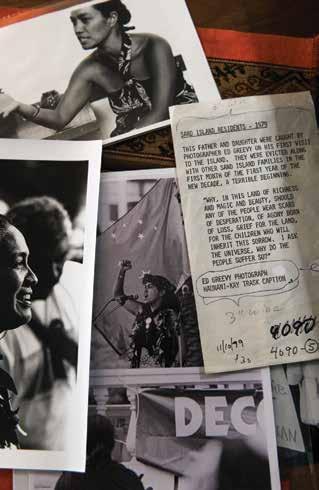
In the 1990s, Greevy became a close friend of native Hawaiian activist and scholar Haunani-Kay Trask, photographing her impassioned speeches and leadership.
future developments. Greevy, as expected, tirelessly photographed the meetings, the speeches, and the sign waving; his posed portraits of the group affirmed their human army. After this is where most photojournalists would exit the scene. But Greevy lingered to show their way of life: landscapes of men and women tilling taro fields, young girls in muʻumuʻu laughing while they walk their bikes home, paddlers in canoes in the Hulēʻia River, the water glistening and the river beds untouched. When Greevy clicked away at a subject, he was aware that something was always at stake.
Greevy, who is retired and doesn’t shoot as much these days, is content with the legacy his photographs leave behind. He’s been researching archives to someday house this library of images. “I just hope my photos inspire people and remind them of their power,” he says, as he locks up the cabinet that holds his life’s work. “That’s their only value.”
92 | FLUXHAWAII.COM
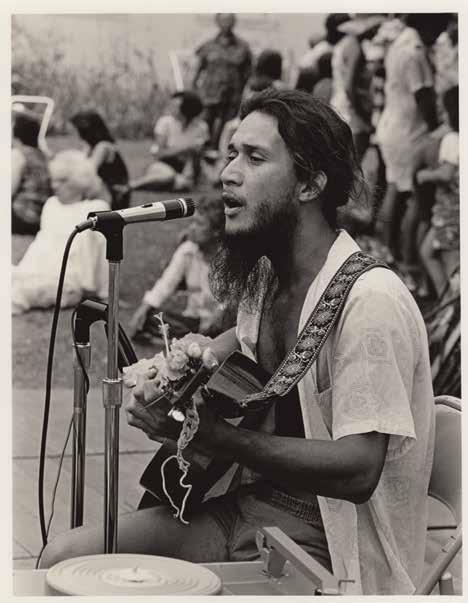
Musician and activist Liko Martin uses mele to spread a message against the eviction of Waiāhole farmers, 1976. Martin wrote “All Hawai‘i Stand Together,” a protest anthem calling for unity and social justice, during the Hawaiian Renaissance.
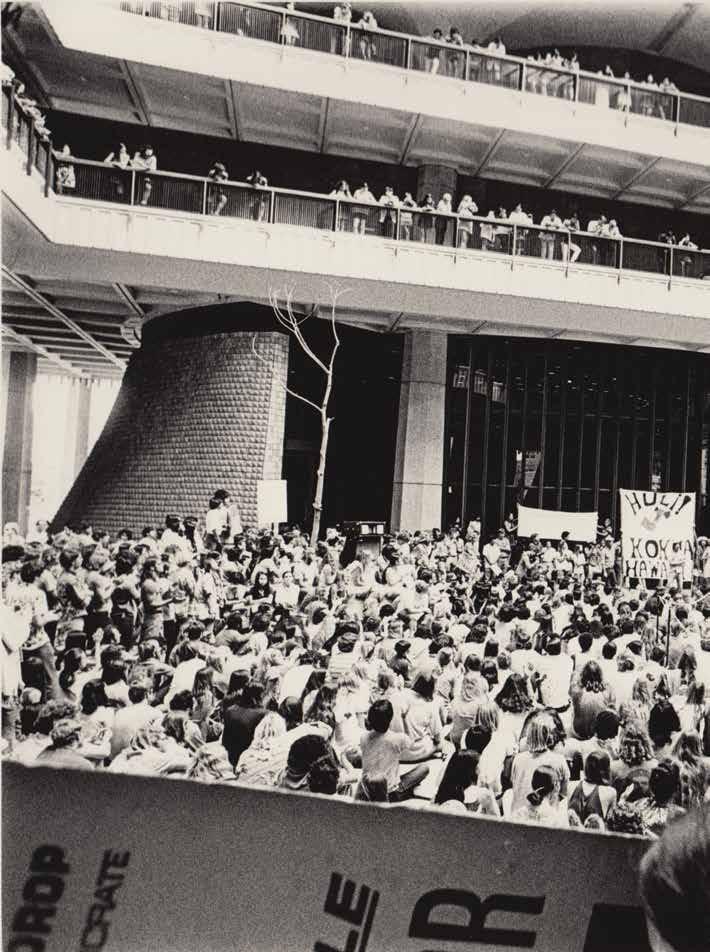 Demonstration at the Hawai‘i State Capitol on March 31, 1971. The rally united Kōkua Hawai‘i and Save Our Surf in demanding action against housing evictions and the destruction of surf sites.
Demonstration at the Hawai‘i State Capitol on March 31, 1971. The rally united Kōkua Hawai‘i and Save Our Surf in demanding action against housing evictions and the destruction of surf sites.

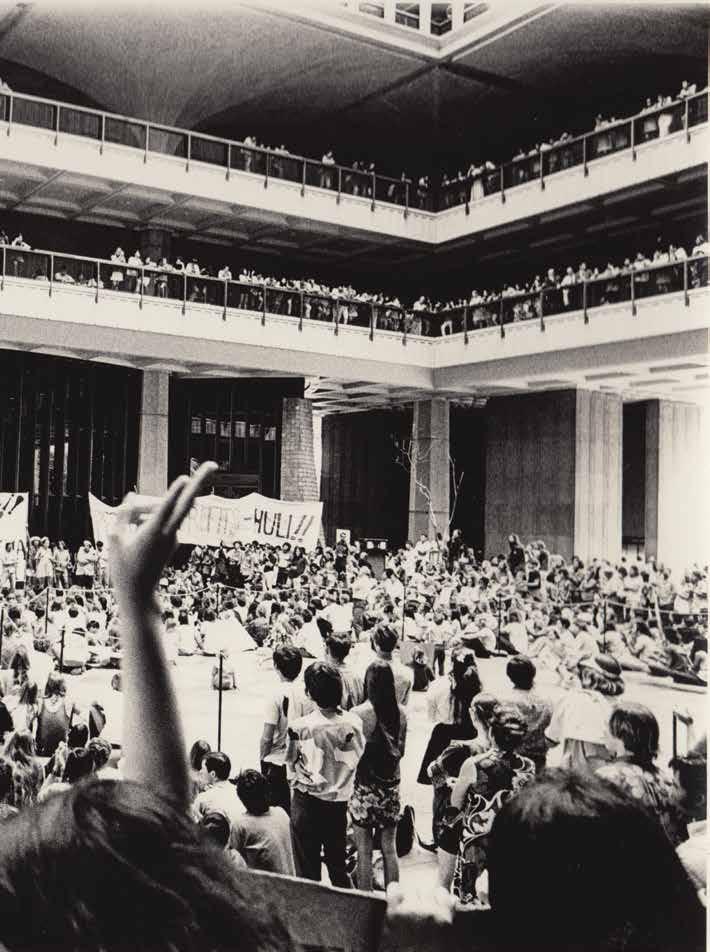

Kaua‘i community organizers and residents, 1973. The Nāwiliwili-Niumalu Tenants’ Association met many times in the 1970s and 1980s to fight off high-priced development.
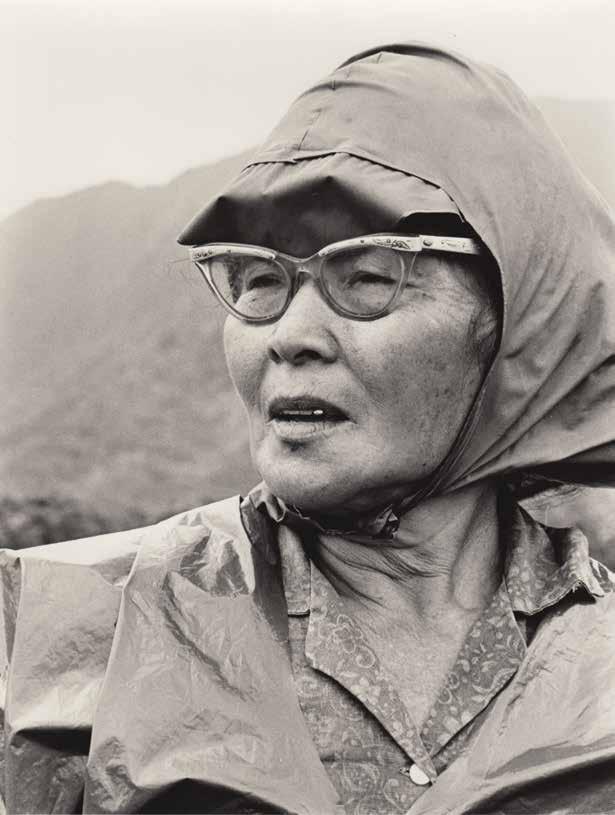 Mrs. Fujiko Matayoshi, 1973. Known as the “Sweet Lady of Waiāhole,” Matayoshi came to represent the working farmers in the land struggles of Waiāhole-Waikāne.
Mrs. Fujiko Matayoshi, 1973. Known as the “Sweet Lady of Waiāhole,” Matayoshi came to represent the working farmers in the land struggles of Waiāhole-Waikāne.
Anti-eviction activisits link arms in front of an affordable rental building in Chinatown, 1977. At center, organizer Pete Thompson is surrounded by newly emerging leaders Alan Nakasone, Soli Niheu, Kalani Ohelo, Sandy Yee, and Justine Ferreira.
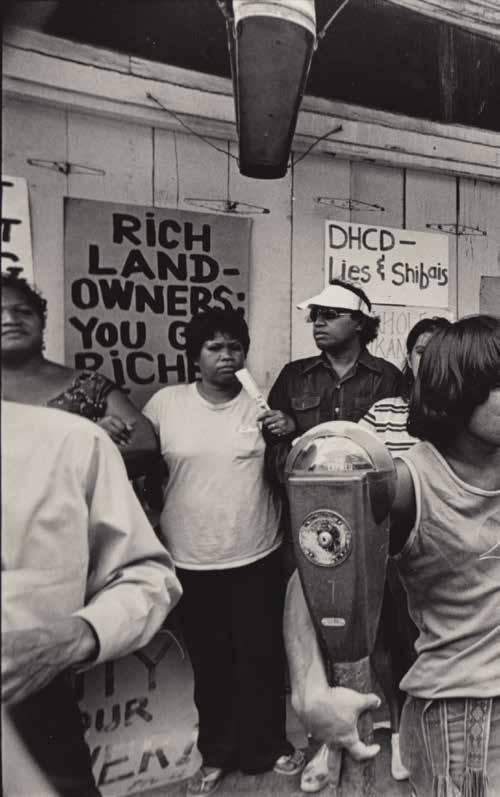

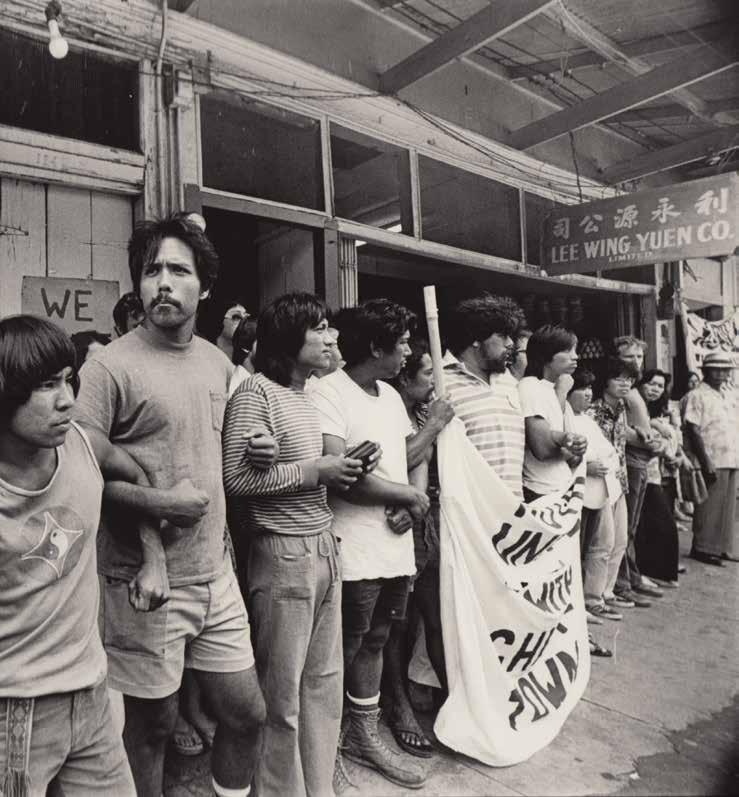
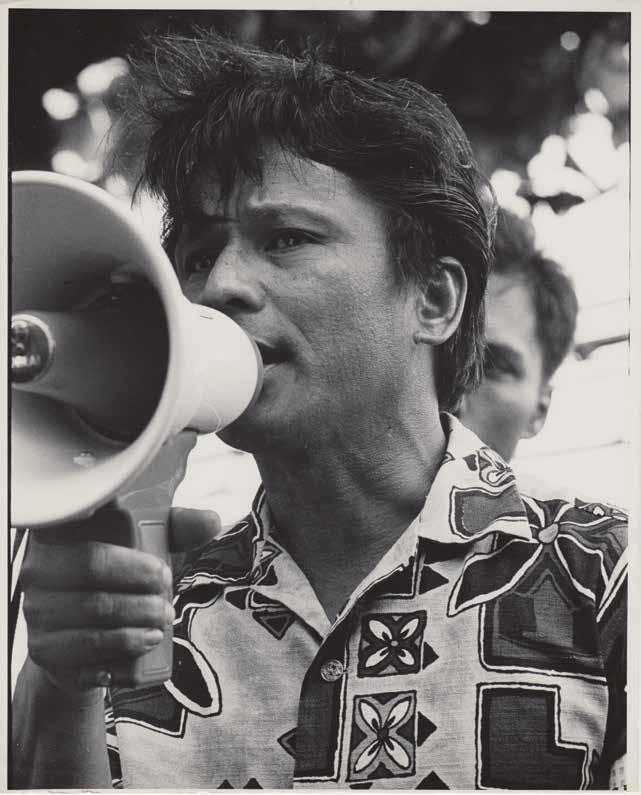
Community advocate Ike Manalo lends his voice, 1976. A leader for the Waiāhole-Waikāne Community Association, Manalo helped organize protests at court houses, union offices, and bank lenders.
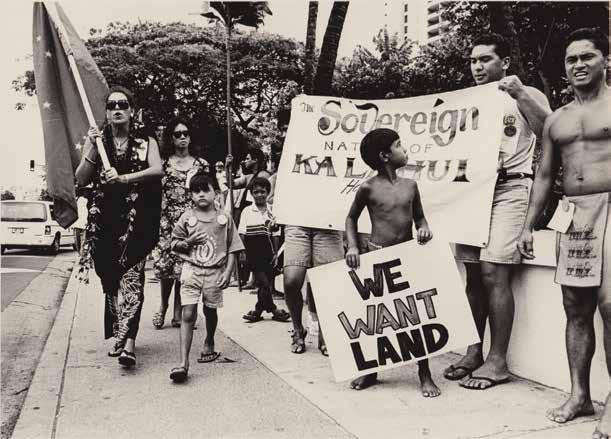
Ka Lāhui demonstrates at the Hilton Hawaiian Village, 1993. Activist and scholar Lilikalā Kame‘eleihiwa, waving a flag, led the Hawaiian sovereignty group in a march to hear President Clinton’s speech on Waikīkī Beach, where he acknowledged Hawaiian demands for justice.
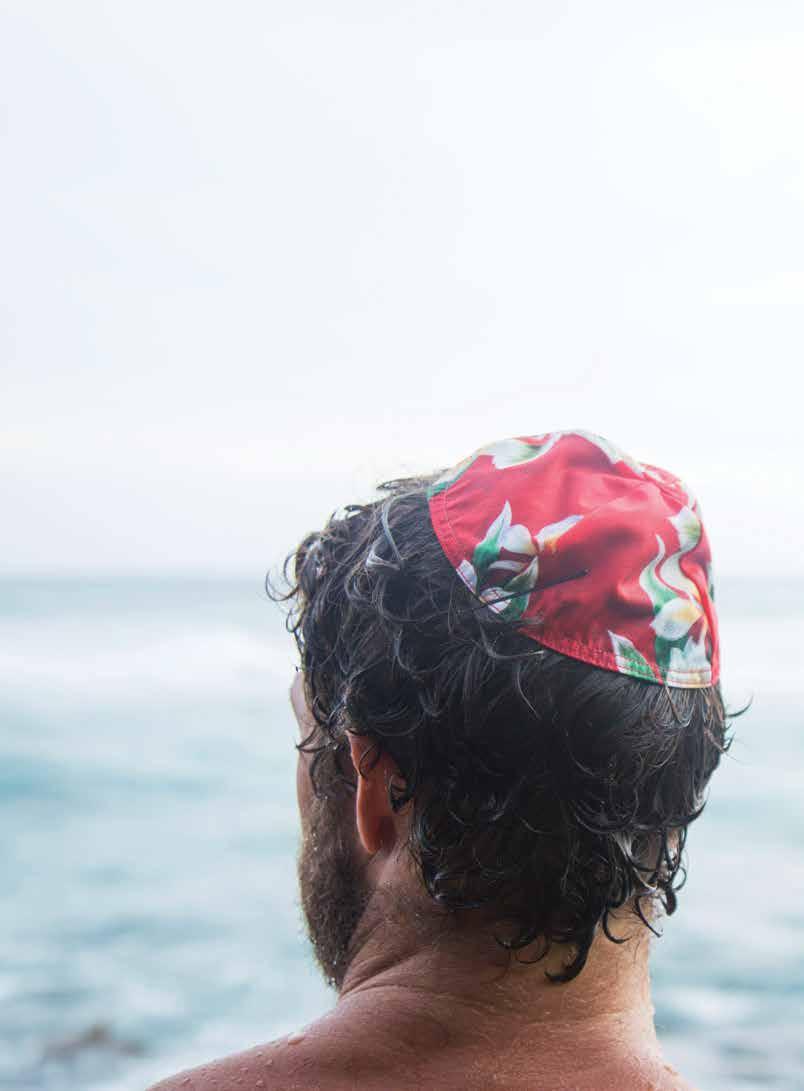
102 | FLUXHAWAII.COM

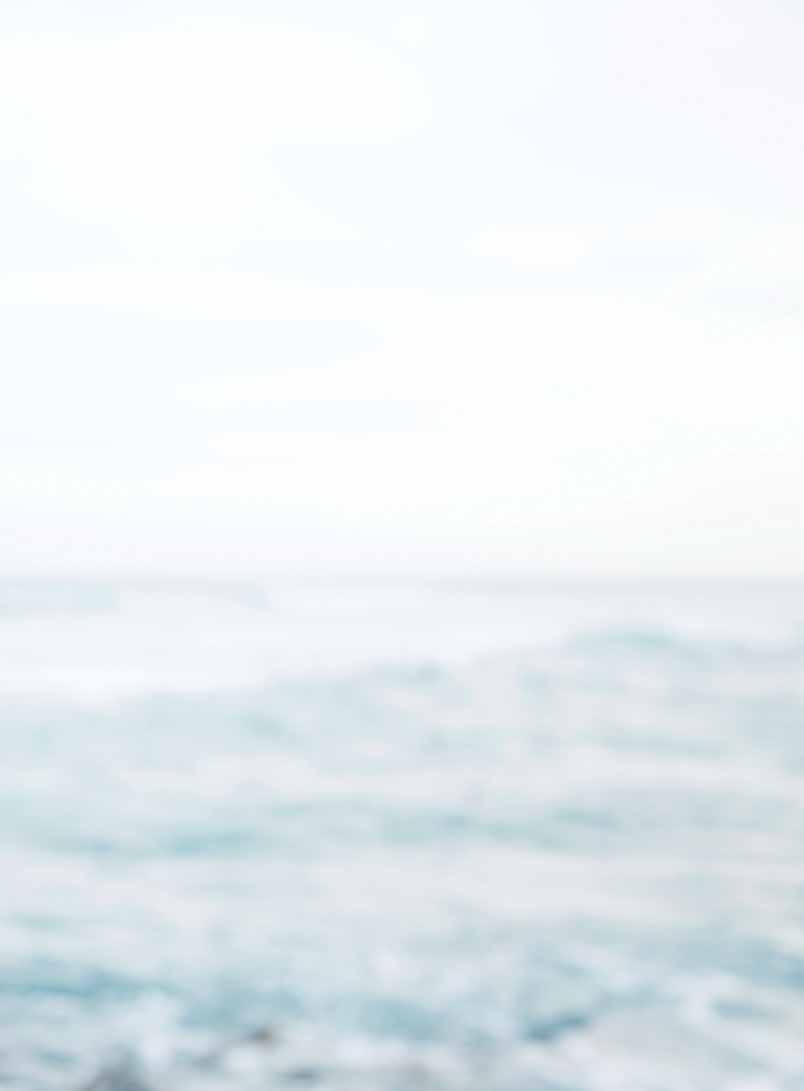
FLUX FEATURE
Jew-ish
A writer journeys from land to sea to discover what it means to be Jewish in Hawai‘i.
TEXT BY BEAU FLEMISTER
IMAGES BY MARIE ERIEL HOBRO & JOHN HOOK
By all accounts, I’m not the best Jew. I’ve eaten reheated baby back ribs from Outback Steakhouse an hour before going to temple. I’ve never had a bar mitzvah. I married a shiksa (non-Jew). I don’t own a yarmulke, and I don’t know the words to “Hava Nagila.” At barbecues, I pile Redondo’s sausages on the grill next to tri-tip steak next to ʻahi fillets. And that’s not kosher. Literally. But I know that I am a Jew because being Jewish, as much as it is a religion, is an ethnicity. There are names—Stein, Cohen, Weiss, Witz, Levy, Berg—that signify the relatives of our tribe.
As a kid, I knew our people suffered from a long history of persecutions. I knew what the Holocaust was and that it mostly affected us. But most Jews didn’t come to Hawai‘i under duress. Heck, my parents came a few years after the Summer of Love to surf and get weird on Kaua‘i before acting like adults on O‘ahu.
Growing up in Hawaiʻi, I figured I was Jewish because my parents told me so. Not that they were sparkling examples. We didn’t even watch Seinfeld—New York seemed like a different planet compared to O‘ahu. Mom preferred ER when George Clooney was on, and Dad’s pick was the local show Let’s Go Fishing. Hari Kojima was probably the closest thing to a rabbinical figure he ever had.
Perhaps the most Jewish thing I experienced as a child in Hawai‘i—besides the sound of my grandma Janet’s voice (think Kyle’s mom from South Park )—was lighting the menorah each year during Hanukkah. At a Flemister Hanukkah, you lit a candle each night, often forgetting the last two to three evenings, and got increasingly cheaper gifts for eight days in a row. This was mostly because we also celebrated Christmas, placing a Star of David on the top of a Douglas fir. My sister and I always knew Christmas was where the “real” presents were.
While we were told we were Jewish, there was little proof of it. I often wondered what it meant. Was I Jewish because my mom refused to pay full retail? Perhaps I was Jewish because I understood a handful of Yiddish words in the same way our Labrador retriever instinctively doggiepaddled when thrown into the sea. I knew exactly what it meant when my mom said she didn’t want to schlep into town again, or how so-and-so was being a schmuck , or what it meant to nosh or noodge . I intrinsically knew the difference between a mensch and a meshuggener , and to refrain from being the latter. But was that really what it meant to be a Jew? My Japanese friends had bon dance and ramen, my Hawaiian friends had hula and Bruddah Iz, my Korean buds had kimchi and taekwondo. What was our thing? What was our cultural contribution to this bubbling ethnic melting pot? Nobody wants gefilte fish when mahi mahi is on the menu. Even at 10 years old, I knew matzah balls could never outshine malasadas.
I wondered this same question 25 years later. What does it mean to be Jewish—practicing or not—in a remote chain of islands in the middle of the sea? How did other Jews do Jewish here? I would go on my own journey, my
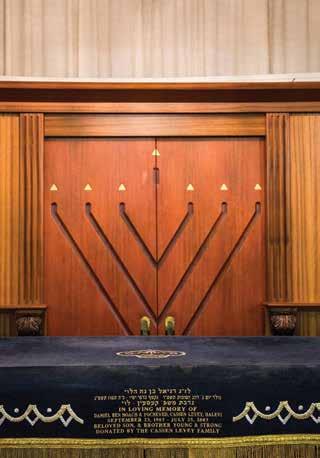
“In Hawai‘i, many Jewish people have moved here away from the structured Jewish life found in bigger cities like, say, New York. This Chabad was established as a place where Jews can plug in, learn, and participate,” says Rabbi Itchel Krasnjansky, who started Chabad of Hawai‘i in Waikīkī after moving to Hawai‘i 30 years ago.
own walkabout in the community, to find out. Naturally, I’d have to start with the synagogue.
I slid into Shabbos (common Yiddish for the Jewish Sabbath, or day of rest) at Temple Emanu-El by the skin of my teeth, having been held up by the storm that was dumping rains of Biblical proportions across the state, bringing flashfloods that could certainly hint at the anger of a “greater presence.”
Since the early 1950s, Temple Emanu-El has been a Reform Judaism temple, meaning it is a bit more lax on rules like partitioning men and women during prayer or dress codes. Here, not everything is stringently kosher. It is right off the Pali Highway in Nu‘uanu, just a block from Congregation Sof Ma’arav, a smaller Conservative Judaism group.
“Personally, I look at my Jewish identity as a faith community, much like our other religious neighbors,” said Ken Aronowitz, the rabbi of Temple Emanu-El. “I think looking at Jewishness from an ethnic standpoint doesn’t really lend itself to those that would like to become Jewish
104 | FLUXHAWAII.COM
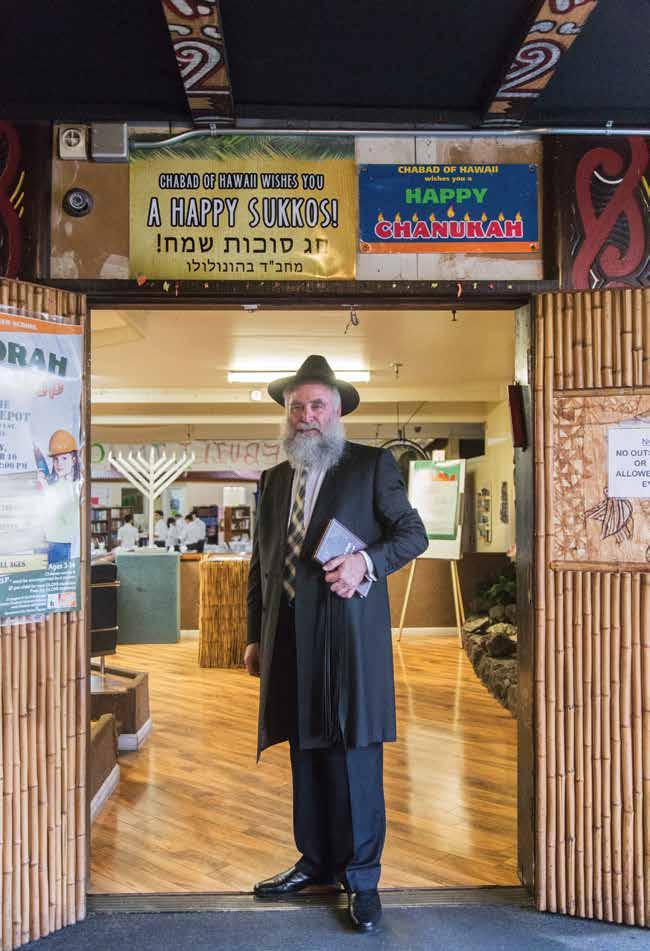
by choice. Also, belief in God is not a litmus test for coming through the doors of our temple. It’s not about believing in God or not believing in God, it’s about coming in here and being open to experiencing a greater presence.”
Doing most of the service with a wireless headset microphone and a guitar slung over his shoulder, Aronowitz seemed pretty hip as far as holy men go. It may have been due to the storm, but the assembly was fairly small, consisting of a couple dozen souls alongside a handful of college looky-loos on an excursion for a religion course who you could spot because most congregants were a couple generations older than them. They were welcomed warmly, nonetheless. We sang songs. The vibe felt safe and warm, like most churches do, compounded by the fact that it was thundering outside.
Afterward, I asked the rabbi about connections between Jews and local Hawai‘i culture. What was their figurative addition to these islands’ ethnic plate lunch? He brought up the synagogue’s common greeting, a cute portmanteau combining the Hebrew greeting of shalom and aloha: shaloha. Also, he explained that Temple Emanu-El houses the King Kalākaua Torah Scroll, which was passed to the temple by Princess Abigail Kawānanakoa, passed to her from King David Kalākaua, and was originally given to the king in 1886 for safekeeping by Elias Abraham Rosenberg, a zany Jewish friend and advisor who became known as a kind of royal soothsayer.
Throughout, Aronowitz focused more on the inclusivity of Judaism. “Israel literally translates as, ‘to wrestle with God,’” he said. “So I invite people to get in the ring. I think people search for meaning, and I hope that’s what we offer.”
“Israeli can be a loaded word,” said Moshe Hakemolo, an Israeli Jew who moved to Hawai‘i 20 years ago and now owns Diamond Guy Hawaii, a diamond jewelry business in downtown Honolulu. We met for coffee at Ala Moana. He was dressed brightly, like he was going golfing soon, though I don’t think he was. Like many Israelis I’ve met over the years, Hakemolo had a no-nonsense vibe about him and looked me squarely in the eyes when he spoke.
“I think sometimes when people think of that word [Israeli], they think ‘sharks,’ ‘aggressive,’ ‘harsh,’ ‘business savvy-ness,’ ‘won’t stand in line,’ etcetera,” he said. “But ʻJewish,’ to me, brings a different platter of words. Being Jewish means a deep belief that everything is going to be OK and turn out good in the end. But I see the distinction between the two precisely because I left Israel.”
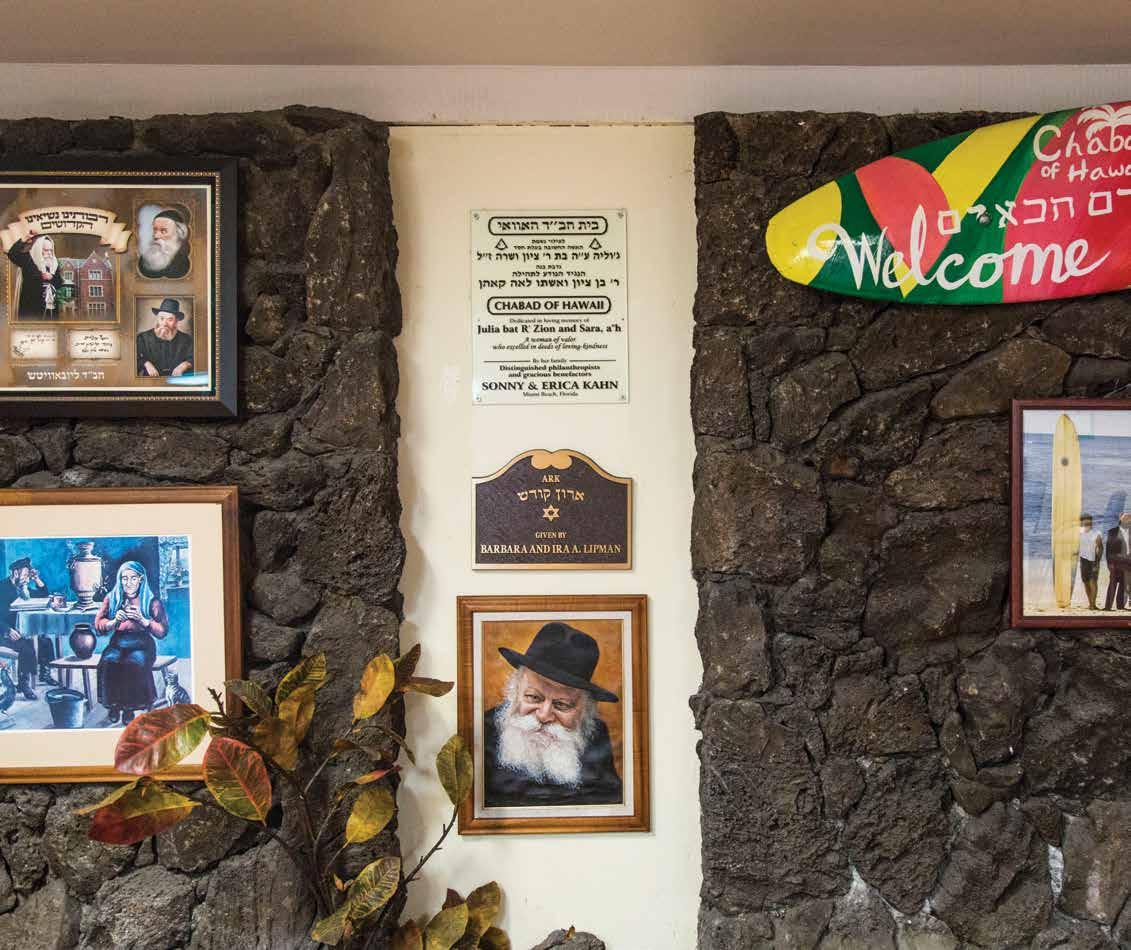
106 | FLUXHAWAII.COM

Like most Israeli men and women, after high school, Hakemolo did mandatory military service in Israel for a couple years. His grandmother was a Holocaust survivor who escaped a Treblinka extermination camp and moved to Israel with her husband in the 1950s with practically nothing. What I’m getting at is that he is made of something harder than an American Jew like me.
Though he assures me that he loves his home country, he likens Israel to a pressure cooker—volatile borders, an expensive cost of living, and increasing traffic—ready to combust. So not long after serving in the army, he moved to Hawai‘i (about as far away from Israel as you can get), opened a business, and started a family. Now he considers Hawai‘i his long-lost home. Not that the transition was easy. Hakemolo admits that at first he couldn’t understand the pace of life here, the slow driving, the food, why everyone was smiling all the time.
“I see it with my mom and other Israelis the first time they come here,” Hakemolo said, smiling. “They don’t get it because they still have ‘Israeli eyes.’ At first they think, as I did, that everything is all wrong because it’s not the same as home. It’s like, if you’re eating spicy all the time and someone gives you candy or something not so harsh tasting, you don’t get it. That’s why I’m so glad to raise my own kids here. It’s easier to find yourself in Hawai‘i, you’re more at ease here than in a place like Israel. At the same time, growing up at home is what gave me my thick skin and made me tough.”
I asked him about any Jewish or Israeli influence he might see making its way into the myriad of cultures here.
“You know, every people has their history of struggle, but,” he says with a pause, before smiling again, “the length and numbers of struggles Jews faced, maybe it’s in our DNA to be the underdogs. So I hope that manifests itself with compassion and sympathy.”
A couple days later, I looked for such a manifestation at a Chabad house in Waikīkī, one of the most remote shuls
(synagogues) in the world. Incidentally, it is located at the shuttered Hawaiian Hut nightclub by Ala Moana Hotel. Rabbi Itchel Krasnjansky started the center after moving to Hawai‘i with his wife, Perel, 30 years ago. Chabad, a movement that is part of the Ultra-Orthodox Hasidic faction of lively, mystical Judaism, acts as a type of Jewish Peace Corps, reaching out to Jews all over the world. “In Hawai‘i, many Jewish people have moved here away from structured Jewish life found in bigger cities like, say, New York,” Krasnjansky explained to me before Friday’s Shabbos service. “And some Jews might feel like they’re going through the motions, but not feeling the heart. This Chabad was established as a place where Jews can plug in, learn, and participate.”
Unlike in New York, where it’s easy for Jews to live the Hasidic lifestyle, here in Hawai‘i, “You gotta want it,” Krasnjansky said. “It’s harder to keep Shabbat in a place like this when you might be the only ones doing it. It’s challenging, but I think there’s a deeper appreciation to our traditions that comes with it.”
The Hasidic community here lives with the laws in the Torah as their guidebook. They keep kosher. While it’s not a requirement in coming to the Chabad house, most women here were dressed modestly, in accordance with traditional Jewish law, while the men were dressed like how would you see in certain tightknit New York neighborhoods: black suits, black hats, payot (side curls), tzitzit (dangling waist tassels). However, other visitors wearing aloha shirts didn’t get any side looks. The shul caters to the small community of Hasidic Jews in the state, as well as visiting Jews looking for a kosher Shabbos and place to pray. It also sells aloha-print yarmulkes. And heck yeah, I wore one.
Shabbos at the Chabad house was a different scene than at Temple EmanuEl. The congregation was even smaller, and besides an opening lecture from Krasnjansky in English, most of the service was a collection of ancient hymns,
“Being Jewish means a deep belief that everything is going to be OK and turn out good in the end,” says Moshe Hakemolo, an Israeli Jew who moved to Hawai‘i 20 years ago and has since opened a business and started a family.
108 | FLUXHAWAII.COM
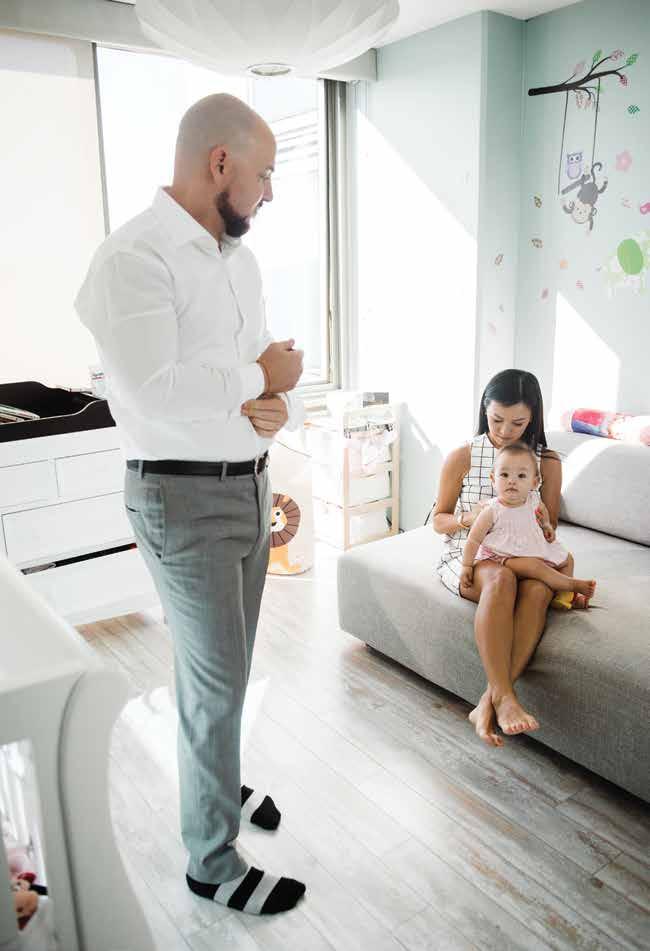
incantations, and rhythms sung in Hebrew. The service was partitioned, with men on one side, women on the other. But it was also a spirited affair. At times, men danced and swayed back and forth while reading aloud from the prayer book, a common physical rev-up (known as shucklen in Yiddish), derived from a passage in the kabalistic literature of the Zohar: “The light [in his soul] is kindled … and he sways to and fro like the flame of a candle.” Sure, I was pretty lost lyrics-wise, but service was no mellow sit-down.
“In the Hasidic community, we have a philosophy,” Krasnjansky said. “One of the cardinal beliefs is, you’ve got to be happy. Philosophically, it’s a joyous approach to serving God and to life in general, and that’s the hallmark of a Hasidic life.”
younger twin brothers (Aaron and Jordan Kandell, screenwriters on Disney’s Moana ) in tow, the whole family paddled out on longboards to a lagoon near Diamond Head. They formed a circle and simulated a Hawaiʻi burial-at-sea ceremony, reading the speeches and throwing the strings of lei into the center. Then they rode waves to shore. It was a rite of passage Keith’s father would dub his “surf-mitzvah,” a beautiful blending of ancient customs with a local twist.
After our conversation, I continued to wonder about my faith. I wondered about the community in Hawai‘i that numbered less than 10,000 people who were somehow relatives of my “tribe.” It began to make sense what identity, what language, what a belief can be when everything has been taken from you and it’s all that you have left. Or I could at least see why it mattered to so many, especially if you come from a people group that has a history of being expelled or exterminated over centuries.
About 25 years ago, when my childhood friend Keith Kandell— now a successful director and filmmaker—was nearly 13 years old, his parents, trying to give their oldest son some sense of heritage or cultural connection to his Jewish background, asked him if he wanted a bar mitzvah. Keith was into the idea of the ancient coming-of-age ceremony for many Jewish boys and girls during which they read key passages from the Torah and afterward party-hearty, and so a rabbi came over a couple times to study Hebrew with him for the impending big day. Very quickly, Keith started questioning why he was learning a language he would never realistically speak. His parents felt the same way, but still wanted to give him some sort of ritual. So they canceled the rabbi and modified the mitzvah. In place of Torah scrolls, Keith and his parents handwrote speeches in English. Then, with the speeches stowed in plastic bags plus lei and
Following that watery rite, his parents took him around O‘ahu’s south shore, then up the east side, surfing various spots along the way, until he passed the place of his birth, Kahuku Medical Center. This rite of passage culminated with his first surf session on the North Shore, a kind of Holy Land for surfers. Sure, it might not have resembled a bar mitzvah in a synagogue, and I can’t imagine he was wearing a yarmulke either, but the symbolism wasn’t lost on him.
“Maybe, for me, it’s like that Seinfeld quote, ‘Jewish for the jokes,’” Keith said. “I think as I got into filmmaking, shifting into that world, being Jewish and having the ability to dip into that cultural well of comedy and mishegoss , as we say, there was already a precedent for me. Like, if I find myself on set with Natalie Portman, I can hold my own and make some Jewish jokes or know enough Yiddish, but I also don’t feel terribly defined by it.”
And still, we wondered: What was our visible imprint here in the islands? What were our claims to fame?
The Harry and Jeanette Weinberg buildings? Eight years of Linda Lingle?
The Kalākaua Torah Scroll?
“That’s kind of the thing about Jews, though, right? It’s more about downplaying it,” Keith said, “not calling a lot of attention to yourself.”
Regardless, I’ve never really been a fan of the church thing. So I went to the only sacred place I knew. The place where I’ve felt the most clarity, where I’ve felt like I belong. The place that’s always felt infinitely greater and more powerful than me, while simultaneously the place where I truly feel like myself: the ocean. It wasn’t a surf mitzvah per se, but I did paddle out to surf, and it happened to be a Friday. The sun was dipping behind the Waiʻanae Mountain Range, and Shabbos was approaching with the waning light. Maybe I was still doing it wrong, or maybe this was some kind of aquatic synagogue, but I felt at ease by myself, waiting for the next set. I wondered if I happened to be facing Jerusalem, as the good Jews did when they prayed, swaying back and forth like a buoy in high seas. Which way was Jerusalem when you were on the exact other side of the world? Surely, a rabbi would know. As I closed my eyes, swells rolling beneath me, I could feel myself gently tipping to and fro, like my brethren in black hats.
110 | FLUXHAWAII.COM
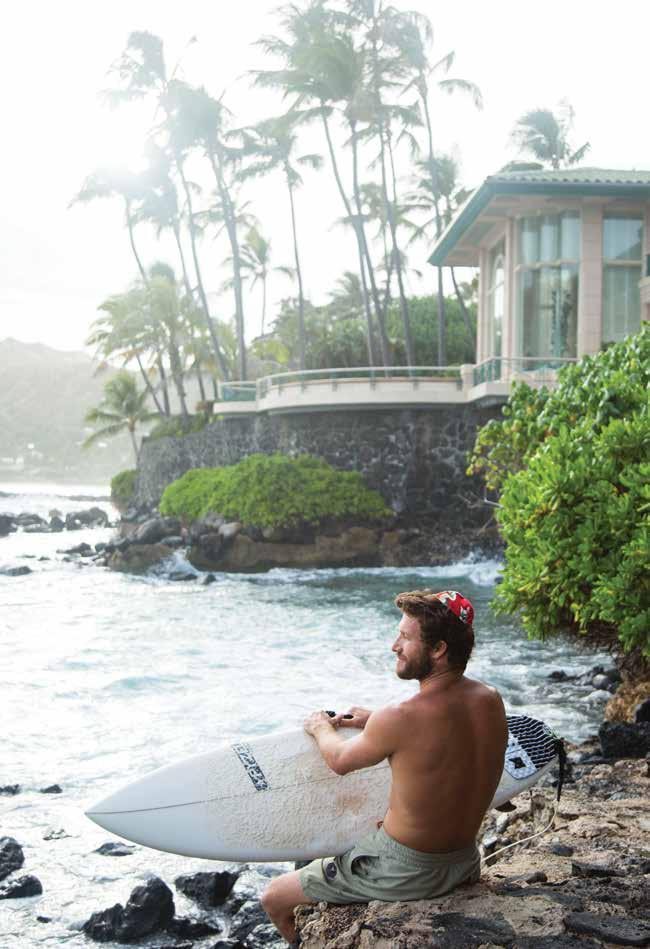
Stranger Than Paradise
In Waikīkī, the tourists and locals who populate its streets and beaches fashion an odd and endearing reveal.
PHOTOS BY @MISTERVER
The iPhone photographer @misterver has built an audience on observing audiences. Anonymously handled, the Instagram account treats its 40k followers to a mishmash mosaic of local life, where unsuspecting people and patterns interplay in its pixelated purview of the islands. Bystanders, from beachgoers to bridesmaids, are often found under this spectator’s gaze and routinely make for quirky and original compositions that are more focused on how throngs of people find their way to the beach rather than the beach itself. In a technological age where everyone is equipped with a camera phone, this transfixed attention to the islands’ hustle and flow, and how it manufactures the destination itself, is refreshing.
Because, if we can speak candidly, the photos of Hawaiʻi that saturate social media are boring. Incredibly, gorgeously, immersively boring—the same summit ridge conquered, the same silhouetted palm trees burning through the days’ inevitable sunsets. What is funnier, then, is that Waikīkī, real estate many are quick to scoff at for its sterilized “sameness,” is apparently rich with surprising scenarios of colors, textiles, and poses under @misterver’s discerning lens. In the following images, squarely set in the tourism capital of Hawaiʻi, @misterver snapshots both cater to and subvert one’s expectations.
— Matthew Dekneef
FLUX FEATURE 112 | FLUXHAWAII.COM
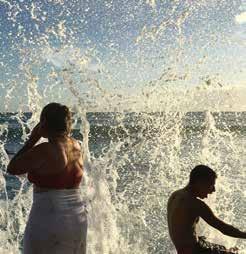
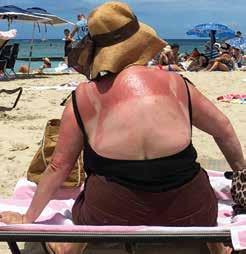
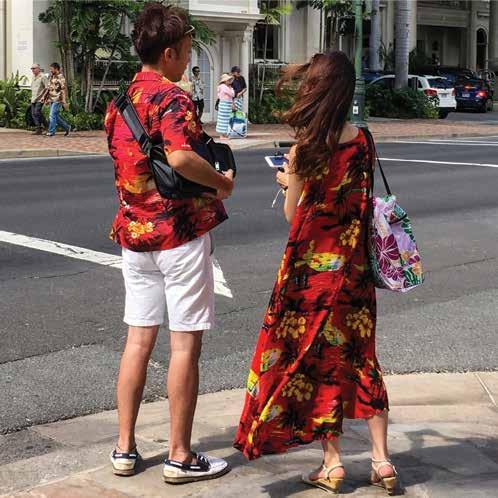 #shotoniphone
#shotoniphone
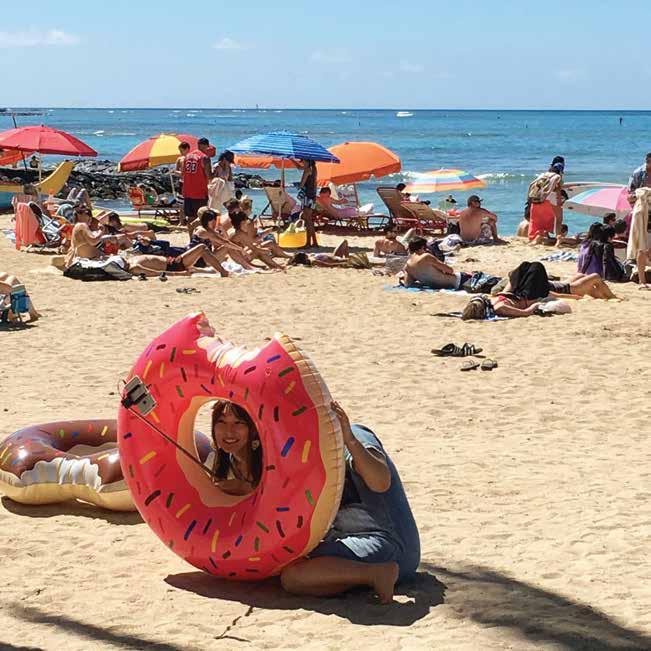
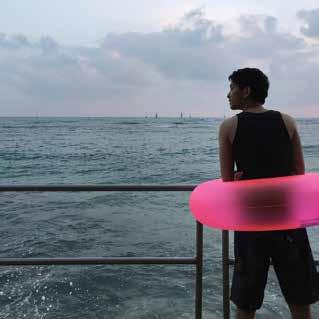
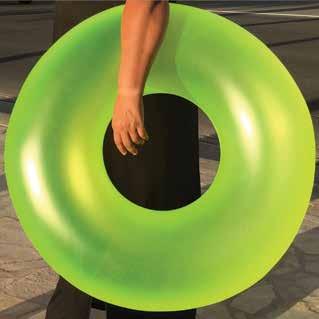
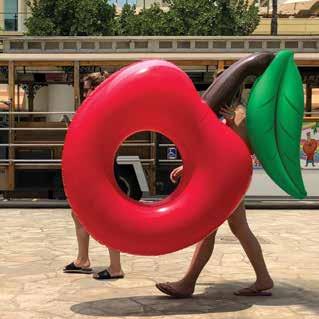

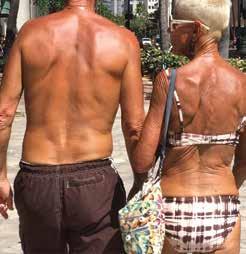
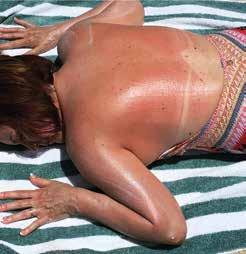
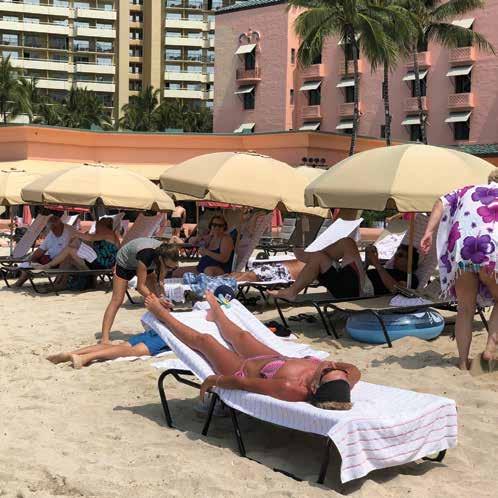
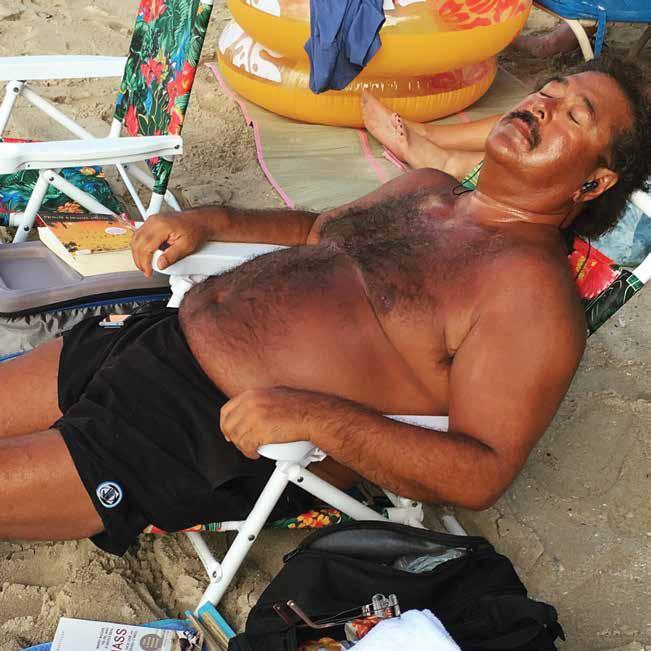
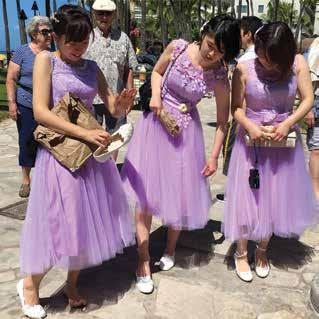
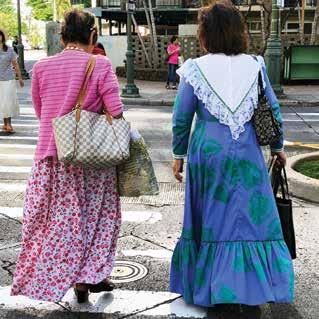
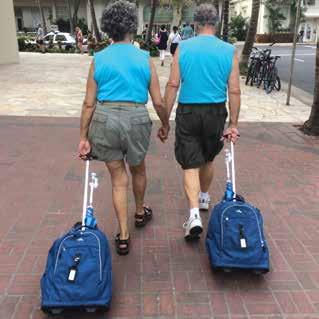
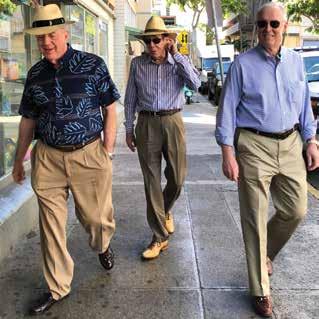
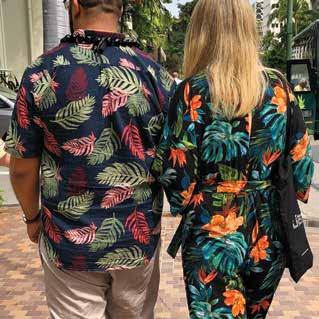
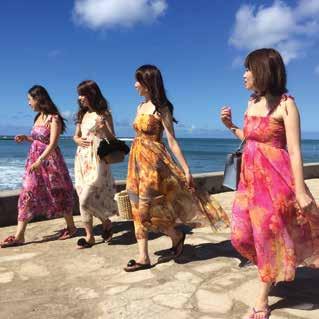
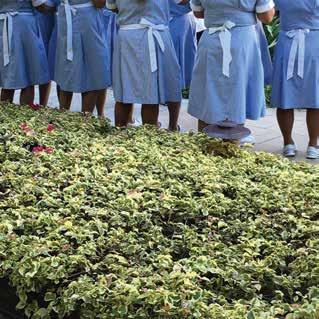
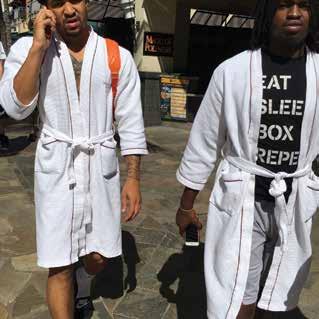
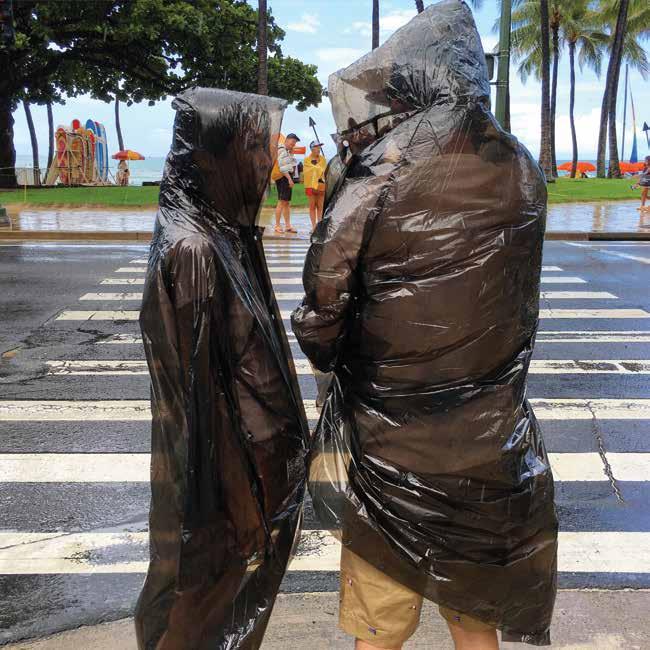
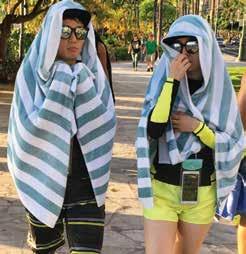
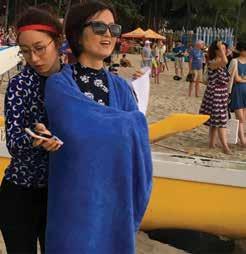
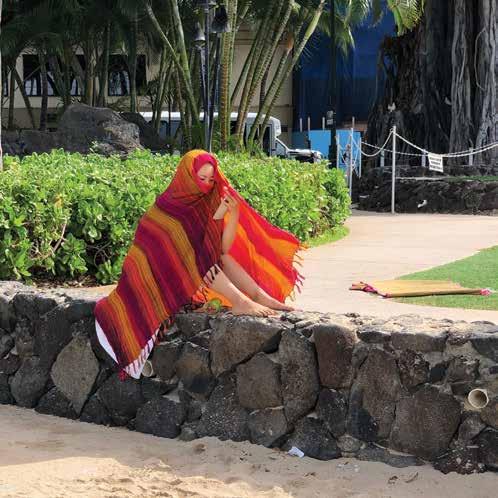
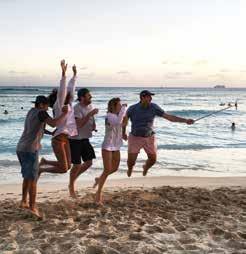
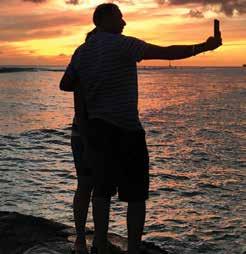
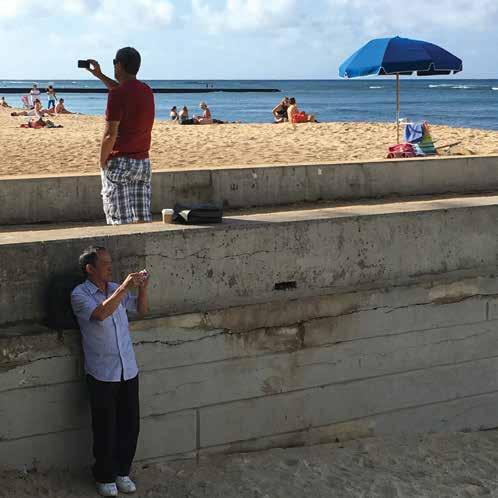
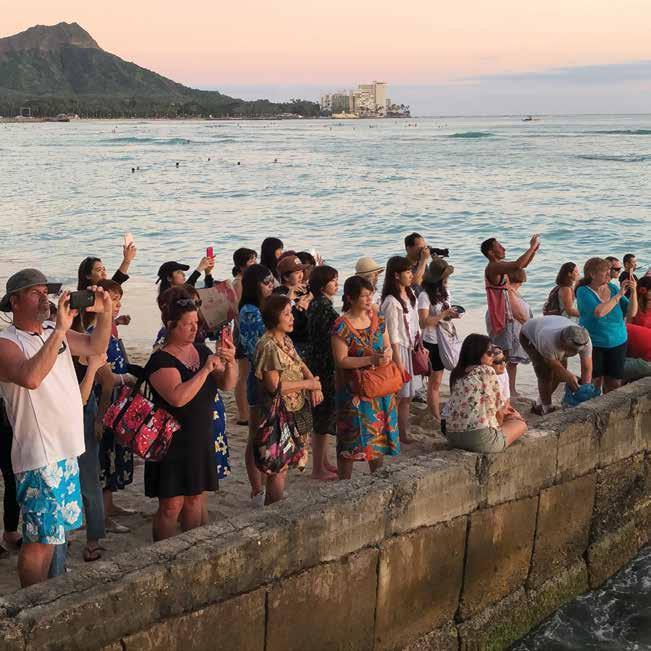
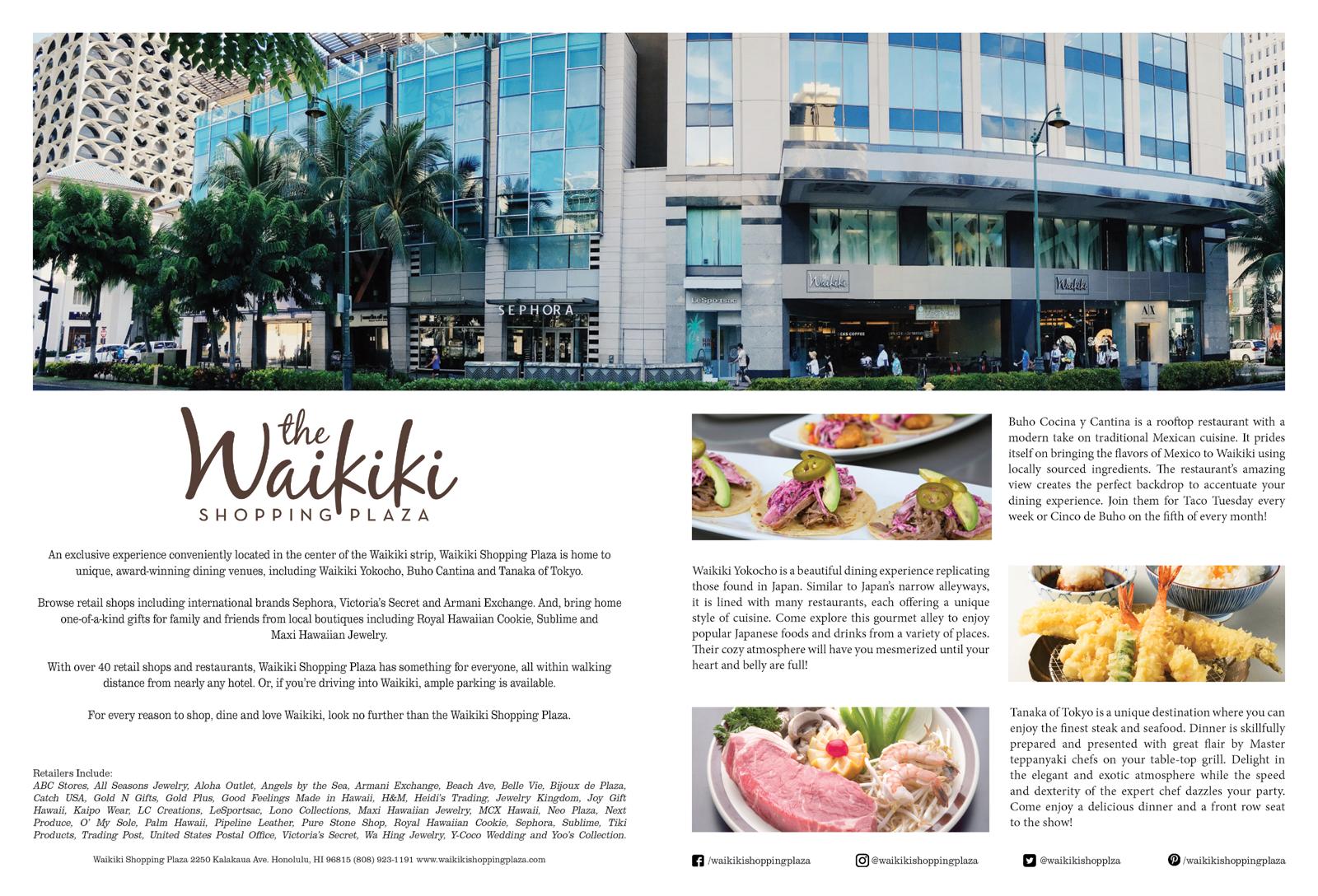

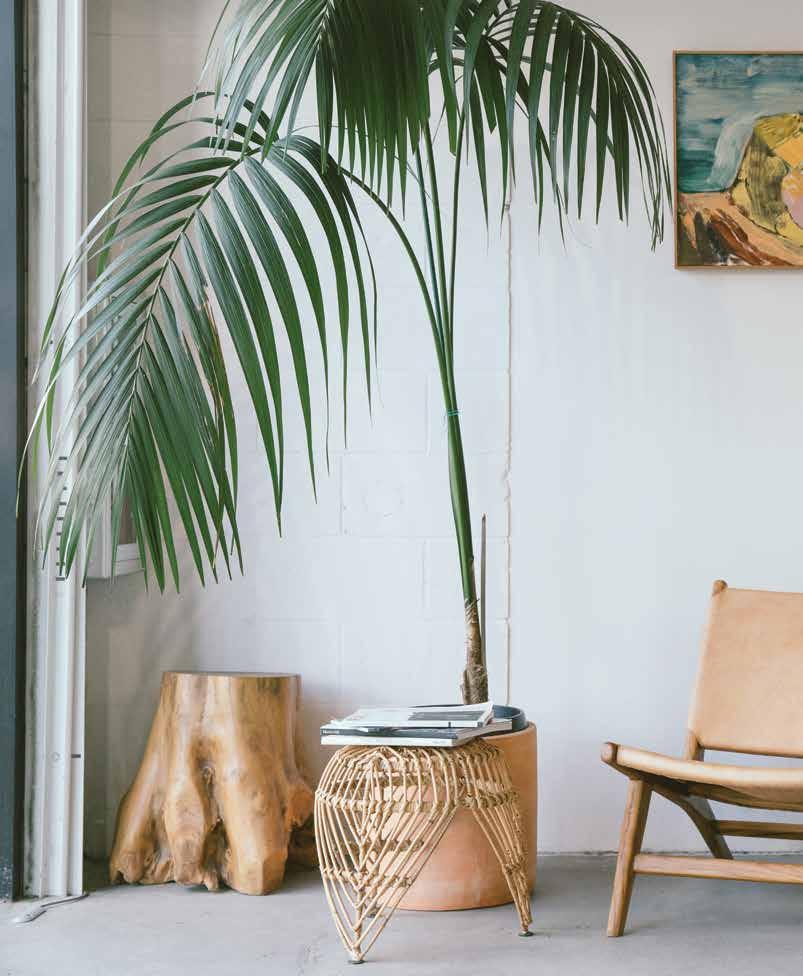 Here boutique in Kaka‘ako. Image by Kainoa Reponte.
Here boutique in Kaka‘ako. Image by Kainoa Reponte.

SPECIAL SECTION: KAKA‘AKO
“Kaka‘ako can be the internal inspiration for O‘ahu of what’s possible. It’s a source for incubation that can make the whole island become better.”—Shawn Boyd
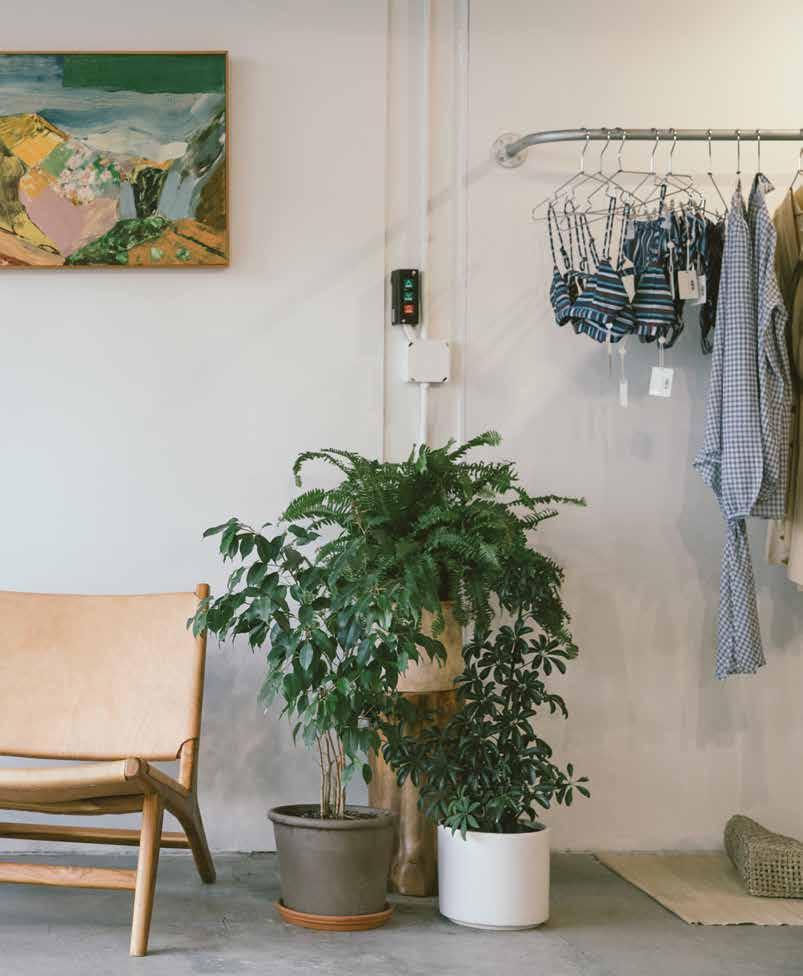
Salt of the Earth
Living, working, and walking in the growing neighborhood of Kaka‘ako reveals the energy found in the local community.
TEXT BY LISA YAMADA-SON
IMAGES BY KAINOA REPONTE & IJFKE RIDGLEY
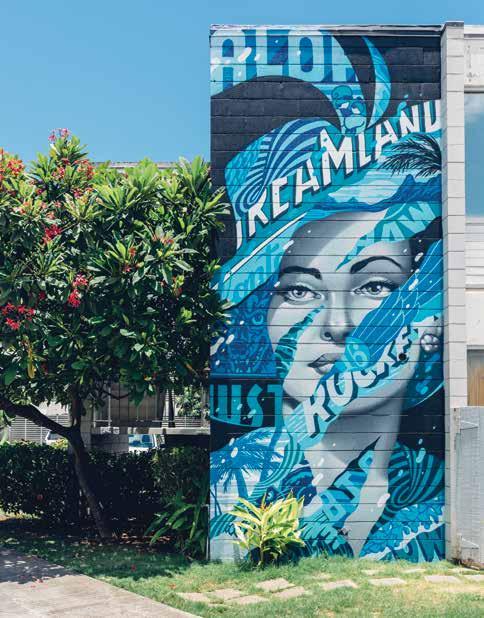
I never understood the benefit of the whole walkability thing until I lived in a neighborhood that was actually walkable. I grew up in the hilly suburb of ‘Aiea Heights, where steep inclines were great for working out calf muscles, but much less so for playing ball with friends, trickor-treating, or attempting to ride anything on wheels. In ‘Aiea, the car was your ticket out.
I moved to Kaka‘ako in November 2017 after buying—with the help of my parents—a twobedroom, two-bath unit at 801 South Street, a workforce housing condominium that sits near the site of the former Honolulu Advertiser building. With a walk score of 91 out of 100, Kaka‘ako is the second most walkable city on O‘ahu, according to Walk Score, a site
Kaka‘ako has been an industrial center since the 1970s, and today it remains a burgeoning community powered by small local businesses.
128 | FLUXHAWAII.COM
SPECIAL SECTION | KAKA‘AKO |
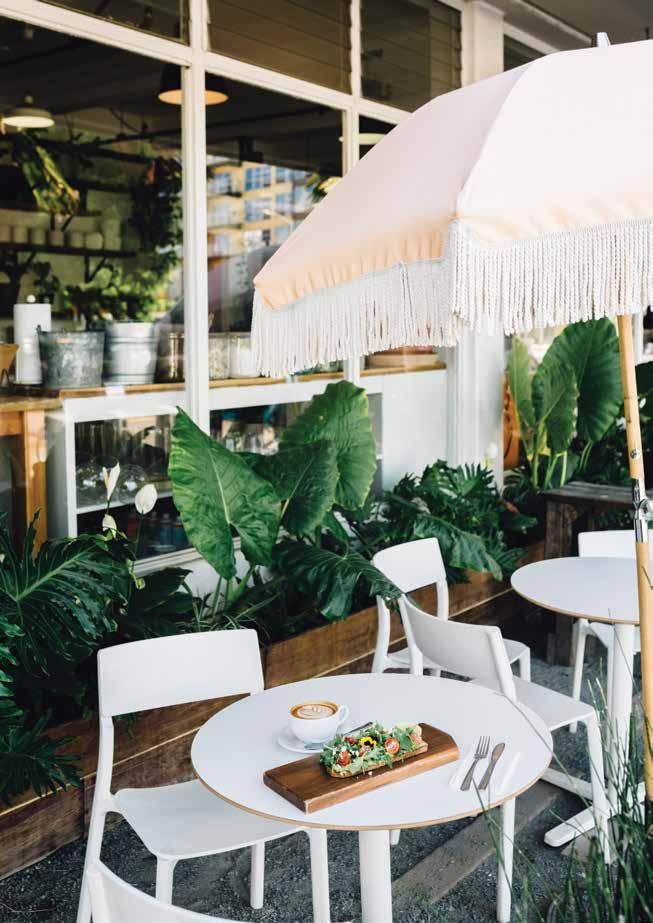
129

that measures the value of a particular neighborhood based on its proximity to nearby amenities. From where I live, it takes a mellow 20 minutes on foot to get to Chinatown, where I work, a stroll that helps get my blood and brain pumping. (I even outlined half this article in my head on a walk home one day.) Ala Moana Center and the movie theater at Ward Village are also a quick walk or Biki ride away. An evening dog-walking routine with my 6-year-old bichon frise, Luffy, often involves a romp through Mother Waldron Neighborhood Park, a stop at Bill Reardon’s Heavy Metal Hawaii shop to visit with his dog, Buddy, and dinner outside at one of our favorite spots: Pioneer Saloon or Down to Earth.
Though I am a recent addition to the neighborhood, I have closely watched Kaka‘ako grow over the past five years. Between 2013 and 2016, my company, Nella Media Group, worked with Kamehameha Schools to publish Foundry, a quarterly journal that documented the burgeoning community they were building. Helmed by Christian O’Connor, Kamehameha
Schools’ former senior asset manager, the development of Kaka‘ako was intended to create a gathering place for what developers deemed the “digital explorer.” Its scrappy start fomented businesses that were experimental and exciting. There was Mark Noguchi’s Taste Table, which featured rotating pop-up restaurants like Onda Pasta, Miso and Ale, and The Pig and the Lady. This is where I first remember being blown away by Wade Ueoka’s mochi-crusted snapper over somen noodles, a dish that would later become popular at his fine-dining establishment, MW Restaurant. There was art organization Interisland Terminal’s R&D bookstore, a welcome sight after the island-wide closure of Borders Books and Music locations, where you could enjoy a cappuccino from Morning Glass Coffee while browsing a finely curated selection of books, magazines, and art. There were the parklets, built beautifully by Ian Eichelberger—the first to have been approved by the city—that took over the parking stalls fronting the old location of Hank’s Haute Dogs.
Owners Yuki Peterson and Mayo Kawamura fill their Auahi Street boutique, Here, with womenswear and accessories perfect for Hawai‘i’s balmy weather.
130 | FLUXHAWAII.COM
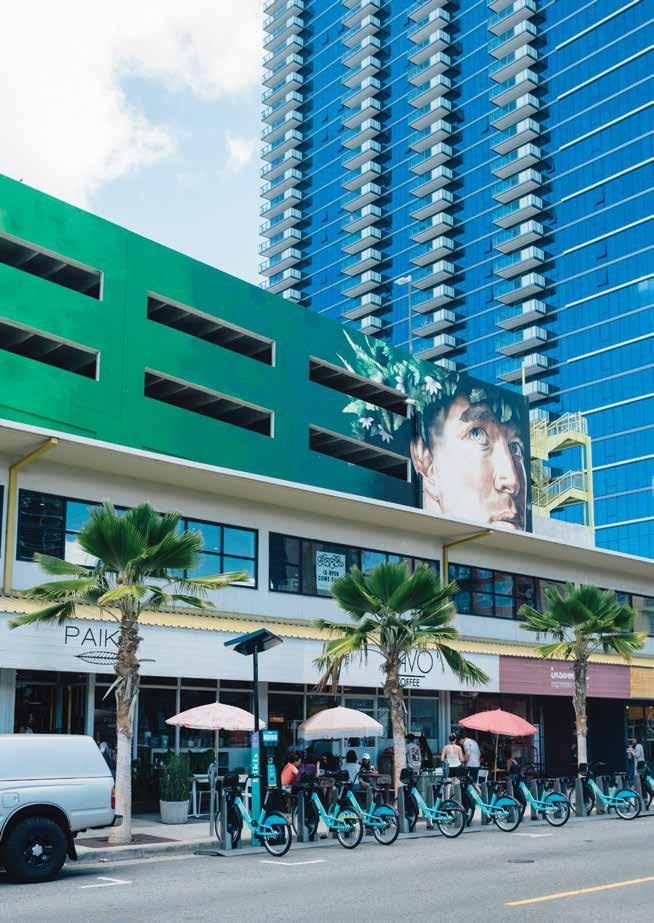
131
There was also Paiko, which made tropical florals a thing before they became a trending hashtag around the world. Then Bevy arrived next door, turning the sports bar Scores, known for its cheap shots and dartboards, into a refuge for lovers of craft cocktails lit warmly by Edison bulbs, before Edison bulbs outfitted restaurants near and far. Christian Self says that since he opened Bevy in 2013, the most rewarding aspect of working in Kaka‘ako has been being surrounded by like-minded people, “people who are trying to break from conformity and who have a similar artistic approach to how they do things.” Both Paiko and Bevy remain neighborhood mainstays. Although there was a spirited energy that permeated Kaka‘ako and bonded these early pioneers, there were fears about the future, too. Plots of land were sold to residential developers like Alexander and Baldwin, Castle and Cooke, and
Down to Earth, which opened a 13,000-squarefoot market in mid-rise development Keauhou Lane, is one of the writer’s frequent dinner stops.

132 | FLUXHAWAII.COM

Stanford Carr, leading to whispers about if Kamehameha Schools’ master plan would take into account the needs of Hawai‘i families or instead give priority to overseas luxury buyers. Residents also questioned the capacity of the area’s sewage system and speculated that old pipes would be overwhelmed by the increase of residents. (The lingering smell of sewage only exacerbated these fears.) Business owners displaced after being in the area for decades protested being kicked out. Owners of new businesses wondered if and when they too would be forced to leave, if commercial rental prices would suddenly be raised to a level they could no longer afford.
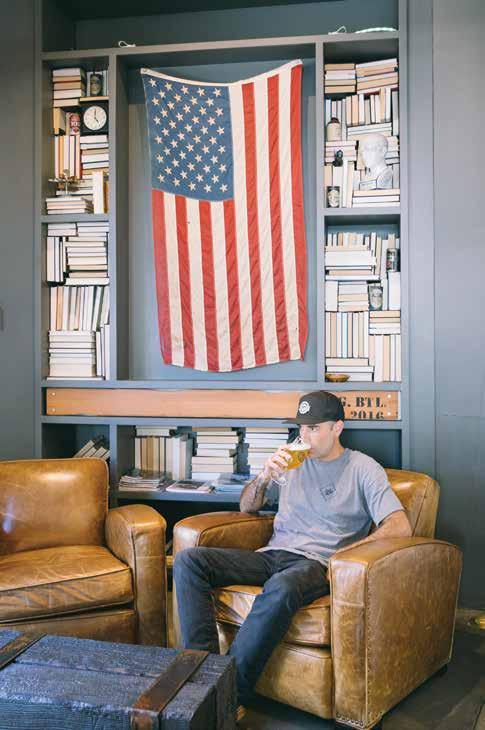
134 | FLUXHAWAII.COM
Tim Golden of Village Bottle Shop has hosted film swaps with camera shop Treehouse and served beer ice cream float pairings with Butterfly Ice Cream.
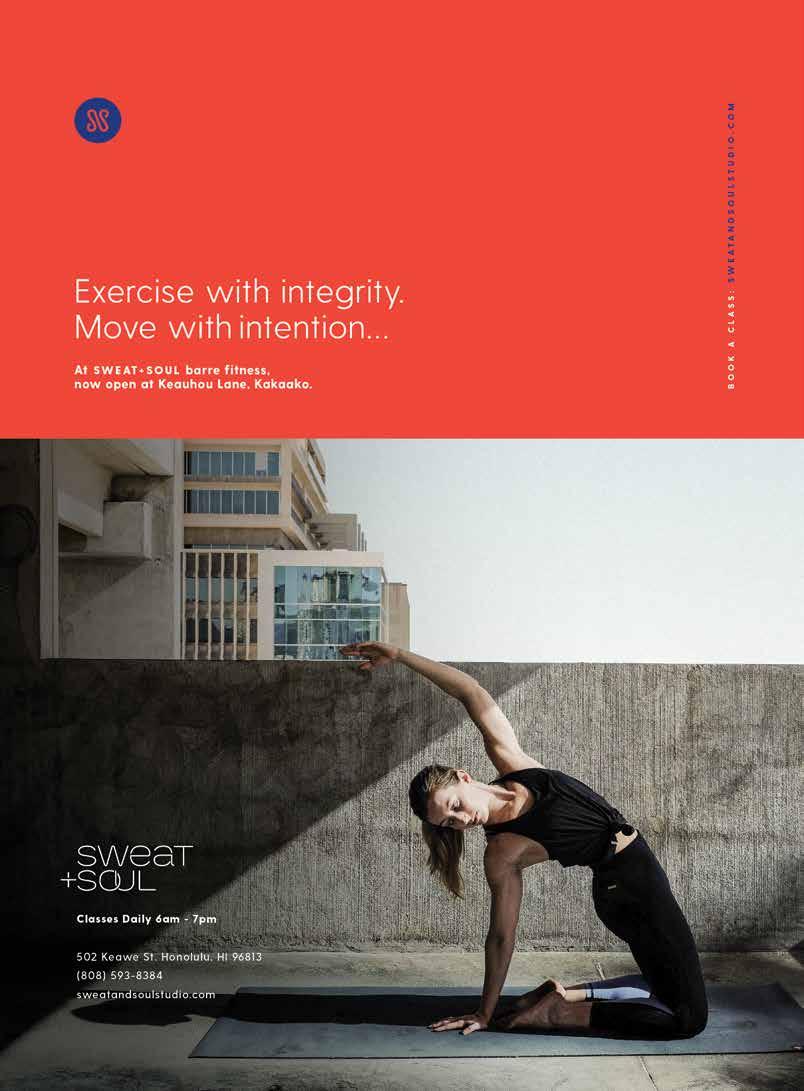
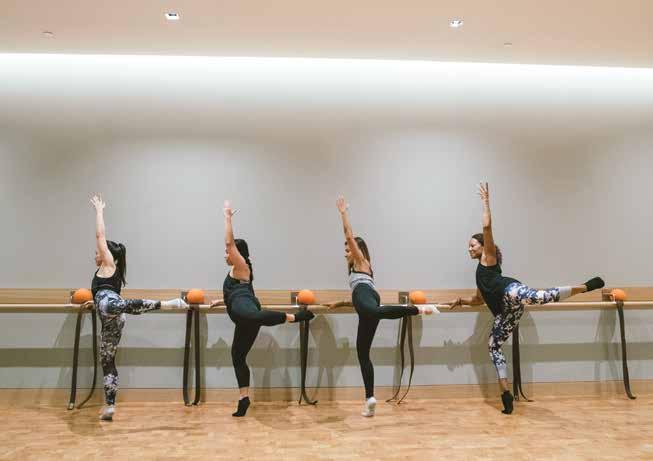
All too often, the big, bad G-word, gentrification, was thrown around. “But people gotta remember,” says Shawn Boyd, who ran The Greenhouse Innovation Hub, a co-working space for Hawai‘i’s tech community, in Kaka‘ako from 2011 to 2013, “knocking down a building does not gentrification make. There’s a stigma with the word gentrification, that it’s the idea of moving people out. But who lived at Comp USA, who lived at the newspaper [building], the Eat the Street parking lot?”
Growing up, Boyd’s parents ran Video Life, an electronics store in Coral Community Plaza on Auahi Street, so he has seen the change that the neighborhood has gone through over the last 20 years. He and his friends used to call the area “Cracka‘ako” because of the vagrants who roamed the streets. He remembers finding his parents’ company van broken into and littered with drug needles, the empty boxes from big screen TVs stolen for use as shelter, he surmised.
Still, Boyd, who ended up buying a onebedroom, one-bath unit at One Waterfront
Towers in 2007, has always loved Kaka‘ako. To him, it is a place that represents the independent spirit. “When it was ugly, we grabbed spray cans, and now those buildings with murals on them are part of the foundation of the neighborhood,” he says, referring to the rise of international street art festival Pow Wow Hawai‘i. “People didn’t take no for an answer. Kaka‘ako was a way for people to realize that we can do it ourselves.”
This resourceful spirit has been a part of Kaka‘ako’s cultural makeup since pre-contact times, when the area was a flourishing center for pa‘akai, or salt production. After contact, the process was commercialized and much of the salt was exported to the Pacific Northwest. Even after the decline of salt production in the 1880s, Kaka‘ako remained an industrial center through the 20th century, becoming home to companies like Walker Mill, the second largest rice mill on O‘ahu; various bottling companies, including Honolulu Brewing and Malting Company, the original maker of Primo beer; Honolulu Iron Works,
The second most walkable city on O‘ahu, Kaka‘ako has many options for living a healthy lifestyle. Found within the neighborhood is Sweat and Soul, which offers barre workouts that challenge all levels of fitness.
136 | FLUXHAWAII.COM

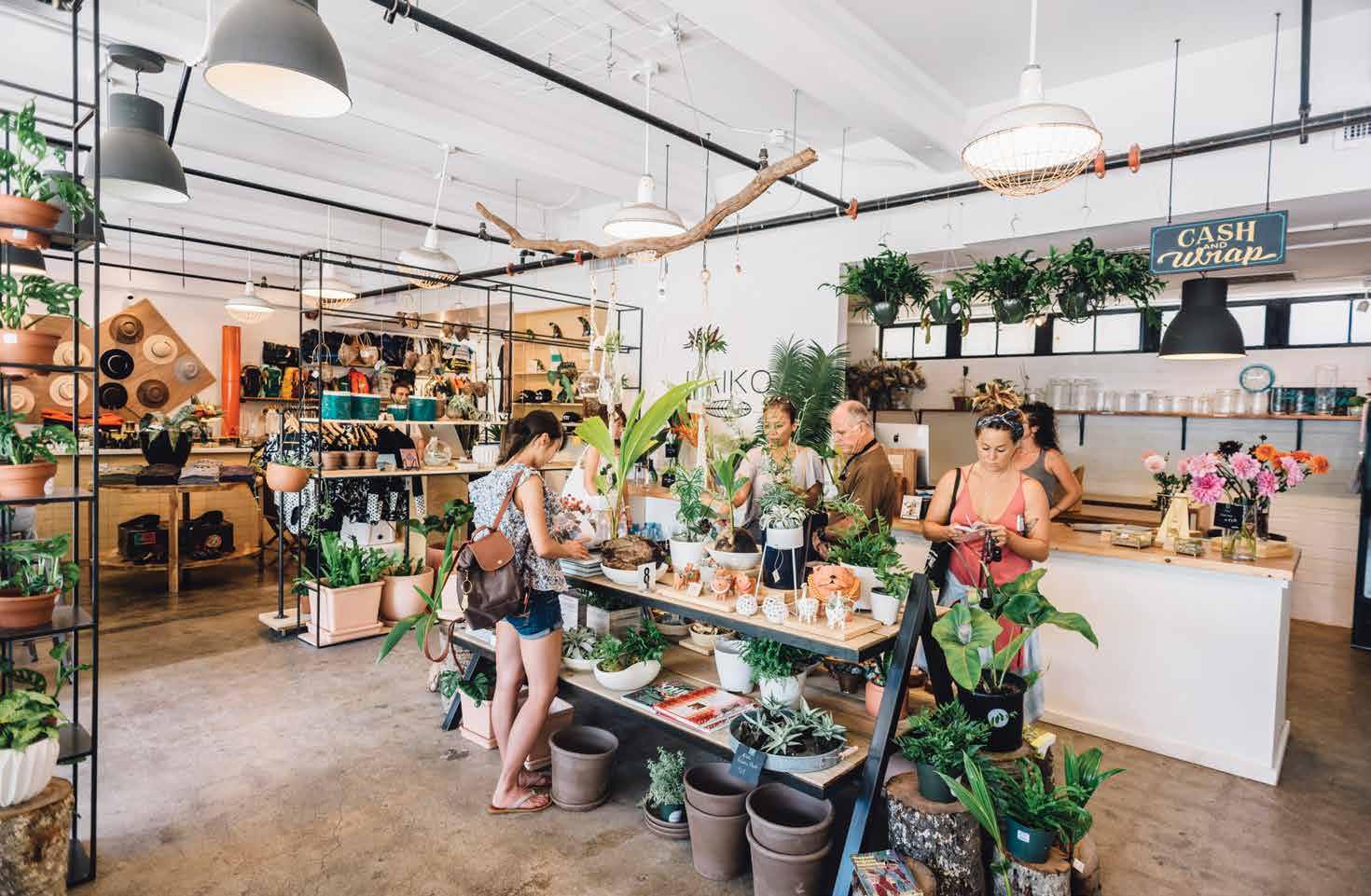

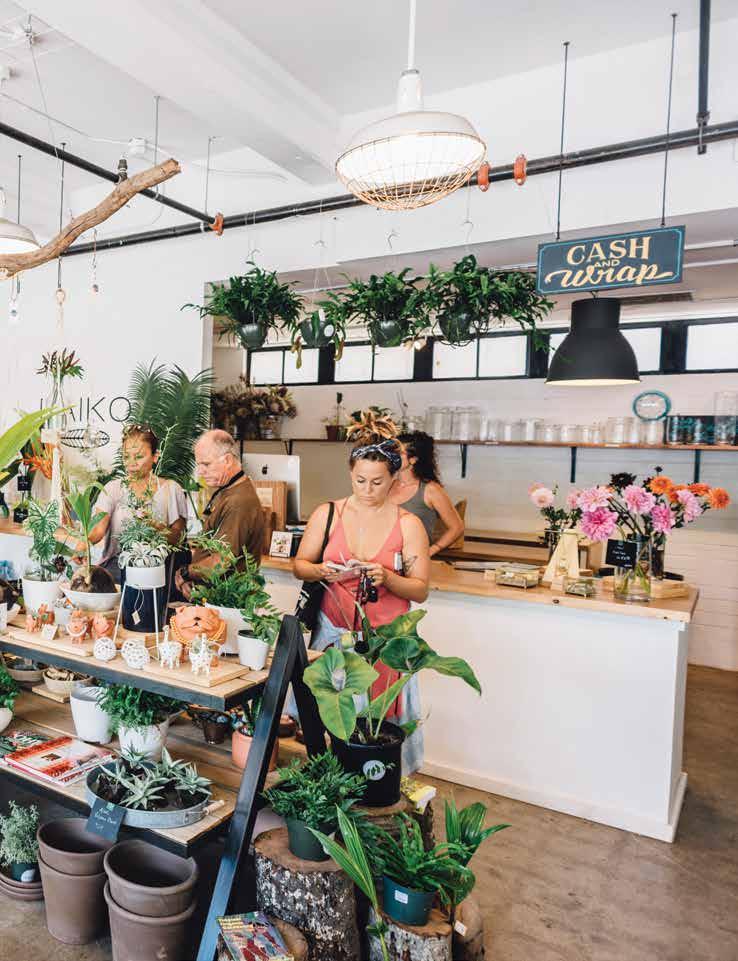
which manufactured machinery for the islands’ growing sugar mills; and the McFarlane Tuna Company, which canned the growing catches of fishermen that operated out of Kewalo Basin Harbor. By the 1970s, more than 20,000 people, or about 8 percent of O‘ahu’s total labor force, were employed in the area, according to a 1979 Honolulu Magazine article by Brian Nicol. “[Kaka‘ako is] where the people gathered, because this is where you had occupations, fishing, docking, and freight,” said Louis “Buzzy” Agard, who fished in the Kaka‘ako area for 75 years, when he was interviewed for a cultural impact assessment by Cultural Surveys Hawai‘i for Kamehameha Schools. “And people just kept coming. They saw the sights, and a working community.”

140 | FLUXHAWAII.COM
Bill Reardon of Heavy Metal Hawaii with his dog, Buddy.
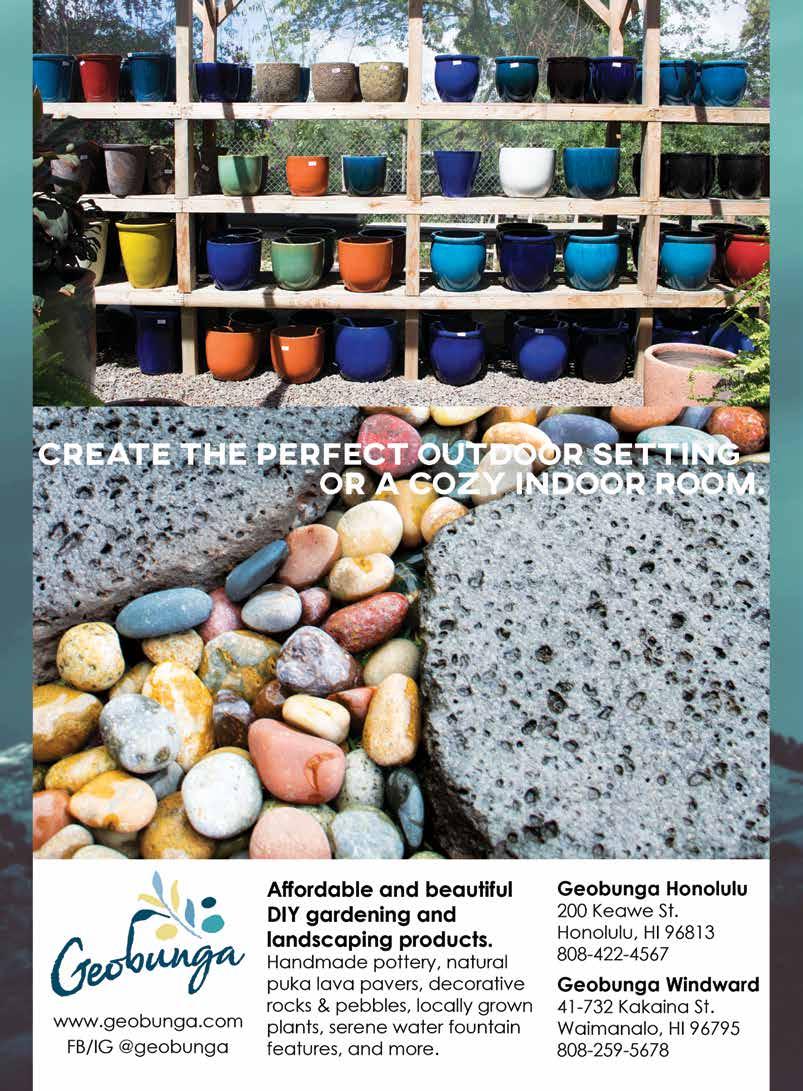
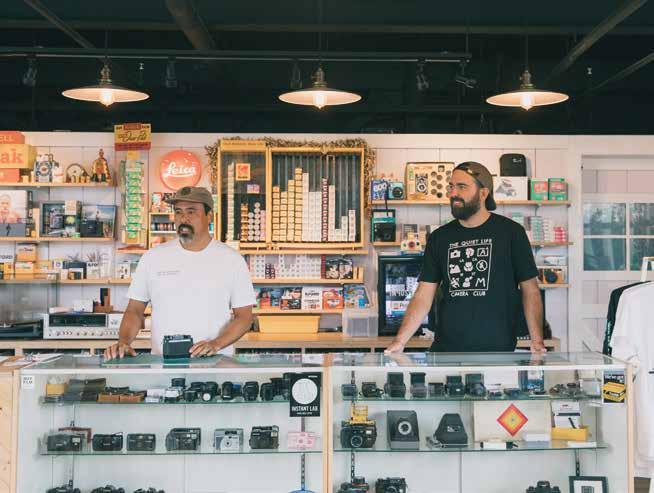
This picture is not far off from what the neighborhood looks like today. “Kaka‘ako was something the city needed, which is an interesting urban community that’s walkable, youthful, vibrant,” says Tim Golden, the co-owner of Village Bottle Shop and Tasting Room. “There’s an energy and positivity, and people are excited to be here.” Despite growing up in and commuting from Waialua on O‘ahu’s North Shore, Golden could not pass up the opportunity to open a shop in the newly constructed Salt at Our Kaka‘ako space. He credits Honolulu Beerworks owner Geoff Seideman with paving the way for the nearly half-dozen breweries and bottle shops that have turned Kaka‘ako into a destination for beer lovers. “Geoff took a huge leap of faith opening here,” says Golden, whose business stocks anywhere between 500 to 600 beers and features 18 beers and eight wines on tap. “Beer is a common drink that brings people together. You drink it in garages, at the beach, and
Salt spoke to that. It’s a cool community of small business owners who put their [livelihoods] on the line to open something they’re passionate about.”
Similar to the resurgence of the Honolulu neighborhoods of Kaimukī and Chinatown, much of the growth in Kaka‘ako has been powered by small local businesses. “I always loved the back streets, like Sausalito in California or Roppongi in Japan, before it got developed,” says Jake Mizuno, owner of Stoke House, a surf boutique at Salt, and Milo, a lifestyle boutique that shares a space with Paiko and the popular café Arvo. “I have been watching [Auahi Street] for 20 years, and the way this street grew, everything happened so organically. This is a store with my friends and family and a store that has a story behind it. It wasn’t manufactured.” In addition to his career in commercial real estate, the 51-year-old was responsible for opening Roxy and Quiksilver stores across Hawai‘i. After opening nearly 30 stores in Hawai‘i, Mizuno calls his
142 | FLUXHAWAII.COM
Bobby Asato, left, is the owner of Treehouse, which opened at Salt to continue to serve the analog film community.
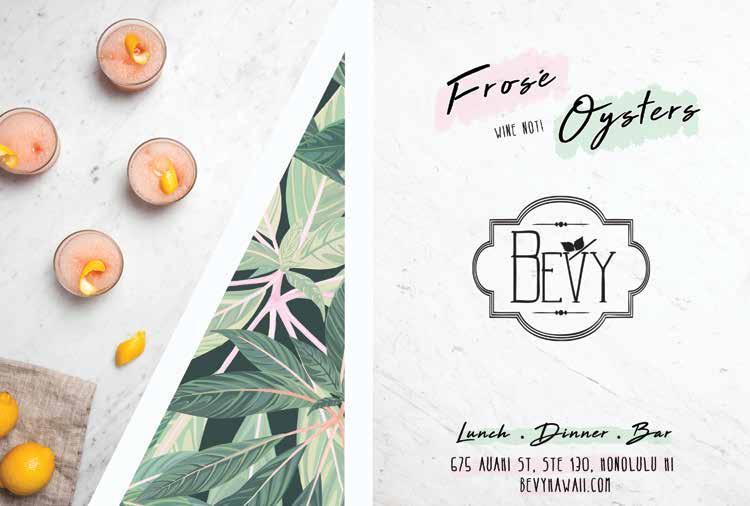
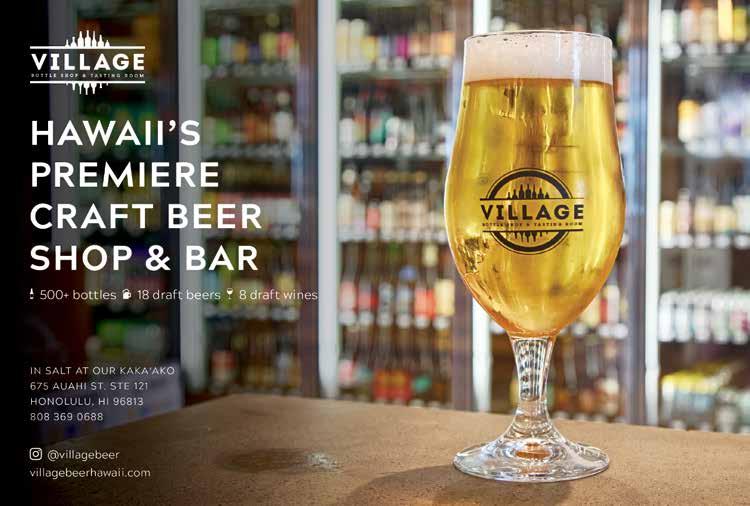
Kaka‘ako stores the best projects he has worked on. “There are so many young people stimulating my brain,” he says.
Like any growing urban area, Kaka‘ako is not without its share of issues. The beating of two Japanese tourists in the bathroom of Mother Waldron Neighborhood Park in May 2018 stoked concerns about homelessness in the area. Ironically, it was actually homeless people who were living in the park that intervened on behalf of the tourists, Honolulu Police Department Deputy Chief John McCarthy told the Honolulu Star-Advertiser, and their description of the man who committed the crime that led to the arrest of a 20-year-old from the Windward side of O‘ahu.
Residents continue to navigate a complicated relationship with homeless communities in the neighborhood. But I
Drybar focuses on professional blowouts at a flat price. Customers can choose from a range of signature styles including the Mai Tai for beachy curls or the Manhattan for hair that is sleek and smooth.
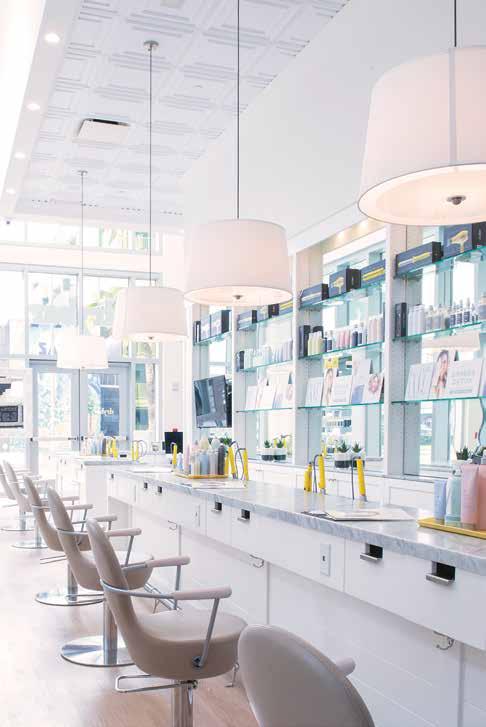
144 | FLUXHAWAII.COM
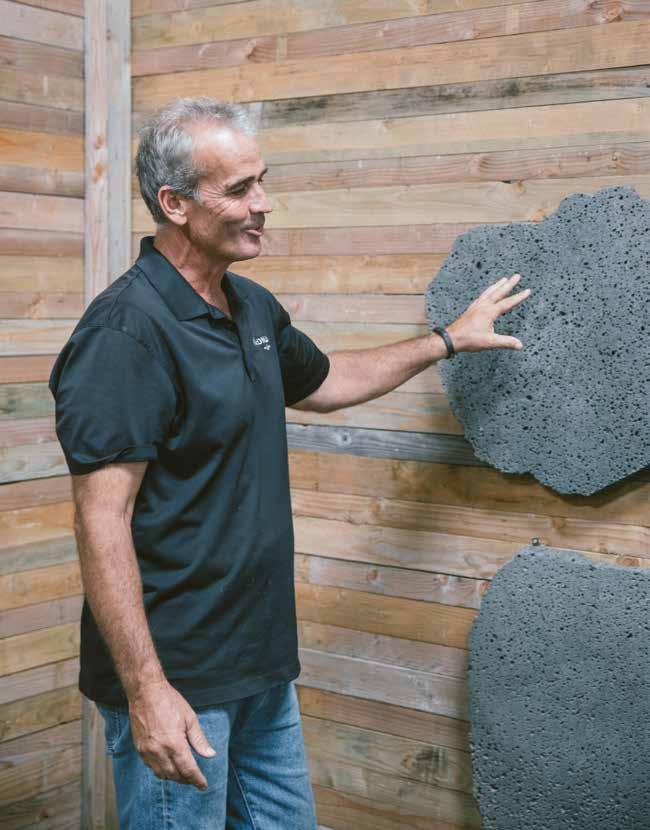
Andrew Dedrick is the owner of Geobunga, which helps green thumbs enhance outdoor spaces and specializes in decorative stone, ceramic pots, bamboo accents, and outdoor sculptures.
145
feel lucky to be a part of the tribe of people who call Kaka‘ako home, a neighborhood that has grown with us, as our businesses have developed, and as we’ve started families. Boyd points out that Eat the Street, the popular street food festival that began in Kaka‘ako in 2011, has grown from having monthly events with just a handful of food trucks to hosting festivals around the island with a rotating roster of hundreds of trucks. “Kaka‘ako can be the internal inspiration for O‘ahu of what’s possible,” Boyd says. “It’s a source for incubation that can make the whole island become better.”
Christian Self says that since he opened Bevy in 2013, the most rewarding aspect of working in Kaka‘ako has been being surrounded by “people who are trying to break from conformity and who have a similar artistic approach to how they do things.”
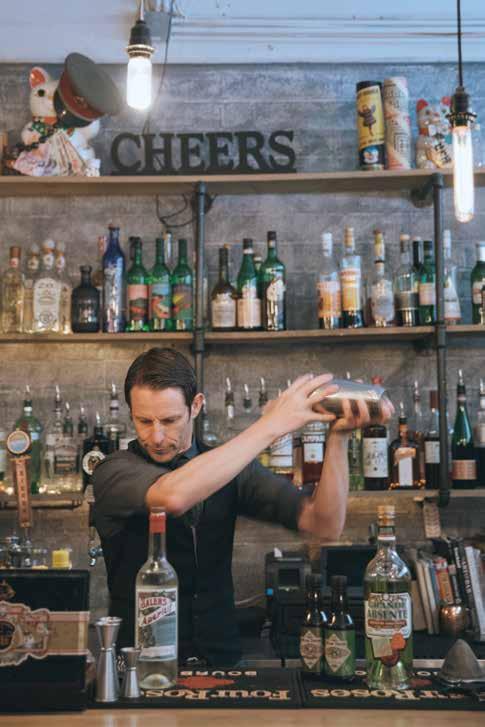
146 | FLUXHAWAII.COM
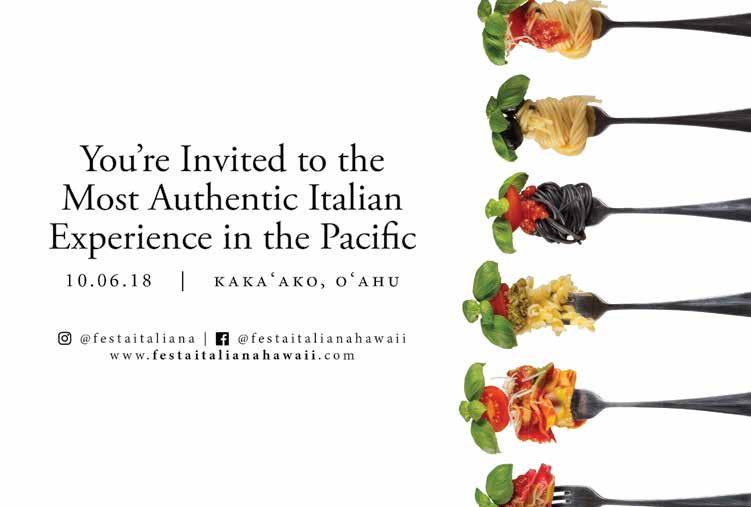
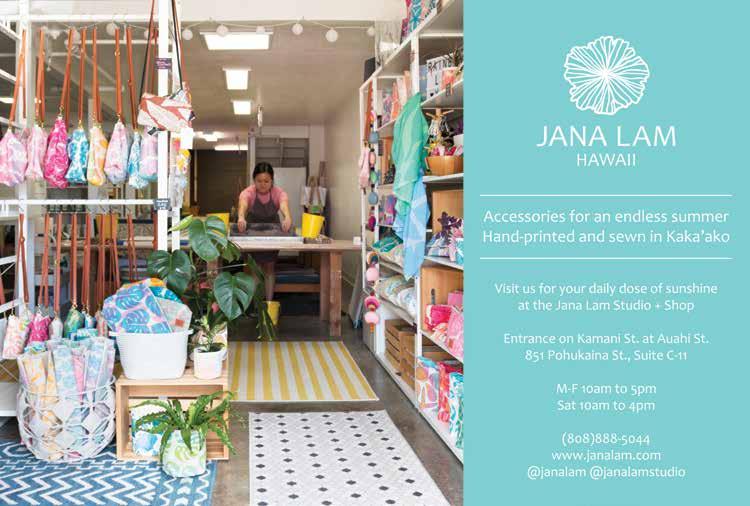
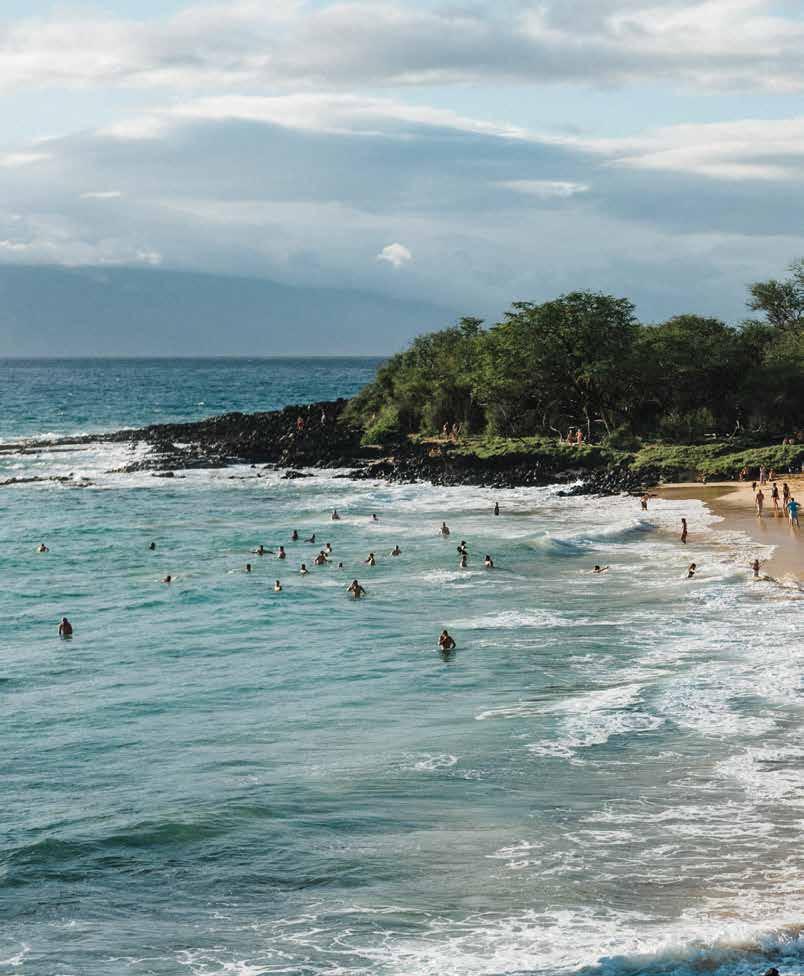 Beachgoers throw inhibition to the wind at Maui’s Little Beach. Image by John Hook.
Beachgoers throw inhibition to the wind at Maui’s Little Beach. Image by John Hook.
LIVING WELL
“I learned real fast that the less you care, the less others care. The problem nowadays is not others judging you, but you judging yourself.”—Zac Yurasha

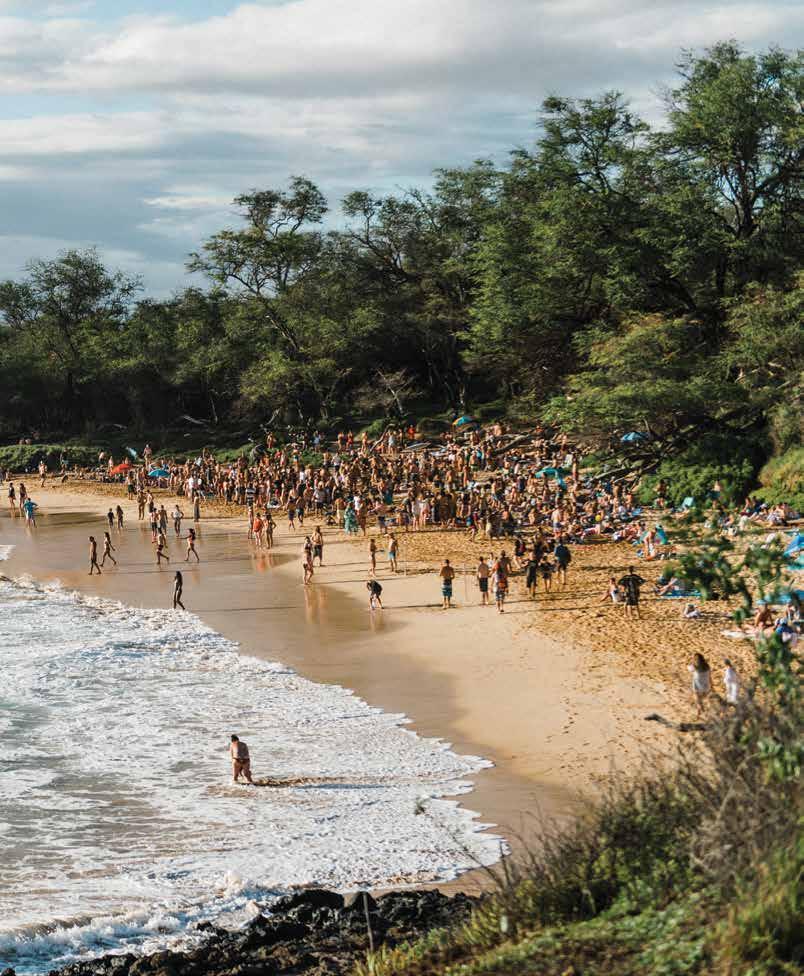
A Gentler Death
The one thing everyone shares in life is that some day it will end. Pāhiki Eco-Caskets wants to shape a final resting place that is environmentally friendly for all.
TEXT BY MATTHEW DEKNEEF
IMAGES BY JOHN HOOK
Like most people, Cortney Gusick never considered the prospect of purchasing a casket until she needed to select one for a family member. Eight years ago, her dad died from pancreatic cancer, and she was thrust into the death-care industry as a consumer. The most difficult part of making the funeral arrangements was finding the right casket. Gusick wanted something that reflected who her father was in his very full life: a Hawai‘i boy who cared about the environment and carried those values with him to Oregon, where he raised his three daughters. Ultimately, Gusick settled on a simple pine box from a small-scale, non-commercial business. “His body was going to biodegrade as it was designed to do, and it would provide some kind of nourishment for the earth,” Gusick says. She reasoned that the receptacle in which he was buried should do the same.
Common caskets are not earth-friendly. Nearly every model found in funeral home catalogs is manufactured with metal, paint, silicone, synthetic polyester fabric, and other non-biodegradable materials. That greener options aren’t readily available in the modern burial industry concerns Gusick, especially in a place like Hawaiʻi, where a reverance for one’s natural surroundings is part of daily life. After her dad’s death, she saw the metaphorical light at the end of the tunnel, and she came out the other side a casket builder. “This is what I want to offer for people,” she says. “For someone’s eco-legacy to be, ‘I did right by the earth.’”
Last year, Gusick started Pāhiki Eco-Caskets, a lowimpact, environmentally sound casket manufacturer, in the backyard of her Mānoa Valley home. The venture was a 180-degree pivot from her ongoing job at the Silicone Valley-based company UserTesting as a test engineer in the amorphous world of software and mobile applications. “I had zero background,” Gusick admits.
But the 37-year-old felt equipped for the intensely tactile field she was about to enter. “My dad taught his girls how to do everything, how to change our own tires, acid-strip a deck, lacquer the house’s wainscotings,” she says. She binged on online tutorials to gain a baseline knowledge of woodworking. “Between Dad and YouTube,” she says, “I felt like, ‘I got this.’”
Three months later, she teamed up with Logan Baggett, a friend she met in Oregon who had previously worked in Hawaiʻi’s solar industry, to help finesse Pāhiki’s offerings of 4- to 6-foot-long, 100 percent biodegradable caskets crafted from untreated, Hawaiʻi-grown wood. Soon after, the company attracted five investors and received a business loan from the Office of Hawaiian Affairs, which they used to buy hardwoods and build out inventory.
In Hawaiian, the word pāhiki means “to pass quietly, go lightly, touch gently,” a definition the duo strives to embody. Their caskets are made with reclaimed local albizia, monkeypod, mango, avocado, and Norfolk pine provided by Waimānalo Wood, a lumber mill that also houses their workshop. Pāhiki caskets range in price from $1,800 to $2,200 (less than the $2,400 median cost of a standard metal casket). In the circumstance that someone needs a keiki casket, Pāhiki provides it for a dollar.
Gusick considers every dimension of her industry. We’re trapped in a “death-denial culture,” especially in the United States, she says, which is obsessed with indefinitely preserving the deceased in ways that only benefit the living. For Gusick, the more grandiose style of caskets, which can cost upwards of $15,000, are more for the living than the dead. Those caskets “resemble pieces of high-end furniture that belong in this world, that belong in a house, and look like they’re meant to last over time,” she says. But the reality is they go into the ground, never to be seen again.
150 | FLUXHAWAII.COM
| DESIGN |
LIVING WELL
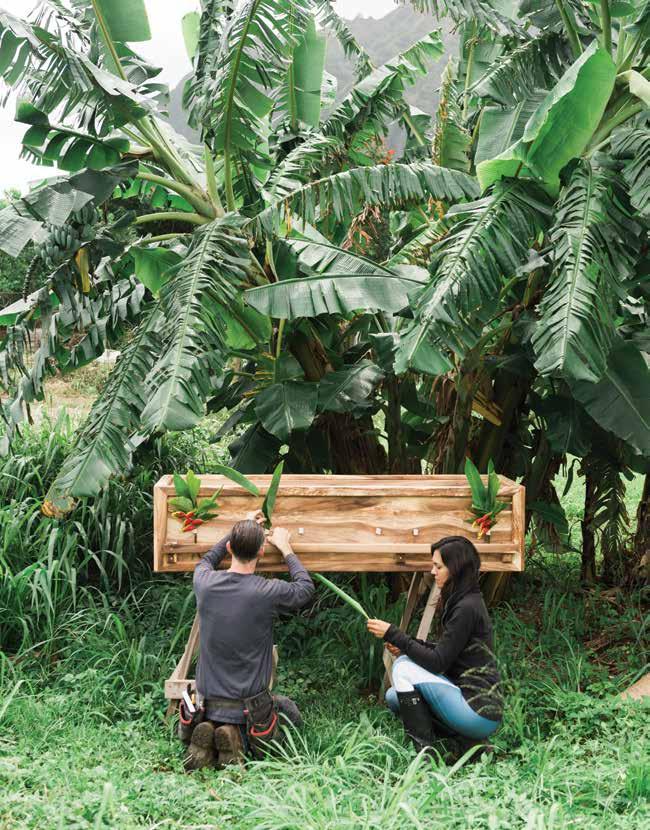
After her father passed away and she realized that eco-friendly casket options weren’t readily available, Cortney Gusick started Pāhiki Eco-Caskets, a low-impact, environmentally sound casket manufacturer based in Waimānalo.
151
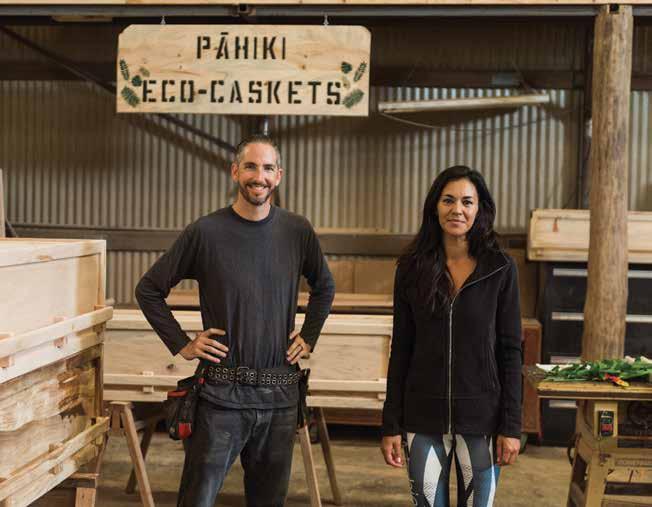
Pāhiki’s unobtrusive design aesthetic is in direct response to that. The final products—caskets that trade metal, paint, synthetic fabric, and lacquer for wood, nontoxic glue, muslin, and coconut-oil finishes—are crafted to allow the wood grain to shine in its most organic state. The caskets are stripped of sensational flourishes, but not of sentiment. Family members can opt to purchase the “collaborative option,” for which Gusick and Baggett affix biodegradable linen loops around the casket’s perimeter to hold flowers from funeral guests.
Pāhiki also has a keen interest in engaging with communities that have large Native Hawaiian populations on Oʻahu and neighbor islands. During community talk stories, Gusick presents information about Native Hawaiian burial rights and
practices—which involve cremating a body in an imu, wrapping the bones in kapa cloth, and burying them in lauhala—and how to perform them legally. As a Native Hawaiian, Gusick feels especially called to apply a Hawaiian understanding of ʻāina to her work. “Hawaiians were the original environmental stewards,” she says. “I can rewind back through so many generations of people where this was always their charge, to take care of the land, and now I can do it in a way that’s modern.”
As long as humans are dying, the death-care industry, which sees profits in the billions of dollars, will remain open for business. Pāhiki’s niche market is a fractional percentage of that, but it is poised to grow as an aging population becomes more informed of greener burial methods. While Pāhiki’s prototypes are evolving,
the emotional gravity of the caskets will always be the same. “Isn’t it so crazy that we’re responsible for this thing that is so intimate for a person we’ll never meet?” Gusick often thinks. “We’ll never get to look into their eyes, never get to shake and touch their hand. It’s this very special, unique thing that will only be crafted and given to them once.” It’s a heavy order, but Pāhiki hopes to treat it lightly.
152 | FLUXHAWAII.COM
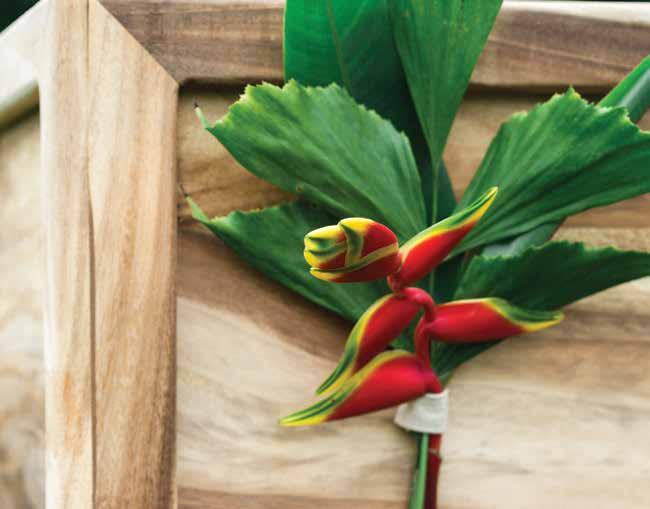
ABOVE GROUND
People who work in the death-care industry bring the lessons they learn in the field into their daily lives in quiet but profound ways. Here is what Gusick and Baggett have learned from the dead about how to live better every day.
Be introspective:
“Most people should contemplate death; it shouldn’t be an afterthought,” Baggett says. “We know it’s coming, we know it’s part of life—it’s just a transition, in my eyes.” Thinking about death and removing its negative connotations can lead to a more present and purposeful approach to life.
Be clear about your wishes:
“Documentation is an act of love,” Gusick says. “Put it in writing and in thoughtful detail.” The way you live isn’t always enough to let loved ones know how you want to be buried.
Be nice:
“There are 20 million things I don’t know about a stranger, but there is one thing I can guarantee I know about them and that they know about me,” Gusick says. That is the inevitability of death. “In society, you can quickly and easily dehumanize another person in the way you talk about them off-handedly or the way you treat them, not thinking back to that completely timeless experience you know you share with that person. If you reverse-engineer that awareness when you interact with people, you can use it to make a kinder, more insightful connection with someone. Or, you know, just try to not be a jerk.”
Pāhiki’s unobtrusive aesthetic results in caskets that trade metal, paint, and lacquer for wood, non-toxic glue, and a coconut-oil finish.
For more information, visit pahikicaskets.com.
153
WELLNESS |
Dare to Bare
On Maui’s south shore, beachgoers revel in a community where conservative mores are needed as much as clothes are: not at all.
TEXT BY RAE SOJOT
IMAGES BY JOHN HOOK
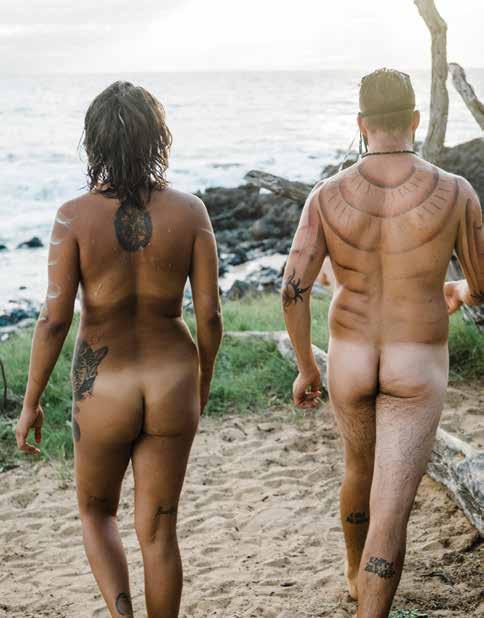
Heading north beyond an outcropping of lava on Maui’s Mākena Beach, intrepid beachgoers follow a well-trodden path to a craggy, windswept bluff. Below, in a secluded cove, a halcyon scene unfolds: Throngs of people cavort in the glittering haze of late afternoon. Out in the water, bodysurfers glide onto incoming swells, while on the sand, people sing and dance, mingle and lounge. A drum circle studded with a tambourinist and a couple of loose-limbed men wielding maracas supplies a heady tempo to a crowd eager to groove. Nearby, a bearded gentleman armed with an assortment of paints applies deft strokes of color to a woman’s shoulders. Onlookers murmur in delight as her body transforms into a living, curving canvas. Further away, a pair of 20-somethings hula-hoop
For decades, Little Beach has been a nude-friendly, paradisiacal enclave for kama‘āina, tourists, and transplants alike.
154 | FLUXHAWAII.COM
LIVING WELL |
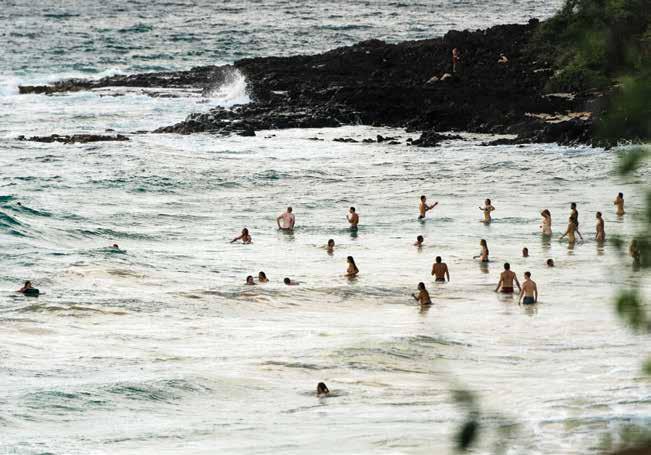
at the water’s edge, their peals of laughter infectious. Oh, one small detail: Many of these people are nude. Welcome to Little Beach.
Baring it all on Hawaiʻi’s beaches is mildly controversial. Titillating fodder for debate, it beckons, baffles, or bothers, depending on who you ask. However, the cultural and historical irony of the issue is not lost on Richard Spacer, the president of Kauai Naturists, a social and political action group that supports a clothing-optional lifestyle. For nearly a millennium, Hawaiians donned little in terms of apparel: Women wore pāʻū (skirts) and men wore malo (loincloths) crafted from ti leaf or kapa, pounded bark cloth. If not wearing kapa kīhei (shawls or capes), both genders went about bare-chested. But with the first influx of Christian missionaries in the 1820s came Puritan mores. As Western influence rose in the Hawaiian Islands, conservative standards of dress and decorum also increased.
“It was an invasive religion,” Spacer sighs, lamenting that nearly 200 years later, traces of Puritan mentality remain woven into Hawai‘i state laws. Today, Spacer helps those who are curious understand the intersection between Hawaiʻi’s obscenity laws and nudity on its beaches. He makes key distinctions: Going topless is not nudity regardless of gender, nor is it prohibited in the Hawai‘i Revised Statutes, since its indecent exposure law refers only to genitals. However, total nudity is prone to a web of jurisdictional complications arising from sometimes discordant federal, state, and city and county regulations. Fortunately, a guiding principle has emerged. In 2000, the Hawaiʻi State Supreme Court reviewed a suit involving six men who had been arrested and convicted for being nude on Polo Beach, a popular au naturel destination on Oʻahu’s North Shore. In the watershed case, the court examined the idea of intention—that is, whether one’s
nudity is intended to cause affront— as requisite evidence for an indecent exposure charge. Determining the men had not intended to offend anyone, the court unanimously reversed the convictions, helping to define Hawaiʻi’s legal parameters for nudity at beaches. Naturists took the court’s decision as a win, and often cite the case, specifically its summary by Hawai‘i Supreme Court Justice Mario Ramil, as a keystone against people who try to use the law against them. In the nearly 20 years since the decision, Spacer has witnessed an upward trend in the acceptance and perhaps even embrace of nude recreation. “Clothing-optional experiences represent a rapidly growing segment of the leisure and travel industry,” Spacer says.
If Hawaiʻi Tourism Authority ever needs a poster beach for a niche naturist market, Little Beach has excellent credentials. For decades, it has led a quiet existence as a nudefriendly, paradisiacal enclave for
155
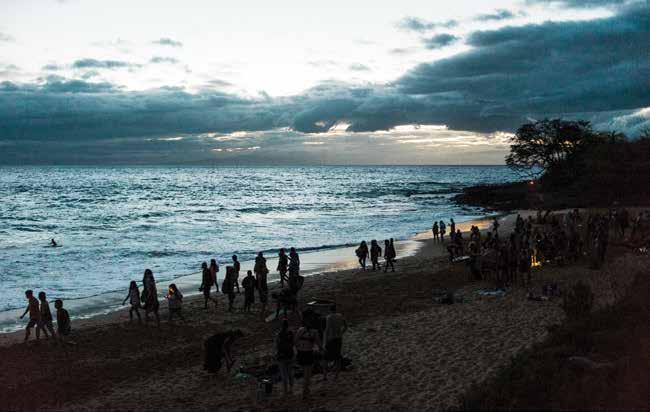
kamaʻāina, tourists, and transplants alike. Its sequestered location is ideal: Out of sight and out of mind, it grants peace and privacy from the prying eyes of busybodies and naysayers. Over time, a vibrant community has flourished, with membership requiring nothing more than an open mind. Though weekdays remain sedate at Little Beach, Sundays have evolved into glorious affairs. Musicians, artists, fire spinners, and dancers converge upon the shore to perform. The resulting energy is at once hypnotic and electric; the crowd revels in its euphoria. Whether one is there to participate in the festivities or simply observe, all are welcome. Most in attendance wear little to nothing, except for the handful of Hawai‘i Department of Land and Natural Resource officers who have begun showing up to curtail incriminatory alcohol consumption. (Open containers of alcohol are illegal on Hawaiʻi beaches.) Gamely sweating in blue polyester uniforms and work boots, they monitor the carefree crowd from the sidelines like chaperones at a high school dance. Despite the steady parade of skin and the intermittent whiff of weed carried aloft on the sea breeze, they maintain impressive poker faces.
Like most Little Beach frequenters, Hāʻiku gardener Morriah Essence, 22, is unperturbed by their presence. Naked and poised at the water’s edge, with sea foam swirling around her and the setting sun gilding her body gold, Essence is a Botticelli painting incarnate, and she is too blissed out to be bothered by any authoritative entity. “Little Beach is somewhere you can be yourself,” Essence says. Her first Little Beach experience— with its energy, diversity, and pulsating drums—left her rapturous and eager to return week after week. “So much love circulates here. Little Beach is kind of like church on the beach … that consists of medicine for the soul.”
She spots her friend Zac Yurasha in the crowd. Yurasha, 25, who is originally from Massachusetts, is stark naked save for a pair of sunglasses and a thin leather band tied across his forehead. He is also elated, having just been painted. As he shows off the art on his brawny body, he echoes Essence’s sentiments with exuberance. For Yurasha, going naked on a beach was the stuff of movies, a wildly unattainable experience. In fact, he had never been on a plane before moving to Maui in the fall of
Going topless is not prohibited on Hawai‘i beaches, and in a 2000 Hawai‘i State Supreme Court Case, the court determined that intention—that one’s nudity was intended to cause affront—was required for an indecent exposure charge.
156 | FLUXHAWAII.COM
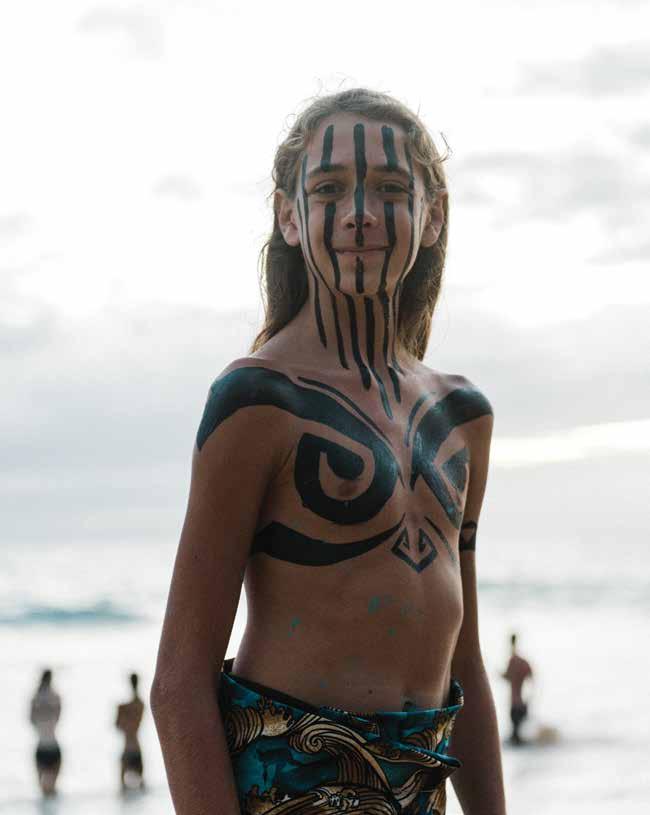
Only 14 years old, Gabriel Errington has been a Little Beach regular since he was 7. While his parents are aware that their decision to expose their son to Little Beach’s liberal landscape raises eyebrows, they believe the value in Little Beach’s sense of community surpasses any criticism they receive.
157
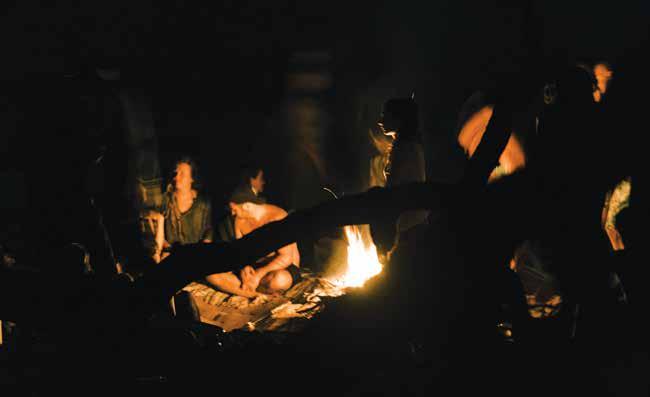
2017. “But then here I was on Little Beach with everyone, letting loose and being free spirited,” he says.
Yurasha confesses that it took a couple of tries before he felt comfortable enough to go totally nude. But in the process, he realized he wasn’t just shedding clothes— he was shedding his own ego. “I learned real fast that the less you care, the less others care,” Yurasha says. “The problem nowadays is not others judging you, but you judging yourself.” He flashes a sly grin. “You should try it!” The spirited duo disappears into the crowd.
As the mass of beachgoers swells and cascades to the beat of the drums, an unexpected sight is momentarily revealed: Amid the cheery chaos, a boy stands serenely on the sand, clad in an ankle-length sarong. Later, I learn he is Gabriel Errington. Only 14 years old, Gabriel is a Little Beach regular, and sometimes even performs with fire at its gatherings. He’s been coming to the beach with his father, Jason Errington, the bearded painter, and his mother, Sabrina, since he was 7.
The Erringtons, originally from Florida, have called Maui home since 2010. The move initially produced some culture shock—the change in latitude was indeed
a change in attitude. That change, however, was welcomed. “I come from a very red state,” Jason says. “Florida is racist, bigoted, and intolerant in many areas. It’s repugnant to watch in action. … This was one of our great motivators for fleeing that state. We refused to raise our child in a place with that type of thinking.”
Maui soon proved to be the trio’s version of Eden. While Jason and Sabrina hadn’t sought out Little Beach, a serendipitous visit to its shore dispelled any consternation or preconceptions they may have had. As parents, they are aware that their decision to expose their son to Little Beach’s liberal landscape raises eyebrows. To them, however, the value in Little Beach’s sense of community and its lessons in humanity surpass any criticism they receive. Nudity is a great equalizer, Jason explains, of the many walks of life—old, young, affluent, disadvantaged, resident, foreigner—that are present at Little Beach. “Nudity certainly makes it harder to tell what kind of life you lead, but I think that is good,” Jason says. “It is only after speaking with people do you get to learn what they are all about.”
Little Beach’s draw is more than skindeep, its fans insist. It’s a space where
“If you want to see that people can coexist peacefully and lovingly, this is your test subject. It is harmony in action. Love rules Littles. This is the beach that aloha built,” Jason Errington says.
158 | FLUXHAWAII.COM
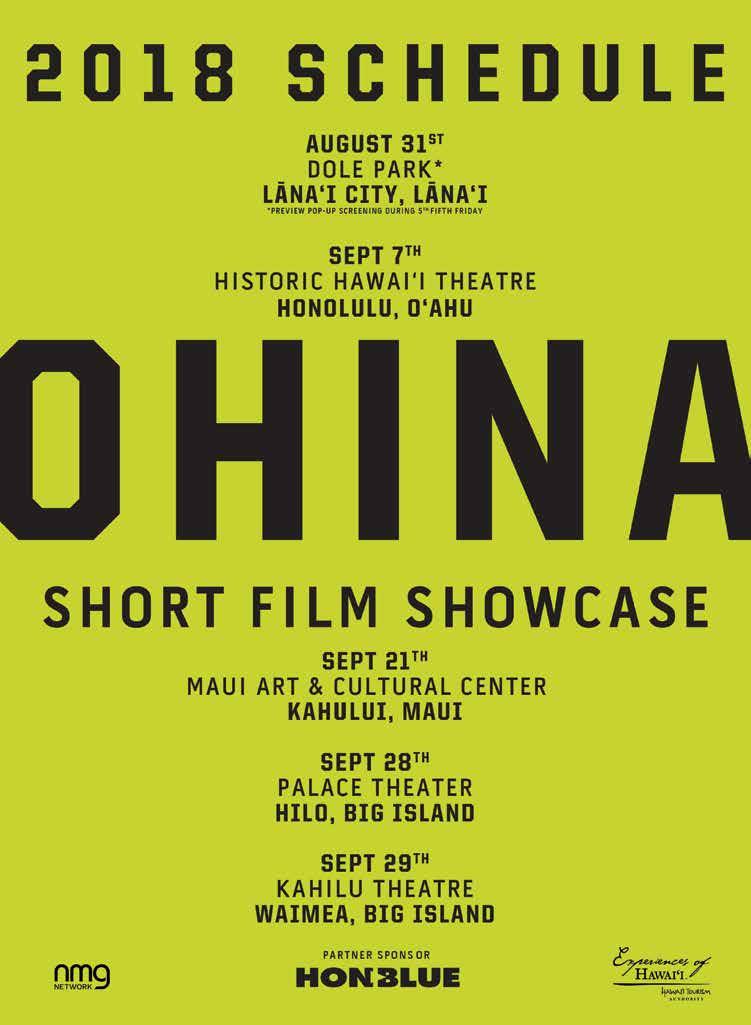
inclusivity reigns. It’s a place to be free, and not just of clothes. “If you want a place where you won’t be judged or excluded, that is Little Beach,” Jason says. “If you want to meet people in single servings or build lasting friendships, this is the place for you. If you want to see that people can coexist peacefully and lovingly, this is your test subject. It is harmony in action. Love rules Littles. This is the beach that aloha built.”
Which is why, each Sunday, the Erringtons, along with hundreds of other Little Beach enthusiasts, gather. For Gabriel, these experiences have informed his outlook on his life, even at his relatively young age: “It is easy to be happy when you surround yourself with happiness,” Gabriel says. “Which in turn has taught me the kind of people I should surround myself with.”
By this point, most of the drum circle’s musicians have stolen away for a swim or a chat or a smoke. A single drummer remains, providing a joyous, rhythmic throb— the eternal heartbeat of Little Beach.
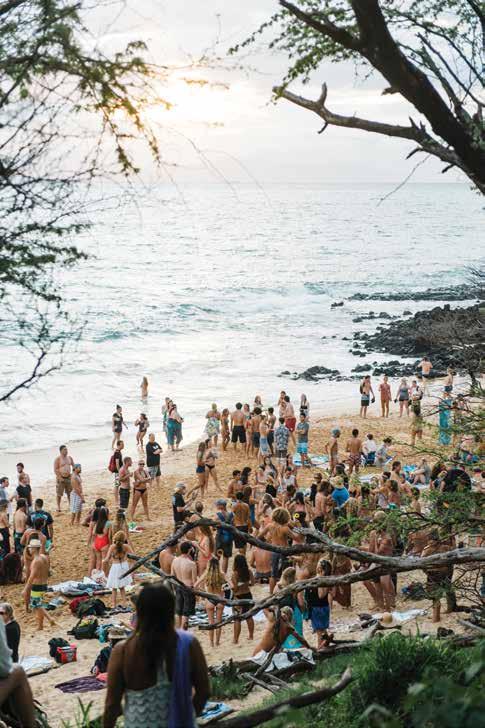
160 | FLUXHAWAII.COM

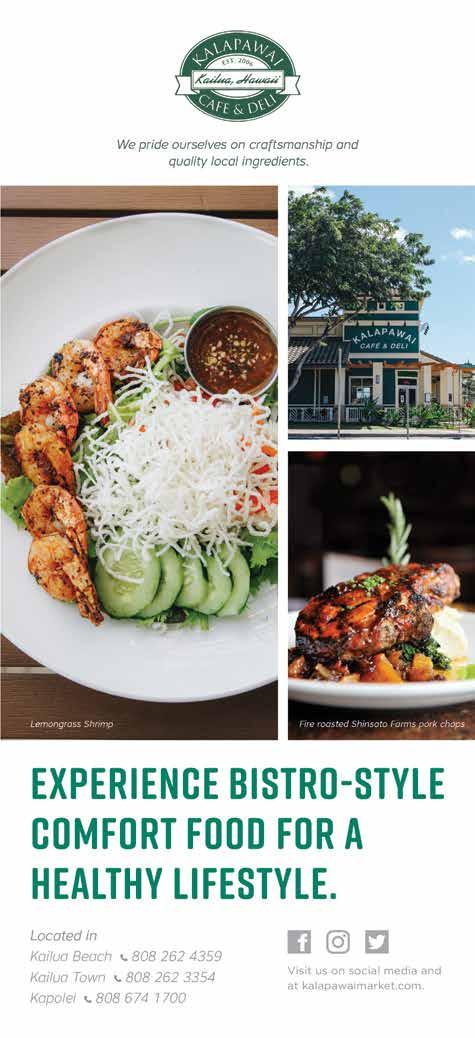
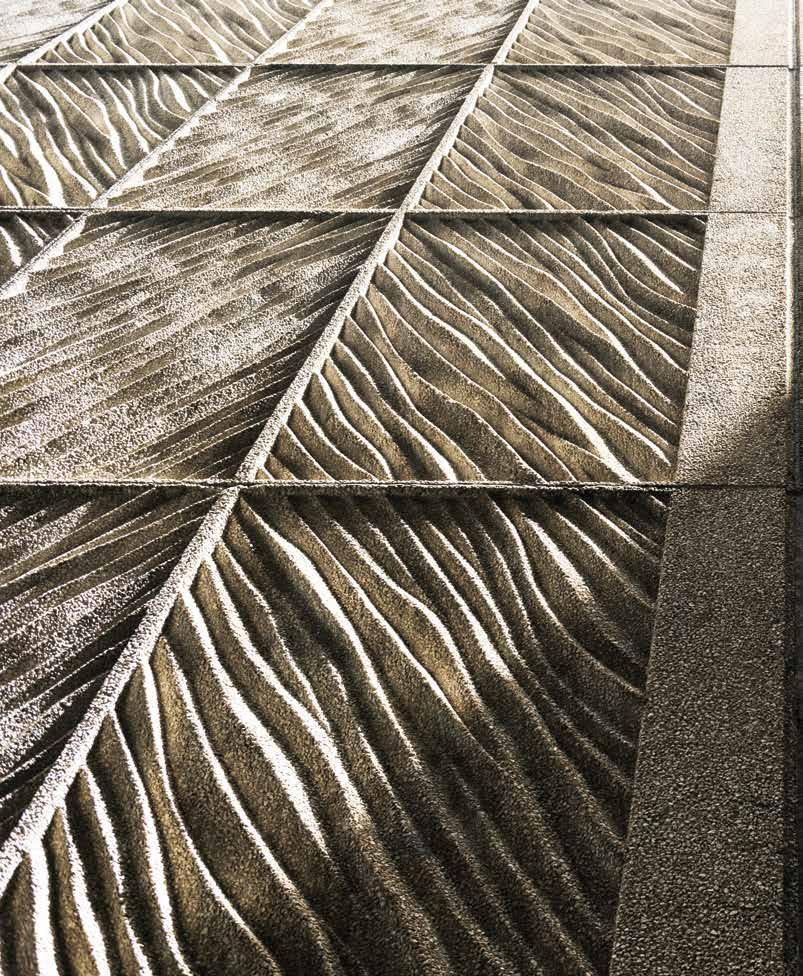 The Bankoh Parking Center shows details unique to Hawai‘i Brutalism. Image by John Hook.
The Bankoh Parking Center shows details unique to Hawai‘i Brutalism. Image by John Hook.
EXPLORE
“Less is a bore.”—Robert Venturi

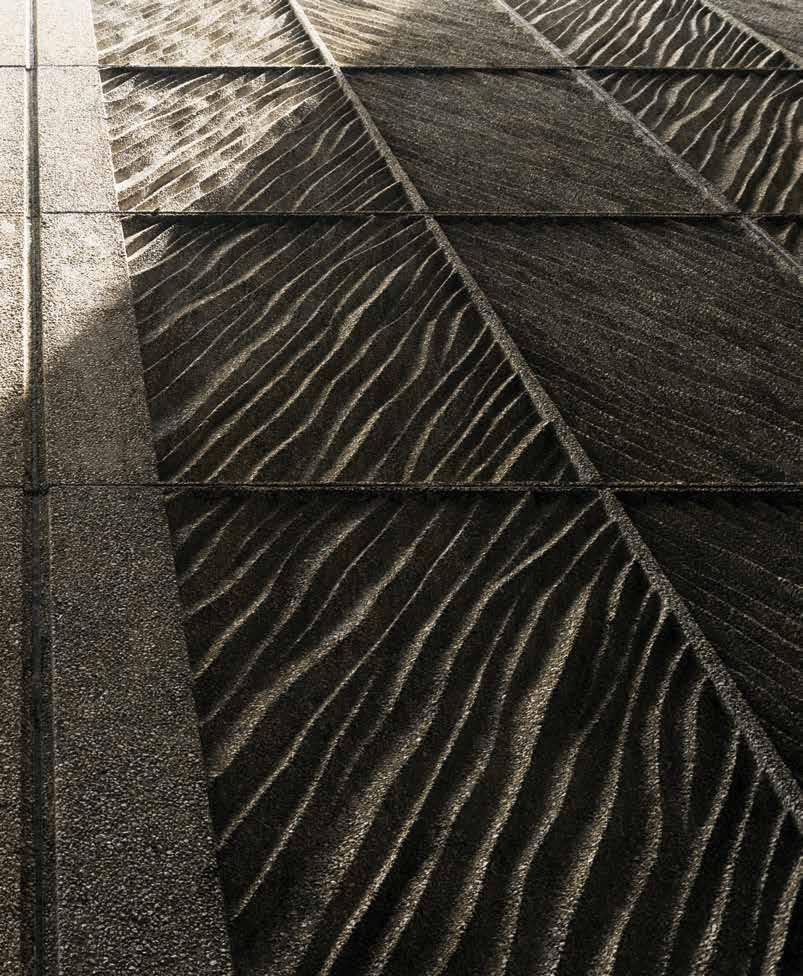
The Brutes on the Beach
Despite a history of detractors and a villainous role in pop culture, Brutalism became one of Hawai‘i’s most defining architectural movements, championed by a generation of architects with utopian aspirations.
TEXT BY TIMOTHY A. SCHULER
IMAGES BY JOHN HOOK
In the late 1960s, a great gray wave crashed onto the shores of Hawai‘i. It had originated from Europe nearly 20 years earlier. It traveled west to the Americas and east to Asia, and as it rolled from continent to continent, city to city, the swell grew. By the time it reached Honolulu, arriving from both the United States and Japan, the architectural movement known as Brutalism had become one of the dominant styles for civic buildings around the world, from hospitals to public housing, university buildings to city halls.
Born out of post-World War II austerity, Brutalism was defined by bold, sculptural, monumental concrete forms assembled in ways that seemed to defy gravity. Hawai‘i’s first and arguably best Brutalist building is the Financial Plaza of the Pacific, which takes up an entire city block bounded by King Street, Bishop Street, Merchant Street, and what became Fort Street Mall. The building is actually three: a 21-story tower flanked by two office buildings, one 6 stories, the other 12, all rising from a large public plaza. The tower, top-heavy with a hypnotic grid of recessed windows, was a stark departure from the inventive yet largely delicate architecture of the midcentury, which by then had taken hold in the Hawaiian Islands.
The Financial Plaza of the Pacific was a landmark project for Honolulu, one that its boosters hoped would solidify the city’s status as a hub for both commerce and culture. World War II had hurt the islands’ economy. In 1958, to help revitalize Oʻahu’s central business district, a
Financial Plaza of the Pacific, Hawai‘i’s first and arguably best example of a Brutalist building.
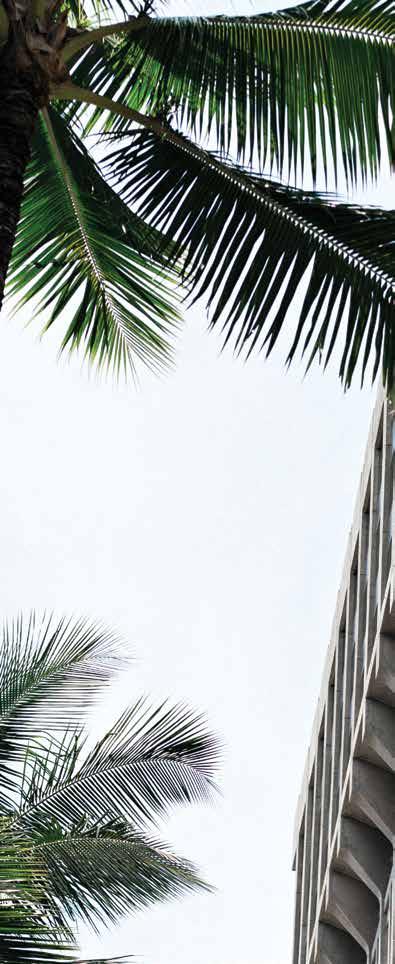
164 | FLUXHAWAII.COM EXPLORE | ARCHITECTURE |

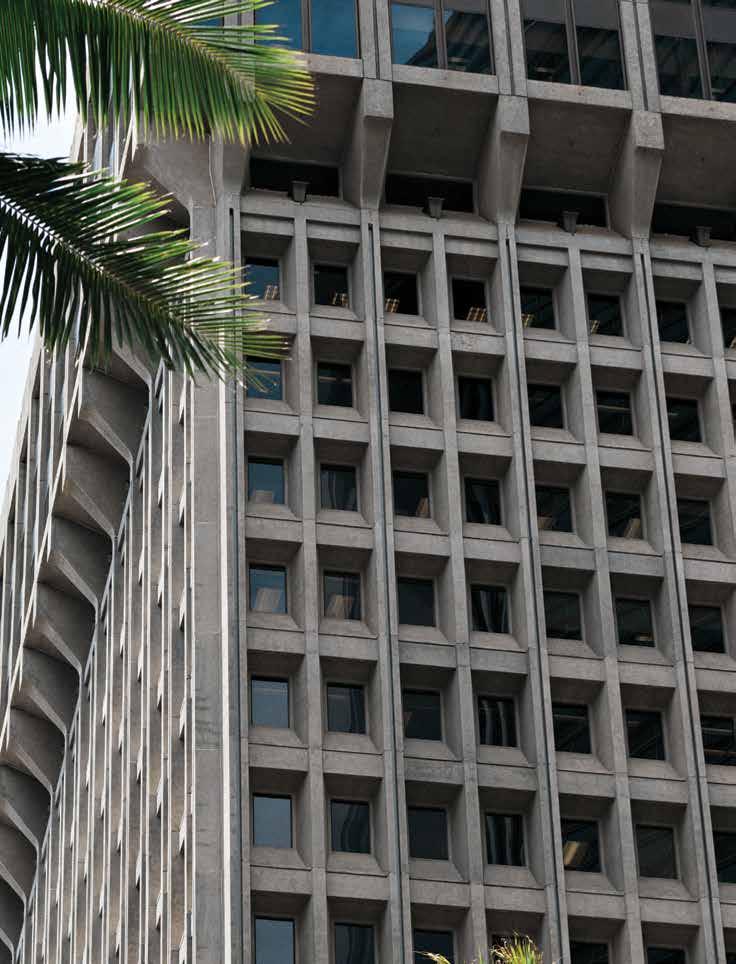
group of business owners formed the Downtown Improvement Association, which had three objectives: Attract more tourists downtown, keep the state and county seat near ‘Iolani Palace, and give the business district a defining anchor, something akin to New York City’s Rockefeller Center. The Financial Plaza of the Pacific became this anchor. The consortium hired some of the period’s best-known architects to design it, including Victor Gruen, who helped invent the indoor shopping mall, and Lawrence Halprin, the now legendary landscape architect who had just designed San Francisco’s Ghirardelli Square. The lead architect, Leo S. Wou, had emigrated from China to study in the United States and worked for Louis Kahn (a soon-to-be master of the Brutalist style) before opening his own office in San Francisco.
The buildings housed three distinct and powerful entities: Bank of Hawaii, American Savings and Loan Association, and Castle and Cooke, all of whom had been convinced by Robert Midkiff, the vice president of the Downtown Improvement Association, to pool their land holdings and create a joint headquarters that would redefine downtown Honolulu.
DeSoto Brown, the historian at the Bernice Pauahi Bishop Museum, remembers watching the towers go up as a teenager. He’d gotten his first glimpse of Brutalism a year earlier in Montreal at the 1967 World’s Fair. (At the time,

Brutalism was on everyone’s minds, if not their lips; the term was used by a select few.) Brown’s family stayed at Place Bonaventure, a soaring concrete hotel and exhibition center in downtown Montreal. He was mesmerized by its bold, unadorned concrete walls, which were
juxtaposed against eyepopping, red-orange carpet. The combination was so unusual that he walked up to the wall and touched it. A year later, when the Financial Plaza of the Pacific opened in Honolulu, Brown’s father, a stock broker, moved his offices there, giving Brown VIP
Despite the use of terms like “monolithic” to describe Brutalist buildings, there is an almost obsessive attention to detail in Brutalist architecture. Above, detail of Financial Plaza of the Pacific; right, American Savings Bank Tower.
166 | FLUXHAWAII.COM
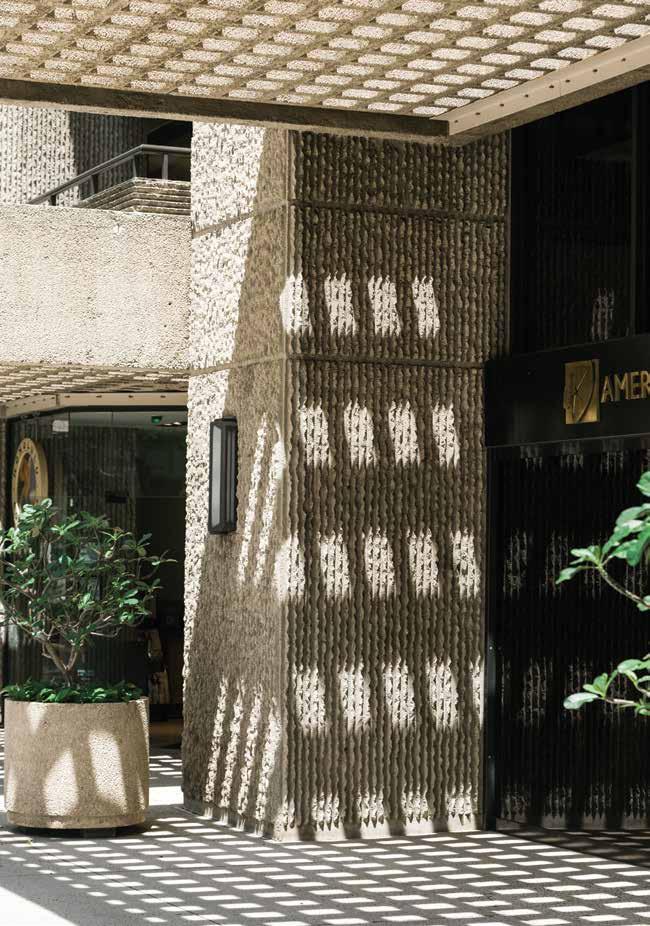
access to what was, at the time, the city’s most exciting architectural addition. The concrete towers multiplied. The American Savings Bank Tower went up catty-corner to the Financial Plaza in 1972 sporting jagged vertical and horizontal ribs so sharp they threatened to cut careless passersby. The nearby Municipal Building (now named the Frank F. Fasi Municipal Building) was as smooth as the American Savings Bank Tower was rough. Resorts, airports, shopping centers, and university buildings all were designed in the Brutalist language. It showed up even in the unlikeliest places, like working-class Kalihi, where Japanese architect Sachio Otani designed a fortresslike dojo for a little-known religious sect called Tensho Kotai Jingu-kyo. However, downtown Honolulu remained the epicenter. By 1980, you could walk a half
Brutalist architects in Hawai‘i found ways to soften their buildings to better fit Hawai‘i’s climate and culture, surrounding their buildings with coconut palms and hala trees. Prince Kūhiō Federal Building on Ala Moana Boulevard.
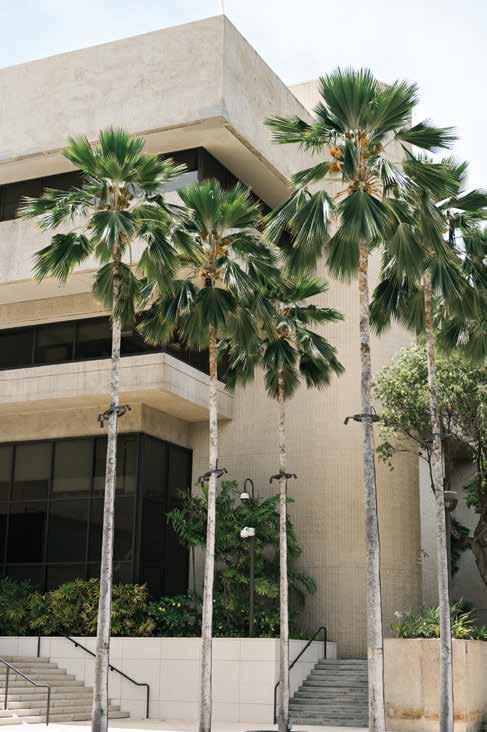
168 | FLUXHAWAII.COM
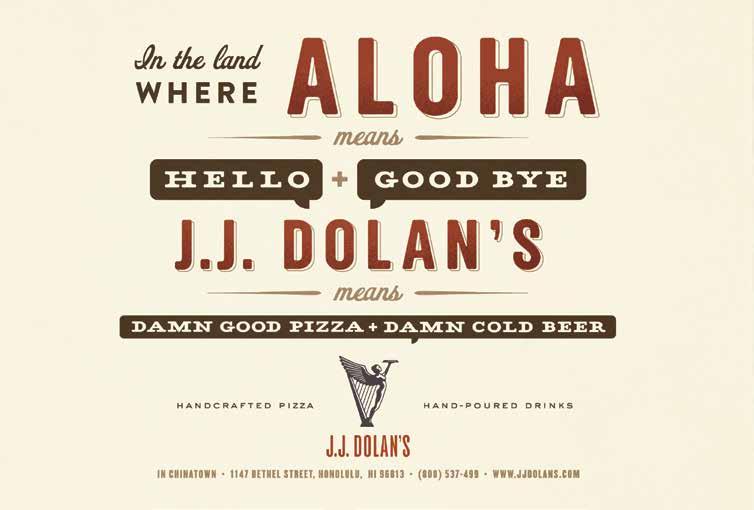
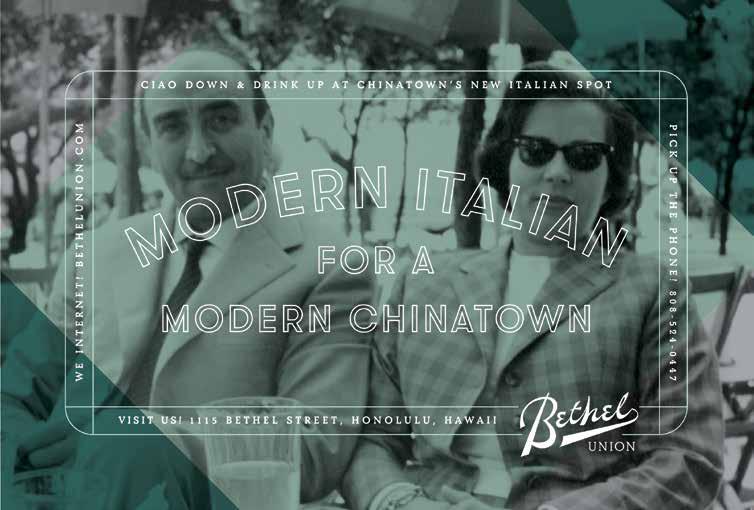
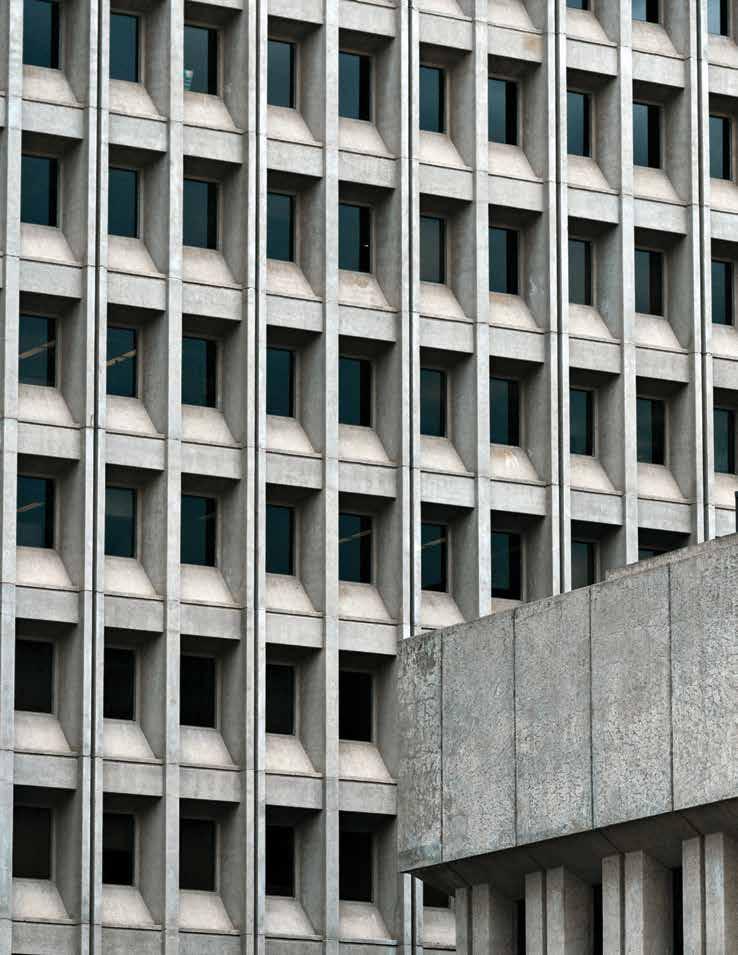 Financial Plaza of the Pacific.
Financial Plaza of the Pacific.

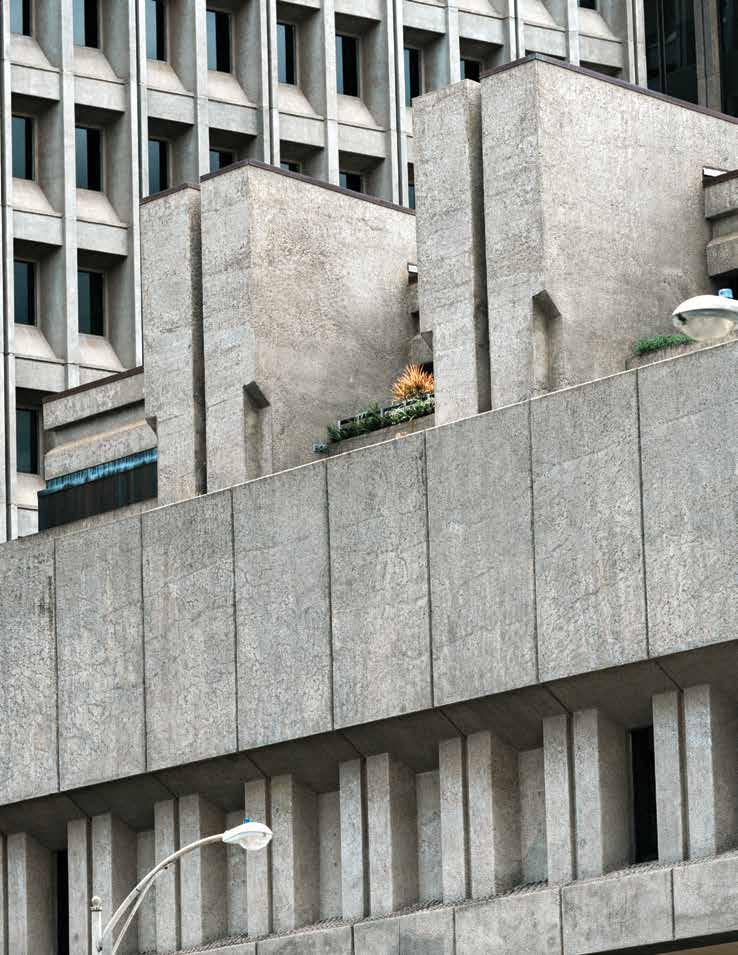
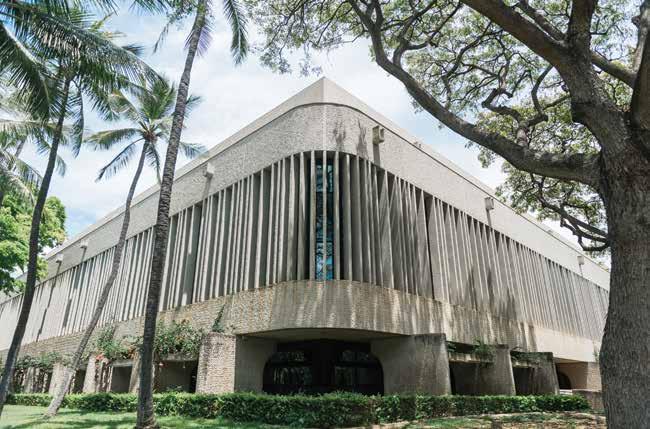
mile in any direction from the Hawai‘i State Capitol and never be out of sight of at least one of these monolithic brutes. Hawai‘i had entered a new era.
From the beginning, however, Brutalism had its detractors. Ian Fleming so hated the style that he named the James Bond villain Goldfinger for the Brutalist architect Ernö Goldfinger. In Hollywood, the style became the go-to architecture of pop culture villainy. From Blade Runner to RoboCop , Brutalism became, in one critic’s words, the “backdrop of evil.”
The irony is that Brutalism was born out of utopian idealism. The style’s progenitors—Peter and Alison Smithson, Le Corbusier, Moshe Safdie—shared a commitment to social welfare through architecture. Many early Brutalist buildings were grand experiments in social housing, such as Safdie’s Habitat 67—which debuted at the World’s Fair in Montreal—and Le Corbusier’s Unité d’habitation in Marseilles, France, for which the architect specified “beton brut,” or raw concrete. In the United States, which had escaped the lion’s share of wartime devastation visited upon Europe, monolithic concrete
architecture represented authenticity, honesty, strength. As Amanda Kolson Hurley recently wrote in the Washington Post Magazine, architects of Brutalism were revolting against “the previous generation and its cool, glassy modernism, which by that point had become the architectural language of the corporate world.”
“Being monolithic meant eliminating applied surfaces, hung ceilings, sheetrock— eliminating everything except the concrete,” the architect Henry Cobb explained in an interview published in the 2015 book Heroic: Concrete Architecture and the New Boston “We were enchanted by the idea that once the concrete was poured, the building was essentially finished.” This fascination with concrete was partially practical. In the years after World War II, steel was prohibitively expensive, especially in Europe. As a result, European architects had begun designing large-scale concrete buildings. Since many of America’s best-known architects of the time emigrated from Europe, they brought this ethos with them.
The same characteristics that drew mainland designers to concrete— its economics, its authenticity, its
172 | FLUXHAWAII.COM
Princess Ruth Ke‘elikolani Building on Punchbowl Street.

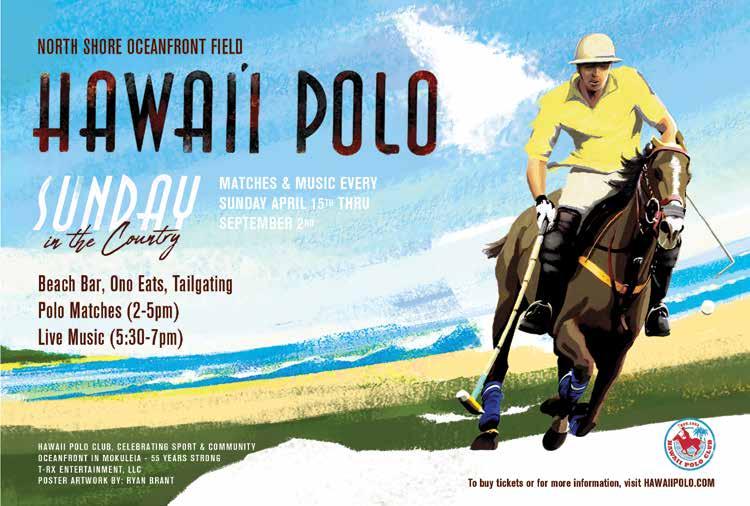
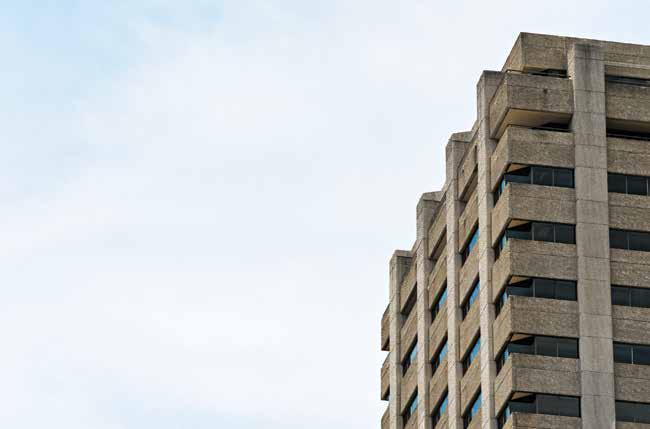
expressiveness—swayed architects working in Hawaiʻi. Unlike steel, which had to be imported, concrete could be made in the islands. The first known use of concrete in Hawaiʻi was in 1864 for the construction of a sugar mill on Maui. One hundred years later, it had become the material of choice for everything from hospitals to resort hotels.
Despite the style’s moniker, Honolulu’s Brutalist buildings were never meant to be dehumanizing. On the contrary, they were seen as benevolent additions to the urban fabric. The Financial Plaza of the Pacific was the first private development downtown to include such a large public plaza, complete with artwork. “Up until then, every building in downtown Honolulu built right out to the sidewalk,” Brown explains. The city’s metamorphosis was well received both in Hawaiʻi and abroad, and travel magazines fawned over the city’s “sophisticated new towers, malls, plazas, parks, sculptures, stores, and restaurants.” This is the Honolulu that Brown remembers, an increasingly cosmopolitan city that couldn’t get away from the past quickly enough. “You’re in the space age, you want to be different, you want to be modern,” he says
of the late 1960s. There was an attitude of tabula rasa. “It was up, up, and away.”
No architectural style thrown into the utterly unique milieu of Hawaiʻi emerges unchanged. Soon Brutalism was metabolized into a more acceptable and appealing island aesthetic. Still wooed by concrete, architects found ways to soften their buildings to better fit Hawai‘i’s climate and culture. They ringed their buildings with coconut palms and hala trees, incorporated lava rock, and added concrete murals.
As ornament and indigenous material found their way into Hawai‘i’s concrete buildings, the architecture became something else. A resort like the Mauna Kea Beach Hotel on Hawai‘i Island—at the time the most expensive hotel in the world—was already anathema to the socialist ideals of the Brutalism’s earliest champions. But in blending wood, steel, and tile with massive concrete forms, such buildings also said goodbye to the stylistic purity being pursued by people like Paul Rudolph. A sort of hybrid architecture emerged, something both tropical and Brutalist and distinctly Hawaiian.
Brutalist architects chose concrete as their material of choice because of its economics, as well as the fact that it could readily be made in the islands. Shown above, detail of American Savings Bank Tower; right, the Mililani Building, which won a design award from the Hawai‘i chapter of the American Institute of Architects in 1982.
174 | FLUXHAWAII.COM
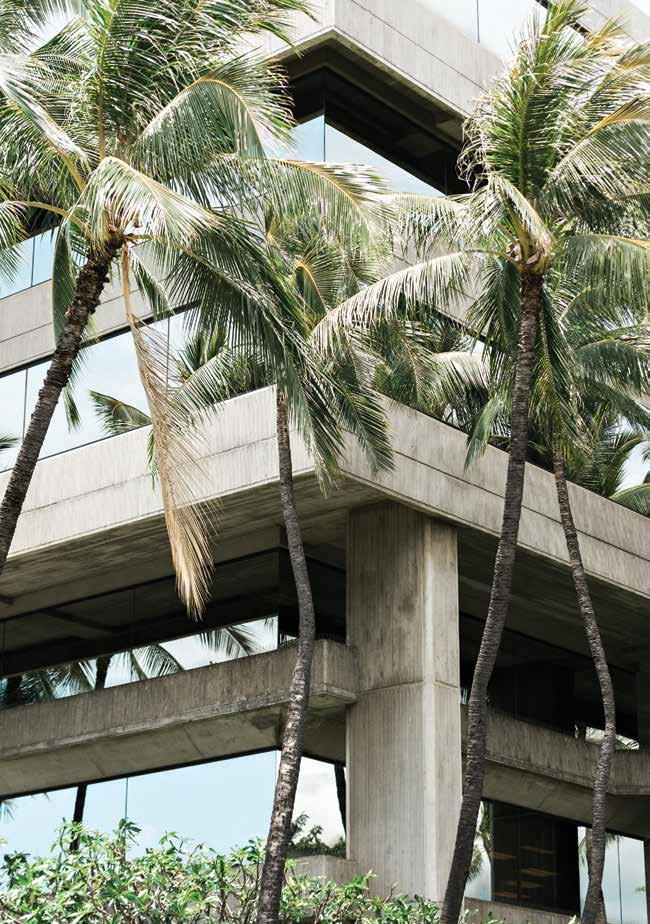
175
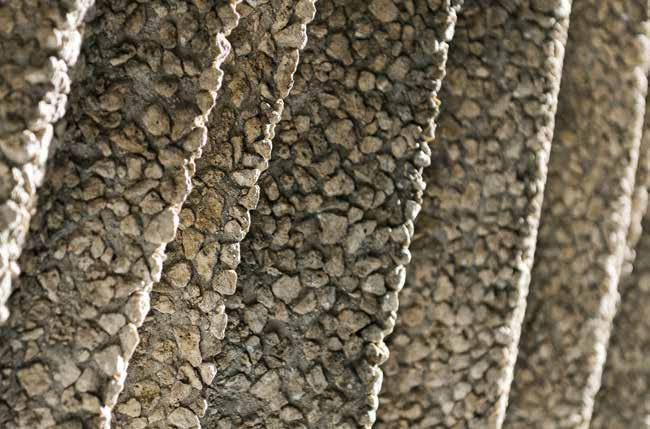
Despite the use of terms like “monolithic” (often used to mean not just large but devoid of character), there is an almost obsessive attention to detail in Brutalist buildings. On some, the exposed concrete is intentionally chipped or broken; on others, it swirls with the patterns of its wooden forms. Architects like Joseph Farrell, an acolyte of Rudolph’s and arguably one of the masters of Hawai‘i’s tropical Brutalism, chose different sizes and colors of crushed local rock to echo the area’s historic stone structures and evoke Hawai‘i’s beaches. What looks gray and lifeless from a distance becomes white and red and blue up close, an elemental architecture with a geologic patina. Eventually, economics steered architects away from this labor-intensive way of building. The political climate shifted, too. In the 1980s, the welfare programs Brutalist architecture represented—and often housed—were gutted, as were the budgets to maintain these so-called monstrosities, a phenomenon known as “active neglect.”
However undeserved, the Achilles heel of these hulking brutes remains their misanthropic reputation, which threatens
to allow them to be erased from public memory, just like generations of buildings before them. Chris Grimley, one of the authors of Heroic , recently mounted an exhibition titled Concrete Demolition at Boston’s Pinkcomma Gallery to highlight the destruction of this once-utopian architecture. In Hawaiʻi, Ward Plaza, a lowrise Brutalist office building at Ala Moana Boulevard and Ward Avenue, is actively being dismantled.
With loss often comes renewed appreciation, however, and there’s evidence that Brutalism is trending upward. A group known as #SOSBrutalism has built an online database of thousands of Brutalist buildings around the world in order to advocate for their preservation, and local preservation groups are beginning to rally around Hawaiʻi’s unique tropical Brutalism. Elsewhere, Brutalist history is being preserved in amber: London’s Victoria and Albert Museum acquired a three-story slice of the publichousing complex Robin Hood Gardens— the rest was demolished—and exhibited a portion of it at this year’s Venice Architecture Biennale.
Hawai‘i architects like Joseph Farrell chose different sizes and colors of crushed local rock to echo the area’s historic stone structures and evoke Hawai‘i’s beaches.
176 | FLUXHAWAII.COM

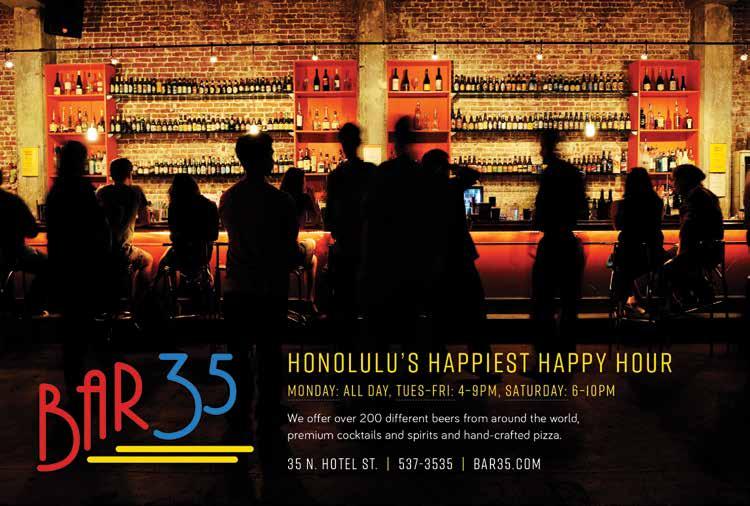
Some architects think concrete buildings still have much to offer the islands. In his office at University of Hawaiʻi at Mānoa, Martin Despang, a professor of architecture, has a model of a speculative project dubbed Primitiva, envisioned as 30 stories of exposed concrete softened by wood finishes and left open to the air, with each residential unit screened by bamboo. Unlike the hermetically sealed steeland-glass towers rising in Kakaʻako, Primitiva would take advantage of the island’s cooling tradewinds through what’s known as the stack effect, in which a central courtyard pulls cool air through the building as warm air rises. As for the concrete, Despang sees it as an indigenous material able to be made here on the islands.
Will the public ever see the beauty in this concrete architecture? It’s hard to say. Derivative architecture and the ubiquity of concrete has spoiled the novelty that Brutalism once enjoyed. Architects also may have been idealistic thinking that people would ever see concrete as humane. If a lava rock wall feels somehow warm, a concrete wall feels cold, impersonal—at least to many people. Perhaps concrete feels too rigid, too regular, for a species that seems to respond best to biomorphic forms found in nature.
Not every building is a work of art, no more than every paint-splattered canvas is a masterpiece. But whether or not it is
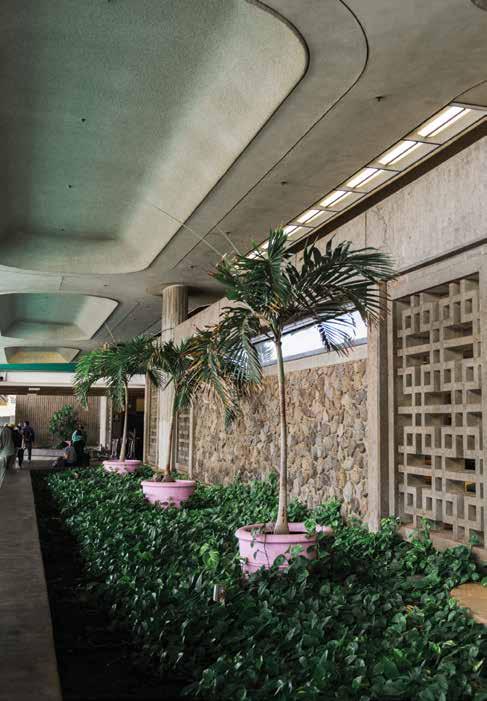
beloved today, Hawai‘i’s strain of Brutalistm helped define the islands. In its most shape-shifted form, it is a style of architecture found nowhere else. If these concrete buildings were idealist to a fault, that seems less the flaw of a villain, and more that of a hero.
Although Brutalism’s misanthropic reputation threatens to allow them to be erased from public memory, local preservation groups are beginning to rally around Hawai‘i’s unique tropical Brutalism. Shown above, Kahului AIrport; right, Prince Kuhio Federal Building.
178 | FLUXHAWAII.COM
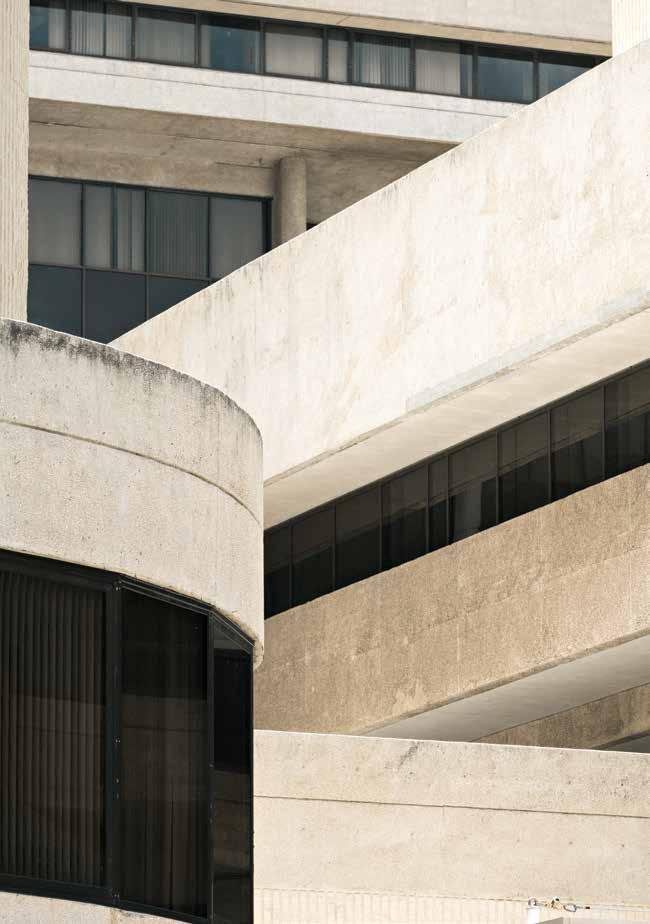
179
Boys Surf Bali
Chasing one of the world’s most famous waves, five friends find themselves on a once-in-a-lifetime trip.
TEXT BY CASH LAMBERT
IMAGES BY JOHN HOOK
After entering the front doors of a villa located on the Indonesian island of Bali, a crew of five—John Hook, Kahana Kalama, Evan Schell, Billy Wickens, and Ryan Miller—quickly bypassed inviting day beds, comfortable couches, and surf relics spread throughout the room. Bolting toward a wall of sliding glass doors, they pulled them open in a frenzy, stepped outside, and gasped in collective amazement. It wasn’t because of the infinity pool.
Situated on a cliff, their villas overlooked the world-class surf break, Uluwatu. Long left-hand lines peeled endlessly across the blue expanse. Only a few surfers were
visible, their bodies reduced to distant dots maneuvering on seemingly endless rides.
“I couldn’t believe a place like that still existed,” Hook said. It was the photographer’s first visit to the location. “It’s exactly how it looked in old surf magazines.”
It was in those magazines and the 1971 surf classic Morning of the Earth that most of the surf world first glimpsed Uluwatu. Vagabond surfers had stumbled upon the wave in the early 1970s, surely rubbing their eyes to ensure that the hot Indonesian sun wasn’t stirring a mirage of glimmering barrels.
Pura Luhur Uluwatu, an
It was in the early 1970s when the surf world first began getting glimpses of Uluwatu, a left-peeling surf break set beneath sheer cliffs on the Indonesian island of Bali.
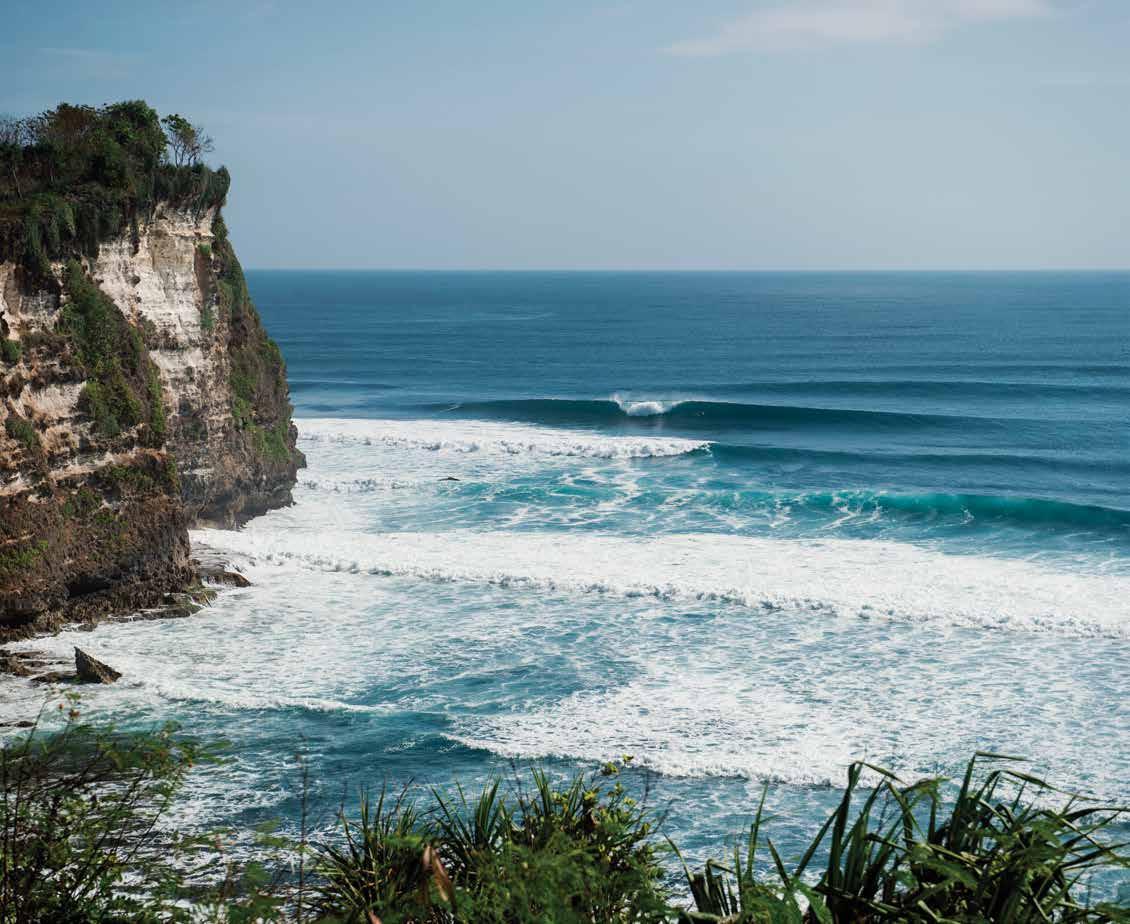
180 | FLUXHAWAII.COM
TRAVEL | BALI |

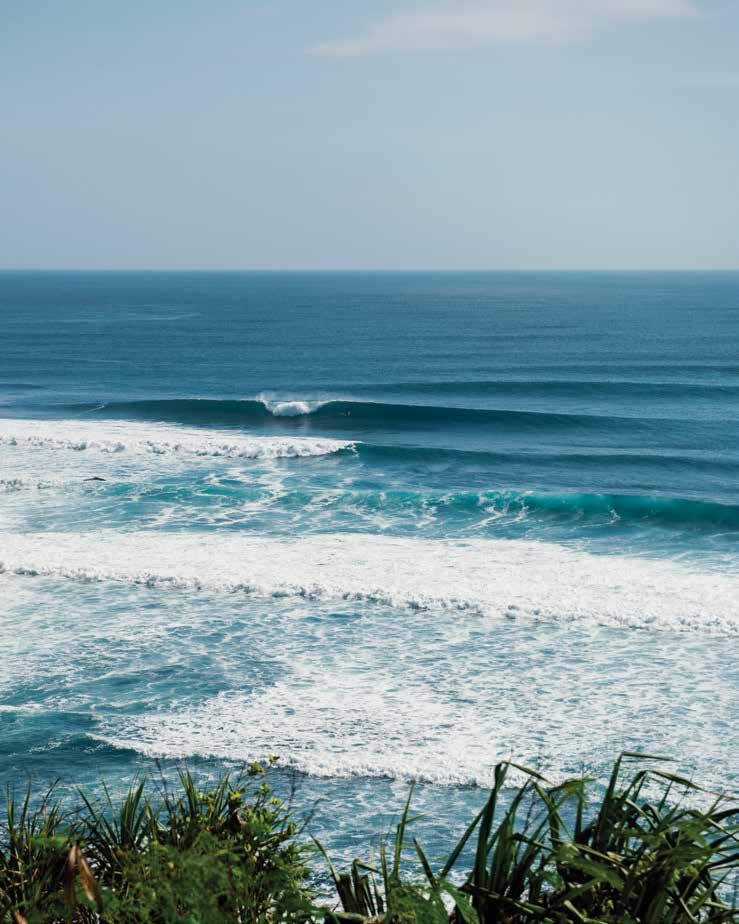
181
ancient Hindu temple that has stood watch over the break for centuries and is inhabited by monkeys, only added to the area’s lore. In 1974, Hawaiian surfer and two-time Pipeline Masters champion Gerry Lopez witnessed the wave with his own eyes. “It was as magnificent a sight as any surfer could behold,” he wrote in his book Surf Is Where You Find It . “We had just walked up to the gateway of paradise.”
Though most travelers visit Uluwatu for the surf, visitors can get a taste of city life in the many resort areas around Bali.
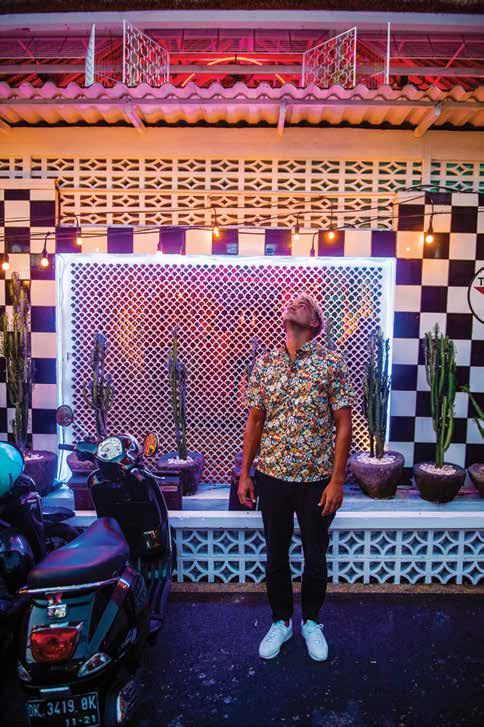
182 | FLUXHAWAII.COM
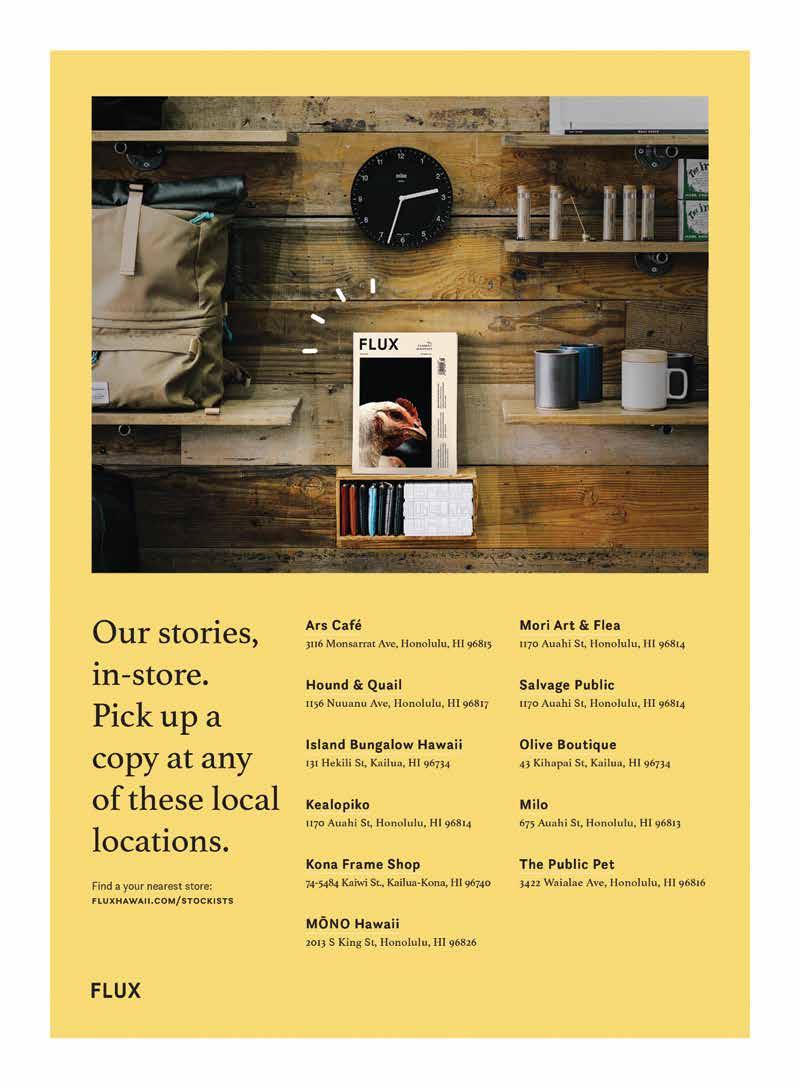
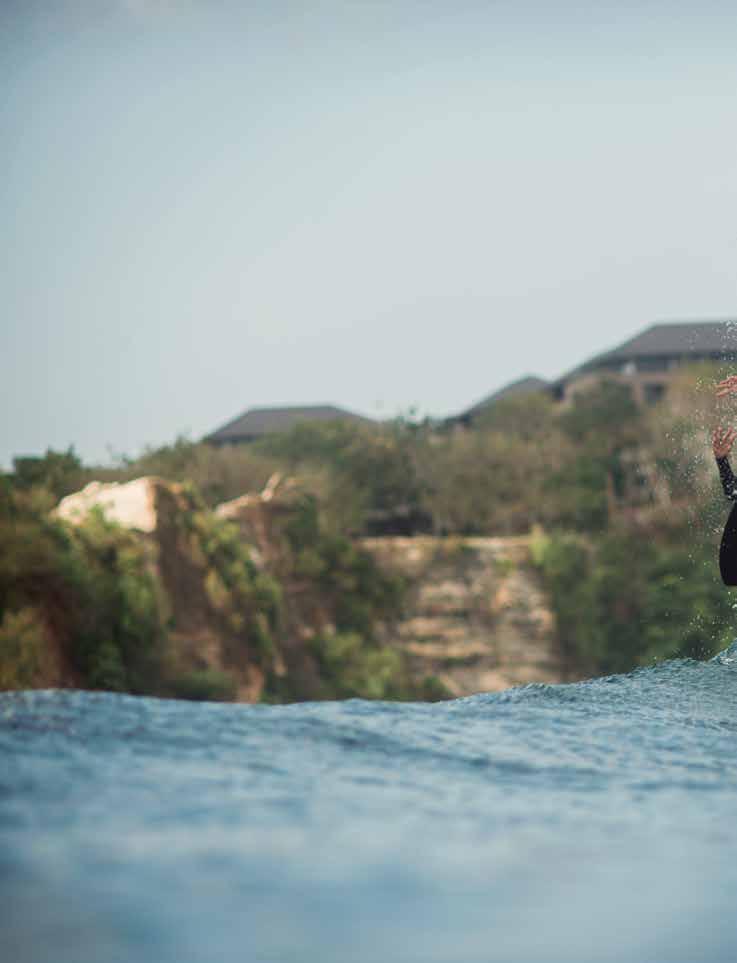

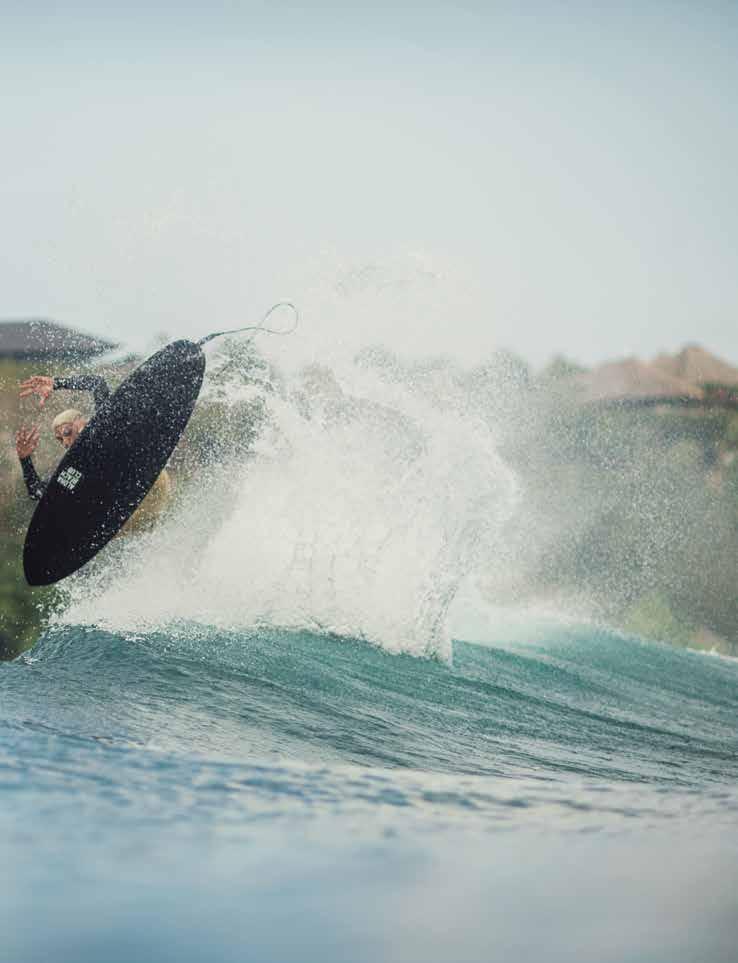
By the mid-1970s, images of the wave—and Lopez—were consistently featured in surf magazines. Experienced surfers from around the globe poured into the location. Surf contests followed. The first, the OM Bali Pro, took place in 1980. Since then, Uluwatu, which awakens in May and continues through October, has been the site of crowded freesurfs, regional events, and World Surf League events such as the 2008 Rip Curl Pro Search Bali and the 2018 Uluwatu Championship Tour.
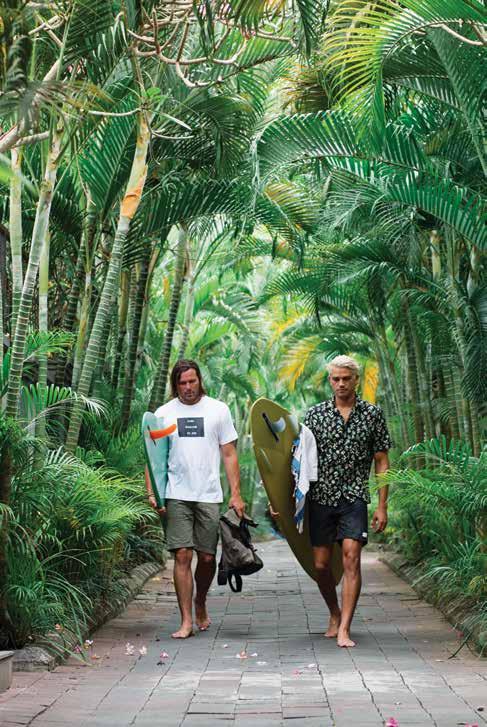
186 | FLUXHAWAII.COM
Waikīkī’s
Newest
Oceanfront Experience
Experience Waikīkī in a resort unlike any other, located just steps from Waikīkī Beach.
Following an extensive multi-milliondollar transformation, The Residences at Waikiki Beach Tower offers newly renovated one- and two-bedroom residences with remarkable ocean views, chef-inspired kitchens, spacious living rooms, and the option to upgrade to spa-like inspired master bathrooms. The views from every suite are simply breathtaking. Enjoy views of the surfers skimming the waves or the stunning reddish-pink sunset as the red glow
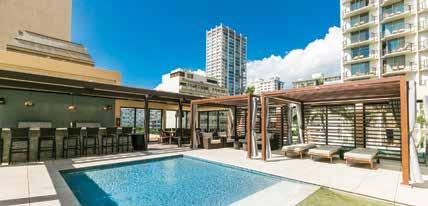
of the sun disappears in the gleaming ocean, all from your private lānai.
The resort’s amenities include a brand-new fitness center that overlooks Waikīkī Beach and features cardio and strength equipment, a hospitality lounge, a motion studio for yoga, along with spin classes, weekly hula fitness classes, and ‘ukulele lessons. The recreation area now includes an area for entertaining and includes deluxe commercial-grade barbecues with an outdoor dining area and prep station, poolside cabanas with ice chests,
Bluetooth speakers, a charging station, and privacy curtains.
Along with the newly renovated International Market Place and other shops and restaurants just steps away, a stay at The Residences at Waikiki Beach Tower will give you a new experience of Waikīkī.
Discover your best vacation yet and book direct at theresidencesatwaikikibeach.com.

| PROMOTIONAL |
For the five travelers, Uluwatu proved to be more than just one of the world’s most hyped waves. It became something deeply personal, a bridge connecting these men to each other and to the many other bands of surfers who had sought similar adventures in this place. The camaraderie was most apparent during their final surf session at Uluwatu, which featured long, adrenaline-fueled rides complete with powerful, spray-infused turns. Between waves, everyone kept an eye on the silhouette of the surfer who sat furthest outside. In a stroke of sheer luck for the crew, but what must have felt like fate, Gerry Lopez, the man heralded with pioneering the iconic wave, was in the lineup with them.
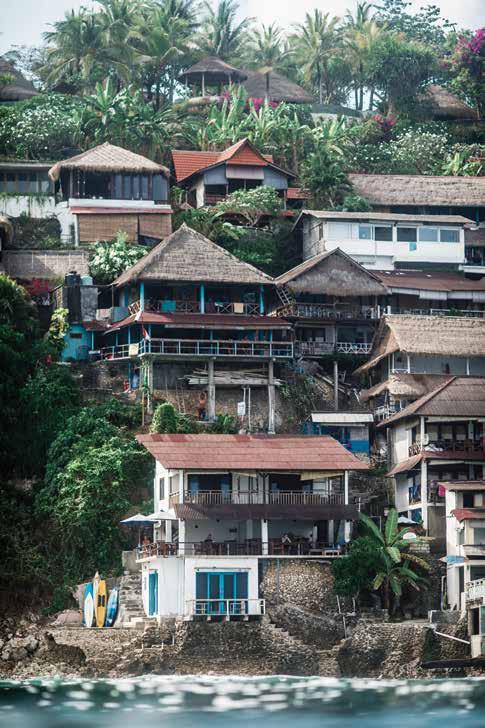
188 | FLUXHAWAII.COM
Villas in Uluwatu overlook the famed surf break.
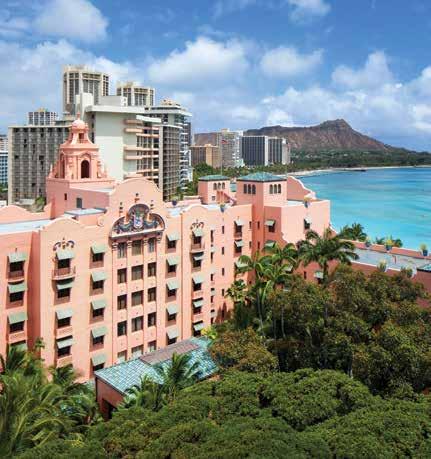
Experience Marriott International – Hawaii
From the lush landscapes of Kaua‘i’s north shore to the pristine Kohala coastline of Hawai‘i Island, Marriott International – Hawaii offers travelers an expansive selection of hotels and resorts across Kaua‘i, O‘ahu, Maui, and the Big Island. With 35 properties and 10 brands, the Marriott International – Hawaii portfolio caters to the varying tastes and preferences of even the most discerning travelers.
Those seeking a luxury experience will find the haven they’re looking for at one of four exquisite luxury resorts, including the Ritz-Carlton, Kapalua; the new Ritz-Carlton Residences, Waikiki Beach; the St. Regis Princeville; and The Royal Hawaiian, a Luxury Collection Resort.
At the premium tier, Marriott International – Hawaii now boasts a combined collection of Westin, Sheraton, and Marriott resorts across the four main Hawaiian Islands in the most enviable oceanfront locations in Hawai‘i.
“Exactly like nothing else” is the resounding mantra for Marriott International’s Autograph Collection brand, and the three very unique Autograph Collection hotels and resorts in Hawai‘i are no exception. From the expansive Koloa Landing Resort at Poipu to the quirky vintage ambiance at The Laylow in Waikīkī,
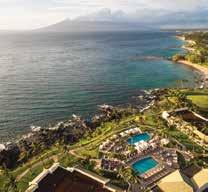
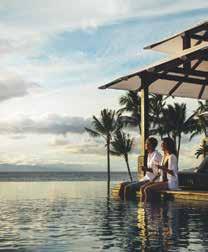
and the unparalleled timelessness of the Mauna Kea Beach Hotel at Kauna‘oa Bay, the Autograph Collection offers visitors to Hawai‘i the opportunity to immerse themselves in an experience unlike any other in the world.
A selection of suite and villastyle Marriott Vacation Club resorts and Westin Villa properties cater wonderfully to families looking for more space to spread out and enjoy the comforts of home combined with the luxuries and conveniences of a resort.
The possibilities are endless at Marriott International – Hawaii properties, with dozens of on-site restaurants, lū‘au shows, spas, pools, and an expansive selection of ocean and cultural activities, including surfing, canoe rides, catamaran rides, hula lessons, ‘ukulele lessons, and more.
| PROMOTIONAL |
189
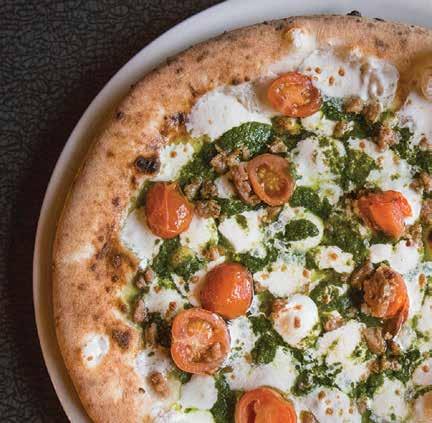
Brick Fire Tavern
The closest thing on O‘ahu to dining at an authentic pizzeria in Naples, Italy is a meal spent at Brick Fire Tavern, where guests are enchanted by the crackling wood-burning oven that fires their handcrafted pies and anchors the intimate dining space. Even the Italians have given the Chinatown eatery their official seal of approval, making it the first restaurant on O‘ahu to be certified by the Associazione Verace Pizza Napoletana, AVPN for short, for serving genuine Neapolitan pies.
In keeping with the AVPN’s mission to protect and promote the traditions that go into Naples’ pizzas, known for their soft, chewy crusts and light char, Brick Fire Tavern follows centuries-old Italian
techniques when making its classic pies, from crushing imported San Marzano tomatoes by hand for a simple yet delicious pizza sauce to pulling fresh mozzarella in-house to melt atop each slice.
To fully grasp the verace , or true essence, of Neapolitan pizza, Brick Fire owners Matthew Resich and Inthira Marks traveled to the birth place of pizza to train under famous pizzaiolo Enzo Coccia, a founding member of the AVPN, before opening their restaurant. “Sharing the real flavors of Naples with our customers is very important to us,” explains Marks. “Our dough is made from scratch with four simple ingredients, just like the original pizza recipe, and we even commissioned our oven from Stefano Ferraro while in Italy to bring back with us to Hawaiʻi.”
The oven cooks up traditional pies, such as the basil-crowned margherita, but it also brings life

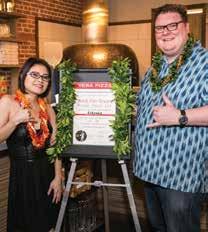
to the owners’ modern creations, including “The Real Hawaiian” pizza topped with a puree of local papaya and kalo and island-raised kālua pig.
“Everything from the Ho Farms cherry tomatoes that top our pesto e salsiccia pizza down to the kiawe wood that burns in the oven is carefully sourced so that it’s fresh and local whenever possible,” Resich adds.
Situated in the heart of Honolulu’s most exciting neighborhood, Chinatown, Brick Fire Tavern brings urban and rustic dining together in the historic HOC Chinatown building. To accompany the pizza menu, the restaurant offers a full bar, gourmet salads and pupus, seasonal specials, and sweet treats.
Brick Fire Tavern is located at 16 N. Hotel St. For more information, call 808-369-2444 or visit brickfiretavern.com.
| PROMOTIONAL |
190 | FLUXHAWAII.COM
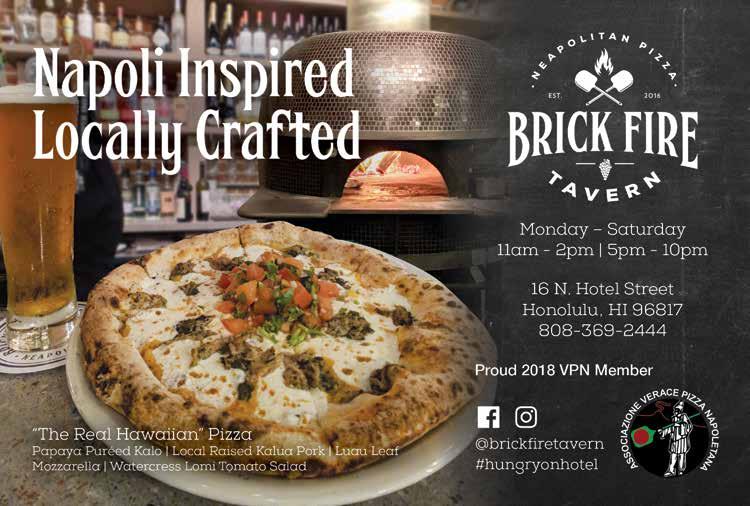
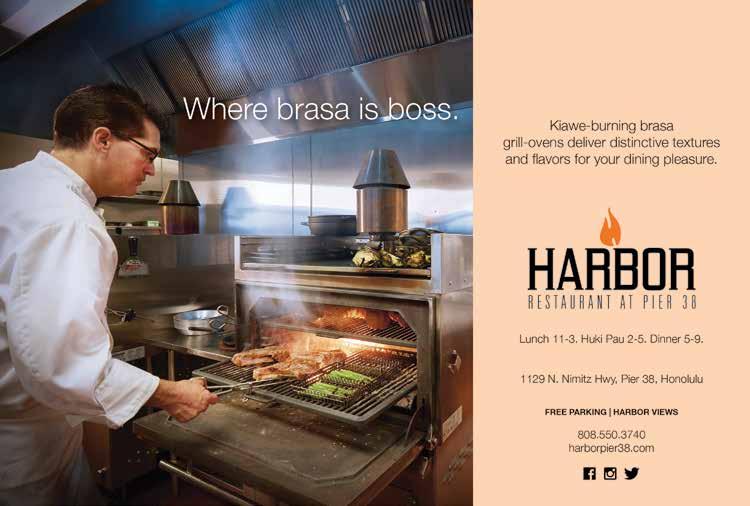
Beachboy Blues
In the shadow of the Duke Kahanamoku statue, history appears to repeat itself in claims over territory and culture at Kūhiō Beach.
TEXT BY MATTHEW DEKNEEF
ILLUSTRATION BY MITCHELL FONG
Arthur Godfrey, the American radio and television broadcaster, once told the press that “Waikiki’s become a Coney Island with palm trees. All you get on the beach are insults and insubordination. … It makes a guy who loves this place like I do want to cry.”
The year was 1959. When Godfrey made that emotional plea it was in criticism of a new brand of beachboys that had been springing up along the shore. They were usually solo, self-employed men who would set up their own umbrellas at Kūhiō Beach, plop a few surfboards under them, and solicit tourists for their dollars. Their progenitors, the famed beachboys of the 1930s and 1940s, saw this blatant pursuit of money as classless, and an affront to their well-regarded profession and surf culture that was already decades deep. Tensions were drawn in the sand, and fights would sometimes break out in front of the hotels.
In 2018, this remark about Waikīkī isn’t very far from what has been unfolding among current concessionaires regarding their now-storied surfboard rental stands along the same stretch of sand. Shortly after it was announced that a new company, Dive Oahu, won the bid to manage three prime beachfront concessions—a decision by the City and County of Honolulu that ultimately squeezed out two longtime stewards, Star Beachboys and Hawaiian Oceans, for at least the next five years—a social media post (since deleted) surfaced from Brian Benton, the stands’ new manager. It recounted his visit to Waikīkī Beach, where he was left entranced “looking at the dollars being made
by renting chairs, umbrellas, surf boards.” Even though he admitted he “only owned one surfboard” in his life, he boasted he was about to have hundreds. Dive Oahu is now the most noticeable presence on a beach frequented by travelers who will get their first taste of Hawai‘i’s surf and then pose for photos beneath the bronze hands of Duke Kahanamoku, one of the original beachboys.
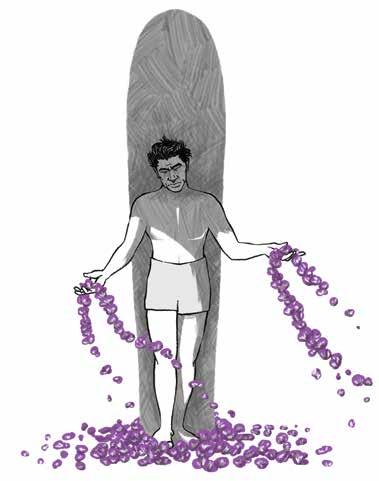
When my dad first taught me how to surf, it was at Waikīkī on a surfboard rented out to us by beachboys. Every weekend that summer, I’d follow behind him as we walked barefoot to their bright yellow tents. “Can get two boards?” my dad would say to the uncle manning the stand’s tiny metal cashbox. Soon enough, the uncle came to recognize us and would give us discounts on rentals. “No need!” my dad would say in protest every time. Then, “Tanks, ah,” throwing up a shaka before selecting our boards and paddling into the water. With the difference he had saved, he would scoop up some snacks from the store, then make me run back across Kalākaua Avenue to pay the beachboys back in Spam musubis. It seems that nearly every local kid has a similar memory that showed us there are things more valuable than money. It’s sad to think that places harboring those same lessons could be disappearing. At the beachboys’ stands, I didn’t just learn how to surf, I learned how to deal in smiles, shakas, and slices of Spam, too.
| A HUI HOU | 192 | FLUXHAWAII.COM
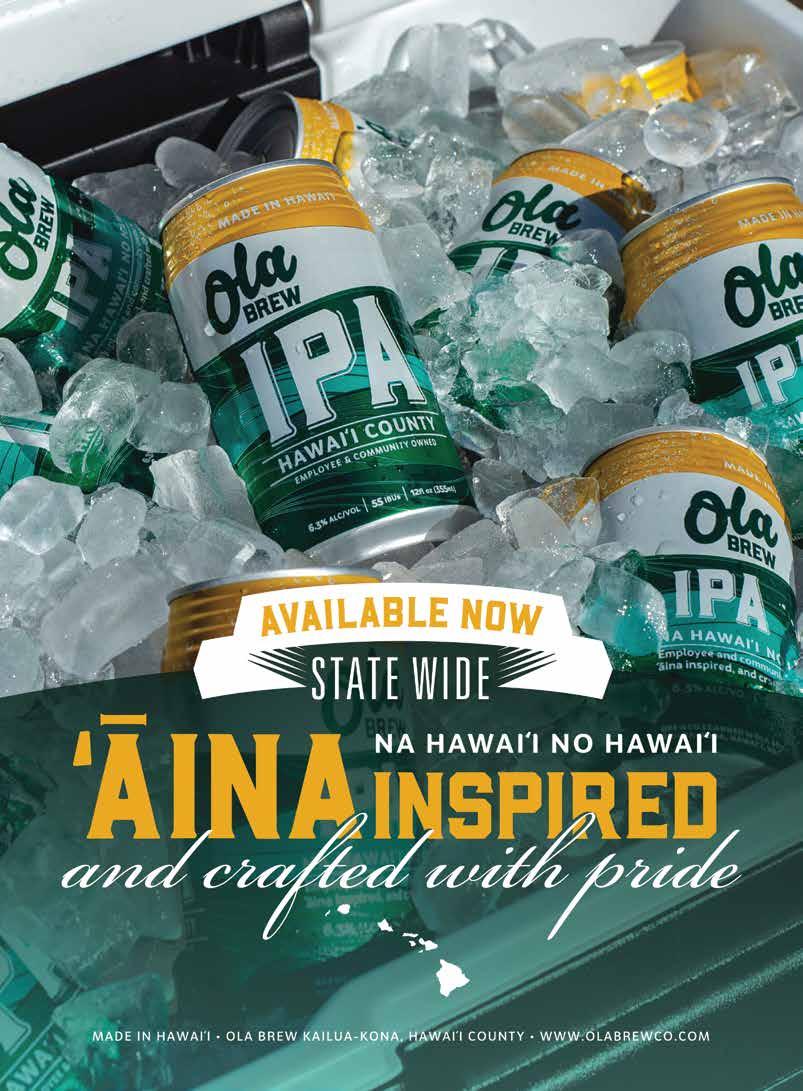
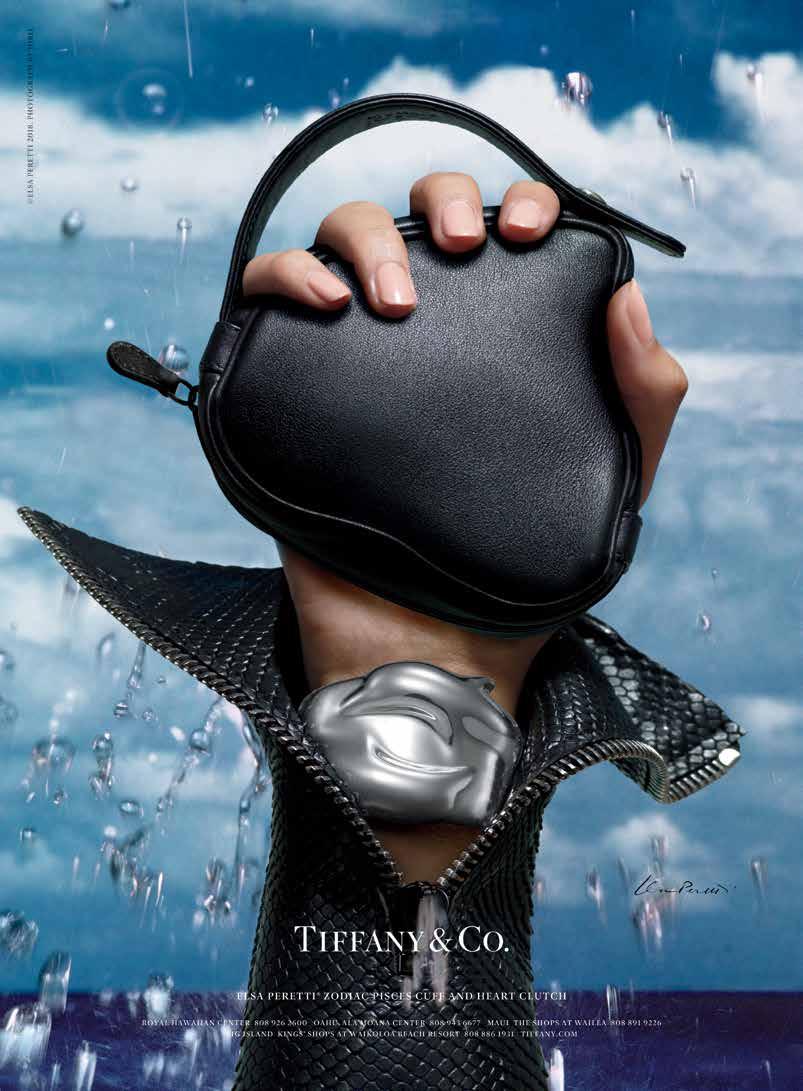



























 When developers threatened to raze their beloved bowling alley, Kailua seniors fought back. Image by IJfke Ridgley.
When developers threatened to raze their beloved bowling alley, Kailua seniors fought back. Image by IJfke Ridgley.









 Nicole Maileen Woo
Nicole Maileen Woo



















 FLUX FEATURE
FLUX FEATURE
























 Images from Raffipiy’s time enlisted in the military.
Images from Raffipiy’s time enlisted in the military.

 FLUX FEATURE
FLUX FEATURE


 Ed Greevy outside a film studio in Mānoa, 1968.
Ed Greevy outside a film studio in Mānoa, 1968.
 Activist Terrilee Keko‘olani at Wāwāmalu (Sandy Beach), 1972.
Greevy says this portrait has become his most recognized photo.
Activist Terrilee Keko‘olani at Wāwāmalu (Sandy Beach), 1972.
Greevy says this portrait has become his most recognized photo.


 Demonstration at the Hawai‘i State Capitol on March 31, 1971. The rally united Kōkua Hawai‘i and Save Our Surf in demanding action against housing evictions and the destruction of surf sites.
Demonstration at the Hawai‘i State Capitol on March 31, 1971. The rally united Kōkua Hawai‘i and Save Our Surf in demanding action against housing evictions and the destruction of surf sites.


 Mrs. Fujiko Matayoshi, 1973. Known as the “Sweet Lady of Waiāhole,” Matayoshi came to represent the working farmers in the land struggles of Waiāhole-Waikāne.
Mrs. Fujiko Matayoshi, 1973. Known as the “Sweet Lady of Waiāhole,” Matayoshi came to represent the working farmers in the land struggles of Waiāhole-Waikāne.













 #shotoniphone
#shotoniphone


























 Here boutique in Kaka‘ako. Image by Kainoa Reponte.
Here boutique in Kaka‘ako. Image by Kainoa Reponte.























 Beachgoers throw inhibition to the wind at Maui’s Little Beach. Image by John Hook.
Beachgoers throw inhibition to the wind at Maui’s Little Beach. Image by John Hook.













 The Bankoh Parking Center shows details unique to Hawai‘i Brutalism. Image by John Hook.
The Bankoh Parking Center shows details unique to Hawai‘i Brutalism. Image by John Hook.








 Financial Plaza of the Pacific.
Financial Plaza of the Pacific.































